|
Meinem Lehrer und Freund Prof. Dr. Heinrich von Stietencron ist die gesamte Amarakośa-Übersetzung in Dankbarkeit gewidmet. |
Zitierweise | cite as: Amarasiṃha <6./8. Jhdt. n. Chr.>: Nāmaliṅgānuśāsana (Amarakośa) / übersetzt von Alois Payer <1944 - >. -- 2. Dvitīyaṃ kāṇḍam. -- 15. vaiśyavargaḥ (Über Vaiśyas). -- 3. Vers 15c - 27a (Ackerbau II, Nutzpflanzen). -- Fassung vom 2011-07-06. -- URL: http://www.payer.de/amarakosa7/amara215c.htm
Erstmals hier publiziert: 2011-07-06
Überarbeitungen:
©opyright: Creative Commons Lizenz (Namensnennung, keine kommerzielle Nutzung, share alike)
Dieser Text ist Teil der Abteilung Sanskrit von Tüpfli's Global Village Library
|
Meinem Lehrer und Freund Prof. Dr. Heinrich von Stietencron ist die gesamte Amarakośa-Übersetzung in Dankbarkeit gewidmet. |
Falls Sie die diakritischen Zeichen nicht dargestellt bekommen, installieren Sie eine Schrift mit Diakritika wie z.B. Tahoma.
Die Devanāgarī-Zeichen sind in Unicode kodiert. Sie benötigen also eine Unicode-Devanāgarī-Schrift.
Bei der Identifikation der lateinischen Pflanzennamen folge ich, wenn immer es möglich ist:
Bhāvamiśra <16. Jhdt.>: Bhāvaprakāśa of Bhāvamiśra : (text, English translation, notes, appendences and index) / translated by K. R. (Kalale Rangaswamaiah) Srikantha Murthy. -- Chowkhamba Varanasi : Krishnadas Academy, 1998 - 2000. -- (Krishnadas ayurveda series ; 45). -- 2 Bde. -- Enthält in Bd. 1 das SEHR nützliche Lexikon (nigaṇṭhu) Bhāvamiśras.
Pandey, Gyanendra: Dravyaguṇa vijñāna : materia medica-vegetable drugs : English-Sanskrit. -- 3. ed. -- Varanasi : Chowkhamba Krishnadas Academy, 2005. -- 3 Bde. ; 23 cm. -- ISBN: 81-218-0088-9 (set)
Wo möglich, erfolgt die aktuelle Benennung von Pflanzen nach:
Zander, Robert <1892 - 1969> [Begründer]: Der große Zander : Enzyklopädie der Pflanzennamen / Walter Erhardt ... -- Stuttgart : Ulmer, ©2008. -- 2 Bde ; 2103 S. -- ISBN 978-3-8001-5406-7.
 WARNUNG: dies
ist der Versuch einer Übersetzung und Interpretation eines altindischen
Textes. Es ist keine medizinische Anleitung. Vor dem Gebrauch aller hier
genannten Pflanzen wird darum ausdrücklich gewarnt. Nur ein erfahrener, gut
ausgebildeter ayurvedischer Arzt kann Verschreibungen und Behandlungen
machen! Die Bestimmung der Pflanzennamen beruht weitgehend auf Vermutungen
kompetenter Āyurvedaspezialisten.
WARNUNG: dies
ist der Versuch einer Übersetzung und Interpretation eines altindischen
Textes. Es ist keine medizinische Anleitung. Vor dem Gebrauch aller hier
genannten Pflanzen wird darum ausdrücklich gewarnt. Nur ein erfahrener, gut
ausgebildeter ayurvedischer Arzt kann Verschreibungen und Behandlungen
machen! Die Bestimmung der Pflanzennamen beruht weitgehend auf Vermutungen
kompetenter Āyurvedaspezialisten.
Poaceae - Süßgräser
| 15c./d. āśu vrīhiḥ pāṭalaḥ syāt sitaśūka-yavau samau आशु व्रीहिः पाटलः स्यात् सितशूक-यवौ समौ ।१५ ख। [Bezeichnungen für (Varietäten des) Regenzeiten-Reis:]
|
Colebrooke (1807): "Rice ripening in the rains."
Siehe auch:
Payer, Margarete <1942 - >: HBI weltweit. -- 4. Philippinen. -- 4.1. Das International Rice Research Institute (IRRI). -- URL: http://www.payer.de/reislink.htm
Der Bhāvaprakāśa nennt als Beispiele folgende Sorten von vrīhi:
वीहि - vrīhi m.: Reis, der in der Regenzeit geerntet wird
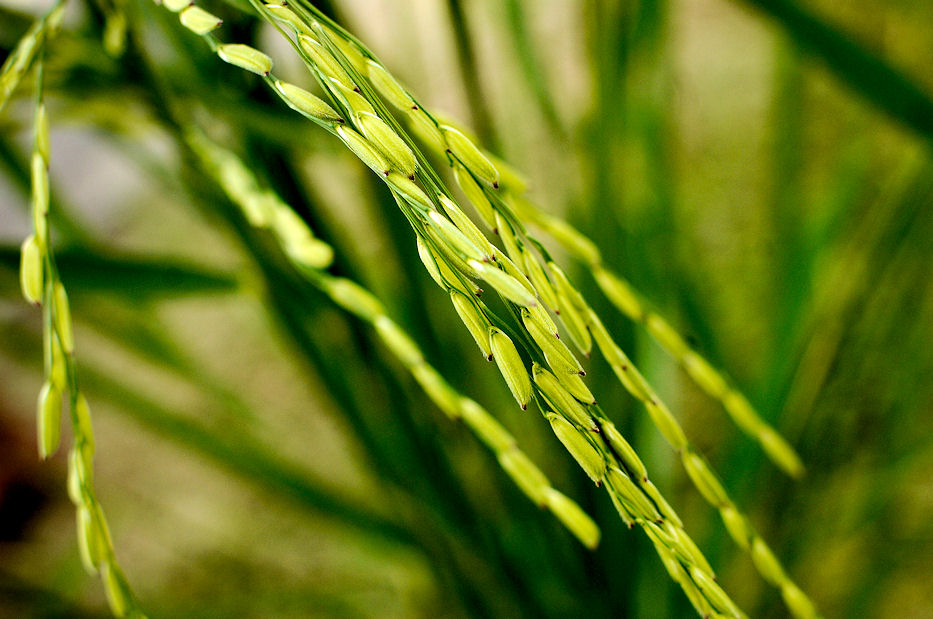
Abb.: व्रीहिः । Oryza sativa L. 1753 - Reis - Rice, Ähre von
Basmati-Reis 370
[Bildquelle: IRRI. --
http://www.flickr.com/photos/ricephotos/2198723243/. -- Zugriff am
2011-06-28. --
Creative
Commons Lizenz (Namensnennung, keine kommerzielle Nutzung, share alike)]
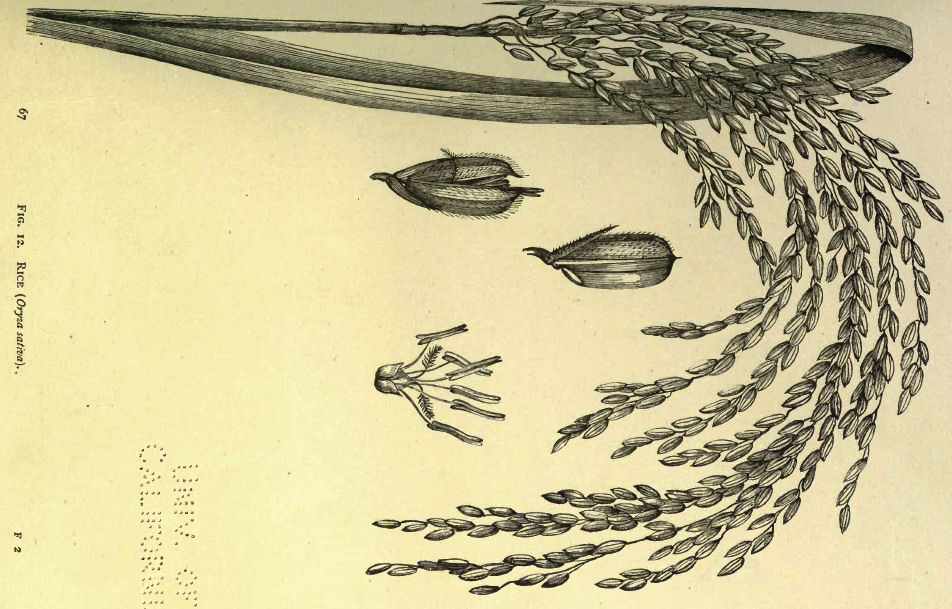
Abb.: व्रीहिः । Oryza sativa L. 1753 - Reis - Rice
[Bildquelle: Church, A. H. (Arthur Herbert) <1834-1915>: Food-grains of
India. -- London, 1886.]
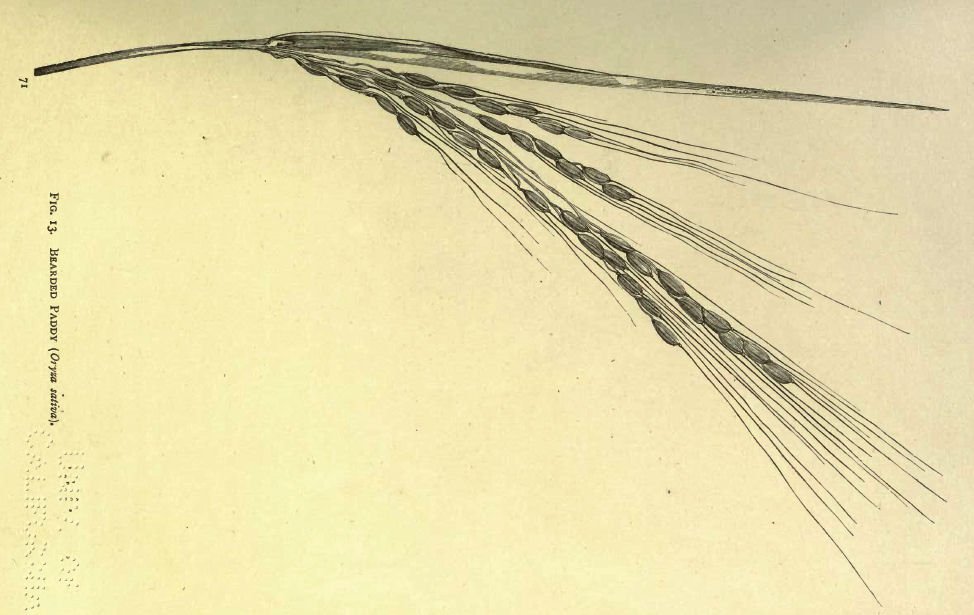
Abb.: व्रीहिः । Oryza sativa L. 1753 - Reis - Rice
[Bildquelle: Church, A. H. (Arthur Herbert) <1834-1915>: Food-grains of
India. -- London, 1886.]
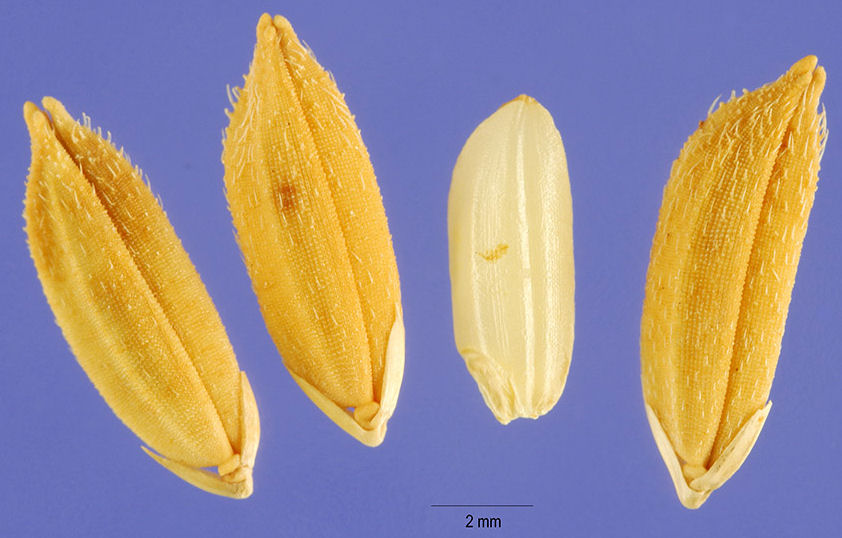
Abb.: व्रीहिः । Körner von Oryza sativa L. 1753 - Reis - Rice
[Bildquelle: Steve Hurst @ USDA-NRCS PLANTS Database. -- Public domain]
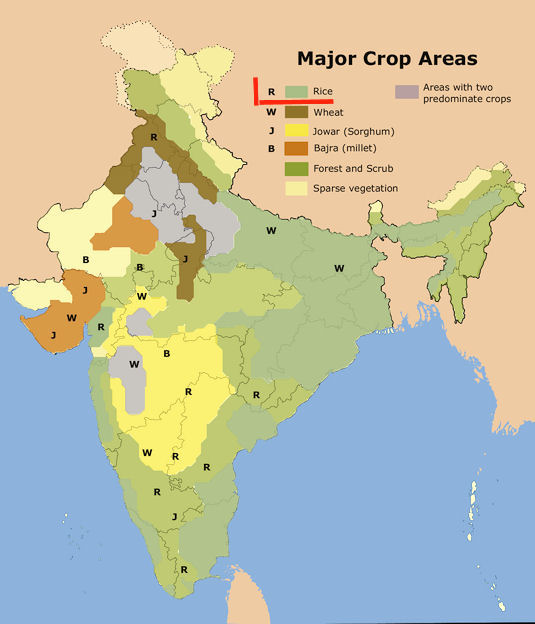
Abb.: व्रीहिः । Reisanbaugebiete Indiens
[Bildquelle: Amog / Wikimedia. --
Creative
Commons Lizenz (Namensnennung, share alike)]

Abb.: व्रीहिः । Vielfalt der Reissorten: Blick in einen Raum der
International Rice Genebank, wo ca. 110.000 (!) Reissorten keimfähig
erhalten werden, IRRI (International Rice Research Institute), Los Baños,
Philippinen
[Bildquelle: IRRI. --
http://www.flickr.com/photos/ricephotos/367810367/. -- Zugriff am
2011-06-28. -- Creative Commons Lizenz (Namensnennung, keine kommerzielle
Nutzung, share alike)]
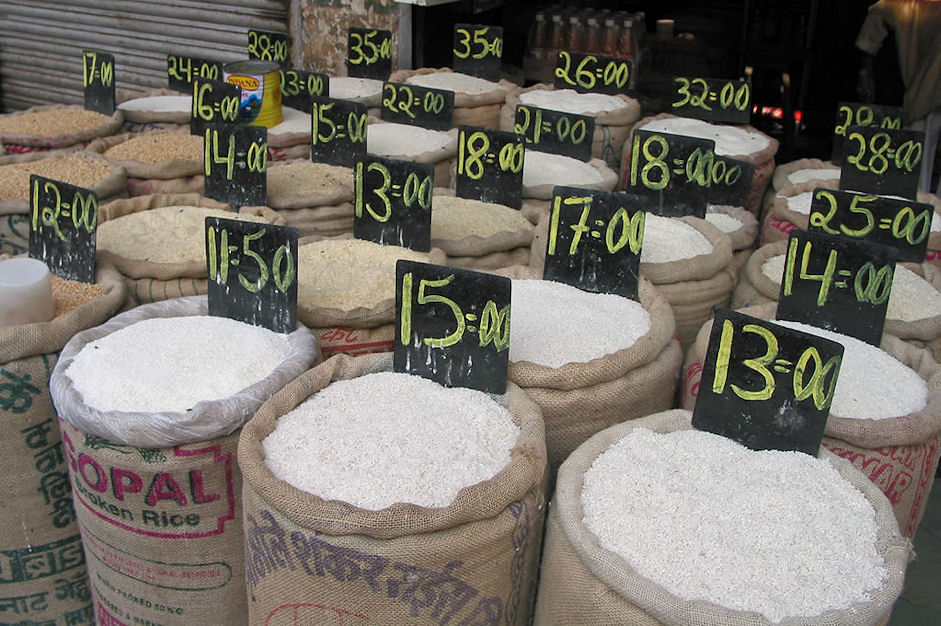
Abb.: व्रीहिः । Vielfalt der Reissorten: Kolaba (कुलाबा)
Markt in Mumbai - मुंबई, Maharashtra
[Bildquelle: ૐ Dey Alexander ૐ. --
http://www.flickr.com/photos/dey/3136417/. -- Zugriff am 2011-06-28. --
Creative
Commons Lizenz (Namensnennung, keine kommerzielle Nutzung, share alike)]
पाटल - pāṭala m.: Reis mit der Farbe von पाटला - pāṭalā f.:
Stereospermum chelonoides (L. f.) DC. 18381, d. h. gelber Reis
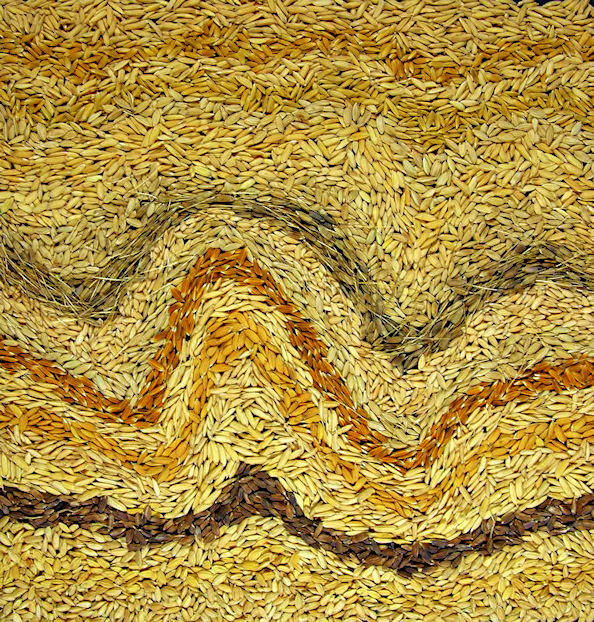
Abb.: पाटलः । Ausschnitt aus den farblichen Varietäten verschiedener
Reissorten / Artwork conceptualized by K. McNally
[Bildquelle: Chrisanto Quintana of IRRI. --
http://www.flickr.com/photos/ricephotos/3742368354/. -- Zugriff am
2011-06-28. --
Creative Commons Lizenz (Namensnennung)]
1
पाटला - pāṭalā f.: Stereospermum chelonoides (L. f.) DC. 1838Bignoniaceae - Trompetenbaumgewächse
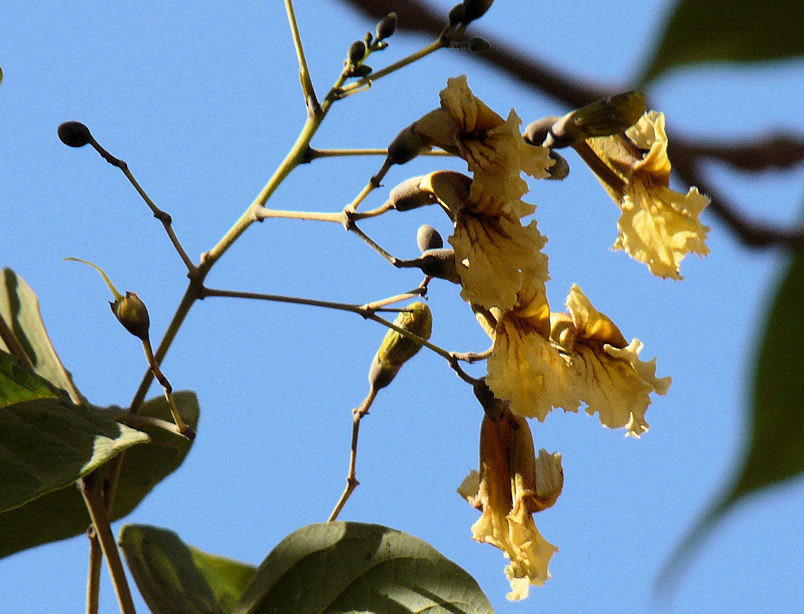
Abb.: पाटला - pāṭalā f.:
"RICE.
Oryza sativa, L.
Hind. - Beng. - Dhan (cleaned rice is Chauwal, Chawal, Chaol, in Hind.). Tamil
- Arisi. Telugu Ūri, Cheni, Matta-Karulu. Sind - Sari. Sinhalese - Goyang.
Sanskrit - Vrihi, Arunya, Dhanya.
Rice is an annual grass belonging to the tribe Oryzeae of the natural order Gramineae. It grows from 2 to 10 or more feet in height ; the panicles vary from 8 inches to a foot or even more in length, and become drooping; the fruit or grain is enclosed in but does not adhere to the pales.
The several rice-crops of India may be termed spring, summer, autumn, and winter-rice, from the seasons in which the different varieties are harvested. Winter-rice is the most important, constituting as it does about three-fourths of the entire amount. Only in Purī, Maldah, Rājshāhi, and Sylhet does spring-rice attain even so high a percentage of the entire crop as 12 to 25 ; in other localities it is not grown at all or its amount is quite insignificant. The autumn or intermediate crop of rice is likewise of little or no importance, save in about a dozen localities out of 63 concerning which we possess statistics. However, in Patnā, Hazāribāgh, Purī, and Cuttack, it may reach one-third -of the total out-turn, while it amounts to about one-fourth or one-fifth in Santāl Parganās, Bānkurā, and Midnapur. Summer-rice is a very general crop throughout India. In one locality, Nuddea, it yields two-thirds of the total amount grown ; in Champāran, Bīrbhūm, Dacca, and Faridpur, about one-third ; and in many other localities, about one-fourth.
The several rice-crops bear different names in different parts of India ; in the present section we have generally employed the terms used in Bengal, Boro for spring-rice, Aus for summer-rice, Kartika for autumn or intermediate rice, and Āman for winter-rice.
Spring-rice is sown, according to locality, from September to February, and reaped from March to June. Summer-rice is sown from May to July, and reaped from September to October. Autumn-rice is sown in Bengal from April to July, and reaped from August to November ; in Jessur it is sown in October and November, and reaped eleven months after. Winter-rice is sown from March to August, and reaped from November to January. Where one crop only of rice is grown in the year it is usually sown from May to August, and reaped from September to January. Where two crops are raised the yield of grain from both crops is little larger than that from one, but the straw of the crop gathered in the dry season, though a wretched fodder, is used for cattle-food. The two chief varieties of rice, winter and summer, are occasionally sown mixed together ; sometimes with Panicum miliaceum and Phaseolus Mungo. Peas, oil-seeds, barley, etc., are also largely sown over the nearly ripe crop, which, however, is cut before they appear above ground.
With regard to the several rice-crops, Mr. G. Watt says : "A proprietor of an estate, with a fairly mixed soil, might have three, if not four, or even five, harvests of rice every twelve months, thus :
- Aus harvest, from July to August.
- Chotan āman, from October to November.
- Boran āman, from December to January.
- Boro, from April to May.
- Raida, from September to October.
"Two harvests are all but universal in Bengal, with an occasional third but smaller one ; two crops are frequently taken off the same field."
"The long, thin chotan āman rices are eaten by the richer natives."
Rice grows well in stiff clays, especially in drainage-beds and basins. Manure is not often used. It is sown in a moist soil, or even in an actual mud, either broadcast or transplanted from a nursery when the plants are something less than a foot high ; the distance between the plants is about 6 inches. The yield of transplanted rice is 16 maunds of paddy per acre ; when sown broadcast it yields from 10 to 12 maunds. Mr. Duthie states that there are at least 100 cultivated varieties of rice in the North-West Provinces and Oudh ; a distinct -indigenous species of another genus, Hygrorhiza aristata (Nees), growing wild round lakes and marshes, is gathered and eaten by the poorer classes. The more important varieties of rice are semi-aquatic, and need copious and repeated irrigations. In some districts of Bengal a long-stemmed variety of rice is grown which will keep its head above 12 feet of water. On the other hand, there are varieties of rice which develop in temperate climates, even ascending the hills to an altitude of at least 8,000 feet, and requiring no irrigation.
The analyses which have been made of a large number of samples of "cleaned" rice, give figures which are wonderfully accordant, considering the great differences in the appearance of the specimens and the very diverse conditions under which they have been grown. The fibre and adventitious earth are sometimes rather high from imperfect cleaning of the grain, but the nitrogenous constituents or albuminoids oscillate within narrow limits probably nine samples out of ten will be found to contain not less than 7 per cent., and not more than 8. [...]
There are many districts in India where rice forms not merely the chief food-stuff but ¾ths or even 4/5ths of its total amount. In some places it even rises to 7/8ths or to 15/16ths of the whole quantity, as in Bardwān, Dinajpur, Maldah, Kuch Behar, Mānbhūm, and Darrang ; other districts might be named in which it constitutes the only food staple.
Dhan is rice in the husk, or paddy. Chaol is rice husked by pounding in a wooden mortar; in some districts it is, if new, parboiled and then dried before being pounded. Eight pounds of dhan produce 5 pounds of chaol; the separated pericarp is burned, the perisperm is given to fowls and pigs. The operation of pounding is attended with considerable loss, because many grains are broken and then afterwards winnowed away when tossing the rice in the air from the woven straw scoop. Bhat is boiled rice. In Tirhūt and Sāran the chaol is first washed and then boiled at night, for the evening meal, in much water. It is strained when hot, one-half or one-third being set aside under water (to save the cost of more fuel) for the morning meal— it has then become slightly acidulous. This preparation is eaten with curds, chillies, or one-fourth of dhal (pulse husked and split). Two pounds of cleaned rice weigh 5 pounds after boiling. The liquor is either thrown away or is drunk as a beverage after the addition of a little common salt, or is given to stall-fed milch cows.
Where rice constitutes the almost entire food of the population, the throwing away of the water in which it has been boiled involves the loss of some of the mineral matter in which rice is notoriously deficient, and is to be deprecated ; no more water should be used in cooking this grain than can be absorbed by it. Rice is sometimes boiled in milk. The parching of rice is often done by stirring it in hot sand and then sifting out the grains. They burst, and are eaten dry, or else are ground, mixed with water, and consumed at midday meals by travellers and labourers. In Maldah the Hindustani-speaking population use rice and wheat, the pure Bengali confines himself to rice. In Benares rice is not much used, being replaced, amongst the poor, by wheat, barley, jowari, bājra, and maize. The industrial and labouring classes of Mirzāpur consume but little rice, living chiefly on barley and the various millets.According to the "Report of the Famine Commission" the percentages of the rice-eating population in 7 provinces, etc.,were :
Madras 32 Central Provinces 31 Mysore 20 Bombay 12 North-West Provinces and Oudh 19 Punjab 5 Berar 2 The exports of rice and paddy from India amounted in 1882-83 to 31¼ million cwts. Sixty-eight percent. of this came from Burma, 26 per cent. from Bengal, and 4 per cent. from Madras. Of the total exports, 61 per cent. were sent to England or the Continent (including Egypt).
Rice is eaten in many forms and prepared in many ways besides those already described. The five following preparations may be selected for notice :
Churwa, Chura, or Chira. Some dhan is boiled, dried, and pounded to separate the husks ; the chaol thus obtained is then heated in a wide-mouthed earthen pot, and while still hot is flattened by beating. This preparation may be eaten alone, but it is often made into balls with gūr or molasses, or taken with curdled milk (doyi) with milk and tamarinds, or with sweetmeats.
Alochira is made by steeping the rough dhan for a night in cold water ; it is then parched and afterwards flattened by beating.
Khoyi is made by parching rice which has been exposed to the dew. It is eaten with molasses, constituting murki, or with milk.
Muri or Murhi is prepared by first heating chaol with salt for about half-an-hour in a shallow earthen vessel kept agitated, and finally parching it. It is eaten by the poor, generally by itself but sometimes with oil.
Chaol-ka-atta is rice-meal made by slow grinding in heavy hand-mills. It is kneaded with water into balls or cakes (bhaka), which are boiled like a pudding, or used as bread."
[Quelle: Church, A. H. (Arthur Herbert) <1834-1915>: Food-grains of India. -- London, 1886. -- S. 66 - 75]
"ORYZA SATIVA, Linn. Fig.—Bentl. and Trim., t. 291; Rheede, Hort. Mal. v., 196—201.
Rice (Eng.)
Hab.—Throughout India, wild and cultivated. The grain, spirit, and vinegar.
[...]
History, Uses, &c.—Wild rice was probably used by the aboriginal tribes of India in prehistoric times; it is still carefully collected by the peasantry, who consider it to have special virtues, and call it "god's rice," "hermit's rice," &c. Rice (व्रीहि is not mentioned in the Rig-Veda, but in the Atharva-Veda it is noticed along with barley, māsha (Phaseolus Roxburghii), and sesamum. Rice cultivation in India appears to have been subsequent to that of China and Burma. Girard de Rialle, in his Mythologie comparée, states that the Karens of Burma believe that every plant has its lā or kelah (spirit). The rice has its spirit, and when the crop is bad, they pray to it in the following terms: "Come, O spirit of the rice, come back ! come to the rice-field, come to the rice ! come from the East, come from the West, come from the beak of the bird, from the mouth of the monkey, from the throat of the elephant, come from the grain stores! O kelah of the rice, return to the rice!" In Siam they offer rice and cakes to trees before cutting them down. In Bengal sacrifices of rice are made to the Bael tree, probably a survival of an ancient fetish worship which the Brahmins have sanctioned by deifying the tree.
Rice plays an important part in the marriage ceremonies of the Hindus. According to the Grihya-sutra of Asvalāyana, the bride must walk three times round the altar, and at the completion of each turn make an offering of rice. This ceremony resembles an ancient form of marrying among the Romans, in which an offering of a cake made of fār (spelt) was made in the presence of the Pontifex Maximus or Flamen Dialis and ten witnesses.
Parched rice, Lājā also called Syāla (Sya "a winnowing fan," and lā for lājā), is scattered by the bride's brother at marriages. Rice is poured over the head of the bride and bridegroom as an emblem of life, regeneration and plenty. On the fourth day of the marriage ceremonies the young couple eat rice together for the first and only time in their lives, and on the last day they both celebrate together the Soma sacrifice, when they throw lājā into the fire. At the birth of a child the father places the red Akshata rice on its forehead to avert evil, and when the child is named it is placed on a cloth covered with rice. Rice is also used in some parts of India to detect witches: a small bag of rice, bearing the name of each of the suspected parties, is placed in a white-ants' nest, and the one they first eat is considered to belong to the guilty party. When several persons are suspected of a crime, rice is sometimes used to detect the guilty one— For this purpose the persons are required to chew rice, the criminal being discovered by his inability to properly masticate it, owing probably to fear checking the free flow of saliva. Vincenzo Maria da Santa Caterina mentions in his travels that rice and turmeric are offered in India to the gods to obtain children and the cure of female diseases, and that young girls make a vow to offer rice, should they obtain a good husband. In the consecration of the Brahmachari, the father of the youth carries in his hands a cupful of rice, and the assistants after the bath cover the candidate with rice. Asvalāyana says that the disciple asks alms to learn the Vedas; he obtains the rice as alms and must cook it before sunset. His commentator, Narayana, adds that when the rice has been cooked, the disciple should say to his master, "the food of the pot is ready." In sacrifices to Rudra, according to Asvalāyana, the husk of rice was thrown into the fire along with the smallest grains, and the tail, skin, head, and feet of the animal, and that the latter before being killed was sprinkled with rice and barley-water.
In times of fasting and penitence, grains of rice and barley are watered and blessed and offered to the gods. In funeral ceremonies rice and other food is offered to crows. According to Manu, the twice-born are directed to offer five great sacrifices, viz., with wild rice (Nivāra), with various pure substances, or with herbs, roots, and fruits.
The practice of worshipping the new rice at the time of the harvest is common throughout India. In Bengal, on a Thursday, in the month of Pansha (December-January), after the crop has been reaped, a rattan-made grain measure called rek, filled with the grain upon which are placed gold, silver and copper coins and some cowrie shells, is worshipped as the representative of the goddess of fortune. This worship is repeated in the months of Chaitra, Sravana, and Kārtika. In Western India the new rice is worshipped at the Dasara and Devali festivals, and in Madras the same event is celebrated by the Pongol ceremony, when the new rice is boiled for the first time and eaten with great rejoicings. Among the Native Catholics the same ceremony is perpetuated in the "blessing of the new rice," which is done by the priest in the field before the crop is cut.
That the cultivation of rice had widely spread in the time of Alexander (400 B.C.) we learn from Strabo, who says,"according to Aristobulus, rice grows in Bactriana, Babylonia, Susida," and he adds, "we may also say in Lower Syria." Further on he notes that the Indians use it for food, and extract a spirit from it. The Greek names for rice are derived from the Sanskrit Vrihi; the earliest form occurs in a fragment of Sophocles, where rice-bread is called
ορινδης αρτος; in later writers we meet with the form ορυζα. The Arabic names have the same derivation, the oldest form being Runz, occurring in the local dialect of the Abd-el-Kais, near Bahrain, and the more modern forms Aruzz and Ruzz. In Persian the form of Birinj is current, as well as the Sanskrit name Shāli, for unhusked rice. Dioscorides briefly mentions rice as being of little nutritive value and apt to cause costiveness. Celsus (ii., 20) classes it along with wheat and spelt as "res boni succi." According to Sanskrit writers, the best class of grains includes wheat, rice, and barley only, other kinds being relegated to the class Kshudra dhānya or inferior grains. The preparations of rice used in the diet of sick people, and described in Sanskrit medical works, are:—यवागु (yavāgu) or powdered rice boiled with water. It is made of three strengths, namely, with nine, eleven, and nineteen parts of water, called, respectively, Vilepi, Peyā, and Manda. Instead of water, a light decoction of some aromatic and carminative drug, such as ginger or pepper, may be used in preparing yavāgu.
लाजा (lājā) or unhusked rice parched in hot sand. It is used as light and digestible diet for the sick.
भृष्टतण्डुल (brishta tandula) or husked rice parched in hot sand. It is used for the same purposes as lājā.
पृथूका (prithukā) or unhusked rice moistened, parched, and afterwards flattened and the husk removed. It is soaked in water or boiled and given with curdled milk as an astringent diet in diarrhoea or dysentery.
पायस (pāyasa) or rice-inilk. A well-known preparation.
तण्डुलाम्बु (tandulāmbu) or water in which unboiled rice has been steeped. This is often used as a vehicle for powders, &c., and as a diet drink.
Rice is the staple-food of the inhabitants in Bengal, many parts of Madras, Burma, and the Western Coast of India, but not of the central and northern parts of the country, where wheat and millet are the staples and rice only a luxury.
Fermented and distilled rice liquors are largely used in many parts of India. For an account of the economic uses of the grain, its cultivation, and the numerous varieties of the plant met with in different parts of the country, we must refer the reader to a diffuse but interesting article by Dr. G. Watt in the Dictionary of the Econ. Prod, of India."
[Quelle: Pharmacographia indica : a history of the principal drugs of vegetable origin met with in British India / by William Dymock [1834-1892], C. J. H. Warden and David Hooper [1858-1947]. -- Bd. 3. -- London, 1893. -- S. 601 - 605.]
Poaceae - Süßgräser
| 15c./d. āśu vrīhiḥ pāṭalaḥ syāt sitaśūka-yavau samau आशु व्रीहिः पाटलः स्यात् सितशूक-यवौ समौ ।१५ ख। [Bezeichnungen für Gerste - Hordeum vulgare L. 1753:]
|
Colebrooke (1807): "Barley."
सितशूक - sitaśūka m.: "weißgrannig", Gerste (Hordeum vulgare L. 1753)

Abb.: सितशूकः । Gerste - Hordeum
vulgare L. 1753 (man beachte die weißen Grannen = "Borsten")
[Bildquelle: Wikimedia. -- Public domain]
यव - yava m.: Gerste (Hordeum vulgare L. 1753)

Abb.: यवः । Gerste - Hordeum
vulgare L. 1753
[Bildquelle: Thomé, 1885]
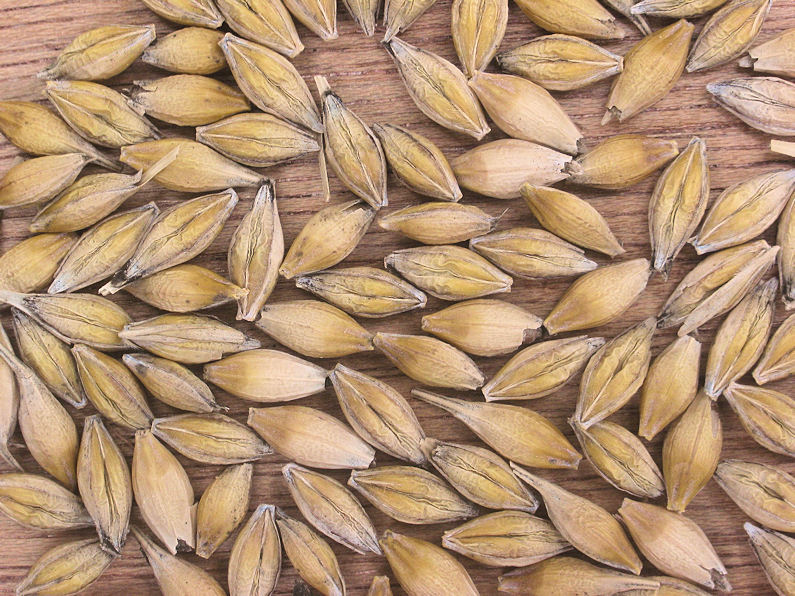
Abb.: यवः । Gerstenkörner - Hordeum
vulgare L. 1753
[Bildquelle: Rasbak / Wikimedia. -- GNU FDLicense]
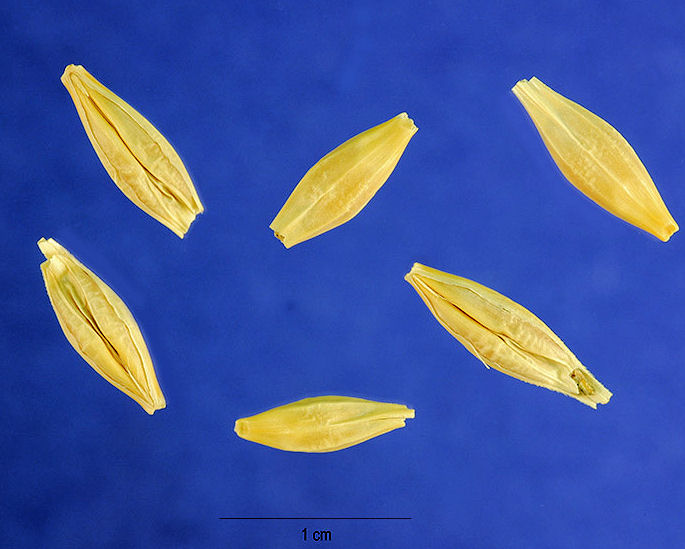
Abb.: यवः । Gerstenkörner - Hordeum
vulgare L. 1753
[Bildquelle: Steve Hurst @ USDA-NRCS PLANTS Database. -- Public
domain]
"HORDEUM HEXASTICHUM, Linn. Fig.—Duthie, Fodder Grasses of N. India, PL F, f. 32.
Barley
Hab.—Western temperate Asia. Cultivated in the N.-W. Provinces of India,
[...]
History Uses, &C.—Indra in the Rig-Veda is called durah yavasya, "the giver of the barley." At many Hindu ceremonies, such as the birth of a child, marriages, funerals, and in various sacrifices, barley is used. In the Atharva-Veda the rice and barley offered to the dead are prayed to to be propitious to them, and in the same Veda rice and barley are invoked for the cure of disease and deliverance from other evils: "Etau yakshmain vi bādhete; etan muñchato anhasas." Barley is symbolic of wealth and plenty; it is also a phallic emblem; Asvalāyana, in the first book of the Grihyasutra, says that in Vedic times, the wife when three months gone with child fasted; after her fast, her husband came to her with a pot of sour milk into which he threw two beans and a grain of barley, and whilst she was drinking it, he asked, "What drinkest thou ?" She, having drunk three times, replied, "I drink to the birth of a son." Nārāyana, in his Commentary on Asvalāyana, states that the two beans and the grain of barley represent the organs of generation. (De Gubernatis.)
At the Yava-chaturthi, on the fourth day of the light half of the month Vaisākh, a sort of game is played in which people throw barley-meal over each other. Yava-sura, an intoxicating drink, is made from barley in Northern India. According to Bretschneider, barley is included among the five cereals, which, it is related in Chinese history, were sowed by the Emperor Shen-nung, who reigned about 2700 B.C. ; but it is not one of the five sorts of grain which are used at the ceremony of ploughing and sowing as now annually performed by the emperors of China.
Theophrastus was acquainted with several sorts of barley (
κριθη), and, among them, with the six-rowed kind or hexastichon, which is the species that is represented on the coins struck at Metapontum in Lucania between the 6th and 2nd centuries B.C.Barley is mentioned in the Bible as a plant of cultivation in Egypt and Syria, and must have been, among the ancient Hebrews, an important article of food, judging from the quantity allowed by Solomon to the servant of Hiram, king of Tyre (B.C. 1015). The tribute of barley paid to King Jotham by the Ammonites (B.C. 741) is also exactly recorded. The ancients were frequently in the practice of removing the hard integuments of barley by roasting it, and using the torrified grain as food. (Pharmacographia.)
The Hindus employ barley in the dietary of the sick. It is chiefly used in the form of saktu or powder of the parched grain. Gruel prepared from saktu is said to be easily digested and to be useful in painful dyspepsia. In Europe, for use in medicine and as food for the sick, pearl-barley is always employed; this is the grain deprived of its husk by passing it between horizontal mill-stones, placed so far apart as to rub off the integuments without crushing it. Pearl-barley imported from Europe is obtainable in most Indian bazars. For an account of the economic uses of barley, we would refer the reader to an article by Dr. J. Murray in the Dict. Econ. Prod. of India (iv., p. 273).
[...]
Commerce.—The total yield of barley in British India does not exceed 50,000,000 cwts. In 1887-88 the total exports were 29,575 cwts., valued at Rs. 89,776, of which Bombay shipped 18,688 cwts., Bengal 6,873 cwts., and Sind 4,014 cwts., valued at Rs. 58,632, Rs. 20,556, and Rs. 10,588, respectively. The country which imported most largely was Persia, with 10,358 cwts.; following on which were, Arabia with 7,675 cwts , Ceylon with 7,539 cwts., and Aden, the United Kingdom, Zanzibar, and "other countries'' with insignificant quantities. (Diet. Econ. Prod. India, iv., p. 281.)"
[Quelle: Pharmacographia indica : a history of the principal drugs of vegetable origin met with in British India / by William Dymock [1834-1892], C. J. H. Warden and David Hooper [1858-1947]. -- Bd. 3. -- London, 1893. -- S. 615 - 618.]
| 16a./b. tokmas tu tatra harite kalāyas tu satīnakaḥ तोक्मस् तु तत्र हरिते कलायस् ति सतीनकः ।१६ ख। Grüne Gerste heißt तोक्म - tokma m.: "ein junger, grüner Halm von Getreidepflanzen, namentlich Gerste" (PW) |
Colebrooke (1807): "Green or unripe barley."
तोक्म - tokma m.: "ein junger, grüner Halm von Getreidepflanzen, namentlich Gerste" (PW)
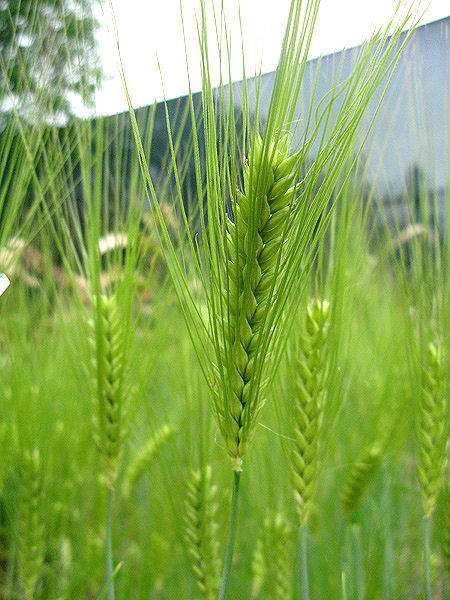
Abb.: तोक्मः । Gerste - Hordeum
vulgare L. 1753
[Bildquelle: Muséum de Toulouse. --
http://www.flickr.com/photos/museumdetoulouse/4656255862/. -- Zugriff am
2011-06-28. --
Creative Commons Lizenz (Namensnennung, keine Bearbeitung)]
Fabaceae - Hülsenfrüchtler
| 16a./b. tokmas tu tatra harite kalāyas tu satīnakaḥ 16c./d. hareṇu-khaṇḍikau cāsmin koradūṣas tu kodravaḥ
तोक्मस् तु तत्र हरिते कलायस् ति सतीनकः ।१६
ख। [Bezeichnungen für Lathyrus sativus L. 1840 - Saat-Platterbse - Chickling Pea:]
|
Colebrooke (1807): "Peas. Some writers distinguish the three first terms as names of three kinds of pulse."
Hindi: लतरी
कलाय - kalāya m.: Lathyrus sativus L. 1840 - Saat-Platterbse - Chickling Pea
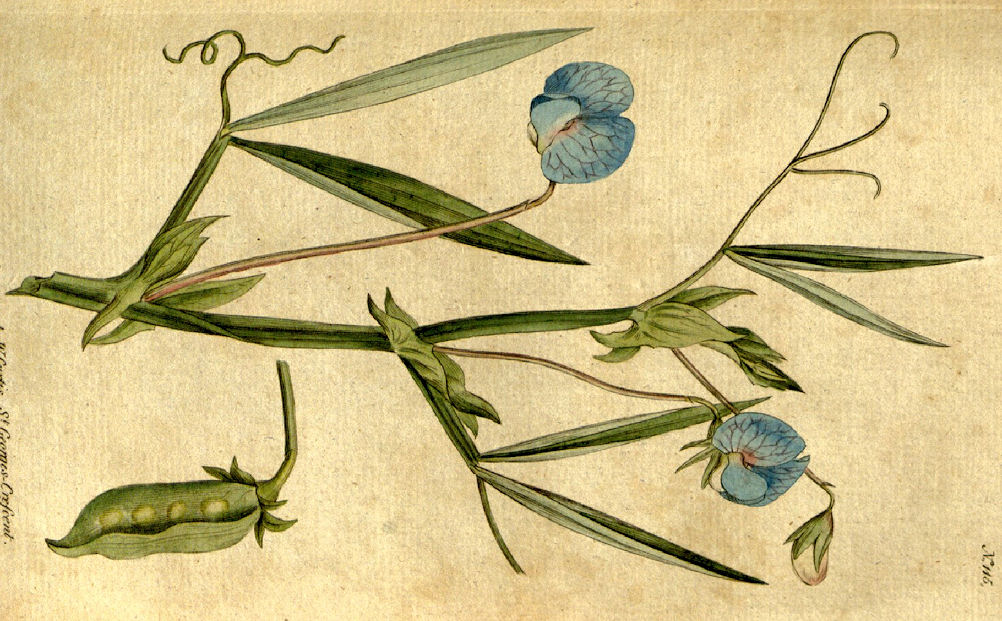
Abb.: कलायः । Lathyrus sativus L. 1840 - Saat-Platterbse -
Chickling Pea
[Bildquelle: Botanical Magazine. -- Vol. 3-4 (1790/91). -- Pl. 114.]
सतीनक - satīnaka m.: Lathyrus sativus L. 1840 - Saat-Platterbse - Chickling Pea
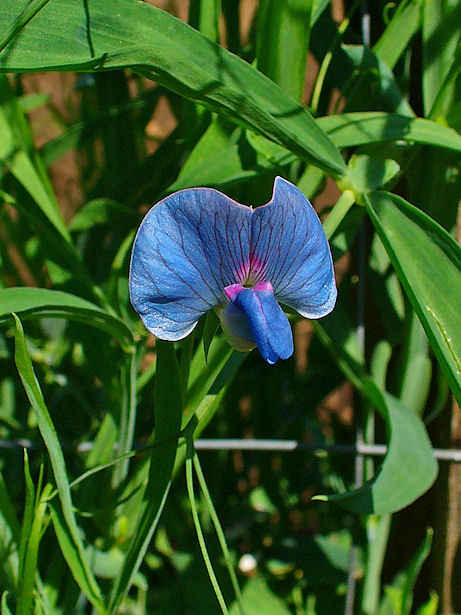
Abb.: सतीनकः । Lathyrus sativus L. 1840 - Saat-Platterbse -
Chickling Pea
[Bildquelle: H. Zell / Wikipedia. -- GNU FDLicense]
हरेणु - hareṇu m.: Lathyrus sativus L. 1840 - Saat-Platterbse - Chickling Pea
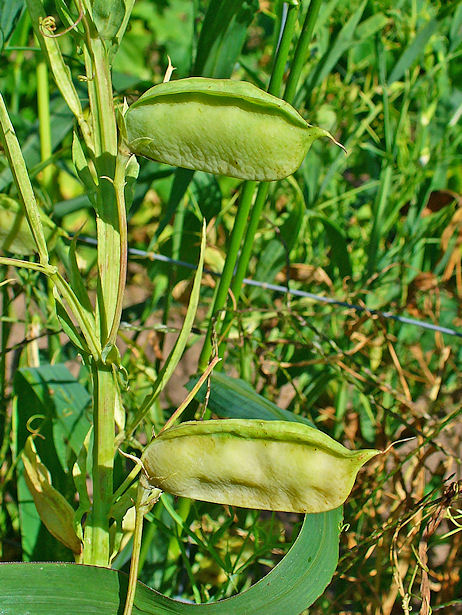
Abb.:
हरेणुः । Lathyrus sativus L. 1840 -
Saat-Platterbse - Chickling Pea
[Bildquelle: H. Zell / Wikipedia. -- GNU FDLicense]
खन्डिक - khaṇḍika m.: Lathyrus sativus L. 1840 - Saat-Platterbse - Chickling Pea
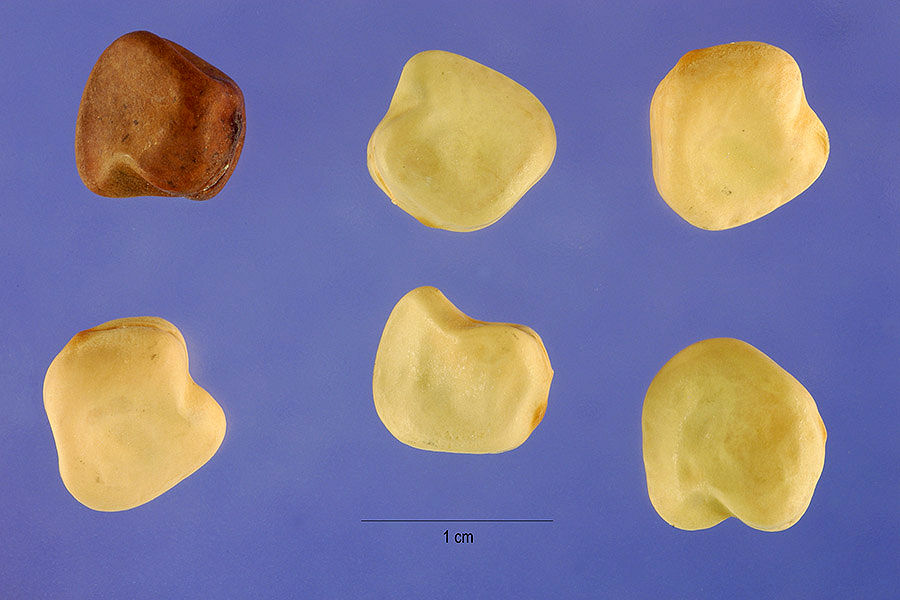
Abb.: खन्डिकाः । Lathyrus sativus L.
1840 - Saat-Platterbse - Chickling Pea
[Bildquelle: Steve Hurst @ USDA-NRCS PLANTS Database. -- Public domain]
"THE VETCHLING. Lathyrus sativus, L.
[...]
A much-branched annual herb, having equally pinnate leaves ; leaflets 2, linear or lanceolate. The pods are 1½ inch long, 4 to 5-seeded. It is spread through the Northern Provinces, ascending from the plains of Bengal to 4,000 feet in Kumaun.
The genus Lathyrus belongs to the tribe Vicieae of the suborder Papilionaceae. There is another species, not an Indian plant (L. tingitanus), which like L. sativus is extensively cultivated.
This is a cold-weather or rabi crop, and is grown on land unfitted for most other pulse. It is sown in October and November and reaped in March and April.
[...]
There is reason to suspect the occasional presence, in injurious proportion, of a poisonous bitter principle in this vetchling. It has a bad reputation, and is almost universally regarded in Bengal as unwholesome, deranging digestion, and producing dysentery, diarrhoea, and various skin diseases. But some allowance must be made for the prejudice of the Bengalese. It is most used by the poorer classes, being
the cheapest and most abundant pulse. Many cases of sudden and incurable paralysis have been undoubtedly traced to the large and continuous use of this seed. It formed, by a series of accidents, the chief food, during the years 1829-33, of some of the eastern villages of Oudh. Many cases of sudden paralysis of the lower extremities occurred during that period, the persons attacked being generally under thirty years of age.This is a coarse kind of pulse, hard and difficult to cook. It is used in Behar and Patna in curries. It is also made into paste-balls which are fried in ghi and eaten with boiled rice ; it is also eaten as dal."
[Quelle: Church, A. H. (Arthur Herbert) <1834-1915>: Food-grains of India. -- London, 1886. -- S. 132 - 135.]
Poaceae - Süßgräser
| 16c./d. hareṇu-khaṇḍikau cāsmin koradūṣas tu kodravaḥ हरेणु-खन्डिकौ चास्मिन् कोरदूषस् तु कोद्रवः ।१६ ख। [Bezeichnungen für Paspalum scrobiculatum L. 1767 - Kodo-Hirse - Kodo Millet:]
|
Colebrooke (1807): "Sort of grain. Paspalum frumentaceum, Koen. or P. Kora, Willd."
कोरदूष - koradūṣa m.: "Gelenkverderber", Paspalum scrobiculatum L. 1767 - Kodo-Hirse - Kodo Millet
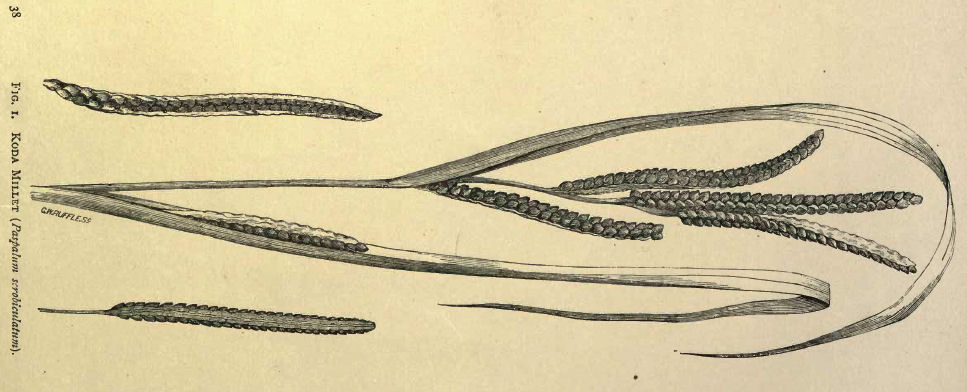
Abb.: कोरदूषः । Paspalum scrobiculatum L. 1767 - Kodo-Hirse -
Kodo Millet
[Bildquelle: Church, A. H. (Arthur Herbert) <1834-1915>: Food-grains of
India. -- London, 1886.]
कोद्रव - kodrava m.: Paspalum scrobiculatum L. 1767 - Kodo-Hirse - Kodo Millet
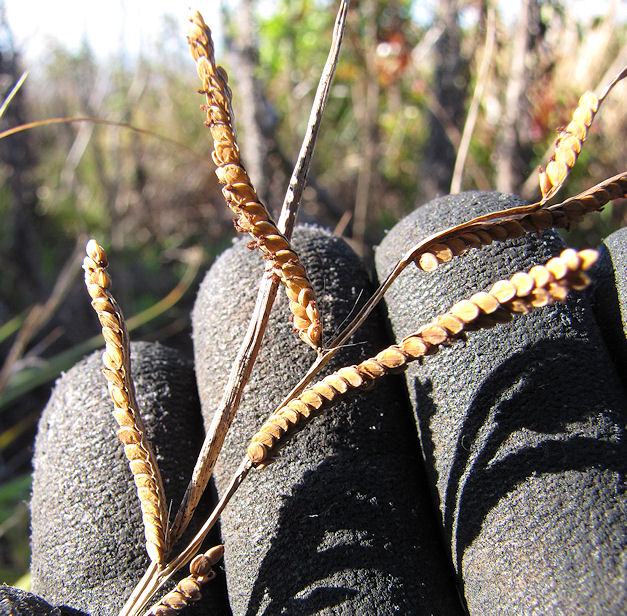
Abb.: क्रोद्रवः । Paspalum scrobiculatum L. 1767 - Kodo-Hirse -
Kodo Millet
[Bildquelle: Forest & Kim Starr. --
http://www.hear.org/starr/images/image/?q=100218-2166&o=plants. -- Zugriff
am 2011-06-29. --
Creative Commons Lizenz (Namensnennung)]
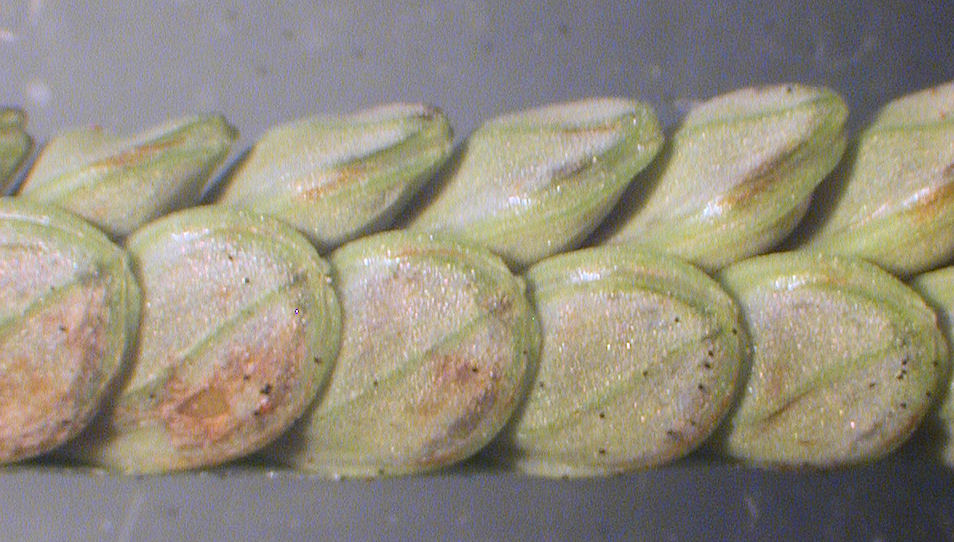
Abb.: क्रोद्रवः । Paspalum scrobiculatum L. 1767 - Kodo-Hirse -
Kodo Millet
[Bildquelle: Forest & Kim Starr. --
http://www.hear.org/starr/images/image/?q=030405-0428&o=plants. -- Zugriff
am 2011-06-29. --
Creative Commons Lizenz (Namensnennung)]
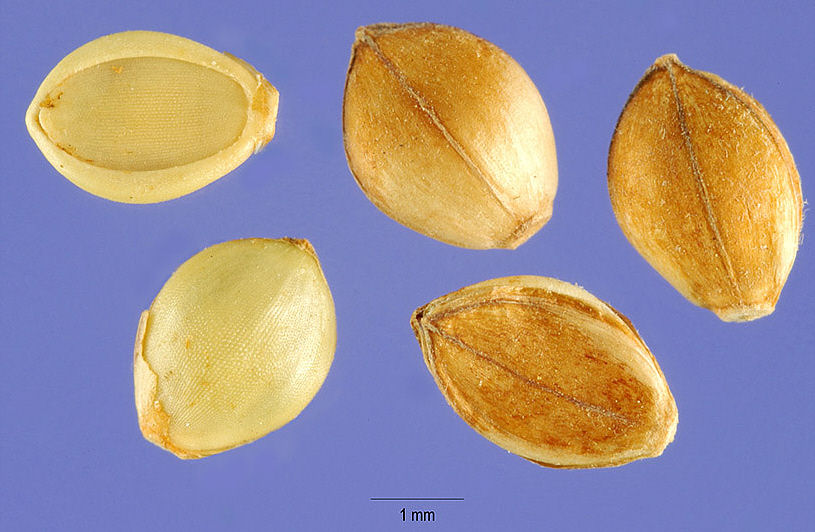
Abb.: क्रोद्रवः । Paspalum scrobiculatum L. 1767 - Kodo-Hirse -
Kodo Millet
[Bildquelle: Steve Hurst @ USDA-NRCS PLANTS Database. --
http://plants.usda.gov/java/profile?symbol=PASC6. -- Zugriff am
2007-07-10. -- Public Domain]
"Kodo millet was domesticated in India almost 3000 years ago. It is found across the old world in humid habitats of tropics and subtropics. It is a minor grain crop in India, and an important crop in the Deccan plateau. The fibre content of the whole grain is very high. Kodo millet has around 11% protein, and the nutritional value of the protein has been found to be slightly better than that of foxtail millet but comparable to that of other small millets. As with other food grains, the nutritive value of Kodo millet protein could be improved by supplementation with legume protein."
[Quelle: http://test1.icrisat.org/SmallMillets/Kodo_Millet.htm. -- Zugriff am 2011-06-29]
Fabaceae - Hülsenfrüchtler
| 17a./b. maṅgalyako masūro 'tha makuṣṭhaka-mapaṣṭhakau मङ्गल्यको मसूरो ऽथ मकुष्ठक-मपष्ठकौ ।१७ क। [Bezeichnungen für Lens culinaris Medik. 1787 - Gemüse-Linse - Lentil:]
|
Colebrooke (1807): "Lentil. Ervum lens or Cicer lens."
मङ्गल्यक - maṅgalyaka m.: "Glückbringer", Lens culinaris Medik. 1787 - Gemüse-Linse - Lentil
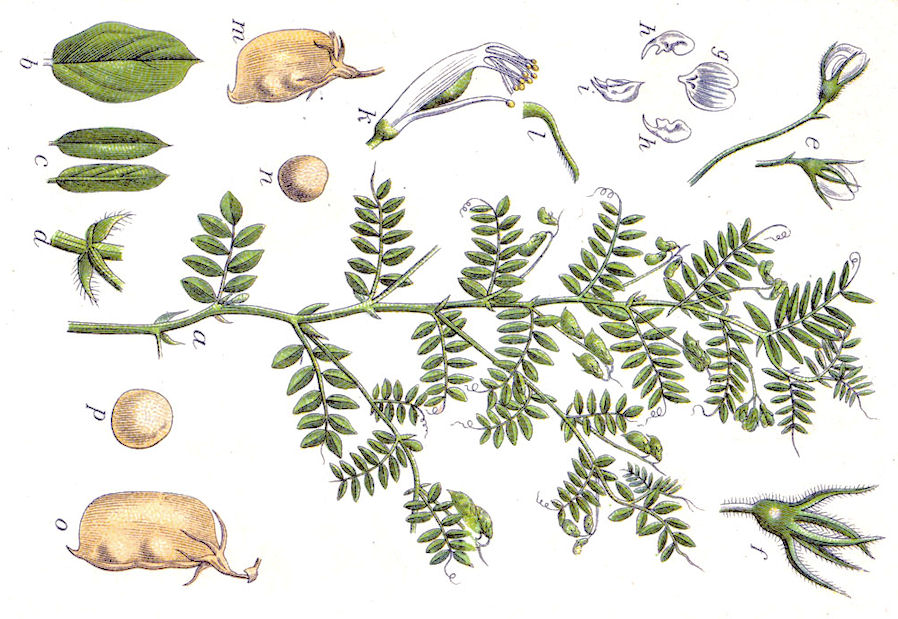
Abb.: मङ्गल्यकः । Lens culinaris Medik. 1787 - Gemüse-Linse -
Lentil
[Bildquelle: Jacob Sturm, 1796]
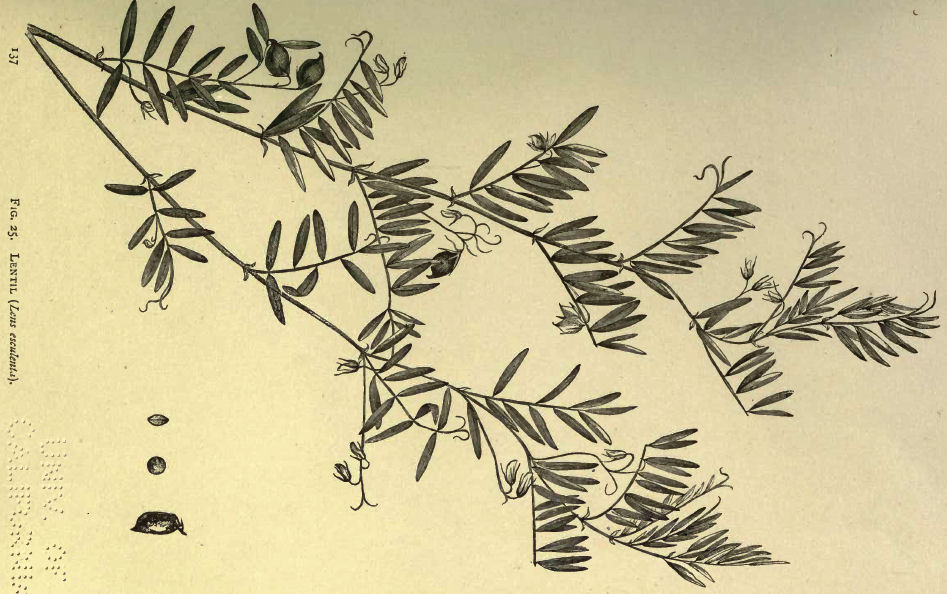
Abb.: मङ्गल्यकः । Lens culinaris Medik. 1787 - Gemüse-Linse -
Lentil
[Bildquelle: Church, A. H. (Arthur Herbert) <1834-1915>: Food-grains of
India. -- London, 1886.]
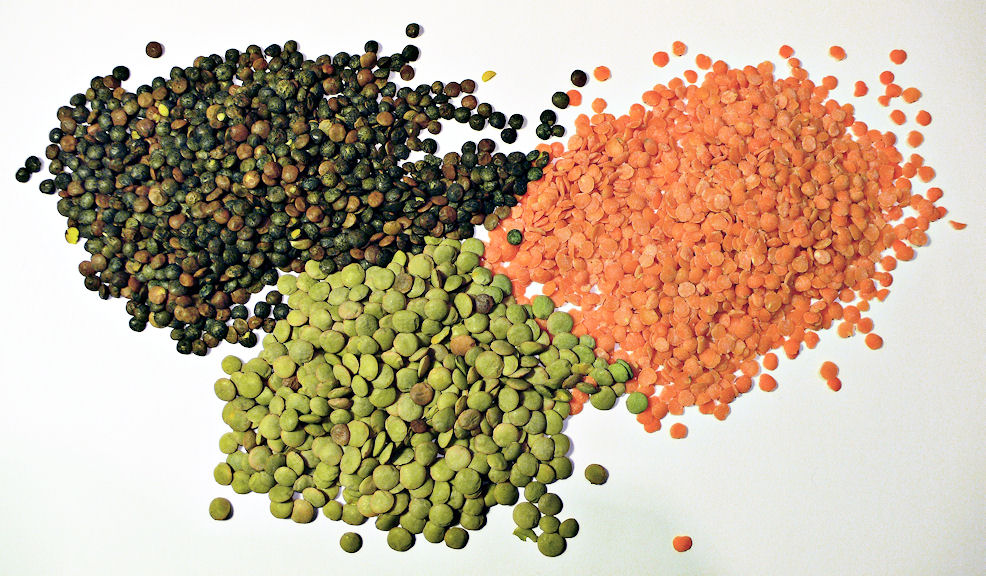
Abb.: मङ्गल्यकाः। Lens culinaris Medik. 1787 - Gemüse-Linse -
Lentil
[Bildquelle: Hohum / Wikipedia. --
Creative
Commons Lizenz (Namensnennung, share alike)]
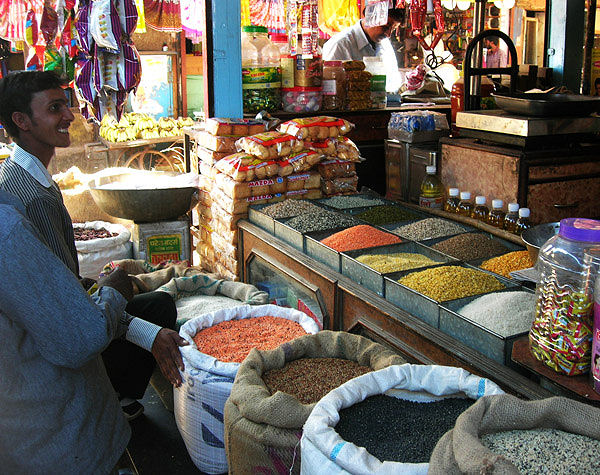
Abb.: मङ्गल्यकः । Linsen-Geschäft, Nashik -
नाशिक, Maharashtra
[Bildquelle: Dominic Rivard. --
http://www.flickr.com/photos/rivard/3261395925/. -- Zugriff am
2011-06-29. --
Creative Commons Lizenz (Namensnennung, keine Bearbeitung)]
मसूर - masūra m.: Lens culinaris Medik. 1787 - Gemüse-Linse - Lentil
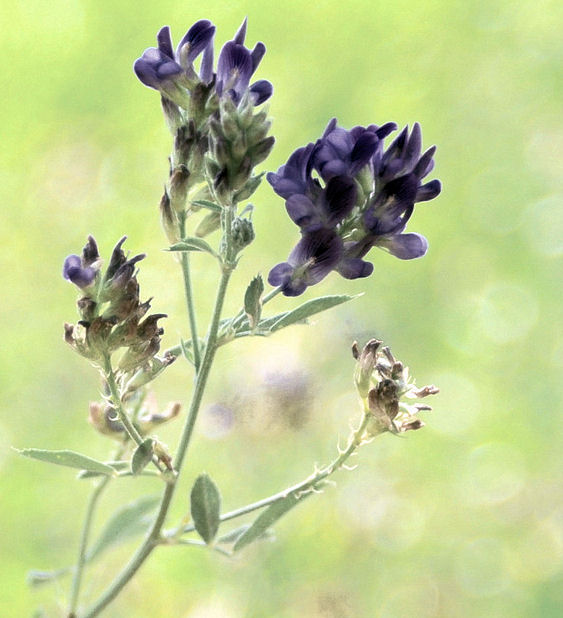
Abb.: मसूरः । Lens culinaris Medik. 1787 - Gemüse-Linse - Lentil,
Mallorca, Spanien
[Bildquelle: Marga Frontera. --
http://www.flickr.com/photos/ninapetita/4831235376/. -- Zugriff am
2011-06-29. -- Creative
Commons Lizenz (Namensnennung, keine kommerzielle Nutzung, share alike)]
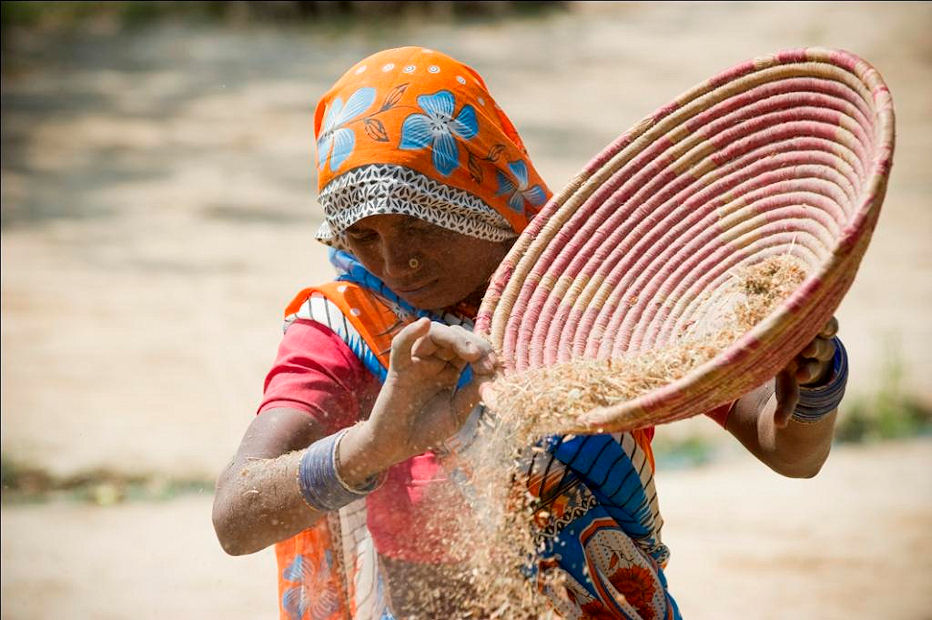
Abb.: मसूरः । Worfeln von Linsen, Uttar Pradesh
[Bildquelle: Gates Foundation. --
http://www.flickr.com/photos/gatesfoundation/5076532362/. -- Zugriff am
2011-06-29. --
Creative Commons Lizenz (Namensnennung, keine kommerzielle Nutzung,
keine Bearbeitung)]
"THE LENTIL. Lens esculenta, Moench.
[...]
This plant belongs to the tribe Vicieae ; the botanical name by which it is best known is Ervum lens, but the genus Ervum has now been sunk, partly in Lens. The lentil is a branched annual with oblong leaflets, usually 8 in number. The pod is broad and short, and contains 2 seeds, weighing from 1 to 1½ grain apiece in the large seeded variety. The seeds are compressed, and have the form of a bi-convex lens. This plant has been largely cultivated from very ancient times ; its native country is unknown.
The lentil may be grown on almost all soils ; it flourishes upon those which, while light, lie low. It is grown like peas as a cold-weather crop, being sown in September and October, and reaped in March and April. It is commonly cultivated, especially in the North-West Provinces and Madras. It yields from 6½ to 8 maunds per acre, or, if irrigated, 10 to 12 maunds. The yield might be increased if more pains were taken in the selection of seed for sowing, as there are some varieties of the lentil which produce seeds weighing twice as much as the small common sort, and which yet do not make a proportionately increased demand upon the resources of the soil.
[...]
The lentil is generally regarded as a pulse of the second class, inferior to mūng (Phaseolus Mungo), but equal to urhur, the pigeon-pea. It is highly nutritious but somewhat heating; it should be carefully freed from the husk or coat. The bitter substance which occurs in lentils may be removed to some extent by soaking them for a short time in water in which a little carbonate of soda (common washing soda) has been dissolved. The meal of lentils, deprived of their coat, is of great richness, containing generally more albuminoid or flesh-forming matter than bean or pea-flour. The preparations advertised under the names of "Revalenta," "Ervalenta," etc., consist mainly of lentil meal, mixed with the flour of barley or some other cereal, and common salt."
[Quelle: Church, A. H. (Arthur Herbert) <1834-1915>: Food-grains of India. -- London, 1886. -- S. 136 - 139.]
Fabaceae - Hülsenfrüchtler
| 17a./b. maṅgalyako masūro 'tha mayuṣṭhaka-mapaṣṭhakau 17c./d. vanamudgaḥ sarṣape tu dvau tantubha-kadambakau मङ्गल्यको मसूरो
ऽथ मयुष्ठक-मपष्ठकौ ।१७ क।
|
Colebrooke (1807): "Sort of kidney bean. Phaseolus lobatus [= Vigna hookeri ."
मयुष्ठक - mayuṣṭhaka m.: Vigna hookeri
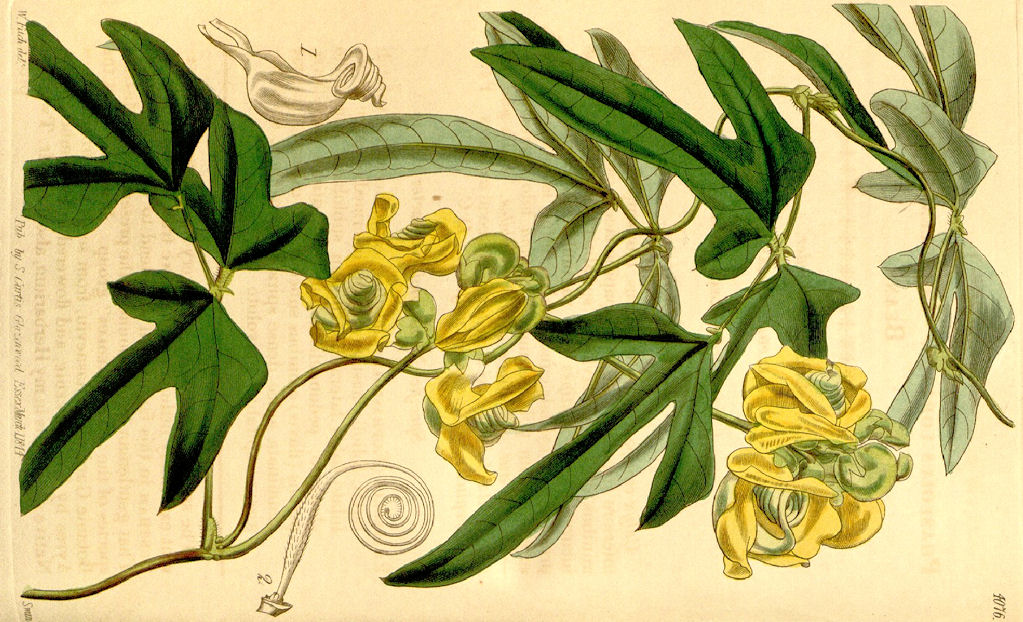
Abb.: मयुष्ठकः ।
Vigna hookeri
[Bildquelle: Curtis's Botanical Magazine, v. 70 (1844), Tab. 4076]
Fabaceae - Hülsenfrüchtler
| 17c./d.
vanamudgaḥ sarṣape
tu dvau tantubha-kadambakau वनमुद्गः सर्षपे तु द्वौ तन्तुभ-कदम्बकौ ।१७ ख। [Bezeichnungen für die Wildform von Vigna radiata (L.) R. Wilczek 1954 - Mungbohne - Mungbean:] वनमुद्ग - vanamudga m.: Wald-Mudga = Vigna radiata (L.) R. Wilczek 1954 - Mungbohne - Mungbean |
वनमुद्ग - vanamudga m.: Wald-Mudga = Vigna radiata (L.) R. Wilczek 1954 - Mungbohne - Mungbean
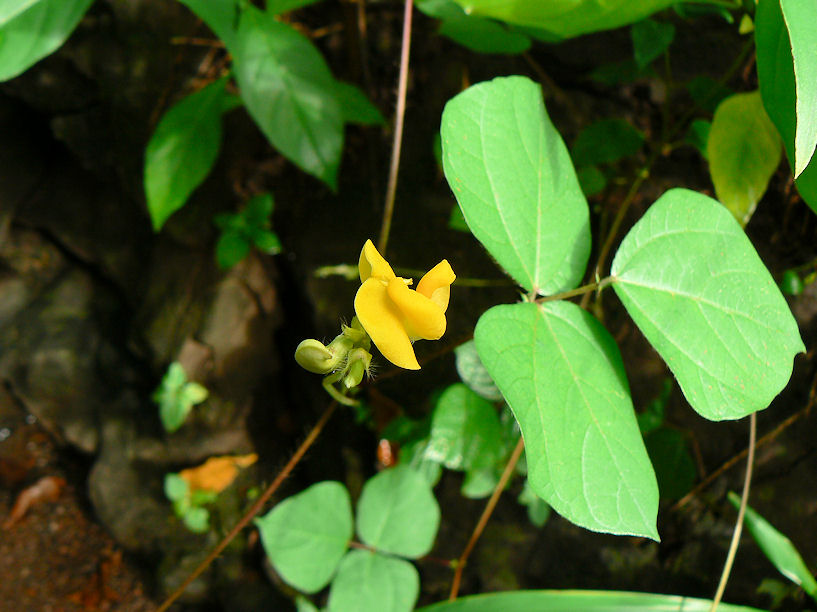
Abb.: वनमुग्दः । Vigna radiata (L.) R. Wilczek 1954 - Mungbohne -
Mungbean, Wildform
[Bildquelle: dinesh_valke. --
http://www.flickr.com/photos/dinesh_valke/1390901887/. -- Zugriff am
2011-06-28. --
Creative
Commons Lizenz (Namensnennung, keine kommerzielle Nutzung, keine
Bearbeitung)]
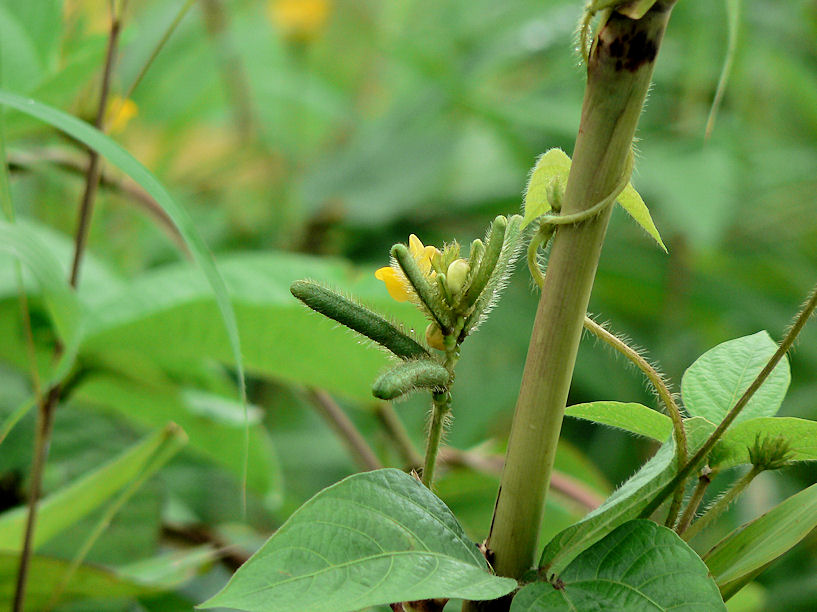
Abb.: वनमुग्दः । Vigna radiata (L.) R. Wilczek 1954 - Mungbohne -
Mungbean, Wildform
[Bildquelle: dinesh_valke. --
http://www.flickr.com/photos/dinesh_valke/1427320564/. -- Zugriff am
2011-06-28. --
Creative
Commons Lizenz (Namensnennung, keine kommerzielle Nutzung, keine
Bearbeitung)]
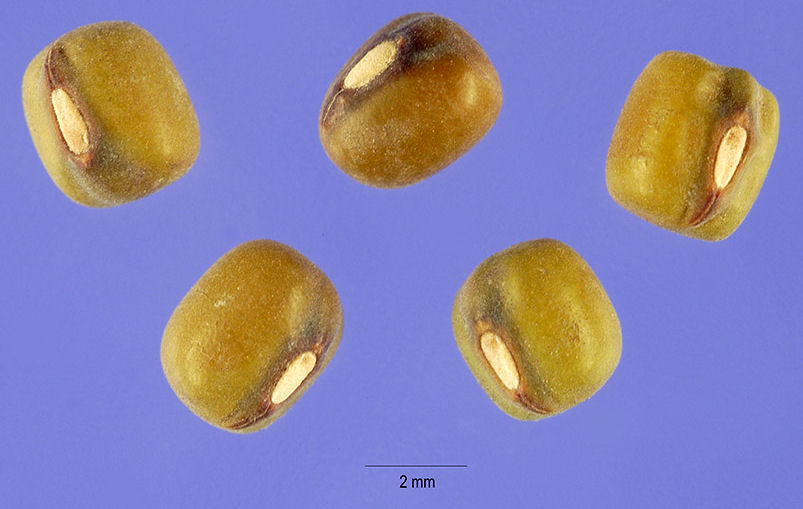
Abb.: वनमुग्दः । Samen
von Vigna radiata (L.) R. Wilczek 1954 - Mungbohne -
Mungbean
[Bildquelle: Steve Hurst @ USDA-NRCS PLANTS Database. -- Public domain]
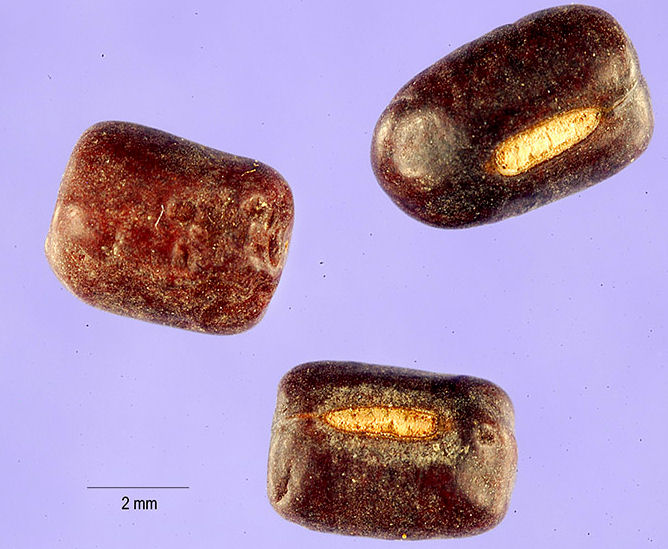
Abb.: वनमुग्दः । Samen
von Vigna radiata (L.) R. Wilczek 1954 var. radiata - Mungbohne -
Mungbean
[Bildquelle: Tracey Slotta @ USDA-NRCS PLANTS Database. -- Public domain]
Brassicaceae - Kreuzblütengewächse
|
17c./d.
vanamudgaḥ sarṣape
tu dvau tantubha-kadambakau वनमुद्गः सर्षपे तु द्वौ तन्तुभ-कदम्बकौ ।१७ ख। Bezeichnungen für Brassica juncea (L.) Czern. - Brauner Senf - Indian Mustard (सर्षप - sarṣapa m.):
|
Colebrooke (1807): "Mustard seed. Sinapis dichotoma, Roxb."
Tamil: கடுகு
Andere: Brassica rapa subsp. rapa L. - Stoppelrübe - Field Mustard
सर्षप - sarṣapa m.: Senf, Brassica juncea (L.) Czern. - Brauner Senf - Indian Mustard
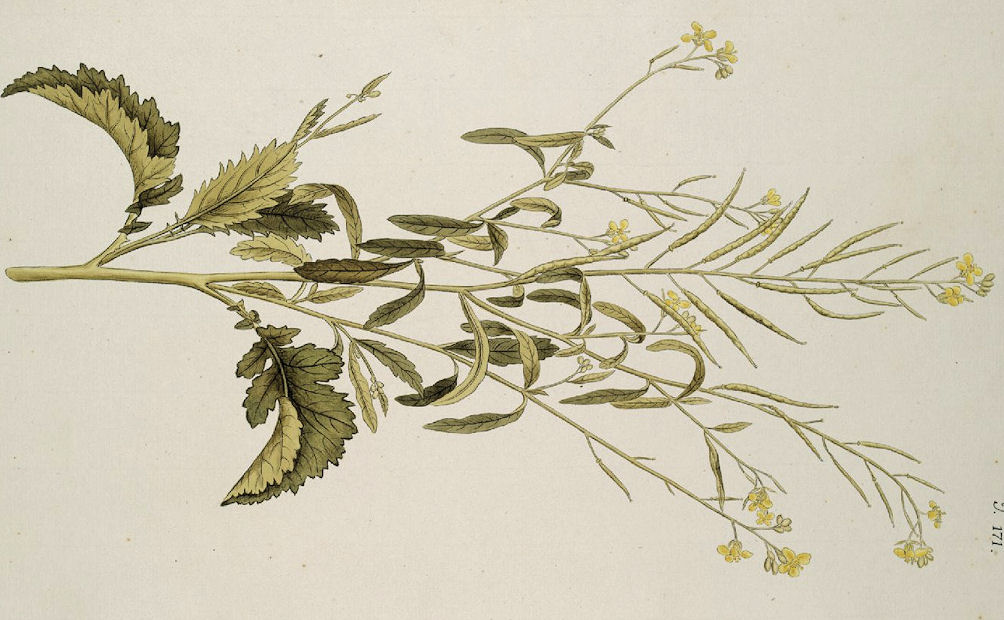
Abb.: सर्षपः । Brassica juncea (L.) Czern. - Brauner Senf - Indian
Mustard
[Bildquelle: Hortus botanicus Vindobonensis / Nicolaus
Josephus Jacquin, 1772]
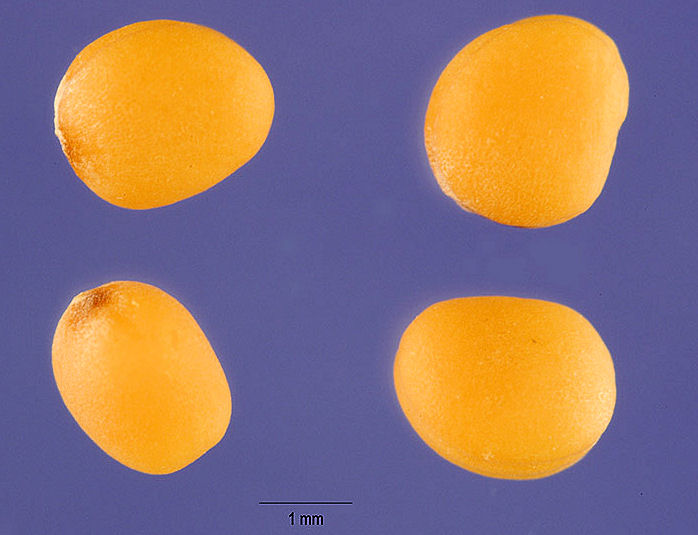
Abb.: सर्षपः । Samen von Brassica juncea (L.) Czern. - Brauner Senf -
Indian Mustard
[Bildquelle: Steve Hurst @ USDA-NRCS PLANTS Database. -- Public domain]
तन्तुभ - tantubha m.: "Wie Gewebefäden aussehend", Brassica juncea (L.) Czern. - Brauner Senf - Indian Mustard
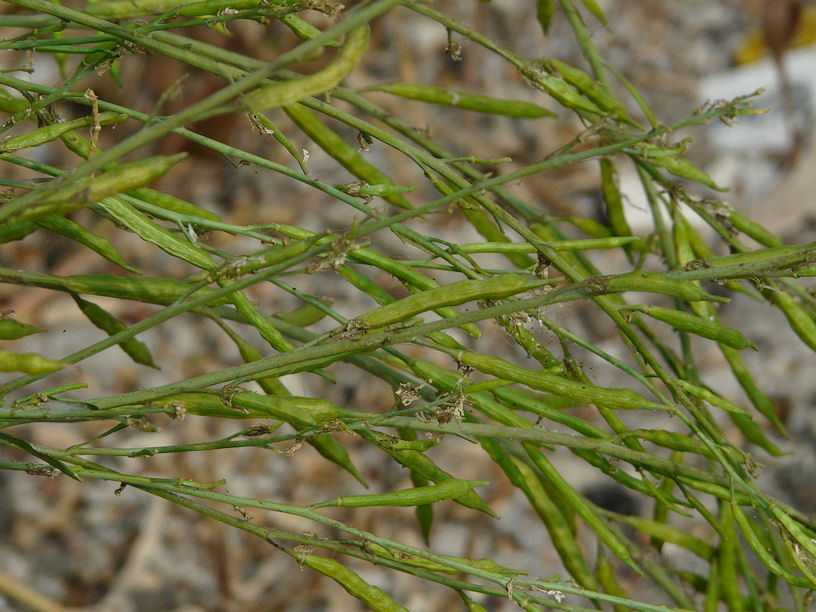
Abb.: तन्तुभः । Brassica juncea (L.) Czern. - Brauner Senf - Indian
Mustard
[Bildquelle: dinesh_valke. --
http://www.flickr.com/photos/dinesh_valke/3393911783/. -- Zugriff am
2011-06-29. --
Creative
Commons Lizenz (Namensnennung, keine kommerzielle Nutzung, share alike)]
कदम्बक - kadambaka m.: Brassica juncea (L.) Czern. - Brauner Senf - Indian Mustard
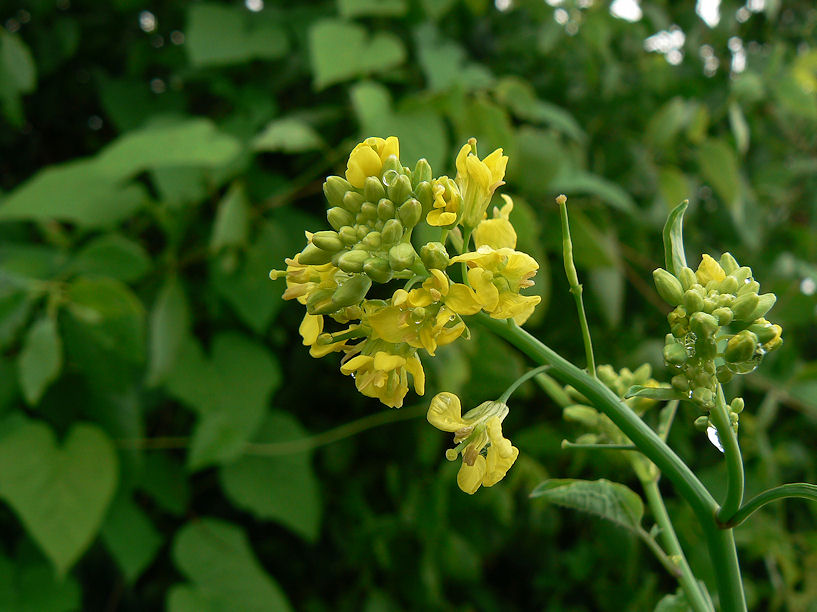
Abb.: कदम्बकः । Brassica juncea (L.) Czern. - Brauner Senf - Indian
Mustard, Vagbhil
[Bildquelle: dinesh_valke. --
http://www.flickr.com/photos/dinesh_valke/1259698272/. -- Zugriff am
2011-06-29. --
Creative
Commons Lizenz (Namensnennung, keine kommerzielle Nutzung, keine
Bearbeitung)]
"BRASSICA JUNCEA, H.f. and T. Fig.—Jacq. Vind. t. 171.
Indian mustard
Hab.—Cultivated universally.
[...]
History, Uses, &c.—One of the Sanskrit names for mustard is Āsuri or "the sorceress," because witches are detected by means of mustard oil. By lamplight several cups are filled with water and the oil dropped in, each cup bears the name of one of the suspected women, in the village, and if during the ceremony they observe that the oil takes the form of a woman in any of the cups, they conclude that the person whose name is on that cup is a witch. Mustard is also symbolic of fecundity; in the story of Gul-i-Bakawli, the nymph Bakawli is born again of a peasant woman who had eaten mustard oil extracted from seed grown upon the site of her disappearance. Mustard is mentioned by Greek writers as
ναπυ and σινηπι, and appears to have been used by them as a medicine. There is reason to suppose that the Romans used it as a condiment and medicine. Cf. Pliny 19, 54 and 20, 87, who mentions three varieties. Fée identifies the slender-stemmed mustard of that writer with the Sinapis alba of Linnaeus, the mustard mentioned as having the leaves of rape he considers to be the Sinapis nigra, and that with the leaf of the rocket, the Sinapis erucoides of Linnaeus. Sanskrit writers call mustard seeds Sarshapa and notice two kinds, sidhartha or white mustard (B. campestris), and rajika or brown mustard (probably B. juncea). The first kind is almost exclusively used for the production of the expressed oil, while the brown or black mustards are preferred on account of their greater pungency as rubefacients and for internal administration. The expressed oil of mustard is largely used as an article of diet, and when applied to the skin is considered to keep it soft, cool, and clean, and to promote the growth of hair. In Bengal it is much used by males for rubbing over the body before bathing, females always using cocoanut oil, either plain or perfumed, for the same purpose. Internally the Hindus use mustard combined with other stimulants in dyspepsia and as an emetic; externally they use it in much the same way as we do in Europe, but with the addition of other drugs, most of them of doubtful efficacy. In the Concan the whole seeds, moistened in warm water and sprinkled with lime, are given as a remedy for dyspepsia. In the Makhzan-el-Adwiya three kinds of mustard are noticed. Wild mustard, with small round reddish brown seeds, and two sorts of cultivated mustard, the white and the red. The seeds of the latter are directed to be used for medicinal purposes ; they are described as large and not round. The Mahometans consider mustard to be hot and dry, and to have detergent and digestive properties; they prescribe it internally in many diseases in which they think such remedies are indicated; externally they apply it in a variety of ways as a stimulant and counter-irritant. The list of diseases in which it is recommended, and the method of application or administration in each is too long to reproduce here. (Cf. Makhzan, article Khardal.) Modern research has shown that essential oil of mustard has antiseptic properties and is destructive of bacteria; it is intensely irritant, and if taken internally would act as a powerful irritant poison. The seeds share its properties, and when powdered and mixed with water act upon the skin and mucous membranes as a stimulant of the circulation, causing heat, redness and pain if the application is short, but vesication and much irritation if too prolonged. It is therefore a most valuable counter-irritant in neuralgic pains and internal congestions. Applied as a hip bath it acts as an indirect emmenagogue by stimulating the circulation. Given internally to the extent of a heaped dessert spoonful in a pint of warm water or gruel, mustard flour acts rapidly as an emetic through its irritant action on the mucous membrane of the stomach, and is therefore useful when narcotics have been taken in poisonous doses. In small doses mustard flour is carminative and sialagogue, and promotes digestion by increasing the flow of saliva and gastric juice. The seeds act in the same way, but owing to their mucilaginous coating the action is more prolonged and milder. During excretion mustard irritates the kidneys and causes diuresis.Description.—Four kinds of mustard are generally to be found in the Indian market, namely,
1st, Karachi mustard, B. nigra, var (?)—Globular, of a dark brown colour, surface rough, generally covered with a white pellicle, giving the seeds a grey colour; size about 1/16 of an inch in diameter.
2nd, B. nigra—Seeds globular, dark reddish brown, clean and bright; size about of an inch in diameter; surface rough, but less so than that of the 1st kind.
3rd, B, juncea—Seeds oblong, light reddish brown, clean and bright; length 1/12 of an inch; surface does not appear rough unless magnified.
4tht B. campestris—Seeds very slightly oblong, yellow, or reddish brown, clean and bright; diameter 1/12 of an inch or more; surface smooth to the naked eye, but seen to be finely reticulated under a magnifying glass.
The third kind is preferred by the natives, and may be considered the officinal mustard of India; it has a very bright rich yellow colour when powdered."
[Quelle: Pharmacographia indica : a history of the principal drugs of vegetable origin met with in British India / by William Dymock [1834-1892], C. J. H. Warden and David Hooper [1858-1947]. -- Bd. 1. -- London, 1890. -- S. 123ff.]
"INDIAN MUSTARDS (BRASSICA JUNCEA, B. CAMPESTRIS AND B. NAPUS).
The Bengal mustards have been studied closely by Major Prain, and according to him there are three distinct types of mustard, which may be distinguished thus :
Indian mustard or Rai, the Sinapis ramosa of Roxburgh and Brassica Juncea of Hooker and Thomson.
Indian Colza or Sarson, the swet-rai of Central Bengal, very tall, grown all over Bengal except Chittagong (plants resembling turnip or swede), the Sinapis glauca of Roxburgh, and Brassica campestris, sub-species genuina, variety glauca of Hooker and Thomson.
Indian Rape or Tori, the Sorshe of Central Bengal, the Sinapis dichotoma of Roxburgh, and Brassica campestris, sub-species napus, variety dichotoma of Hooker and Thomson.
356. Besides these staple varieties, there are some others also cultivated in some parts of Bengal, e.g.
Brassica trilocularis (Ulti Sarson), which is unlike ordinary sarson only in having pendent pods;
Brassica quadrivalvis which is a variety of Sarson which has four rows of seed instead of two ;
Brassica rugosa, Prain, or the Kalimpang rai ;
Brassica rugosa, var. Cuneifolia, Prain, grown by Cacharis and Rajbansis throughout Upper Bengal and Assam ;
Brassica Chinensis or China Cabbage may be also regarded as a mustard.
Indeed Turnip, Cabbage and Cauliflower are botanically closely allied to mustard, all of which are included under the genus Brassica of Linnaeus.
357. The black and white mustards (Brassica nigra and alba) of Europe are not grown in Bengal. It is from these that the mustard of European condiment and hospital poultice, are obtained. The oil of these mustards, though very useful medicinally as a very strong antiseptic, is not so suitable for food as the oil of Indian mustards, though the meal of European mustards is a better condiment.
358. First, Rai, Lahi, Li, or Raichi-rai is grown in all the Divisions of Bengal except Chhota-Nagpur, where it is practically unknown, except in Singhbhum. It is easily recognised by having none of its leaves stem-clasping, and after reaping, its seeds, which are brown, can be readily distinguished from those of Tori or Indian rape, by their small size, and their being distinctly reddish brown all over. From Sarson which has white seeds, or, as occasionally happens, brown seeds, it is easily distinguished. Sarson seeds are always considerably, often very much, larger, and even when brown, have the seed-coat smooth. There are three sub- races of Rai, a tall late kind and two shorter earlier kinds, one of these latter roughing with bristly hairs, the other smooth with darker coloured stems. The taller sub-race is quite absent from Chhota-Nagpur and from Tippera and Chittagong. The shorter sub-races are quite absent from Orissa and are absent from North Bengal, except Tippera. Rai or Rai-shorshe is called chhota-sarisha in Orissa, because the seeds are small.
359. Second, Tori, Latni (Chhota Nagpur) and Sarisha or shorshe (Indian rape) is next in importance to Rai, and it is grown in every district in Bengal except perhaps Saran and Shahabad. It is easily distinguished from Rai by its stem-clasping leaves and its small size. When reaped the seed is recognised as being larger, though of the same colour, and by having a paler spot at the base of the seed ; the seed-coat too is only slightly rough. From Sarson or Indian Colza it is easily distinguished by its smaller size and by its leaves, though stem-clasping, as in Sarson, being less lobed and having much less bloom. The seeds of Tori and ordinary Sarson are much of the same size, but as a rule the seed of Sarson in Bengal is white. When Sarson seeds are brown they are of an amber colour and they have no paler spot. The seed-coat is smooth. The seeds of Sarson are sometimes considerably larger than those of Tori. When this is the case the two are easily distinguished. There are two kinds of Tori, a taller, rather later, and a shorter, and very early kind which is the commoner variety. Both kinds however ripen well ahead of any Rai or any Sarson. The earlier kind of Tori probably does not occur in North-West Tirhut and the later kind is unknown in Eastern Bengal and Chittagong ; with these exceptions both sorts prevail throughout Bengal.
360. Third, Sarson or Indian Colza, the shweti shorshe or simply shweti of Bengal, and Ganga-toria of Orissa, occur in every district except Chittagong, where it is replaced by a different mustard. It is easily distinguished from Rai by its stem-clasping leaves, and from Tori by the greater amount of bloom on its foliage, by its taller stature, its more rigid habit and its thicker and plumper pods. When reaped the seeds are distinguished by their usually white colour; when brown the seeds are distinguished -readily from those of Rai by the larger size, and the smooth seed coat, and from those of Tori by their being of a lighter brown, and by not having a paler spot at the base of the seed. There are two races of sarson, one with erect pods, the Natwa Sarson or Sarson proper and one with pendent pods or Tero Sarson. Each race has two distinct sub-races, one with 2-valved and the other with 3 to 4-valved pods. The forms with hanging pods are not common except in northern Bengal and eastern Tirhut (Purnea), the sub-race with 2-valed pods being almost confined to this area. But the 4-valved kind extends sparingly throughout western Tirhut and crossing the Ganges spreads southwards through southwest Bihar and western Chhotanagpore. The forms with erect pods occur all over Bengal ; the 2-valved subrace, however, is not much grown in Bihar. The 4-valved subrace occupies west Tirhut and west Bihar and extends in a southwest direction to Midnapore. It is also grown in northern and north-eastern Bengal. Roughly speaking, the 2-valved erect Sarson is grown chiefly in Chhotanagpore, Orissa, and in west, central and east Bengal ; the 4-valved erect Sarson is grown chiefly in west Bihar and north Bengal ; and the pendent Sarson occurs in the area to the north of the Ganges beyond the region occupied by the 4-valved Sarson.
361. Fourth, the Chittagong mustard, which is closely allied to European colza.
362. Fifth, the Nepalese mustard, which is the same as the Cabbage-mustard of the Chinese cultivator.
363. Sixth, the China cabbage which is quite distinct from the last has been only lately introduced into Bengal jails.
364. Seventh, Eruca sativa or Taramani (Tiramira) is commonly confounded with mustard. It also belongs to the natural order, Cruciferae and tribe brassiceae. The seeds are compressed and light reddish brown in colour.
365. Tori or Sorshe and Sarson or Swet sorshe are usually sown with wheat or barley, or in gardens with carrots and Ramdana (Amaranth), while Rai is usually grown by itself. They are sown in September i.e., 6 weeks to 2 months before the regular rabi sowings. The sowing of rai is done earlier and it is harvested in February or March, while sarson and tori are sown and harvested later. There are however early and late varieties of all the three crops. When tori or sarson is sown with wheat or barley at the rate of 1½ lbs., per acre, the produce is only 1½ to 2 maunds per acre. Sown by itself, at the rate of 4 to 6 Ibs. per acre, the produce is 4 to 6 maunds. Rai is usually sown at 3 Ibs. per acre and peas are sown afterwards on the same land. Grown in this way the outturn per acre of rai is 3 to 4 maunds. Grown by itself, without peas, scarcely any higher yield is obtained. Rai seed yields less oil than sorshe and shweti-sorshe seeds. In the former case the yield is 10 seers per maund and in the latter 13 to 14 seers. All the three varieties of mustard are sometimes grown as a green manure and sometimes for green fodder only, the plants being cut and given to cattle in January and February, i.e. when they are just in flower. Sometimes a crop of mustard is ploughed in as manure, but this form of green manuring has no such special merit as the ploughing in of dhaincha, sunnhemp, indigo, or barbati."
[Quelle: Mukerji, Nitya Gopal: Handbook of Indian agriculture. -- Calcutta, 1901. -- S. 268 - 272.]
Brassicaceae - Kreuzblütengewächse
| 18a./b. siddhārthas tv eṣa dhavalo godhūmaḥ sumanaḥ samau सिद्धार्थस् त्य् एष धवलो गोधूमः सुमनः समौ ।१८ क। Die weiße Form (d.h. mit weißen Samen) davon heißt सिद्धार्थ - siddhārtha m.: "wirksam", Brassica rapa L. subsp. trilocularis (Roxb.) Hanelt 1986 - Indischer Rübsen - Indian Colza |
Colebrooke (1807): "The white sort. Sinapis glauca, Roxb."
Nach anderen: Brassica rapa subsp. rapa L. - Weiße Rübe - Turnip
Siehe den Kommentar zum Vorhergehenden.
Brassica rapa subsp. rapa L. - Weiße Rübe - Turnip
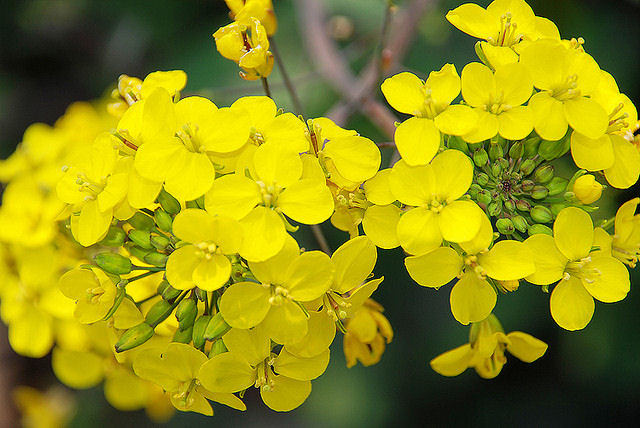
Abb.: Brassica rapa subsp. rapa L. - Weiße Rübe - Turnip
[Bildquelle: mikiya. --
http://www.flickr.com/photos/pink-neko/2535416189/. -- Zugriff am
2011-06-29. --
Creative Commons Lizenz (Namensnennung, keine kommerzielle Nutzung,
keine Bearbeitung)]
Poaceae - Süßgräser
| 18a./b. siddhārthas tv eṣa dhavalo godhūmaḥ sumanaḥ samau सिद्धार्थस् त्य् एष धवलो गोधूमः सुमनः समौ ।१८ क। [Bezeichnungen für Weizen:]
|
Colebrooke (1807): "Wheat."
गोधूम - godhūma m.: "Rinder-Dampf", Weizen
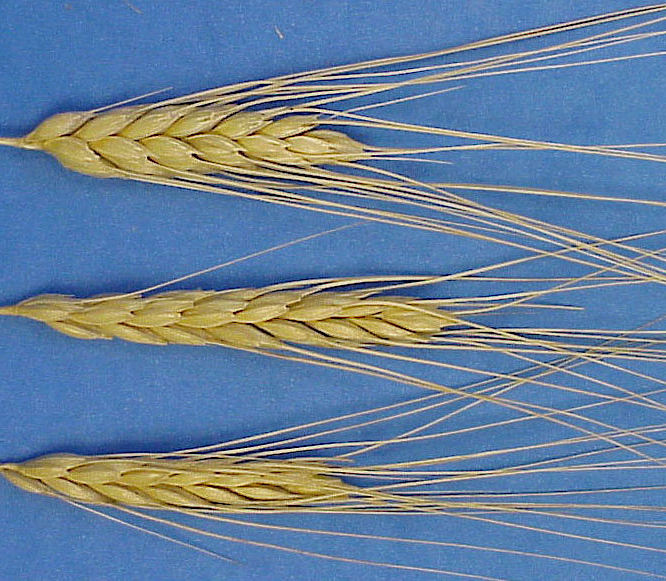
Abb.: गोधूमः । Triticum turgidum (Englischer Weizen) subsp.
dicoccum (Schrank ex Schubl.) Thell. or Triticum dicoccon (Emmer)
Cultivar name: KHAPLI, Madhya Pradesh, India, 1926 Maintained by the
National Small Grains Collection.
[Bildquelle: USDA Germplasm Resources Information Network (GRIN) /
Wikimedia. -- Public domain]
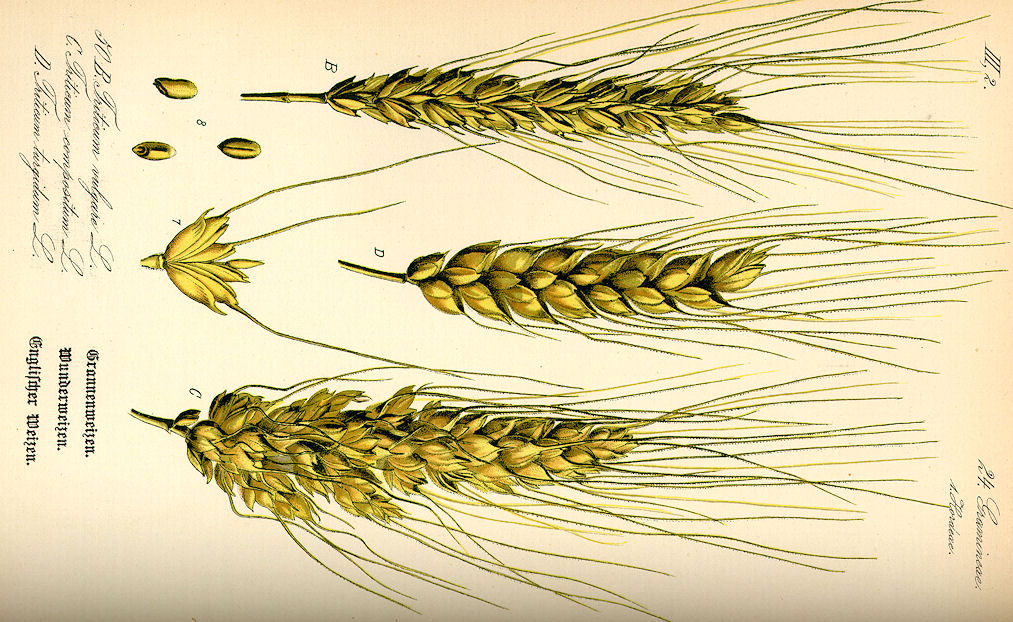
Abb.: गोधूमः । Triticum spp. - Weizen - Wheat
[Bildquelle: O. W. Thomé, 1885]
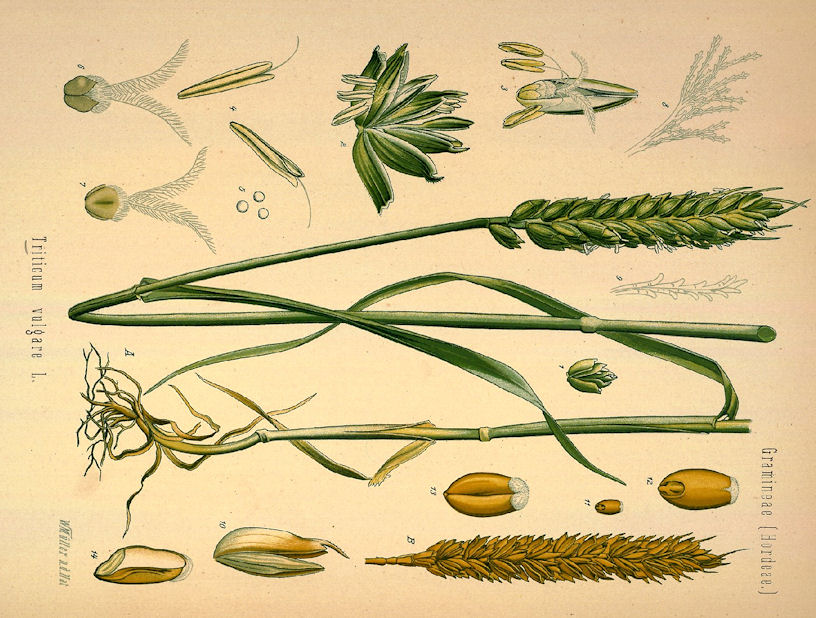
Abb.: गोधूमः । Triticum aestivum L. 1753 - Saat-Weizen -
Wheat
[Bildquelle: Köhler, 1893]
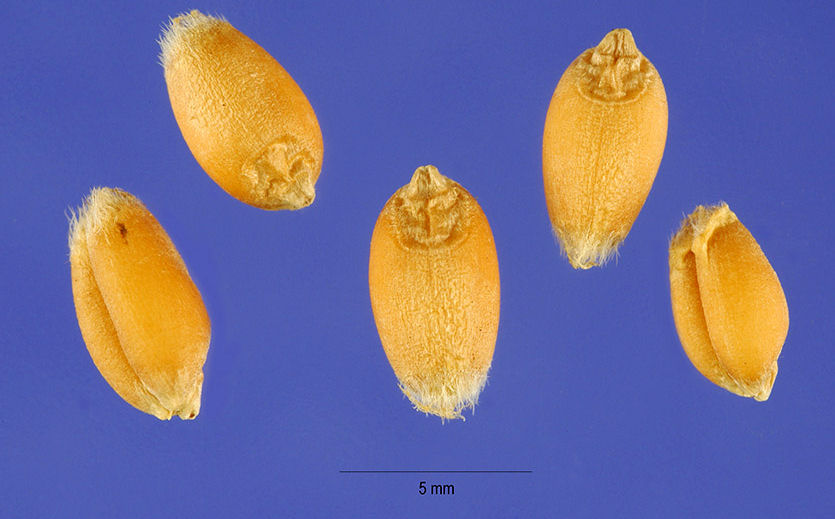
Abb.: गोधूमः । Samen von Triticum aestivum L. 1753 - Saat-Weizen -
Wheat
[Bildquelle: Steve Hurst @ USDA-NRCS PLANTS Database. -- Public domain]
सुमन - sumana m.: "wohlgesinnt", Weizen

Abb.: सुमनः । Pflugfreies Weizenfeld, Pokhar Binda, Maharajganj district,
Bihar
[Bildquelle: Petr Kosina / CIMMYT. --
http://www.flickr.com/photos/cimmyt/4777719795/. -- Zugriff am
2011-06-29. --
Creative
Commons Lizenz (Namensnennung, keine kommerzielle Nutzung, share alike)]
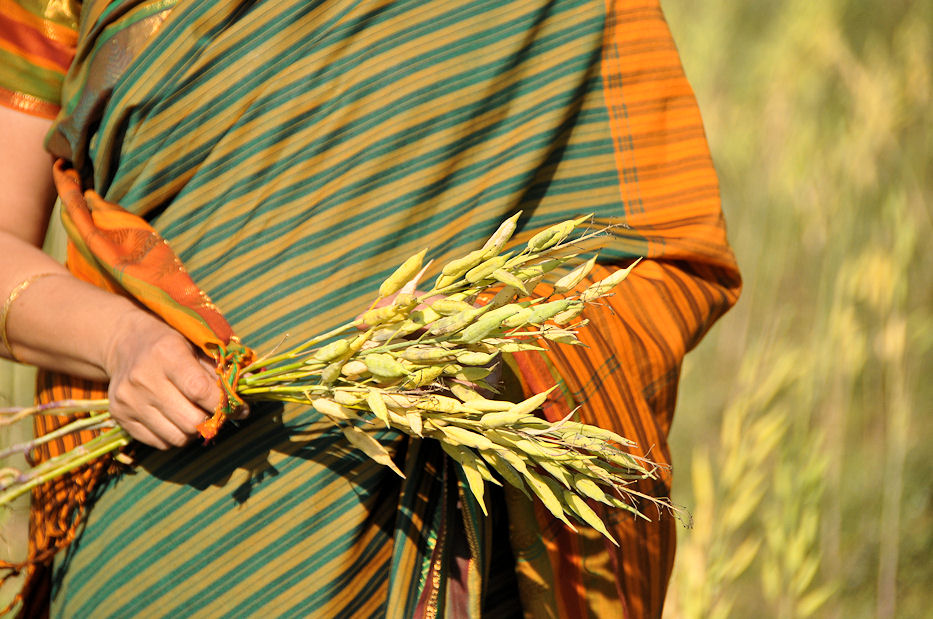
Abb.: सुमनः । Frau mit Weizenähren, Jamnapur, Bihar
[Bildquelle: Photo: P. Casier@CGIAR. --
http://www.flickr.com/photos/cgiarclimate/5477033611/. -- Zugriff am
2011-06-29. --
Creative
Commons Lizenz (Namensnennung, keine kommerzielle Nutzung, share alike)]
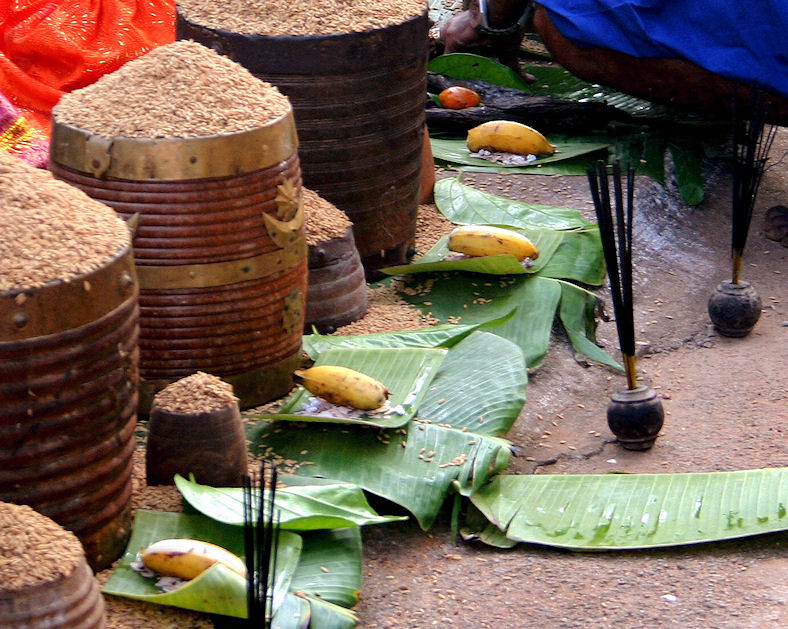
Abb.: सुमनः । Weizenopfer an Para, Kerala
[Bildquelle: Grande Illusion. --
http://www.flickr.com/photos/grandeillusion/80861386/. -- Zugriff am
2011-06-30. --
Creative Commons Lizenz (Namensnennung, keine kommerzielel Benutzung,
keine Bearbeitung)]
"TRITICUM SATIVUM, Lam. Fig.—Bentl. and Trim., t. 294.
Wheat {Eng.)
Hab. —The Euphrates region. Cultivated in N.-W. India, the Central Provinces, and Bombay.
[...]
History, Uses, &c.—Wheat, as the most important of the cereals, has given rise to numerous myths, for an account of which we cannot do better than refer the reader to the late Dr. W. Mannhardt's learned monograph Die Komendämonen (Berlin, 1868). In the myth of Persephone-kora, daughter of Zeus, the god of the heavens, which by their warmth and rain produce fertility, and of Dimeter or Ceres, the maternal goddess of the fertile earth, we perceive that she was conceived as a divine personification of this grain, in summer appearing beside her mother in the light of the upper world, but in the autumn disappearing, and in winter passing her time, like the seed under the earth, with the god of the lower world. As a pendant to the Greek myth, we have the Indian myth of Sita or "the Furrow," husbandry personified, and apparently once worshipped as a kind of goddess. In the Rig-Veda Sita is invoked as a deity presiding over Agriculture, and appears to be associated with Indra. In the Vajananeya, Sita "the Furrow" is personified and addressed, four furrows being required to be drawn at the ceremony when certain stanzas are recited. Sita is so named because she was fabled to have sprung from a furrow made by her father Janaka while ploughing the ground to prepare it for a sacrifice instituted by him to obtain progeny, whence her epithet Ayonija "not womb-born." (Of course, these myths are more or less applicable to all food-grains.) Wheat was used in sacrifice by the Greeks and Romans, and by the Hindus in Vedic times, as an emblem of fertility; it was poured upon the bride at the marriage ceremony, and in Northern India, wheat, millet and rice are still used on such occasions. Wheat, as the most important food-grain, is frequently mentioned by Hippocrates, who calls it
πυρος and mentions three kinds; Pliny also describes several kinds of Triticum. Sanskrit medical writers also mention three kinds of wheat, namely, Mahāgodhuma or large-grained, Madhuli or small-grained, and Nihsuki or beardless; they consider it to be the most nutritive of the food-grains, but not so easily digested as rice.Many varieties of wheat are cultivated in India, and through careless cultivation there is much mixture in the samples brought to market. A number of samples purchased by one of us in the Bombay market and sent to Australia for trial, were, on careful cultivation, found to be all mixed, some of them producing five or six distinct varieties. Indian wheats may be divided roughly into two classes, soft and hard, the former being mostly used for bread-making, and the latter for making a kind of vermicelli and certain other preparations used by the natives. Amongst the Hindus, owing to caste distinctions, the whole process of grinding the corn, separating the flour and making it into cakes, is usually performed by the women of the house, consequently the demand for ready-made flour is limited to the supply of the non-Hindu population, and some of the less particular Hindu castes. In the Indian process of making flour, the wheat, after cleaning, is placed upon a table and thoroughly wetted and the water allowed to drain from it during the night. The next morning, the still moist grain is ground in hand-mills by women. It is then sifted, and as much fine flour and rawa or suji (the heart of the grain) as can be obtained are laid aside. The remainder termed "naka" is again ground in a more powerful mill and an inferior kind of rawa obtained from it. The residue after a third grinding yields a coarse flour and bran. The bazar-made bread is of two kinds, that used by the Mahometans and known as Nān, which is in thin cakes, and loaf-bread introduced by the Portuguese. The former is similar to the bread used in all Mahometan countries, the latter is made with 60 parts fine rawa, 20 second sort or naka rawa, and 20 of first sort flour. A second or inferior kind of bread is also sold. The barm or yeast in use is, where obtainable, the fermenting juice of the palm, elsewhere an artificial barm is prepared.
In some of the large towns a loaf-bread is now made by- Brahmins for the use of the Hindu population, but its use is very limited. In Calcutta, Madras, and Bombay, flour and bread made as in Europe is obtainable, and is gradually taking the place of the Portuguese article. Fine flour is also imported from Europe and America, as the excessive proportion of gluten in Indian flour renders it unsuitable for use in making pastry.
Wheaten flour is often used as a dusting-powder to allay the heat and pain of local inflammations, such as burns, scalds, &c., but it is inferior for such purposes to powdered starch. In America an uncooked paste made of the flour has been used with success in diarrhoea. In India flour is much used by the natives for making poultices."
[Quelle: Pharmacographia indica : a history of the principal drugs of vegetable origin met with in British India / by William Dymock [1834-1892], C. J. H. Warden and David Hooper [1858-1947]. -- Bd. 3. -- London, 1893. -- S. 607ff.]
| 18c./d. syād yāvakas tu kulmāṣaś caṇako harimanthakaḥ स्याद् यावकस् तु कुल्माषश् चणको हरिमन्थकः ।१८ ख। [Bezeichnungen für die saure Absonderung von Feldfrüchten und anderen Früchten:]
|
Colebrooke (1807): "Half ripe barley. Interpretations differ : some make this awnless barley ; others forced rice (Bor) ; others again, different species of Phaseolus (Rājamāṣa), or of Dolichs (Kulattha)."
Siehe das zur Absonderung von Cicer arietinum im Folgenden Gesagte!
Fabaceae - Hülsenfrüchtler
| 18c./d. syād yāvakas tu kulmāṣaś caṇako harimanthakaḥ स्याद् यावकस् तु कुल्माषश् चणको हरिमन्थकः ।१८ ख। [Bezeichnungen für Cicer arietinum L. 1753 - Kichererbse - Chick Pea:]
|
Colebrooke (1807): "Chich pea. Cicer arietinum. Some erroneously make these synonymous with the preceding ; others, with Cīnaka, Pnaicum pilosum, Roxb."
चणक - caṇaka m.: Cicer arietinum L. 1753 - Kichererbse - Chick Pea
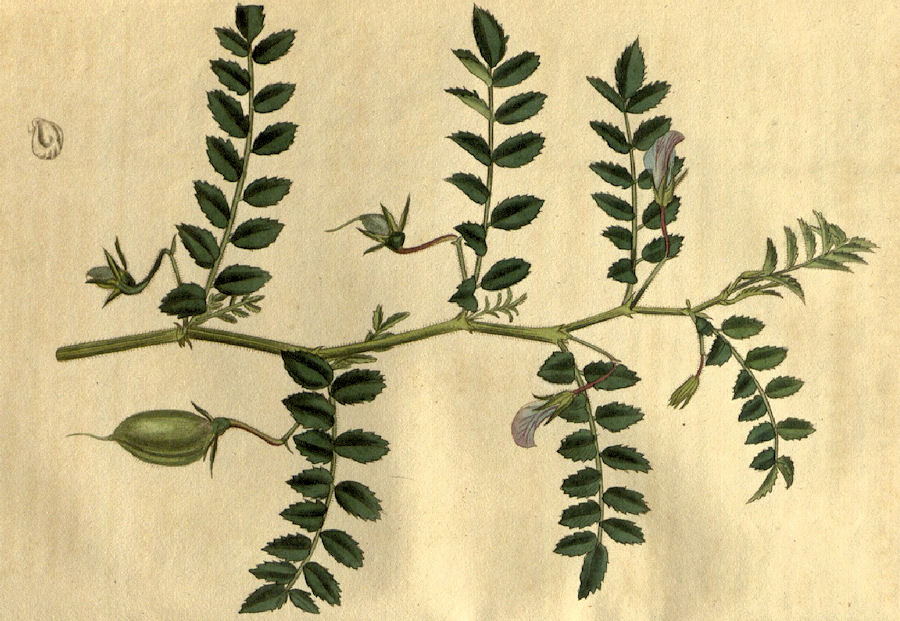
Abb.: चणकः । Cicer arietinum L. 1753 - Kichererbse - Chick Pea
[Bildquelle: Curtis's Botanical Magazine, v. 49 (1821/22), Tab. 2274]
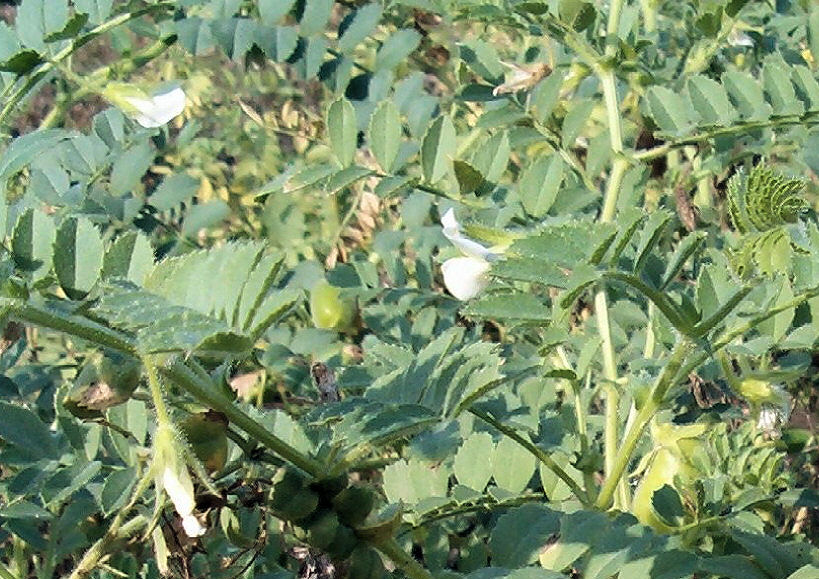
Abb.: चणकः । Cicer arietinum L. 1753 - Kichererbse - Chick Pea,
Deutschland
[Bildquelle: BotBln / Wikipedia. -- GNU FDLicense]
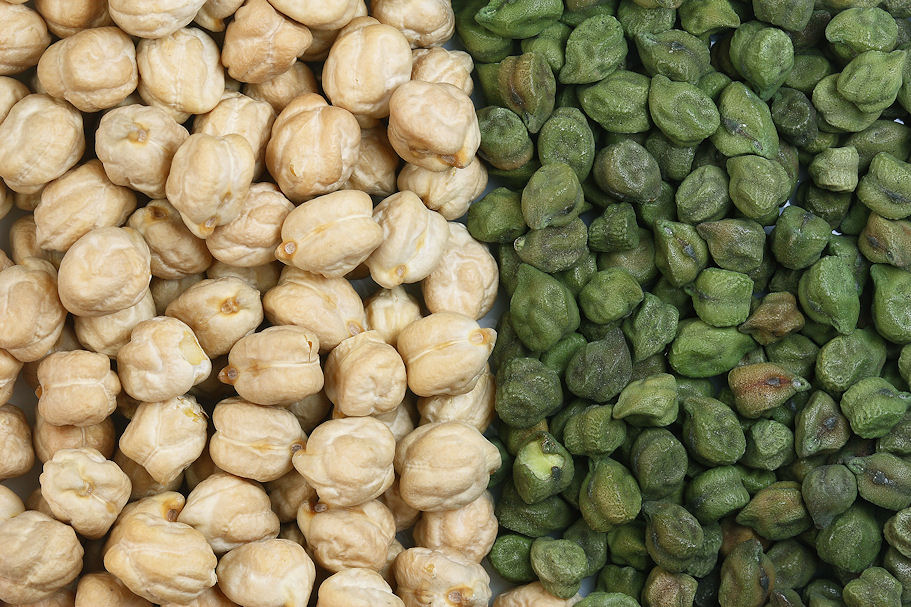
Abb.: चणकाः । Cicer arietinum L. 1753 - Kichererbse - Chick Pea
[Bildquelle: Sanjay Acharya / Wikipedia. -- GNU FDLicense]
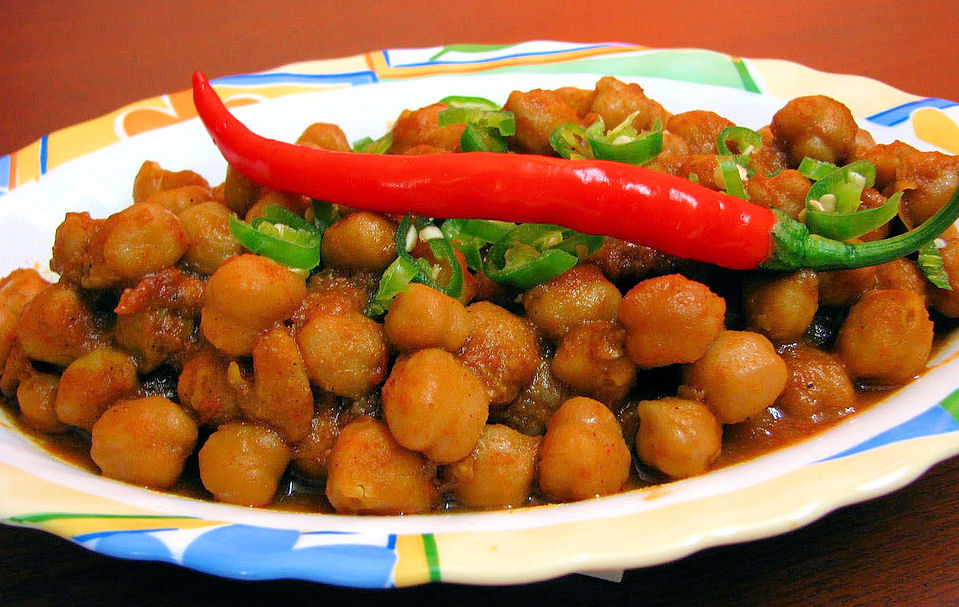
Abb.: चणकः । चना मसाला - Chana Masala (aus Kichererbsen)
[Bildquelle: Kirti Poddar --
http://www.flickr.com/photos/feastguru_kirti/2182797448/. -- Zugriff am
2011-06-30. --
Creative
Commons Lizenz (Namensnennung, share alike)]
हरिमन्थक - harimanthaka m.: "gelbe Quirlung, Haris Quirlung", Cicer arietinum L. 1753 - Kichererbse - Chick Pea
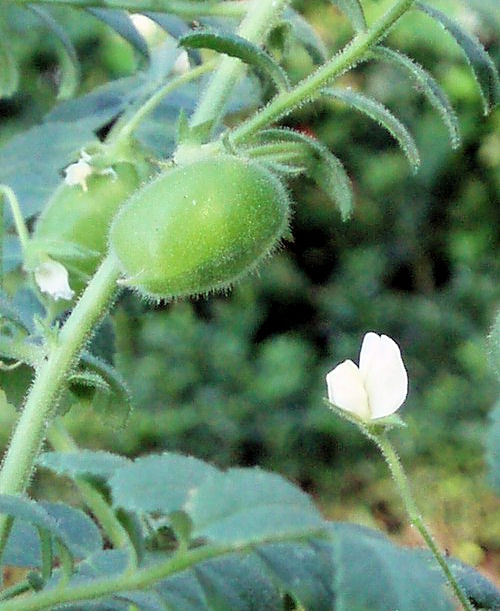
Abb.: हरिमन्थकः । Cicer arietinum L. 1753 - Kichererbse - Chick Pea,
Frankreich
[Bildquelle: Isidro Martínez. --
http://www.flickr.com/photos/10770266@N04/4018057525/. -- Zugriff am
2011-06-30. --
Creative
Commons Lizenz (Namensnennung, keine kommerzielle Nutzung, share alike)]
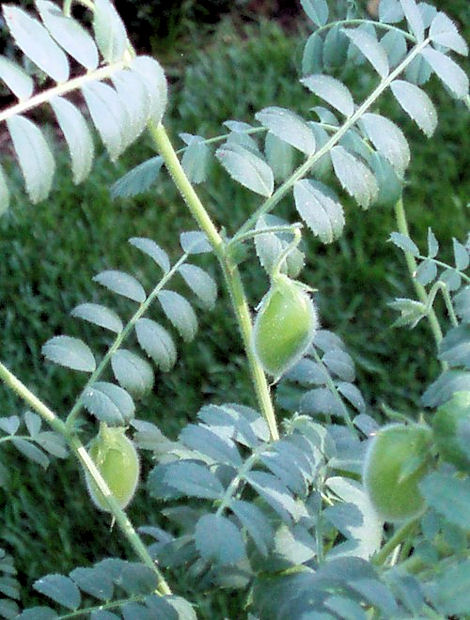
Abb.: हरिमन्थकः । Cicer arietinum L. 1753 - Kichererbse - Chick Pea,
Frankreich
[Bildquelle: Isidro Martínez. --
http://www.flickr.com/photos/10770266@N04/4018816980/. -- Zugriff am
2011-06-30. --
Creative
Commons Lizenz (Namensnennung, keine kommerzielle Nutzung, share alike)]
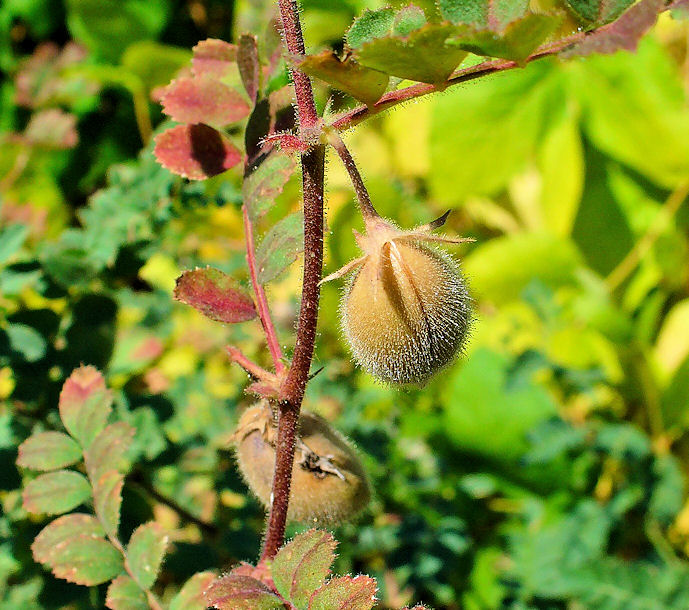
Abb.: हरिमन्थकः । Cicer arietinum L. 1753 - Kichererbse - Chick Pea,
reife Frucht, Deutschland
[Bildquelle: H. Zell / Wikipedia. -- GNU FDLicense]
"CICER ARIETINUM, Linn. Fig .— Wight Ic. t. 20; Bot. Mag., t. 2274.
Common Chickpea
Hab.—Unknown. Cultivated in warm 'climates. The seeds and acid exudation.
[...]
History, Uses, &c.—This pulse is the Cicer of the Romans. Plautus and Horace speak of 'Cicer frictum,' 'parched gram,' which would appear to have been eaten by the poorer classes just as it is in India now. The Italians call it 'Cece.' The plant is cultivated in the south of Europe and also in India, the leaves and stems are covered with glandular hairs containing oxalic acid, which exudes from them in hot weather and hangs in drops, ultimately forming crystals. In India the seeds form one of the favourite pulses of the natives, being eaten raw or cooked in a variety of ways; the flour is also much used as a cosmetic and in cookery. Cicer is the
ερεβινθος of Dioscorides. The acid liquid, which is obtained by collecting the dew from the Chanaka plant, is mentioned in Sanskrit works under the name of Chanakāmla, and is described as a kind of vinegar having acid and astringent properties, which is useful in dyspepsia, indigestion, and costiveness. Moidīfn Sheriff gives the following description of its collection:—"In a great many parts of India, where C. arietinum is cultivated, a piece of thin and clean cloth is tied to the end of a stick, and the plants are brushed with it early in the morning, so as to absorb the dew, which is then wrung out into a vessel."Dr. Hové (1787) says:—"On the road (to Dholka) we met with numerous woman who gathered the dew of the grain, called by the inhabitants chana, by spreading white calico cloths over the plant, which was about 2 feet high, and then drained it out into small hand jars. They told me that in a short period it becomes an acid, which they use instead of vinegar, and that it makes a pleasant beverage in the hot season when mixed with water." Dr. Hové states that the freshly collected fluid tasted like soft water, but that some which he preserved became after some days strongly acid.
According to Dr. Walker (Bomb. Med. Phys. Trans., 1840, p. 67), the fresh plant put into hot water is used by the Portuguese in the Deccan in the treatment of dysmenorrhea; the patient sits over the steam. He remarks this is only another way of steaming with vinegar. Notices of the acid liquid, its uses by the natives, and mode of collection, are given by Dr. Christie (Madras Lit. Sci. Journ., Vol. IV., p. 476); Dr. Heyne (Tracts, p. 28); Ainslie (Mat. Ind., Vol. II., p. 56)."
[Quelle: Pharmacographia indica : a history of the principal drugs of vegetable origin met with in British India / by William Dymock [1834-1892], C. J. H. Warden and David Hooper [1858-1947]. -- Bd. 1. -- London, 1890. -- S. 486ff.]
Pedaliaceae - Sesamgewächse
| 19a./b. dvau tile tilapejaś ca tilapiñjaś ca niṣphale द्वौ तिले तिलपेजश् च तिलपिञ्जश् च निष्फले ।१९ क। Bezeichnungen für Sesam (तिल - tila m.: Sesamum indicum L. 1753) ohne Frucht1:
|
Colebrooke (1807): "Barren sesamum. Bearing no blossom : or its seed containing no oil."
1 vermutlich = Wildsesam, der kein Öl gibt.
तिल - tila m.: Sesamum indicum L. 1753 - Sesam - Sesame
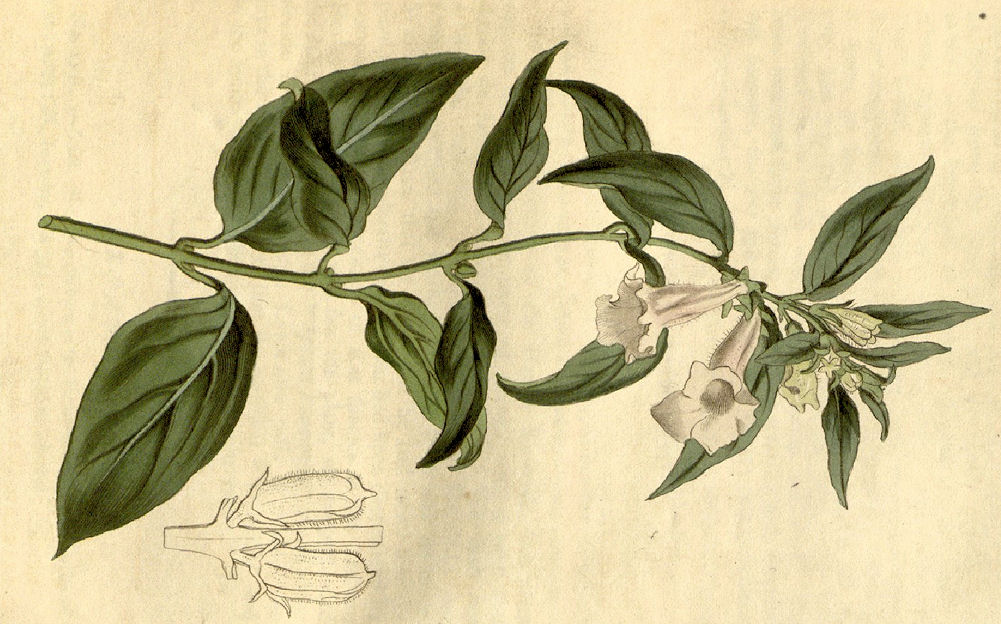
Abb.: तिलः । Sesamum indicum L. 1753 - Sesam - Sesame
[Bildquelle: Curtis's Botanical Magazine, v. 41 (1814/15), Tab. 1688]
तिलपेज - tilapeja m.: unfruchtbarer Sesam
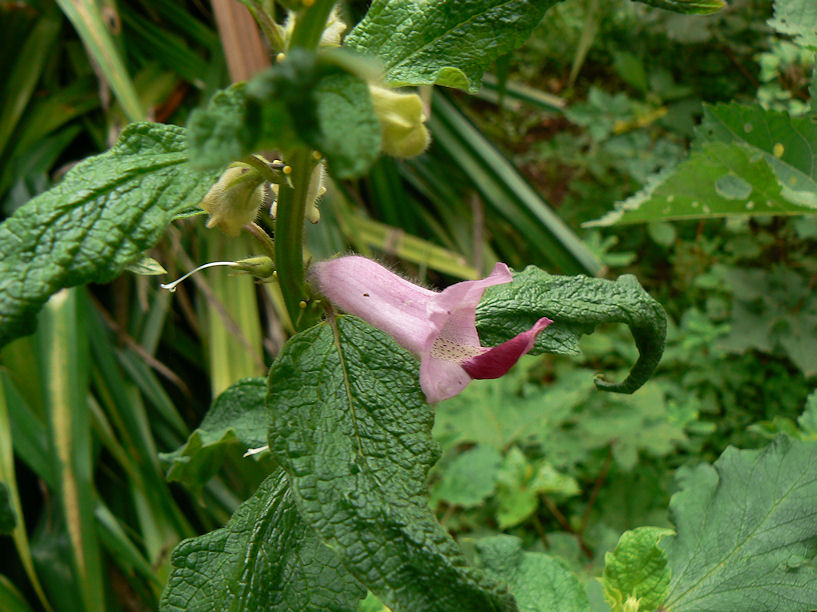
Abb.: तिलपेजः । Wilder Sesam, Indien
[Bildquelle: dinesh_valke. --
http://www.flickr.com/photos/dinesh_valke/1224182655/. -- Zugriff am
2011-06-30. --
Creative
Commons Lizenz (Namensnennung, keine kommerzielle Nutzung, keine
Bearbeitung)]
तिलपिञ्ज - tilapiñja m.: unfruchtbarer Sesam
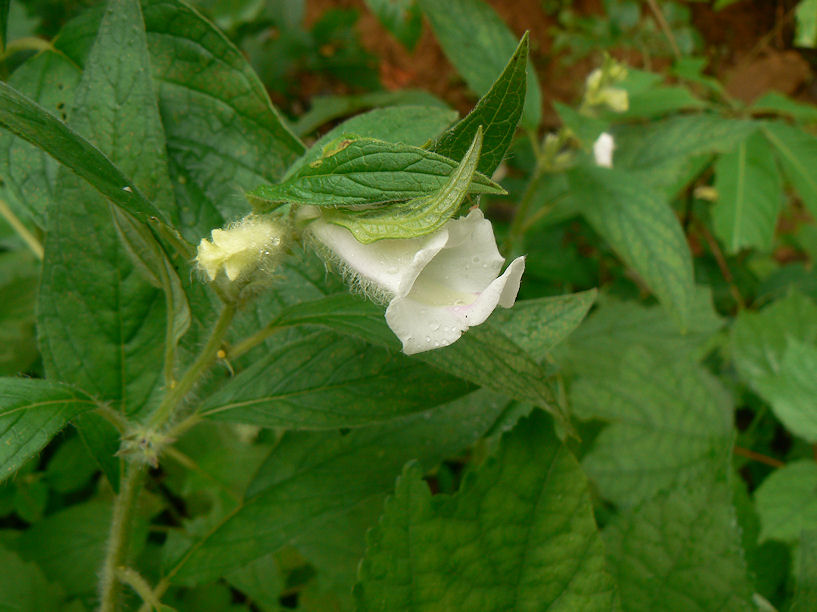
Abb.: तिलपिञ्जः । Wilder Sesam, Tungareshwar Wildlife Sanctuary, Maharashtra
[Bildquelle: dinesh_valke. --
http://www.flickr.com/photos/dinesh_valke/1080592023/. -- Zugriff am
2011-06-30. --
Creative
Commons Lizenz (Namensnennung, keine kommerzielle Nutzung, keine
Bearbeitung)]
"SESAMUM INDICUM, DC. Fig .— Wight III., t. 163; Bot. Mag., t. 1688; Bentl and Trim., t. 198.
Sesame (Eng.)
Hab.—Throughout the warmer parts of India, cultivated. The leaves, seeds r and oil.
[...]
History, Uses, &c.—In Hindu mythology Sesamum seed is symbolic of immortality. According to the "Brahma purana," Tila was created by Yama, the " king of death," after prolonged penance. The Grihyasutra of Āśvalāyana directs that in funeral ceremonies in honour of the dead, Sesamum seeds be placed in the three sacrificial vessels containing Kusa grass and holy water, with the following prayer : "O Tila, sacred to Soma, created by the gods during the Gosava (the cow-sacrifice, not now permitted), used by the ancients in sacrifice, gladden the dead, these worlds and us!" Sesamum seeds with rice and honey are used in preparing the funereal cakes called Pindas, which are offered to the Manes in the Sraddh ceremony by the Sapindas "or relations" of the deceased.
On certain festivals six acts are performed with Sesamum seeds, as an expiatory ceremony of great efficacy, by which the Hindus hope to obtain delivery from sin, poverty, and other evils, and secure a place in Indra's heaven. These acts are, tilodvarti, "bathing in water containing the seeds" ; tilasnayi, "anointing the body with the pounded seeds" ; tilahomi, "making a burnt offering of the seeds" ; tilaprada, "offering the seeds to the dead"; tilabhuj, "eating the seeds"; and tilavapi, "throwing out the seeds." Water and Sesamum seeds are offered to the Manes of the deceased. In the first act of Sakuntala this practice (called Til-anjli) is alluded to by the anchorite's daughter in love with King Dushyanta, when she tells her companions that if they do not give their assistance, they will soon have to offer her water and Sesamum seeds. (De Gubernatis.) In proverbial language a grain of Sesamum signifies the least quantity of anything—Til chor so bajjar chor, "who steals a grain will steal a sack" ; Til til ka hisab, "to exact the uttermost farthing."
A worthless person is compared to wild Sesamum (Jartila, Sans.) which yields no oil—In tilon men tel nahin, "there is no good in him." Dutt remarks:—"The word Taila, the Sanskrit for oil, is derived fromTila; it would therefore seem that Sesamum oil was one of the first, if not the first oil manufactured from oil-seeds by the ancient Hindus. The Bhavaprakasa describes three varieties of Til seeds, namely, black, white, and red. Of these the black is regarded as the best suited for medicinal use; it yields also the largest quantity of oil. White Til is of intermediate quality. Til of red or other colours is said to be inferior and unfit for medicinal use. Sesamum seeds are used as an article of diet, being made into confectionery with sugar or ground into meal. Sesamum oil forms the basis of most of the fragrant or scented oils used by the natives for inunction before bathing, and of the medicated oils prepared with various vegetable drugs. It is preferred for these purposes from the circumstance of its being little liable to turn rancid or thick, and from its possessing no strong taste or odour of its own. Sesamum seeds are considered emollient, nourishing, tonic, diuretic, and lactagogue. They are said to be especially serviceable in piles, by regulating the bowels and removing constipation. A poultice made of the seeds is applied to ulcers. Both the seeds and the oil are used as demulcents in dysentery and urinary diseases in combination with other medicines of their class." (Mat. Med. of the Hindus, p. 216.)
Mahometan writers describe the seed under the Arabic name of Simsim. In Africa it is called Juljulān, and in Persia Kunjad. The Mahometan bakers always sprinkle the seeds upon their bread, the sweetmeat-makers mix them with their sweets. The following Delhi street-cry indicates the properties attributed to them by the latter class of people: —
"Til, tikhur, tisi, dana,
Ghi, shakkar men sana,
Khae buddha, hoe javana.""Sesamum, tikhur, and linseed,
Butter and sugar, poppy seed,
Old men it makes quite young with speed." (Fallon.)The oil, which is called in Arabic Duhn-el-hal, is used for the same purpose as olive oil is in Europe. Sesamum is considered fattening, emollient, and laxative. In decoction it is said to be emmenagogue; the same preparation sweetened with sugar is prescribed in cough; a compound decoction with linseed is used as an aphrodisiac; a plaster made of the ground seeds is applied to burns, scalds, &c.; a lotion made from the leaves is used as a hair-wash, and is supposed to promote the growth of the hair and make it black; a decoction of the root is said to have the same properties; a powder made from the roasted and decorticated seed is called Rāhishi in Arabic and Arwah-i-Kunjad in Persian; it is used as an emollient, both externally and internally.
Sesamum (
σησαμον) is frequently mentioned by Greek and Latin authors. Lucian (Pisc. 41) speaks of a σησαμαιος πλχους: this was probably similar to the til ka laddu of India.Sesame oil was an export from Sind to Europe, by way of the Red Sea, in the days of Pliny. In the Middle Ages the plant was known as Suseman or Sempsen, a corruption of the Arabic Simsin or Samsim. It is now called by Europeans, both in India and Europe, Jinjili, Jugeoline, Gigeri, Gengeli, or Gingelly, which appear to be corruptions of the word Juljulān. The oil is one of the most valuable of Indian vegetable oils; it keeps for a long time without becoming rancid, and is produced in large quantities in almost every part of the Peninsula. The following mode of preparation is described in the Jury reports of the Madras Exhibition:—"The method sometimes adopted is that of throwing the fresh seeds, without any cleansing process, into the common mill, and expressing in the usual way. The oil thus becomes mixed with a large portion of the colouring matter of the epidermis of the seed, and is neither so pleasant to the eye nor so agreeable to the taste as that obtained by first repeatedly washing the seeds in cold water, or by boiling them for a short time, until the whole of the reddish-brown colouring matter is removed and the seeds have become perfectly white. They are then dried in the. sun, and the oil expressed as usual. The process yields from 40 to 44 per cent, of a very pale straw-coloured sweet-smelling oil, an excellent substitute for olive oil."
Hydraulic presses are now in use in the more civilized parts of India for extracting the oil, but have as yet by no means superseded the native oil mill.
Sesamum oil may be used for plaster-making, but it takes more oxide of lead than groundnut oil, and does not make so light-coloured or so hard a plaster. After a prolonged trial at the Government Medical Store Department in Bombay, its use was abandoned in favour of the latter oil for the following reasons:—The rolls of Sesame oil plaster soften in hot weather. The plaster has a disagreeable odour. It darkens in colour when kept for any time. For liniments and ointments, except Ung. Hydr. Nitratis, it appears to be a perfectly satisfactory substitute for olive oil. F. H. Alcock (Pharm. Joum. [3], xv., 282) recommends its use in making Lin. Ammoniae B. P. Sesame or Benne leaves, preferably in the fresh state, are much used in America as a demulcent in disorders of the bowels; they yield an abundant mucilage."
[Quelle: Pharmacographia indica : a history of the principal drugs of vegetable origin met with in British India / by William Dymock [1834-1892], C. J. H. Warden and David Hooper [1858-1947]. -- Bd. 3. -- London, 1893. -- S. 26 - 30.]
Brassicaceae - Kreuzblütengewächse
| 19c./d. kṣavaḥ kṣutābhijanano rājikā kṛṣṇikāsurī क्षवः क्षुताभिजननो राजिका कृष्णिकासुरी ।१९ ख। |
Colebrooke (1807): "Black mustard. Sinapis Ramosa, Roxb."
Siehe oben zu Vers 17c./d.!
Poaceae - Süßgräser
| 20a./b. striyau kaṅgu-priyaṅgū dve atasī syād umā kṣumā स्त्रियौ कङ्गु-प्रियङ्गू द्वे अतसी स्याद् उमा क्षुमा ।२० क। [Bezeichnungen für Setaria italica P. Beauv. 1812 - Kolbenhirse - Italian Millet:]
|
Colebrooke (1807): "Panick seed. Panicum Italicum."
कङ्गु - kaṅgu f.: Setaria italica P. Beauv. 1812 - Kolbenhirse - Italian Millet
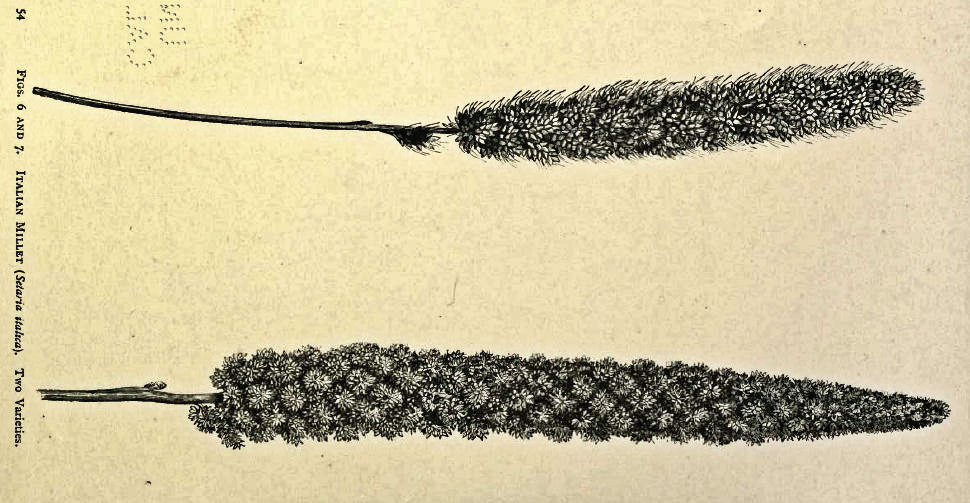
Abb.: कङ्गुः । Setaria italica (L.) P. Beauv. 1812 -
Kolbenhirse - Italian Millet
[Bildquelle: Church, A. H. (Arthur Herbert) <1834-1915>: Food-grains of
India. -- London, 1886.]
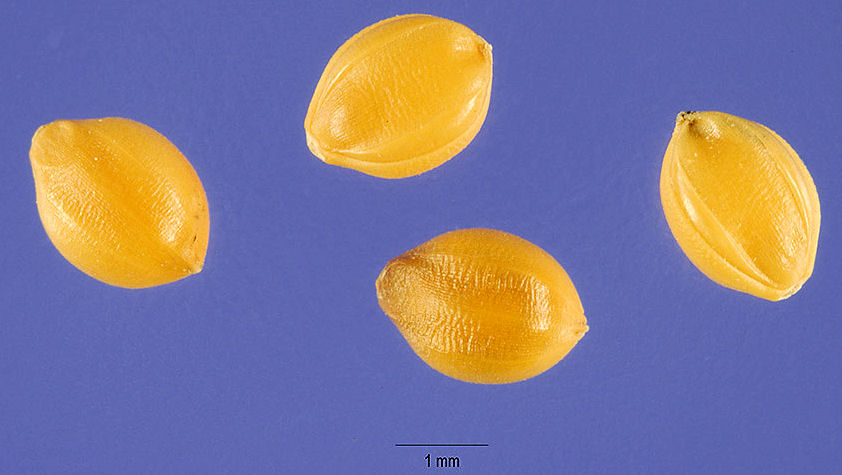
Abb.: कङ्गुः । Samen von Setaria italica (L.) P. Beauv. 1812 -
Kolbenhirse - Italian Millet
[Bildquelle: Steve Hurst @ USDA-NRCS PLANTS Database. -- Public domain]
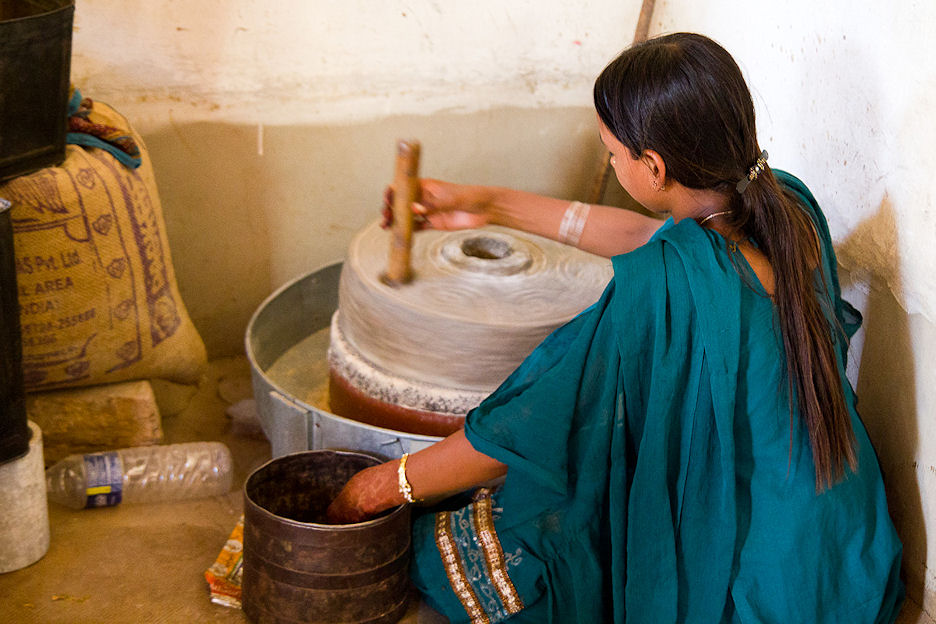
Abb.: Mahlen von Hirse, Bhadrajun, Rajasthan
[Bildquelle: rachel dale. --
http://www.flickr.com/photos/rdale/5644012071/. -- Zugriff am
2011-06-30. --
Creative
Commons Lizenz (Namensnennung, share alike)]
प्रियङ्गु - priyaṅgu f.: Setaria italica P. Beauv. 1812 - Kolbenhirse - Italian Millet
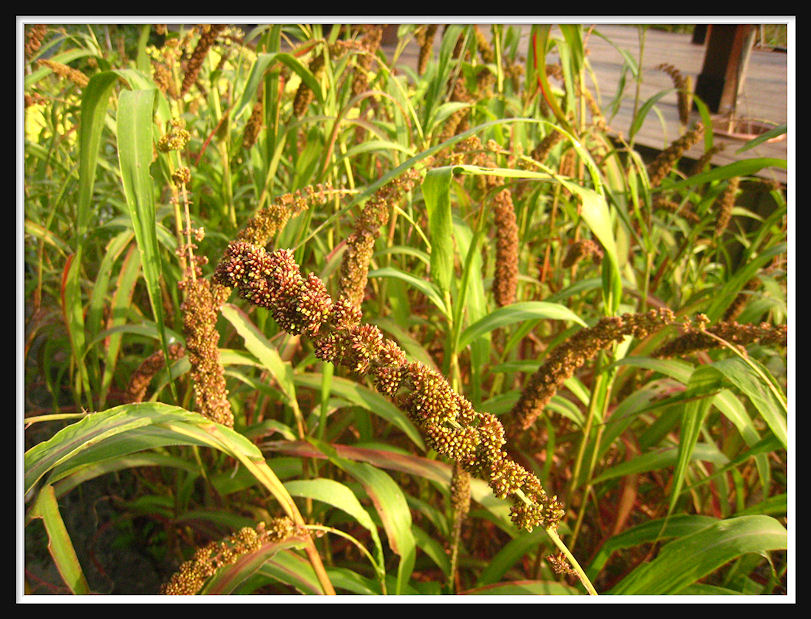
Abb.: प्रियङ्गुः । Setaria italica P. Beauv. 1812 - Kolbenhirse -
Italian Millet, Taiwan - 臺灣
[Bildquelle: 素珍 徐.
--
http://www.flickr.com/photos/jennyhsu47/4433932547/. -- Zugriff am
2011-06-30. --
Creative Commons Lizenz (Namensnennung, keine kommerzielle Nutzung,
keine Bearbeitung)]
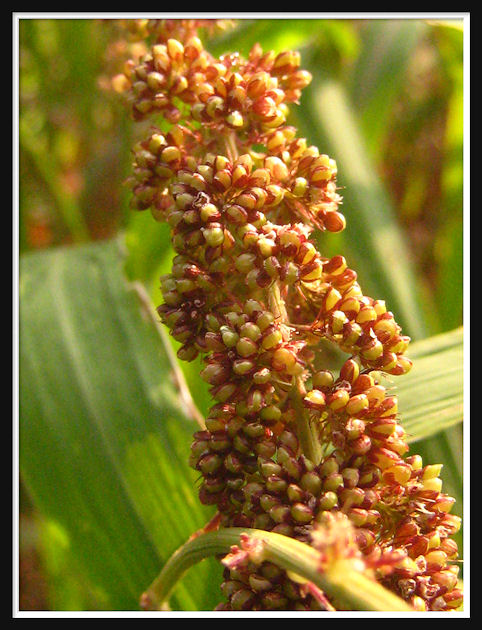
Abb.: प्रियङ्गुः । Setaria italica P. Beauv. 1812 - Kolbenhirse -
Italian Millet, Taiwan - 臺灣
[Bildquelle: 素珍 徐.
--
http://www.flickr.com/photos/jennyhsu47/4433906297/. -- Zugriff am
2011-06-30. --
Creative Commons Lizenz (Namensnennung, keine kommerzielle Nutzung,
keine Bearbeitung)]
"Panicum Italicum (Linn.) N. O. Graminacae. Italian Millet
[...]
Description.—Culms erect, 3-5 feet, round, smooth; roots issuing from the lower joints; margins of leaves hispid; mouths of the sheaths bearded; spikes nodding; spikelets scattered; pedicels 2-4 flowered, with smooth intermediate bristles; seeds ovate.—BRoxb. Fl. Ind. i. 302.—Setaria Italica, Beauv. Cultivated.
Economic Uses.—This is considered by the natives one of the most delicious of cultivated grains. The Brahmins—indeed all classes of natives—particularly esteem it, and use the seeds for cakes, porridge, &c. It is good for pastry—scarcely inferior, says Ainslie, to wheat; and when boiled with milk, makes a pleasant light diet for invalids. It is cultivated in many parts of India, requiring a dry light soil. The seed-time for the first crop is in June and July; for the second, between September and February. There are several kinds of millet cultivated in the Peninsula, among which the most celebrated are P. miliaceum (Willd.) and P. frumentaceum (Roxb.), of which there are several varieties.—Roxb. Ainslie."
[Quelle: Drury, Heber <1819 - 1872>: The useful plants of India : with notices of their chief value in commerce, medicine, and the arts. -- 2d ed. with additions and corrections. London : Allen, 1873. -- xvi, 512 p. ; 22 cm. -- s.v.]
Linaceae - Leingewächse
| 20a./b. striyau kaṅgu-priyaṅgū dve atasī syād umā kṣumā स्त्रियौ कङ्गु-प्रियङ्गू द्वे अतसी स्याद् उमा क्षुमा ।२० क। [Bezeichnungen für Linum usitatissimum L. 1753 - Saat-Lein - Flax, Linseed:]
|
Colebrooke (1807): "Lin ; and linseed. Linum usitatissimum. Some confound it with Sanā (Crotalaria Juncea)."
अतसी - atasī f.: Linum usitatissimum L. 1753 - Saat-Lein - Flax, Linseed
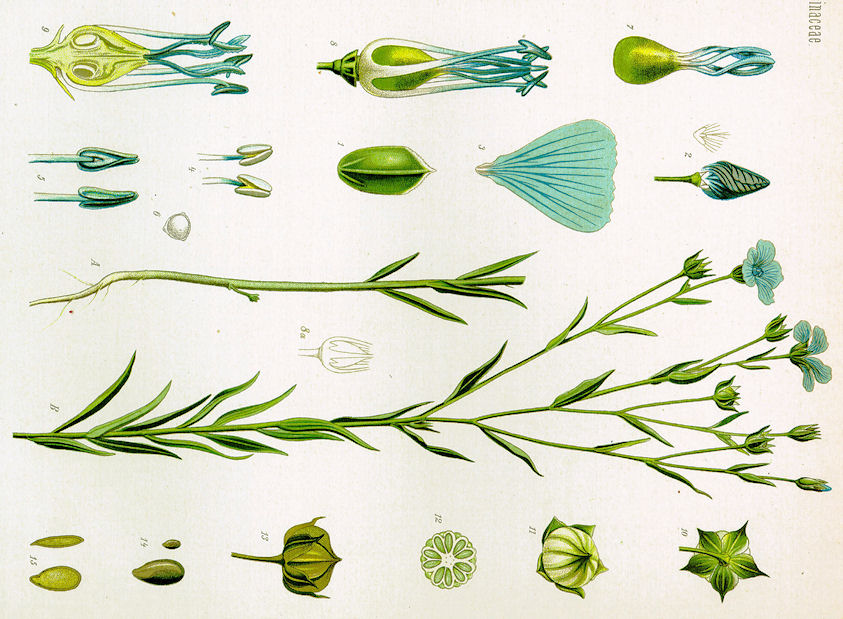
Abb.: अतसी - atasī f.: Linum usitatissimum L.
1753 - Saat-Lein - Flax, Linseed
[Bildquelle: Köhler, 1883-1914]
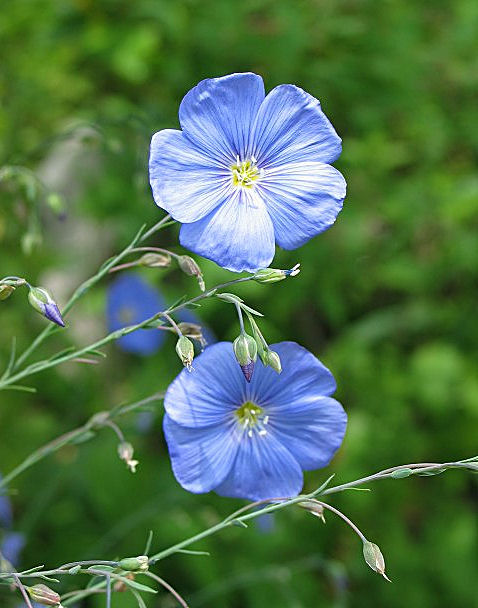
Abb.: अतसी - atasī f.: Linum usitatissimum L.
1753 - Saat-Lein - Flax, Linseed, Deutschland
[Bildquelle: 4d44 / Wikimedia. -- GNU FDLicense]
उमा - umā f.: Umā (= Pārvatī), Linum usitatissimum L. 1753 - Saat-Lein - Flax, Linseed
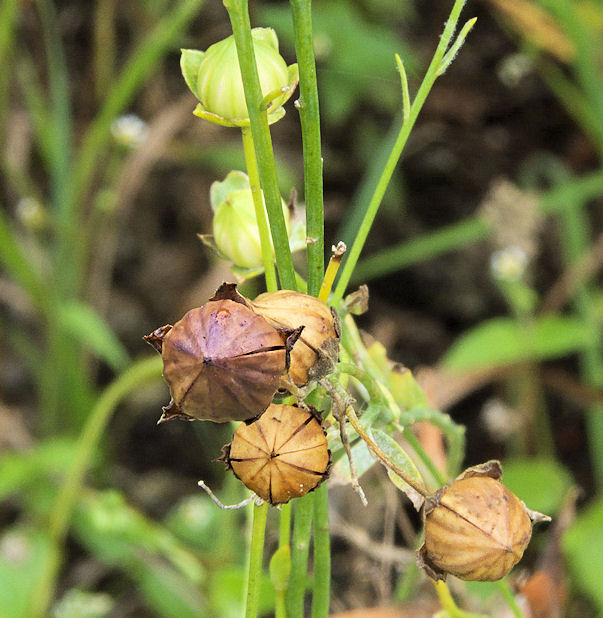
Abb.: उमा । Fruchtkapseln von Linum usitatissimum L. 1753 - Saat-Lein
- Flax
[Bildquelle: Rasbak / Wikipedia. -- GNU FDLicense]
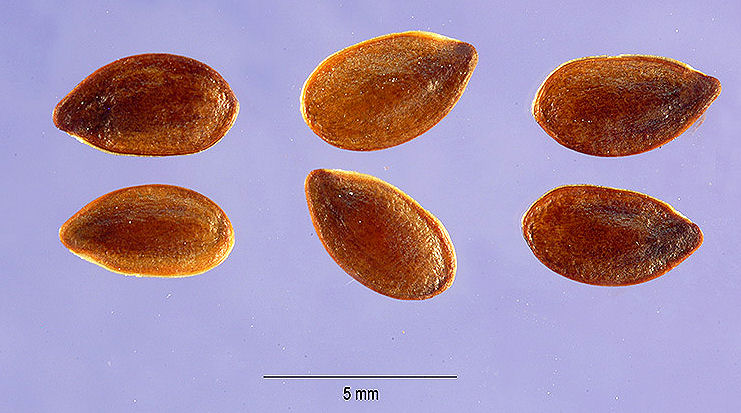
Abb.: उमाः । Leinsamen (Linum usitatissimum L. 1753 - Saat-Lein -
Flax)
[Bildquelle: Jose Hernandez @ USDA-NRCS PLANTS Database. -- Public domain]
क्षुमा - kṣumā f.: Linum usitatissimum L. 1753 - Saat-Lein - Flax, Linseed
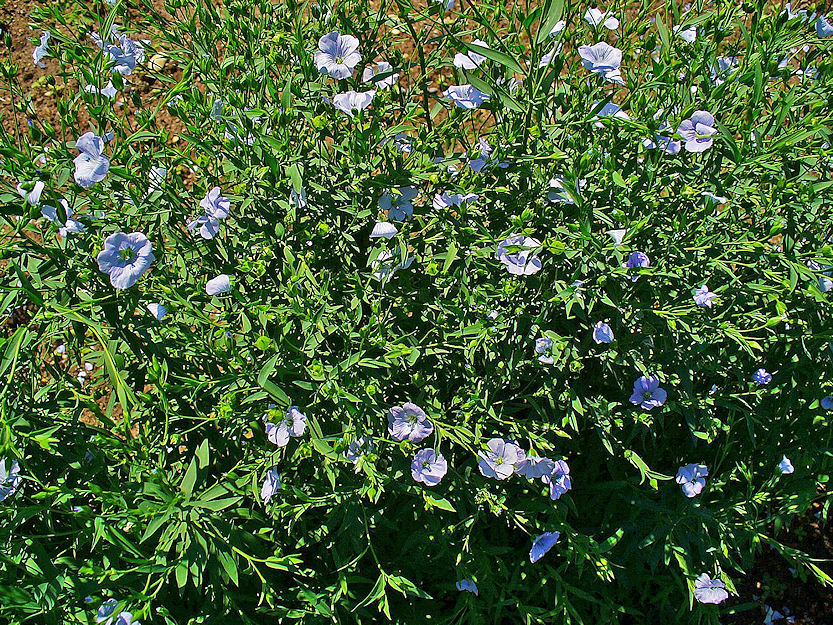
Abb.: क्षुमा । Linum usitatissimum L. 1753 - Saat-Lein - Flax,
Deutschland
[Bildquelle: H. Zell / Wikimedia. -- GNU FDLicense]
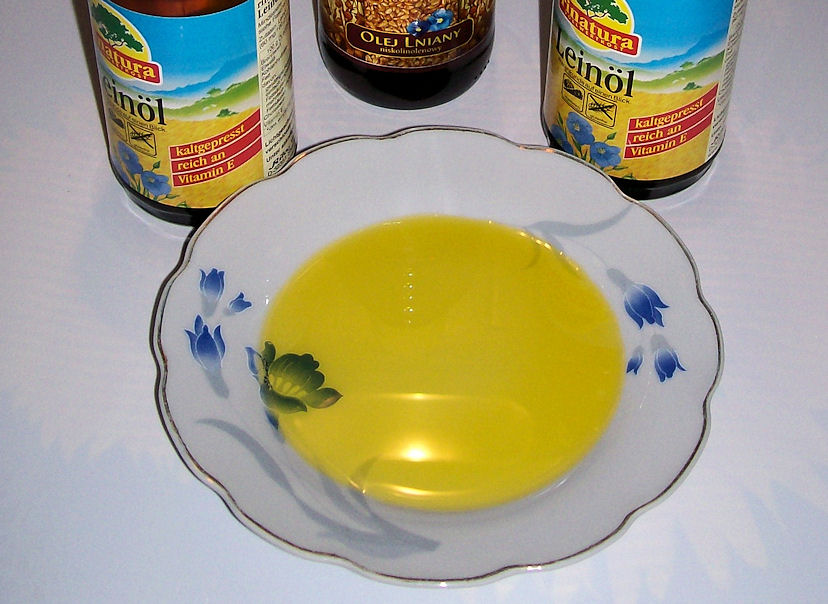
Abb.: Leinöl
[Bildquelle: Ewkaa / Wikimedia. -- GNU FDLicense]
"LINUM USITATISSIMUM, Linn.
Fig.—Bentl. and Trim., t. 39.
Common Flax
Hab.—Egypt. Cultivated in India. The seeds and oil.
[...]
History, Uses, &c. —Linseed, called in Sanskrit Atasī, appears to have been but little used as a medicine by the Hindus. The Mahometans have paid more attention to the plant; they consider it to be cold and dry, and that clothes made with the fibre cool the body and lessen perspiration; they recommend fumigation with the smoke for colds in the head and hysteria, and use the tinder to staunch haemorrhages. Sherriff says if you wish to become thin wear washed linen clothes in the summer but not in winter. The flowers are said to be cardiacal, the seeds aphrodisiacal, and hot and dry. Linseed poultice is recommended for gouty and rheumatic swellings; as an emollient the mucilage is dropped into the eye; with honey it is prescribed in coughs and colds. The roasted seeds are said to be astringent. In Western India, the unripe fruit is used as a vegetable. Flückiger and Hanbury in their Pharmacngraphia (p. 89) give a summary of the history of the plant in the West, and trace its use back to the 23rd century, B. C. It is the λινον of Dioscorides and the Linum of Pliny. Gallesky (1707) strongly advocated the use of Linseed oil in painter's colic and other spasmodic affections of the bowels. In modern medicine Linseed tea is much used as a demulcent drink in cough depending upon an irritated and inflamed condition of the pharynx and upper part of the respiratory passages. It is also useful in irritation of the intestinal canal and urinary passages. The meal is one of our best poultice materials. The oil with an equal part of lime water forms the well known application for burns and scalds called Carron oil, and is also given internally as an aperient in piles, dose two ounces, morning and evening. Formerly the oil boiled to the consistence of caoutchouc was Used for the manufacture of bougies, catheters, and elastic probes. By interrupting the burning linseed oil by covering the boiler, there remains a brown turpentine-like substance; the so-called birdlime. (Brannt.)"
[Quelle: Pharmacographia indica : a history of the principal drugs of vegetable origin met with in British India / by William Dymock [1834-1892], C. J. H. Warden and David Hooper [1858-1947]. -- Bd. 1. -- London, 1890. -- S. 239f.]
"Linum usitatissimum (Linn.) N. O. Linaceae. Common Flax
[...]
Description.—Annual, [...] flowers blue.
Fl. Dec.—Feb.
W. & A. Prod. i. 134—Roxb. Fl. Ind. ii. 100.
Neilgherries. Cultivated in Northern India.
Medical Uses.—An oil is expressed from the seeds without heat As the oil made in India has not the full drying properties of that prepared in Europe, a considerable quantity of the seeds is imported. This arises from the Indian seeds being mixed with those of mustard, with which they are grown, the mixture deteriorating the quality of the oil. The oil-cake made from the seeds after the expression of the oil is very fattening food for cattle. Linseed-meal is the cake coarsely pulverised, and is used for making emollient poultices. European practitioners in this country consider linseed a valuable demulcent, according to Ainslie, and is useful in diarrhoea, catarrh, dysentery, and visceral obstructions. A decoction of the seeds forms an excellent enema in abrasion of the intestines. The meal of the seeds is used for cataplasms; the oil mixed with lime-water (carron oil) has been a favourable application to burns and scalds. Linseed-oil is one of the chief ingredients in oil varnishes and painters' inks; by boiling with litharge its drying properties are much improved. The inferior seeds which are not sufficiently good for oil are boiled and made into a flax-seed jelly, esteemed an excellent nutriment for stock. Linseed contains 1-5th of mucilage, 1-6th of fixed oil. The former resides entirely in the skin, and is separated by infusion or decoction, the latter by expression.—Simmonds. Ainslie.
Economic Uses.—The native country of the flax-plant is unknown, though it has been considered as indigenous to Central Asia, from whence it has spread to Europe, as well as to the surrounding Oriental countries. For centuries it has been cultivated in India, though, strange to say, for its seeds alone ; whereas in Europe it is chiefly sown for the sake of its fibres. The best flax comes from Russia, Belgium, and of late years from Ireland, where it has been cultivated with the greatest success. Much attention has lately been directed to the sowing of the flax-plant in India for the sake of the fibres; and although the experiments hitherto made have not in every case met with that success which was anticipated, yet there seems little reason to doubt that when the causes of the failure are well ascertained, and the apparent difficulties overcome, that flax will be as profitably cultivated on the continent of India as it is in Europe; while European cultivators must eventually supersede the ryots, whose obstinate prejudice to the introduction of novelty is fatal to any improvement at their hands.
As their object is solely to plant for the seeds alone, they generally mix the latter with other crops, usually mustard, a system which could never be persisted in when the object is for fibres. Among those parts of India where flax has best succeeded may be mentioned the Saugor and Nerbudda territories, Burdwan and Jubbulpore. In the former districts especially the rich soil and temperate climate are peculiarly favourable for its growth. In the Punjaub also its cultivation has been attended with the most successful results, as appears from the report of Dr Jamieson, who says: "For some years I have been cultivating flax on a small scale, from seeds procured from Russia, and its fibres have been pronounced by parties in Calcutta of a very superior description. There is nothing to prevent this country from supplying both flax and hemp on a vast scale. In the Punjaub thousands of acres are available; and from the means of producing both flax and hemp, this part of India will always be able to compete with other countries." In the Madras Presidency it has been grown with the best results on the Neilgherries and Shevaroy Hills, near Salem ; and it would probably succeed equally well wherever the temperature is low, accompanied with considerable moisture in the atmosphere. The chief reason of the failures of the crops in Bengal and Behar was owing to the want of sufficient moisture after the cessation of the rains during the growth of the plant. In the Bombay Presidency it has been grown for the seeds alone. In India the time of sowing is the autumn. The soil should be of that character which retains its moisture, though not in an excessive degree. If not rich, manure must be amply supplied, and the plant kept free from all weeds. The best seeds procurable should be selected, of which the Dutch and American are reckoned superior for this country. Dr Roxburgh was the first who attempted the cultivation of flax in India. In the early part of this century he had an experimental farm in the neighbourhood of Calcutta. Since his day the improvements which have taken place, resulting from extended observation and experience, have of course been very great, and specimens of flax which have been sent from Calcutta to the United Kingdom have been valued at rates varying from £30 to £60 a-ton.
The following information on the mode of the culture of flax in India is selected from a report made by Mr Denreef, a Belgian farmer, whose practical experience in this country enabled him to be a correct judge, and whose report is printed entire in the Journal of the Agri-Horticultural Society of Bengal. Such portions of land as are annually renewed by the overflowing of the Ganges, or which are fresh and rich, are the best adapted for the cultivation of flax.
After the earth has been turned up twice or thrice with the Indian plough, it must be rolled; because without the aid of the roller the large clods cannot be reduced, and the land rendered fine enough to receive the seed. The employment of the roller, both before and after sowing, hardens the surface of the earth, by which the moisture of the soil is better preserved, and more sheltered from the heat of the sun. About and near Calcutta, where manure can be obtained in great abundance for the trouble of collecting it, flax may be produced of as good a quality as in any part of Europe.
Manure is the mainspring of cultivation. It would certainly be the better, if the earth be well manured, to sow first of all either Sunn (Indian hemp), or hemp, or rice, or any other rainy-season crop; and when this has been reaped, then to sow the flax. The tillage of the land by means of the spade (mamoty) used by the natives (a method which is far preferable to the labour of the plough), with a little manure and watering at proper seasons, will yield double the produce obtainable from land tilled without manure and irrigation.
The proper time to sow the flax in India is from the beginning of October until the 20th of November, according to the state of the soil. The culture must be performed, if possible, some time before the soil The flax which I have sown in November was generally much finer and much longer than that sown in the former month, which I attributed to the greater fall of dew during the time it was growing. The quantity of country seed required to the Bengal beega is twenty seers, but only fifteen seers of the foreign seed, because it is much smaller and produces larger stalks. The latter should be preferred; it is not only more productive in flax, but, owing to the tenderness of its stalks, it can be dressed much more easily.
The flax must be pulled up by the roots before it is ripe, and while the outer bark is in a state of fusibility. This is easily known by the lower part of the stalks becoming yellow; the fusion or disappearing of the outer bark is effected during the steeping, which may be fixed according to the temperature; say, in December at six days, in January five, in February four days, and less time during the hot season. The steeping is made a day after the pulling, when the seed is separated, and then the stalks are loosely bound in small sheaves, in the same way as the Sunn. The Indians understand this business very well, but in taking the flax out of the water it should be handled softly and with great care, on account of the tenderness of its fibres. When it is newly taken out, it should be left on the side of the steeping-pit for four hours, or until the draining of its water has ceased. It is then spread out with the root-ends even turned once, and when dry it is fit for dressing or to be stapled.
To save the seed, the capsules, after they are separated from the stalks, should be put in heaps to ferment from twenty-four to thirty hours, and then dried slowly in the sun to acquire their ripeness.
When flax is cultivated for the seed alone, the country flax should be preferred. Six seers per beega are sufficient for the sowing. It should be sown very early in October, and taken up, a little before perfect ripeness, by its roots, separately, when it is mixed with mustard seeds: the flax seed, being intended for the purpose of drying oil, is greatly injured by being mixed with mustard seed, by which mixture its drying qualities are much deteriorated.
The oil which is procured from the seeds, and known as Linseed oil, is obtained in two ways—either cold drawn, when it is of a pale colour, or by the application of heat at a temperature of not less than 200°. This latter is of a deeper yellow or brownish colour, and is disagreeable in its odour. One bushel of East Indian seeds will yield 14¾ lb. of oil; of English seeds, from 10 to 12 lb. Nearly 100,000 quarters of seeds are annually exported to Great Britain for the sake of the oil they contain. Great quantities are also shipped from Bombay, where the plant is cultivated for the sake of its seeds alone. The export of linseed from Bombay, says Dr Royle, is now estimated at an annual value of four lacs of rupees.—Simmonds. Ainslie. Lindley."
[Quelle: Drury, Heber <1819 - 1872>: The useful plants of India : with notices of their chief value in commerce, medicine, and the arts. -- 2d ed. with additions and corrections. London : Allen, 1873. -- xvi, 512 p. ; 22 cm. -- s.v.]
Cannabaceae - Hanfgewächse
| 20c./d. mātulānī tu bhaṅgāyāṃ vrīhi-bhedas tv aṇuḥ pumān मातुलानी तु भङ्गायां व्रीहि-भेदस् त्व् अणुः पुमान् ।२० ख। Cannabis sativa L. 1753 - Hanf - Hemp, Marijuana (भङ्गा - bhaṅgā f.: brechend, Hanf) heißt मातुलानी - mātulānī f.: Mutterbrudergattin, Cannabis sativa L. 1753 - Hanf - Hemp, Marijuana |
Colebrooke (1807): "Hemp. Cannabis Sativa. But other interpretations are stated ; and some confound it with linseed, and others with Crotalaria."
Siehe auch zu Amarakośa II.3.12
भङ्गा - bhaṅgā f.: brechend, Cannabis sativa L. 1753 - Hanf - Hemp
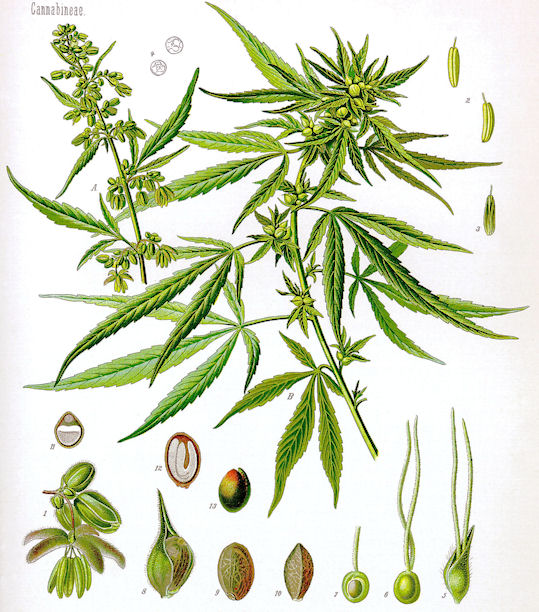
Abb.: भङ्गा । Cannabis sativa L. 1753 - Hanf - Hemp
[Bildquelle: Köhler, 1883-1914]
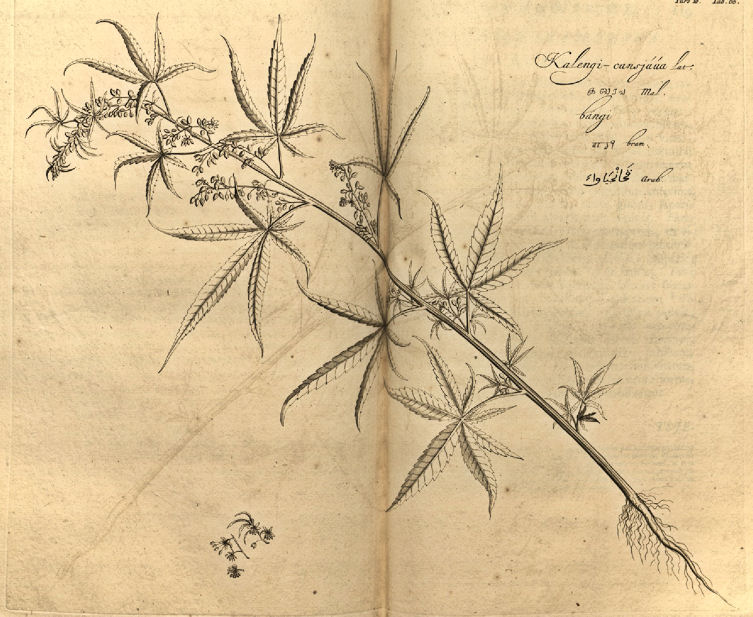
Abb.: भङ्गा । Cannabis sativa L. 1753 - Hanf - Hemp
[Bildquelle: Hortus malabaricus X. Fig. 60, 1690]
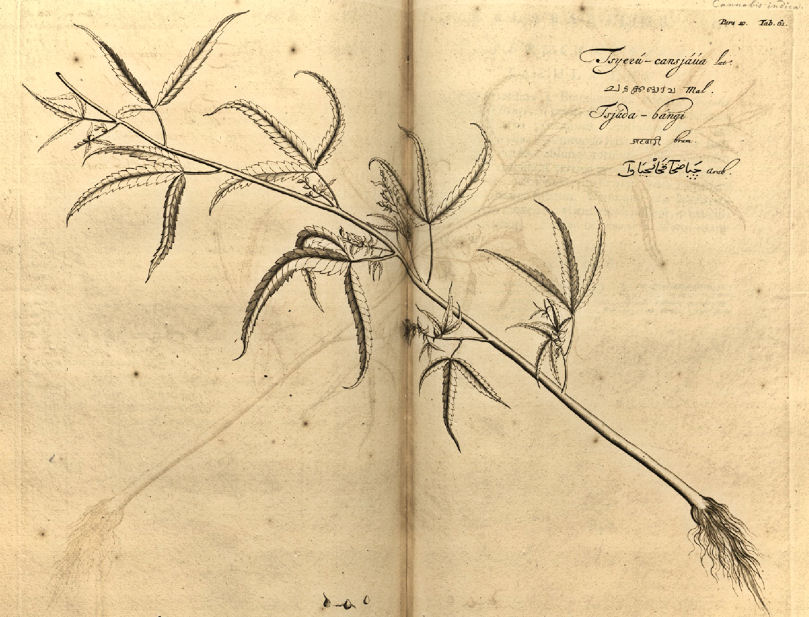
Abb.: भङ्गा । Cannabis sativa L. 1753 - Hanf - Hemp
[Bildquelle: Hortus malabaricus X. Fig. 60, 1690]
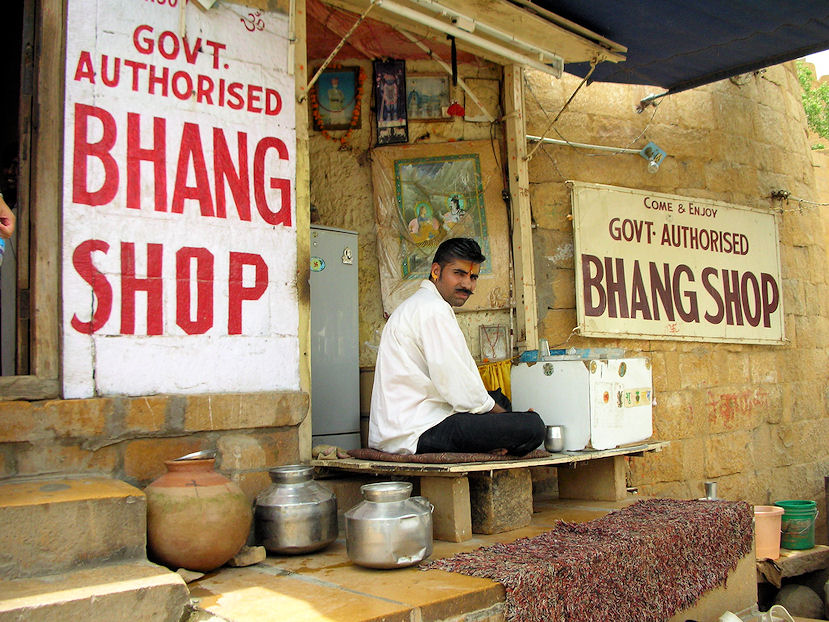
Abb.: भङ्गा । Government authorised Bhang (भांग)
shop, Jaisalmer - जैसलमेर, Rajasthan
[Bildquelle: Tom Maisey. --
http://www.flickr.com/photos/tomm/161697244/. -- Zugriff am 2011-06-30.
-- Creative Commons
Lizenz (Namensnennung)]
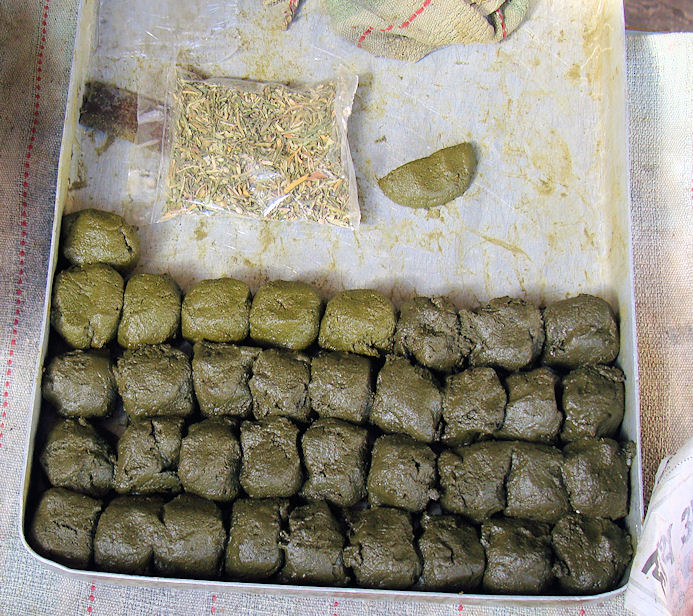
Abb.: भङ्गा । Bhang (भांग),
Bundi - बूंदी, Rajasthan
[Bildquelle: Reuben Strayer. --
http://www.flickr.com/photos/cutey5/4381292529/. -- Zugriff am
2011-06-30. --
Creative
Commons Lizenz (Namensnennung, share alike)]

Abb.: भङ्गा । Śiva im Bhang-Rausch, Shorapur - ಶೋರಾಪುರ,
Karnataka, ca. 1800
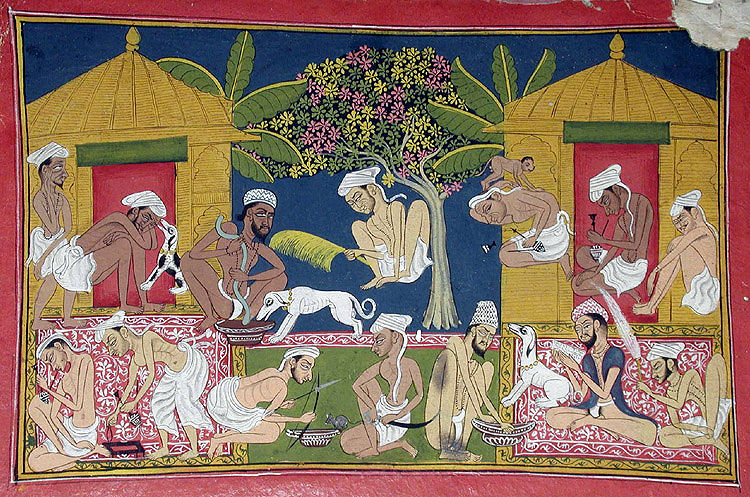
Abb.: भङ्गा । Bhang-Esser, Mewar - मेवाड़, Rajasthan, ca. 1790
मातुलानी - mātulānī f.: Mutterbrudergattin, Cannabis sativa L. 1753 - Hanf - Hemp, Marijuana
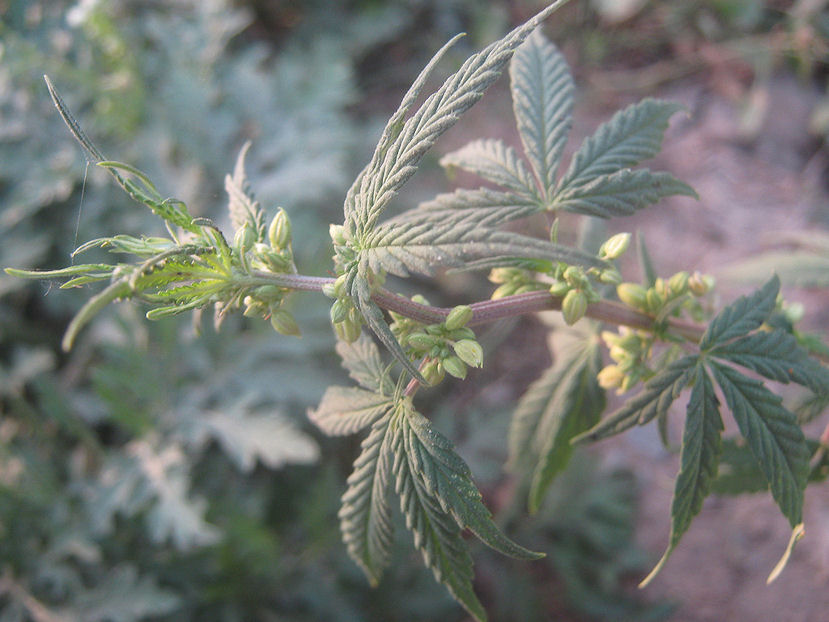
Abb.: मातुलानी । Cannabis sativa ssp. indica (Lam.) Small et
Cronquist 1976 - Haschischpflanze, Indischer Hanf - Marijuana, Pot, Pakistan
[Bildquelle: riaz_ur_rehman
khalid. --
http://www.flickr.com/photos/53469489@N08/5687774785/. -- Zugriff am
2011-06-30. --
Creative Commons Lizenz (Namensnennung)]

Abb.: मातुलानी । Haschisch rauchender Sadhu
[Bildquelle: Manaseejah / Wikimedia. --
Creative Commons Lizenz (Namensnennung, share alike)]
"CANNABIS SATIVA, Linn. Fig.—Bentl. and Trim., t. 281 ; Reichb. Ic. Fl. Germ t. 655; Rheede, Hort. Mal. x., tt. 60, 61.
Hemp (Eng.)
Hab.—N.-W. Himalaya. Cultivated in India. The leaves, female flowering topst resinous exudation, and seeds.
[...]
History, Uses, &c.—The hemp plant, in Sanskrit Bhanga and Indrasana, "Indra's hemp," has been known in the East as a fibre plant from prehistoric times. It is mentioned along with the Vedic plant Janjida, which has magic and medicinal properties, and which is described in the Athavaveda (ix., 34, 35) as a protector, and is supplicated to protect all animals and properties. The gods are said to have three times created this herb (oshadhi). Indra has given it a thousand eyes, and conferred on it the property of driving away all diseases and killing all monsters; it is praised as the best of remedies, and is worn as a precious talisman ; along with hemp it prevents wandering (vishkandha), fever and the evil eye. De Gubernatis says that in Sicily the peasant women still believe in hemp as an infallible means of attaching their sweethearts. On Good Friday they take a thread of hemp and twenty-five needlefuls of coloured silk, and at midnight weave them together, repeating the following lines:—
Chistu è cánnavu di Christu
Servi pi attaccari a chisto"This is the hemp of Christ;
it serves to attach this man."They then enter the Church with the thread in their hands, and at the moment of the consecration of the host, they make three knots in it, adding at the same time some hairs of the man they are in love with, and invoke all the demons to attract him to his sweetheart. (Cf. Mattia 'di Martino, Usi e credenze popolari Siciliane, Woto, 1874.) Burns in "Halloween" notices a closely-allied superstition. The intoxicating properties which the plant possesses in its Eastern home appear not to have been discovered until a more recent date, but in the fifth chapter of Menu, Brahmins are prohibited from using it, and in the sacred books of the Parsis the use of Bana for the purpose of procuring abortion is forbidden. In Hindu mythology the hemp plant is said to have sprung from the amrita produced whilst the gods were churning the ocean with Mount Mandara. It is called in Sanskrit Vijaya, "giving success," and the favourite drink of Indra is said to be prepared from it. On festive occasions, in most parts of India, large quantities are consumed by almost all classes of Hindus. The Brahmins sell Sherbet1 prepared with Bhang at the temples, and religious mendicants collect together and smoke Ganja. Shops for the sale of preparations of hemp are to be found in every town, and are much resorted to by the idle and vicious. Hemp is also used medicinally ; in the Raja Nirghanta its synonyms are Urjava and Jaya, names which mean promoter of success, Chāpala "the cause of a reeling gait," Ananda "the laughter moving," Harshini "the exciter of sexual desire"; among other synonyms are Kashmiri "coming from Kashmir," Matulāni " the maternal uncle's wife," Mohini ''fascinating," &c. Its effects on man are described as excitant, heating, astringent; it destroys phlegm, expels flatulence, induces costiveness, sharpens the memory, excites appetite, &c, Susruta recommends the use of Bhang to people suffering from catarrh. In the Rājavalabha, a recent work in use in Bengal, we are informed that the gods through compassion on the human race sent hemp, so that mankind by using it might attain delight, lose fear, and have sexual desires.
1 Sabzi or Sabji, an infusion of Bhang with black pepper, anise and sugar. In Bengal milk, and cucumber and melon seeds are added.
The seductive influences of hemp have led to the most extravagant praise of the drug in the popular languages of India, but in truth it is one of the curses of the country ; if its use is persisted in, it leads to indigestion, wasting of the body, cough, melancholy, impotence and dropsy. After a time its votary becomes an outcaste from society, and his career terminates in crime, insanity, or idiotcy.
Ganja pie gur-gyan ghate, aur ghate tan andar ka,
Khokat, khokat dam nikse, mukh dekho jaisa bandar ka.Who ganja smoke do knowledge lack, the heart burns constantly,
The breath with coughing goes, the face as monkey's pale you see. Fallon.According to tradition, the use of hemp as an intoxicant was first made known in Persia by Birarslan, an Indian pilgrim, in the reign of Khusru the first (A.D. 531—579), but, as we have already stated, its injurious properties appear to have been known long before that date.
There can be no doubt that the use of hemp as an intoxicant was encouraged by the Ismailians in the 8th century, as its effects tended to assist their followers in realising the tenets of the sect:—
We've quaffed the emerald cup, the mystery we know,
Who'd dream so weak a plant such mighty power could show!Hasan Sabah, their celebrated chief, in the 11th century notoriously made use of it to urge them on to the commission of deeds of daring and violence so that they became known as the Hashshashin or "Assassins." Hasan studied the tenets of his sect in retirement at Nishapur, doubtless at the monastery noticed by O'Shaughnessy (Bengal Dispensatory), in the following terms:— "Haidar lived in rigid privation on a mountain between Nishapur and Rama, where he established a monastcry; after having lived ten years in this retreat, he one day returned from a stroll in the neighbourhood with an air of joy and gaiety; on being questioned, he stated that, struck by the appearance of a plant, he had gathered and eaten its leaves. He then led his companions to the spot, who all ate and were similarly excited, A tincture of the hemp leaf in wine or spirit seems to have been the favourite formula in which Sheikh Haidar indulged himself. An Arab poet sings of Haidar's emerald cup, an evident allusion to the rich green colour of the tincture. The Sheik survived the discovery ten years, and subsisted chiefly on this herb, and on his death his disciples at his desire planted it in an arbour round his tomb. From this saintly sepulchre the knowledge of the effects of hemp is stated to have spread into Khorasan. In Chaldea it was unknown until 728 A. H., the kings of Ormus and Bahrein then introduced it into Chaldea, Syria, Egypt and Turkey."
Taki-ed-din Ahmad, commonly known as Makrizi, who wrote a number of treatises upon Egypt in the 14th century, mentions the lease of the monopoly for the sale of Haslrish in that country, and its abolition in (1286) by the Sultan.
Haji Zein in the Ikhtiārāt (1368), after noticing the two kinds of Kinnab mentioned by the Greeks, states that Indian hemp is known as Bang or Sabz in Shiraz; after describing its properties, he says that in cases of poisoning by it vomiting should be induced by the administration of butter and hot water to empty the stomach, and that afterwards acid drinks should be administered.
The Greeks were acquainted with hemp more than 2000 years ago; Herodotus (iv., 74, 75) mentions it as being cultivated by the Scythians, who used its fibre for making their garments, and the seeds to medicate vapour baths. Dioscorides mentions two kinds of κανναβις the wild and the cultivated; the former is the Althaea cannabina of Linneus, and the latter Cannabis indica; he states that the seeds, if eaten too freely, destroy the virile powers, and that the juice is used to relieve earache. Galen and the early Arabian physicians, such as Ibn Sina and Razi, follow Dioscorides in his opinion of the properties of hemp, and do not notice its having any intoxicating properties, and unless the Gelotophyllis of Pliny (24, 102) was Indian hemp, there is no evidonce to show that the ancients were acquainted with them. Pliny says:—"The Gelotophyllis (laughing leaf) is a plant found in Bactriana, and on the banks of the Borysthenes. Taken internally with myrrh and wine, all sorts of visionary forms present themselves, and excite the most immoderate laughter, which can only be put an end to by taking kernels of the pine nut, with pepper and honey, in palm wine." The earliest Western medical writer who distinctly mentions the intoxicating properties of hemp is Ibn Baitar, a native of Africa, who died in Damascus in 1248. All the later Mahometan physicians describe the two kinds of Kinnab mentioned by the ancients, whom they quote, and a third kind called Hindi or Indian. The name Cannabis is derived from the Persian Kanab. which is connate to the Sanskrit Śana, the Russian Kanopla, the Irish Canaib, the Iceland Hanp, the Saxon Haenep, and the old German Hanaf.
The author of the Makhzan-el-Adwija gives Udifarunas as the Yunani name, and Kanabira as the Syrian, and also mentions a number of cant terms which are applied to it, such as Wark-el-khyal, Hashish, Hashishat-el-fukara, Arsh-numa, Chatr-i-akhzar, &c. Charas is described, and the practice of smoking it. The Bengal-grown hemp is said to be less intoxicating than that grown in more Northern climates. Hempseed is called in Persian Shahdanah," royal seeds." The leaves are made into Sherbet and conserves for intoxicating purposes. The properties of hemp are described as cold and dry in the third degree, that is, stimulant and sedative, imparting at first a gentle reviving heat, and then a refrigerant effect, the drug at first exhilarates, improves the complexion, excites the imagination, increases the appetite, and acts as an aphrodisiac ; afterwards its sedative effects are observed—if its use is persisted in, it leads to indigestion, wasting of the body, melancholy, impotence and dropsy.
Mirza Abdul Razzak considers hemp to be a powerful exciter of the flow of bile, and relates cases of its efficacy in restoring appetite, of its utility as an external application as a poultice with milk in relieving haemorrhoids, and internally in gonorrhoea, to the extent of a quarter drachm of bhang.
Charas is only mentioned in comparatively recent medical works. The word is said to be derived from the Sanskrit चर्म a skin, but it occurs in Persian with the primary signification of a piece of leather or cloth, the four corners of which are tied up so as to form a wallet, such as beggars carry; in Hindi it signifies a leather bag for holding water, &c. The Charas collected in Central Asia is stored in leathern bags by the cultivators. Among European writers in the East, Rheede and Rumphius figure and describe the Indian plant; the latter states that the kind of mental excitement it produces depends upon the temperament of the consumer. He quotes a passage from Galen, lib. I. (de aliment. facult.), in which it is asserted that in that great writer's time it was customary to give hempseed to the guests at banquets, as a promoter of hilarity and enjoyment (the seeds are still roasted and eaten in the East). Rumphius adds, that the Mahometans in his neighbourhood frequently sought for the male plant from his garden, to be given to persons afflicted with virulent gonorrhoea or with asthma, and the affection which is popularly called "stitches in the side." He tells us, moreover, that the powdered leaves check diarrhoea, are stomachic, cure the malady named Pitao, and moderate excessive secretion of bile. He mentions the use of hemp smoke as an enema in strangulated hernia, and of the leaves as an antidote to poisoning by orpiment.
In the Bulletin de Phanmcie (1810, p. 400), we find it briefly described by M. Rouyer, apothecary to Napoleon, and member of the Egyptian Scientific Commission, in a paper on the popular remedies of Egypt. With the leaves and tops, he tells us, collected before ripening, the Egyptians prepare a conserve, which serves as the base of the berch, the diasmouk, and the bernaouy. Hemp leaves reduced to powder and incorporated with honey, or stirred with water, constitute the berch of the poor classes.
Ainslie notices Majun, a confection made with hemp leaves to be used as a sweetmeat, the composition of which varies in different parts of the East, and to which are often added other intoxicating drugs. O'Shaughnessy in the Bengal Dispensatory 1812 gives a detailed account of its preparation in Calcutta."
[Quelle: Pharmacographia indica : a history of the principal drugs of vegetable origin met with in British India / by William Dymock [1834-1892], C. J. H. Warden and David Hooper [1858-1947]. -- Bd. 3. -- London, 1893. -- S. 318 - 324.]
"Cannabis sativa (Linn.) N. O. Cannabinaceae. Common hemp plant [...]
Description.—Annual, 4-6 feet, covered all over with an extremely fine rough pubescence; [...]
Fl. All the year.
Roxb. Fl. Ind. iii. 772.—Rheede, x. t 60.
Hills north of India. Cultivated in the Peninsula.
[...]
Economic Uses.—The earliest notice we have of the hemp plant is found in Herodotus (Book iv. c. 74-75), who says : " Hemp grows in Scythia; it is very like flax, only that it is a much taller and coarser plant.- Some grows wild about the country; some is produced by cultivation. The Thracians make garments of it which closely resemble linen; so much so, that if a person has never seen hemp, he is sure to think they are linen; and if he has, unless he is very experienced in such matters, he will not know of which material they are. The Scythians take some of this hemp-seed, and, creeping under felt coverings, throw it upon the red-hot stones; immediately it smokes, and gives out such a vapour as no Grecian bath can excel." —(Rawlinson's Trans., iii. 54.) The plant is here called Cannabis, the same word which we now use, and from which the English word canvas is derived. To the present day it grows in Northern Russia and Siberia, Tauria, the Caucasus, and Persia, and is found over the whole north of Europe. We next learn of it in Athenaeus, who, quoting from an ancient historian, Moschion, the description of a ship built by Hiero, King of Syracuse, and which was superintended by the famous Archimedes, says, "for ropes he provided cordage from Spain, and hemp and pitch from the river Rhone." This was Hiero II., who flourished about 270 B. C. We next hear of it in Pliny, who describes the hemp plant as being well known to the Romans, who manufactured a kind of cordage from it This author has minutely described, in the 19th book of his 'Natural History' the mode of cultivating it, and its subsequent preparation in order to obtain the fibre. He further states that in those days it had some repute in medicine, especially the root and juice of the bark, but these uses are now obsolete or of little value. It is now cultivated everywhere in India, chiefly for the intoxicating property which resides in its leaves, and which is made into the drug called Bhang. Much attention has of late years been paid to its cultivation, and several able reports upon this subject have been drawn up. According to Captain Huddleston, in the 'Transactions of the Agri. Hort Soc. of India' (viii. 260), " in the Himalaya there are two kinds; one is wild, of little or no value, but the other one is cultivated on high lands, selected for this purpose. The land is first cleared of the forest-trees : owing to the accumulation of decomposed vegetable matter, no manure is required for the first year; but after that, or in grounds which have not been cleared for the purpose, manure must be abundantly supplied to insure a good hemp crop. The plant flourishes best at elevations ranging from 4000 to 7000 feet The seeds are put down about the end of May or beginning of June ; and as soon as the young ptaits have risen up, the ground is carefully cleared of weeds and the plants thinned, with a distance between each of three or four inches. They are then left to grow, not being fit to cut before October or November."
The best hemp is procured from the male plants, and these latter are cut a month earlier than the female ones, and yield a tougher and better fibre. When the stalks are cut they are dried in the sun for several days. The seeds are then rubbed out between the hands, and this produces what is called Churrus, which is scraped off, and afterwards sold. The stalks being well dried are put up in bundles, and steeped for a fortnight in water, being kept well under by pressure, then taken out, beaten with mallets, and again dried. The fibre is now stripped off from the thickest end of the stalk, and then made up in twists for sale, and manufactured into bags and ropes.
It would appear that none of the hemp so cultivated is exported, only sufficient being grown for consumption among the inhabitants of the districts. Dr Roxburgh was the first who turned his attention to the cultivation of the plant in the plains ; and found that to insure success the ground selected should be, if possible, of a low humid description, and that the rainy season was the best in which to sow the seeds, the intense heat of the sun being prejudicial to its favourable growth. Dr Royle and others consider that with ordinary care and judicious treatment the hemp plant can be successfully cultivated in the Indian plains, though the fibres yielded may not be of such fine quality as those grown in mountainous districts. When sown for the sake of its cordage, the plant should be sown thick, in order that the stem may run up to a considerable height without branching, whereby a longer fibre is obtained, and the evaporation is less from the exclusion of air and heat, rendering the fibre of a more soft and pliable nature. The natives, on the contrary, who cultivate the Cannabis solely for the Bhang, transplant it like rice, the plants being kept about eight or ten feet apart. This has the effect of inducing them to branch, and the heat naturally stimulating the secretion, the intoxicating properties are increased. Although the cultivation of the hemp plant has considerably decreased in this country of late years, yet it would appear that plants requiring so little care might be easily reared to any extent for the sake of their fibres, should the demand require it, even were they only for use in our own dominion, without the object of exportation. It has been shown in the ' Journal of the Asiatic Society' that the cost of hemp, as prepared by the natives in Dheyra Dhoon, would be about £6 or £7 per ton in Calcutta (preparation and carriage included) ; but were the cultivation increased and improved, the extra remuneration to the cultivators, with other contingent charges, would make the total cost at the Presidency about £17 per ton. With the introduction of railways this might be still further decreased. In point of strength and durability, as evinced by the samples produced, there is no doubt that good Himalayan hemp is superior to Russian hemp. At any rate, proof exists that it can be produced of a superior quality. On a specimen of Russian hemp being shown to a native cultivator, he remarked that were he to produce such an inferior article it would never find a sale.
The hemp plant, it is said, has the singular property of destroying caterpillars and other insects which prey upon vegetables, for which reason it is often the custom in Europe to encircle the beds with borders of the plant, which effectually keeps away all insects.
It is grown in almost all parts of Europe, especially in Russia, Italy, and England. Gunja has a strong aromatic and heavy odour, abounds in resin, and is sold in the form of flowering-stalks. Bhang is in the form of dried leaves, without stalk, of a dull-green colour, not much odour, and only slightly resinous : its intoxicating properties are much less. Gunja is smoked like tobacco. Bhang is not smoked, but pounded up with water into a pulp, so as to make a drink highly conducive to health, and people accustomed to it seldom get sick. In Scinde, a stimulating infusion made from the plant is much drunk among the upper classes, who imagine that it is an improver of the appetite. Gunja is frequently mixed with tobacco to render it more intoxicating. This is especially done by the Hottentots, who chop the hemp-leaves very fine, and smoke them together in this manner. Sometimes the leaves, powdered, are mixed with aromatics and thus taken as a beverage, producing much the same effects as opium, only more agreeable.—Royle, Fib. . Plants. Müller in Hooker's Journ. of Botany."
[Quelle: Drury, Heber <1819 - 1872>: The useful plants of India : with notices of their chief value in commerce, medicine, and the arts. -- 2d ed. with additions and corrections. London : Allen, 1873. -- xvi, 512 p. ; 22 cm. -- s.v.]
Poaceae - Süßgräser
| 20c./d. mātulānī tu bhaṅgāyāṃ vrīhibhedas tv aṇuḥ pumān मातुलानी तु भङ्गायां व्रीहिभेदस् त्व् अणुः पुमान् ।२० ख। Eine Art Korn (vrīhibheda) ist अणु - aṇu m.: winzig, Panicum miliaceum L. 1753 - Echte Hirse - Common Millet |
Colebrooke (1807): "Chinā. Panicum pilosum, Roxb. But other interpretations are also given."
अणु - aṇu m.: winzig, Panicum miliaceum L. 1753 - Echte Hirse - Common Millet
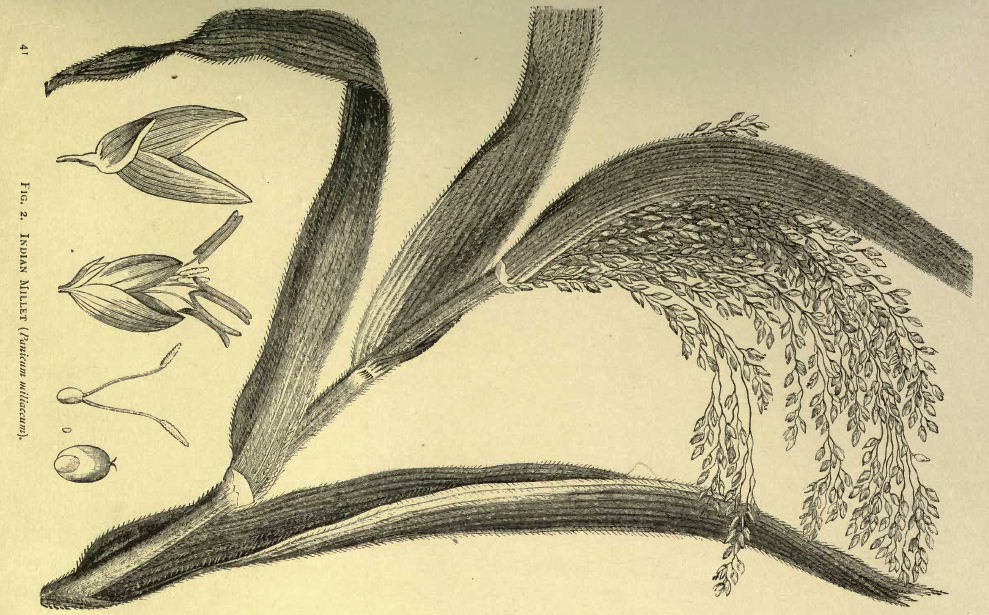
Abb.: अणुः । Panicum miliaceum L. 1753 - Echte Hirse - Common
Millet
[Bildquelle: Church, A. H. (Arthur Herbert) <1834-1915>: Food-grains of
India. -- London, 1886.]

Abb.: अणुः । Panicum miliaceum L. 1753 - Echte Hirse - Common
Millet
[Bildquelle: O. W. Thomé, 1885]
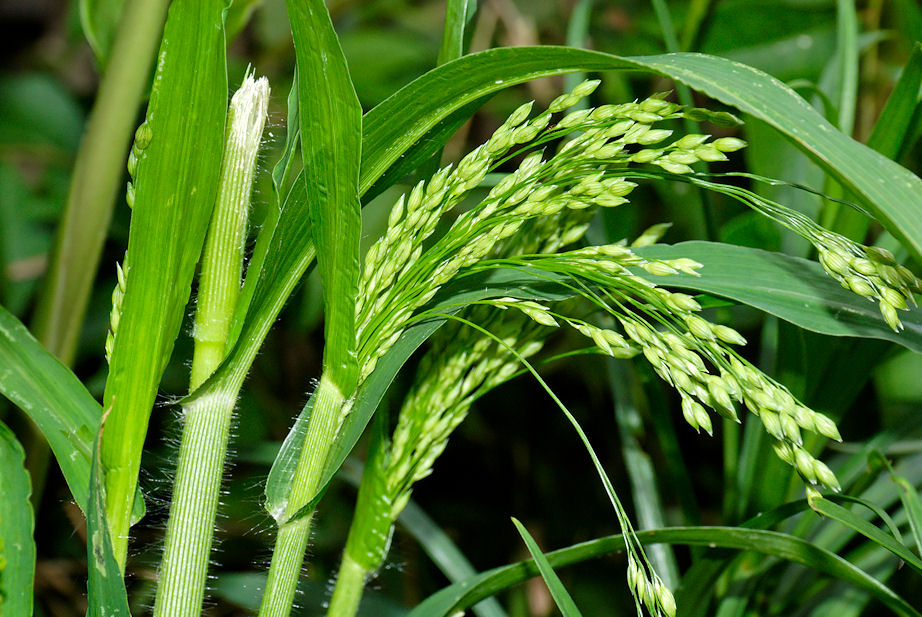
Abb.: अणुः । Panicum miliaceum L. 1753 - Echte Hirse - Common
Millet, Australien
[Bildquelle: Tony Rodd. --
http://www.flickr.com/photos/tony_rodd/1813759250/. -- Zugriff am
2011-06-30. --
Creative
Commons Lizenz (Namensnennung, keine kommerzielel Bearbeitung, share
alike)]
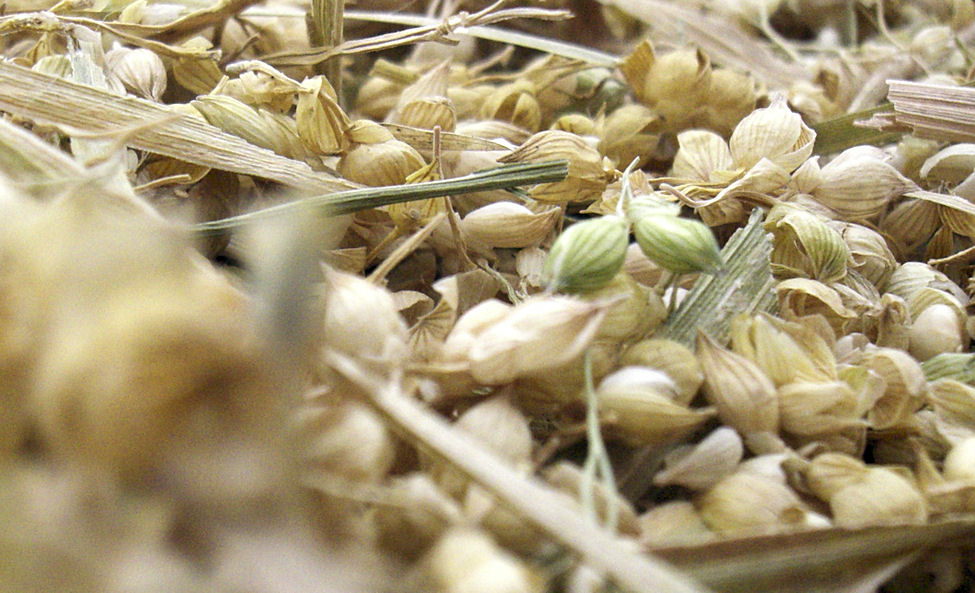
Abb.: अणुः । Panicum miliaceum L. 1753 - Echte Hirse - Common
Millet, Japan
[Bildquelle: max takaki. --
http://www.flickr.com/photos/46519004@N02/4444165675/. -- Zugriff am
2011-06-30. --
Creative Commons Lizenz (Namensnennung)]
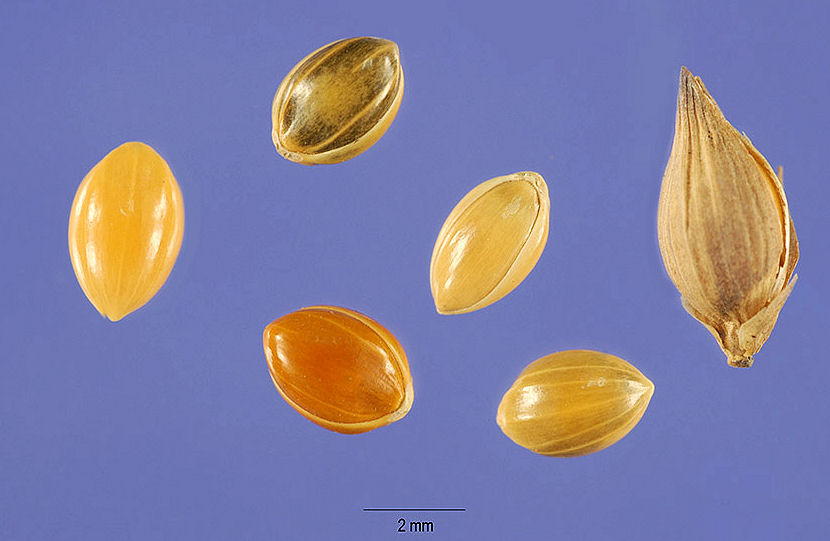
Abb.: अणुः । Samen von Panicum miliaceum L. 1753 - Echte Hirse - Common
Millet
[Bildquelle: Steve Hurst @ USDA-NRCS PLANTS Database. -- Public domain]
"Chena or Indian Millet. Panicum miliaceum, L.
This millet is an erect annual about 2 feet high, with rather broad hairy leaves and a much divided nodding panicle. It was early introduced and is largely grown in many parts of India ; it has become naturalised in Ceylon. It generally needs but little rain. It ascends the Himalaya as far as 10,000 feet. It is extensively cultivated in some parts of Purniah District, and is used also in Bhagulpur, Patna, and Champaran, the yield being considerable. It is a quick-growing plant, a second crop being often obtained from the grain shed in harvesting the first. It proves a useful crop in times of scarcity, not only from its rapid growth, but from its flourishing in seasons of comparatively small rainfall. Mr. Duthie, however, states that in the districts on which he reports, this crop needs a good deal of watering, and that the yield does not amount to more than from 6 to 8 maunds per acre. In the Deccan it is sown in June and July, and reaped in November and December.
[...]
This millet is boiled and eaten with milk and sugar, or with dal in curries, or as " ara," the grains being slightly boiled, dried, parched in hot sand, and then sifted from the husks; the "mara" is then eaten with sour milk—this preparation is a favourite food at marriage-feasts."
[Quelle: Church, A. H. (Arthur Herbert) <1834-1915>: Food-grains of India. -- London, 1886. -- S. 40 - 43.]
| 21a./b. kiṃśāruḥ sasyaśūkaṃ syāt kaṇiśaṃ sasyamañjarī किंशारुः सस्यशूकं स्यात् कणिशं सस्यमञ्जरी ।२१ क। [Bezeichnungen für Getreide-Granne:]
|
Colebrooke (1807): "Beard of corn."
किंशारु - kiṃśāru m.: "Ist das ein Pfeil?", Granne
Siehe auch Vers 23a.
"Eine Granne (auch Arista) (von ahd. grana, Barthaar) ist ein borsten- oder fadenförmiger, gewöhnlich etwas starrer Fortsatz an dem Ende oder auf dem Rücken eines Organs, oft gekrümmt und gekniet, nie aber rankenartig gewunden. Sie findet sich beispielsweise an den Spelzen vieler Süßgräser, an den Antheren der Ericaceen oder an den Früchten der Geraniaceen." [Quelle: http://de.wikipedia.org/wiki/Granne. -- Zugriff am 2011-07-02]
"Die Granne, plur. die -n, im gemeinen Leben Ober- und Niederdeutschlandes, eine Benennung einer jeden zarten biegsamen Spitze, dergleichen die langen scharfen Spitzen an den Fruchtähren, besonders an den Gerstenähren, welche in andern Gegenden Acheln und Gracheln heißen, (S. Agen,) die steifen Haare auf dem Rücken der Schweine, die Borsten, ingleichen die steifen Haare welche die Katzen und andere Thiere an dem Maule haben, die Tangeln oder Nadeln des Tangelholzes u.s.f. sind." [Quelle: Adelung, Johann Christoph <1732 - 1806>: Grammatisch-kritisches Wörterbuch der Hochdeutschen Mundart. -- Leipzig, 1793 - 1801. -- s. v.]

Abb.: किंशारवः । Triticum spp. - Weizen - Wheat
[Bildquelle: O. W. Thomé, 1885]
सस्यशूक - sasyaśūka m.: Getreidestachel, Granne
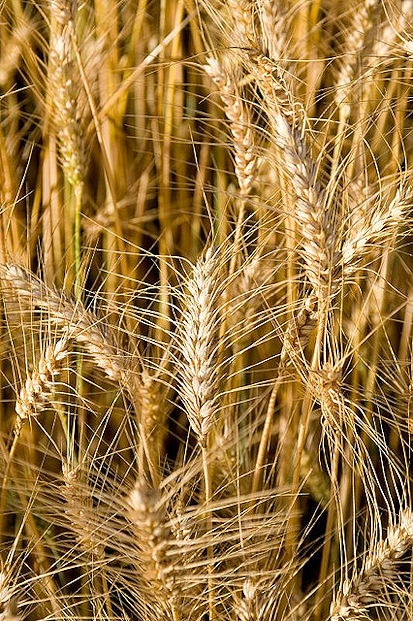
Abb.: सस्यशूकाः । Weizenähren, Indien
[Bildquelle: Dharmindar Chahal. --
http://www.flickr.com/photos/chahal/472731985/. -- Zugriff am 2011-07-02. --
Creative Commons
Lizenz (Namensnennung, keine kommerzielle Nutzung, keine Bearbeitung)]
| 21a./b. kiṃśāruḥ sasyaśūkaṃ syāt kaṇiśaṃ sasyamañjarī किंशारुः सस्यशूकं स्यात् कणिशं सस्यमञ्जरी ।२१ क। [Bezeichnungen für Ähre, Rispe:]
|
Colebrooke (1807): "Ear or spike."
"Die Ähre, plur. die -n, Diminutiv. das Ährchen, der oberste Teil der Halmen an den Grasarten, besonders an den Getreidearten, welcher der Sitz der Blüte und des Samens ist." [Quelle: Adelung, Johann Christoph <1732 - 1806>: Grammatisch-kritisches Wörterbuch der Hochdeutschen Mundart. -- Leipzig, 1793 - 1801. -- s. v.]
"Die Rispe, plur. die -n, an den Pflanzen, eine Art der Blumen, wenn dieselben an verlängerten Armen und Stielen, auf Stielchen von verschiedener Länge stehen, dergleichen z.B. der Hafer, die Hirse u.s.f. haben, Panicula L. bei andern ein Strauß; zum Unterschiede von einer Ähre, wo die Blumen in gewissen Reihen oder Zeilen an dem verzahnten Hauptstiele sitzen, und einer Kolbe, wo sie an dem Hauptstiele auf kurzen, dicht in einander gedrungenen und verdeckten Stielen fest stehen. In manchen Gegenden sind Rispe und Ähre gleichbedeutend." [Quelle: Adelung, Johann Christoph <1732 - 1806>: Grammatisch-kritisches Wörterbuch der Hochdeutschen Mundart. -- Leipzig, 1793 - 1801. -- s. v.]
Eine Ähre (Spica) ist ein unverzweigter Blütenstand mit einer gestreckten Hauptachse, der Ährenspindel (Rhachis spicae). Ist diese Hauptachse fleischig verdickt, spricht man von einem Kolben (Spadix). Die Einzelblüten sitzen bei einer Ähre ungestielt an der Spindel. Bei den meisten Ähren blühen die untersten Blüten als erste auf (Basitonie). [...] Bei Süß- und Sauergräsern sitzen Ährchen anstelle der Einzelblüten. [Quelle: http://de.wikipedia.org/wiki/%C3%84hre. -- Zugriff am 2011-07-02]
"Als Ährchen bezeichnet man in der Botanik einen Blütenstand, an dem in ährenartiger Anordnung die Blüten hinter Deckblättern, den Spelzen, sitzen.
[...]
SüßgräserDas Ährchen ist ein kleiner Blütenstand, der aus einer bis wenigen Blüten aufgebaut ist. Typisch ist die Abfolge vieler verschiedener Spelzen, trockenhäutiger Hüllen um die Blüten und später um die Samen. Am besten lässt sich der Aufbau von außen nach innen beschreiben:
Abb.: Schema der Blüte eines Süßgrases
[Bildquelle: Alfred / Wikipedia. -- Public domain]A: Das ganzen Ährchen wird von zwei, selten auch ein oder mehr, Hüllspelzen (Glumae) umgeben, die es je nach Größe mehr oder weniger komplett einhüllen. Die äußere Hüllspelze sitzt auf der Unterseite der Ährchenachse, die innere auf der Oberseite. Innerhalb der Hüllspelzen befinden sich in zweizeiliger Anordnung die einzelnen Blüten. Die Anzahl aller nachfolgenden Bauteile ist pro Blüte angegeben.
B: Es folgt die Deckspelze (Palea inferior = untere oder Palea exterior = äußere Spelze), sie ist das Tragblatt, in deren Achsel die Blüte steht.
C: An der Spitze trägt die Deckspelze oft eine steife Borste, die Granne. Bei den Hüllspelzen sind Grannen selten anzutreffen.
1: Die Vorspelze (Palea superior = obere oder Palea interior = innere Spelze) wird von zwei verwachsenen Blättern des äußeren Blütenblattkreises gebildet.
2: Der Ursprung der zwei, selten drei, Schwellkörper (Lodiculae) geht auf den inneren Blütenblattkreis zurück.
3: Durch das Anschwellen spreizen die Lodiculae die Spelzen auseinander, die Blüte öffnet sich und die Staubblätter kommen zum Vorschein. Das Ährchen ist nun erblüht und kann bestäubt werden.
4: Fruchtknoten
5: Narbe
Als Blütchen bezeichnet man die Einheit aus Deckspelze, Vorspelze und eigentlicher Blüte. Wenn die Frucht herangewachsen ist, wird diese Einheit als Spelzfrucht bezeichnet.[1]
Mehrere Ährchen sind wiederum zu Ähren oder Rispen an einer Hauptachse (Rachis) vereinigt. Sitzen die Ährchen einer Rispe sehr kurz an der Hauptachse, dann sieht sie wie eine Ähre aus und man spricht von einer Scheinähre."
[Quelle: http://de.wikipedia.org/wiki/%C3%84hrchen. -- Zugriff am 2011-07-02]
कणिश - kaṇiśa n.: Ähre

Abb.: कणिशम् । Schema einer Ähre
[Bildquelle: Shazz / Wikimedia. -- GNU FDLicense]
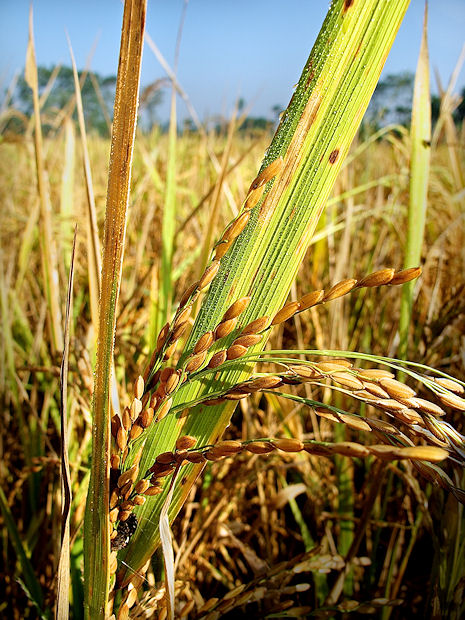
Abb.: कणिशानि । Reifer Reis, Nangal Dhowa village, Assam
[Bildquelle: Michael Foley. --
http://www.flickr.com/photos/michaelfoleyphotography/5581310710/. -- Zugriff
am 2011-07-02. --
Creative Commons Lizenz (Namensnennung, keine kommerzielle Nutzung, keine
Bearbeitung)]
सस्यमञ्जरी - sasyamañjarī f.: "Getreide-Blütenstrauß", Ähre
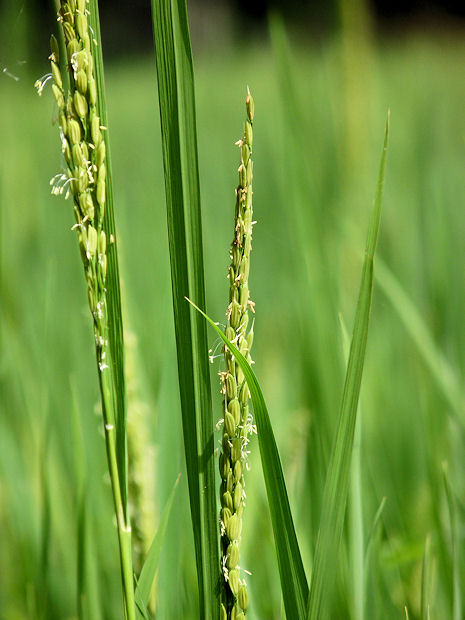
Abb.: सस्यमञ्जर्यौ । Reisblüten, Kedavoor, Kerala
[Bildquelle: jeevan jose. --
http://www.flickr.com/photos/jkadavoor/4533387557/. -- Zugriff am
2011-07-02. --
Creative
Commons Lizenz (Namensnennung, keine kommerzielle Nutzung, share alike)]
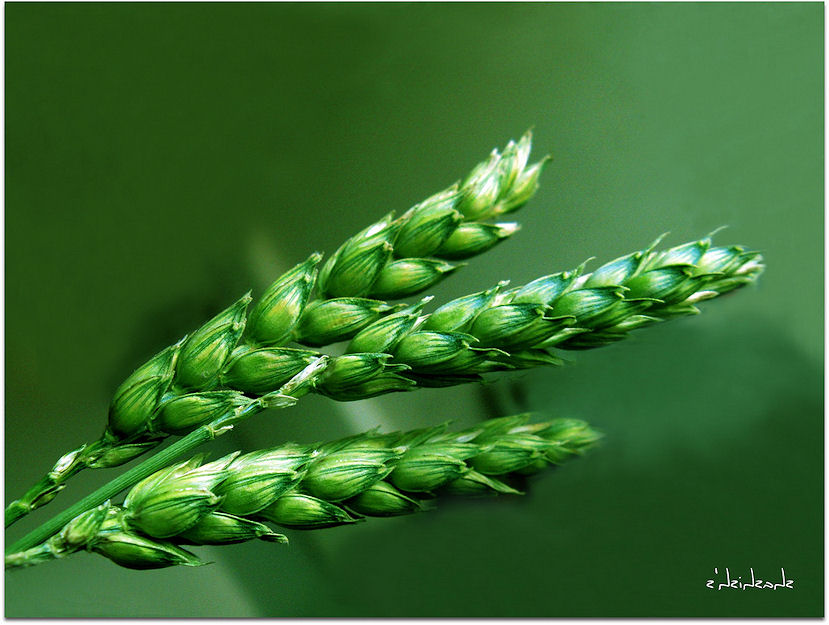
Abb.: सस्यमञ्जर्यः । Weizenähren, Nepal
[Bildquelle: Shashish. --
http://www.flickr.com/photos/shashish/3513581900/. -- Zugriff am 2011-07-02.
-- Creative Commons
Lizenz (Namensnennung, keine kommerzielle Nutzung, keine Bearbeitung)]
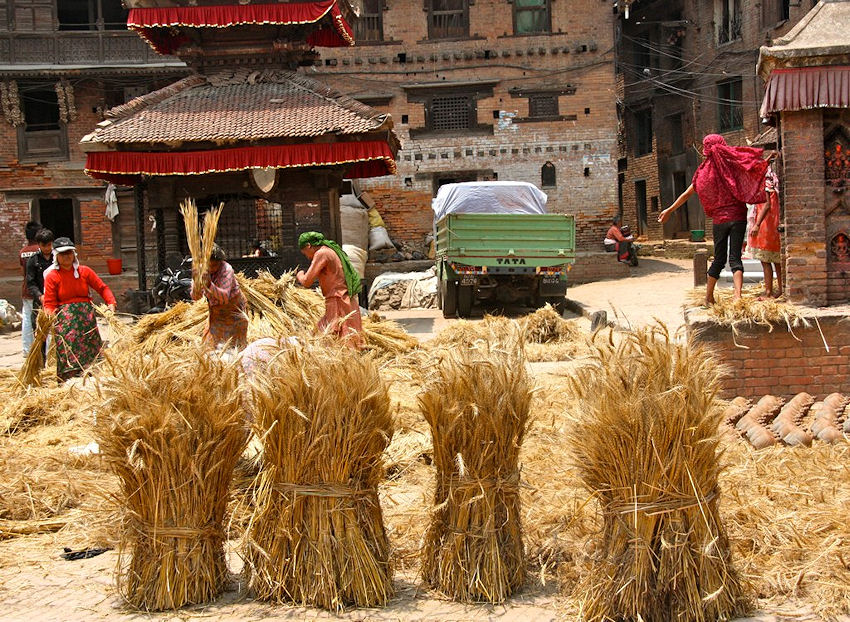
Abb.: सस्यमञ्जर्यः । Weizen-Dreschen, Bhaktapur -
भक्तपुर, Nepal
[Bildquelle: eatswords. --
http://www.flickr.com/photos/eatswords/5119666150/. -- Zugriff am
2011-07-02. --
Creative Commons Lizenz (Namensnennung, keine kommerzielle Nutzung, keine
Bearbeitung)]
| 21c./d. dhānyaṃ vrīhiḥ stambakariḥ stambo gucchas tṛṇādinaḥ धान्यं व्रीहिः स्तम्बकरिः स्तम्बो गुच्छस् तृणादिनः ।२१ ख। [Bezeichnungen für "Getreide":]
|
Colebrooke (1807): "Corn or rice."
"Das Getreide, des -s, plur. von mehrern Arten, ut nom. sing. ein allgemeiner Ausdruck derjenigen Samen grasartiger Pflanzen, welche zu Brot oder Mehlspeise taugen, und welche man in Niedersachsen Korn, und in andern Gegenden auch nur κατ' εξοχƞν die Frucht zu nennen pfleget." [Quelle: Adelung, Johann Christoph <1732 - 1806>: Grammatisch-kritisches Wörterbuch der Hochdeutschen Mundart. -- Leipzig, 1793 - 1801. -- s. v.]
Reis als das Getreide.
"The large group of the minor cereals, which may be designated "millets," together constitute a more important crop than either rice or wheat, and are grown more extensively, being raised from Madras in the South to Rajputana in the North. They occupy about 83 per cent, of the food-grain area in Bombay and Sind ; 41 per cent, in the Punjab ; 39 per cent, in the Central Provinces ; and 34 per cent, in the North-West Provinces.
The chief species are Great Millet, or joār (Sorghum vulgare [Sorghum bicolor (L.) Moench 1794]) ; spiked or bulrush millet, bajra (Pennisetum typhoideum [Pennisetum glaucum (L.) R. Br. 1810]) ; Ragi (Eleusine coracana) ; Italian millet (Setaria italica) ; and Chena (Panicum miliaceum).
Besides these, other kinds are cultivated, such as Panicum miliare [Panicum sumatrense Roth ex Roem. et Schult. 1817], and Paspalum scrobiculatum, while the grain of a few wild kinds is used in times of scarcity.
The following table shows the number of acres in 1882-83 under two of the chief species of millet (Joār and Bājra) in five Provinces from which the returns are fairly complete :
More recently, the total area under millets has been estimated at 33¼ million acres.
As a rule the millets are all Kharif, or autumnal harvest crops, being generally sown in the early weeks of the monsoon, and in June or July, and reaped in October and November.
Next in importance to the millets comes the group of the larger cereal grains. This includes wheat, rice, barley, and maize [erst nach der europäischen Entdeckung Amerikas]. The importance of the Indian wheats and of rice is discussed with some degree of fulness in the pages of the Handbook devoted to these cereals. While wheat approaches in composition that of a standard food, rice is very far from doing so, both in regard to albuminoids and mineral matters. Much more pulse for example, must be introduced into a rice diet than into one of wheat or into one of millet, in order that the chemical proportions of the several nutrients required for a perfect food may be reached.
The chief methods of preparing or cooking the cereal grains for the food of man are mentioned under the heads of the several kinds to which they more particularly apply. (See, for example, under Rice, p. 73, Maize, p. 66, Bulrush-millet, p. 59.)
The following table shows the number of acres, in 1882-83, under the two chief larger cereals, namely wheat and rice, in five Provinces where both crops are important and whence fairly complete returns have been obtained :
As a general rule wheat and barley are Rabi, or winter harvest crops, being sown at the end of the monsoon and reaped between January and March."
[Quelle: Church, A. H. (Arthur Herbert) <1834-1915>: Food-grains of India. -- London, 1886. -- S. 34ff.]
Der Bhāvaprakāśa behandelt im Dhānya-varga folgende dhānya (Feldfrüchte):
| 21c./d. dhānyaṃ vrīhiḥ stambakariḥ stambo gucchas tṛṇādinaḥ धान्यं व्रीहिः स्तम्बकरिः स्तम्बो गुच्छस् तृणादिनः ।२१ ख। Gras (तृण - tṛṇa n.) u. ä. hat
|
Colebrooke (1807): "Clump of grass, &c."
स्तम्ब - stamba m.: Büschel
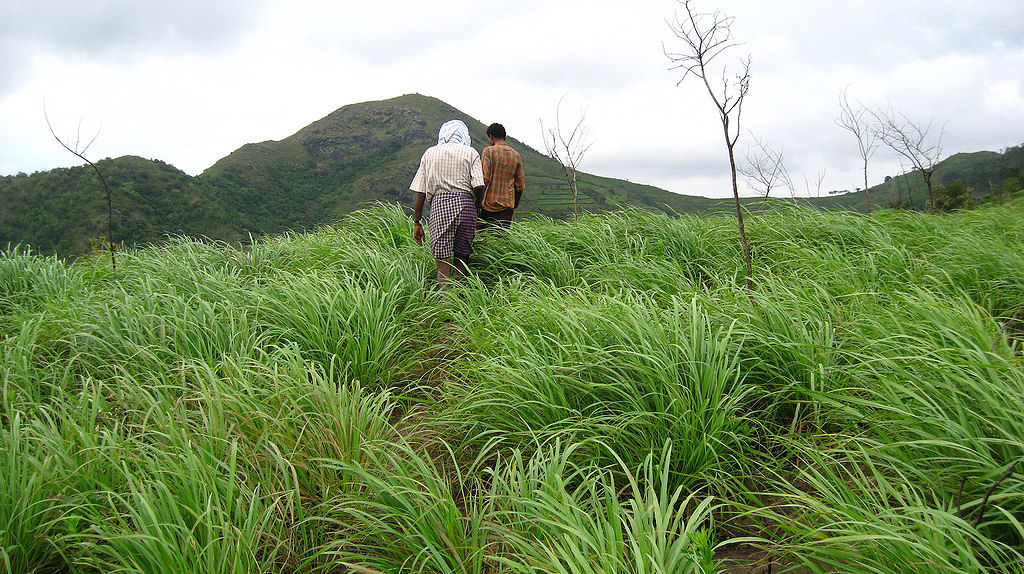
Abb.: स्तम्बाः । Kerala
[Bildquelle: spirenas. --
http://www.flickr.com/photos/30574552@N03/2946969266/. -- Zugriff am
2011-07-04. --
Creative
Commons Lizenz (Namensnennung, keine kommerzielle Nutzung, share alike)]
गुच्छ - guccha m.: Strauß, Bündel, Büschel
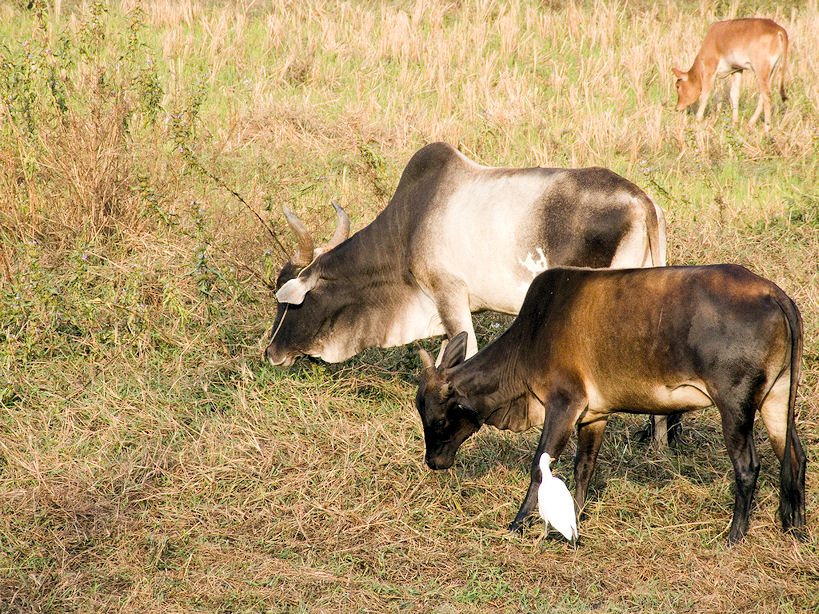
Abb.: गुच्छाः । Goa
[Bildquelle: Victoria Bensley. --
http://www.flickr.com/photos/veebl/2322207874/. -- Zugriff am
2011-07-04. --
Creative Commons Lizenz (Namensnennung, keine kommerzielle Nutzung, keine
Bearbeitung)]
| 22a./b. nāḍī nālaṃ ca kāṇḍo 'sya
palālo
'strī sa niṣphalaḥ नाडी नालं च काण्डो ऽस्य पलालो ऽस्त्री स निष्फलः ।२२ क। [Bezeichnungen für Stängel, Halm:]
|
Colebrooke (1807): "Stalk or culm."
नाडी - nāḍī f.: Röhre
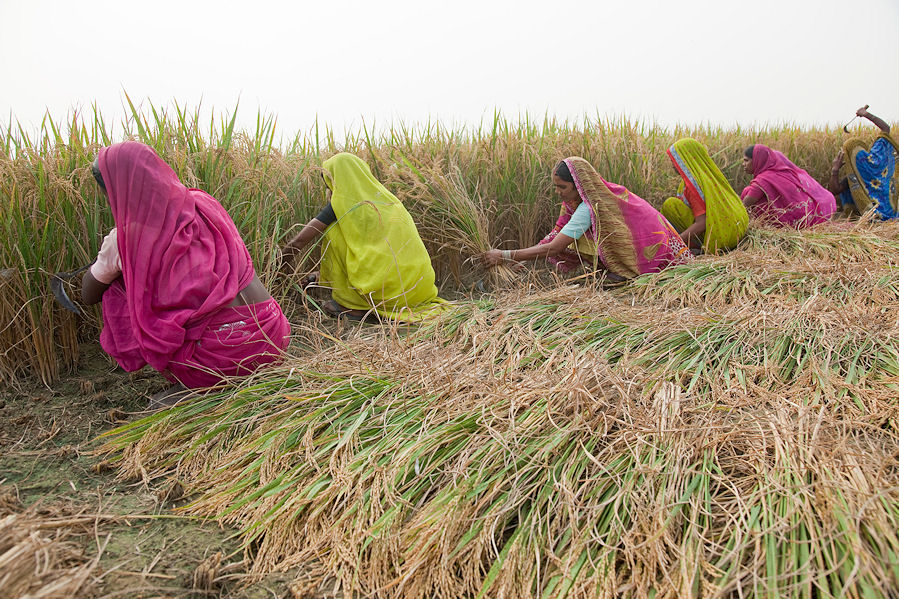
Abb.: नाड्यः । Reisernte Mahrajganj District - महाराजगंज जिला, Uttar Pradesh
[Bildquelle: Gates Foundation. --
http://www.flickr.com/photos/gatesfoundation/5558982792/. -- Zugriff am
2011-07-04. --
Creative Commons Lizenz (Namensnennung, keine kommerzielle Nutzung, keine
Bearbeitung)]

Abb.: नाड्यौ । Mumbai - मुंबई, Maharashtra
[Bildquelle: Pedro Varela. --
http://www.flickr.com/photos/rucativava/100388336/. -- Zugriff am
2011-07-04. -- Creative
Commons Lizenz (Namensnennung, keine kommerzielle Nutzung)]
नाल - nāla n.: Schilfröhre, Röhre, Stängel, Stiel

Abb.: नालानि । Hampi - ಹಂಪೆ,
Karnataka
[Bildquelle: Andrea Kirkby. --
http://www.flickr.com/photos/andreakirkby/5428407430/. -- Zugriff am
2011-07-04. --
Creative Commons Lizenz (Namensnennung, keine kommerzielle Nutzung)]
काण्ड - kāṇḍa m.: Abschnitt, Halm, Stängel
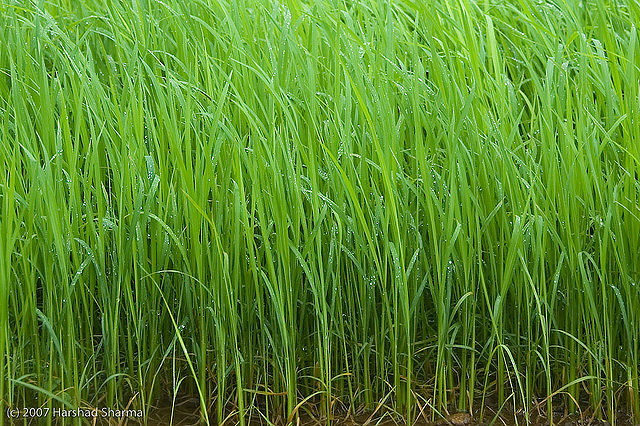
Abb.: काण्डाः । Reis, Pune - पुणे,
Maharashtra
[Bildquelle: Harshad Sharma. --
http://www.flickr.com/photos/harshadsharma/739932705/. -- Zugriff am
2011-07-04. --
Creative Commons Lizenz (Namensnennung, keine kommerzielle Nutzung)]
| 22a./b. nāḍī nālaṃ ca kāṇḍo 'sya palālo
'strī sa niṣphalaḥ नाडी नालं च काण्डो ऽस्य पलालो ऽस्त्री स निष्फलः ।२२ क। Ein Halm, von dem die Frucht entfernt wurde, heißt पलाल - palāla m.: Strohhalm, Stroh |
Colebrooke (1807): "Straw."
पलाल - palāla m.: Strohhalm, Stroh
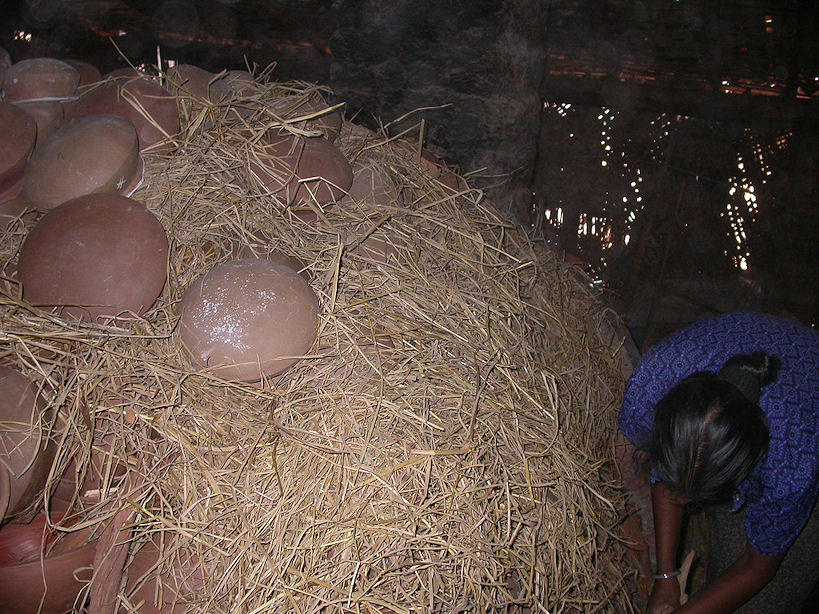
Abb.: पलालाः । Stroh als Brennmaterial für Töpferofen, Goa
[Bildquelle: Makwa. --
http://www.flickr.com/photos/makwa/180599544/. -- Zugriff am 2011-07-04. --
Creative Commons
Lizenz (Namensnennung, keine kommerzielle Nutzung, keine Bearbeitung)]
| 22c./d. kaḍaṅgaro busaṃ klībe dhānya-tvaci pumāṃs tuṣaḥ कडङ्गरो बुसं क्लीबे धान्य-त्वचि पुमांस् तुषः ।२२ ख। [Bezeichnungen für Spreu:]
|
Colebrooke (1807): "Chaff."
"Spreu, auch Kaff genannt, sind die beim Dreschen von Getreide abfallenden Spelzen und Hülsen, Grannen, Samenhüllen und Stengelteile." [Quelle: http://de.wikipedia.org/wiki/Spreu. -- Zugriff am 2011-07-04]
"Die Spreu, plur. car. ein Collectivum, die ausgedroschenen und zerschlagenen Hülsen des Getreides und der Feldfrüchte zu bezeichnen, welche durch das Worfeln von den guten Körnern abgesondert werden, und bei dem Getreide zugleich mit den zerschlagenen Grannen oder Agen vermischet sind. Weizenspreu, Rockenspreu, Haberspreu, Gerstenspreu, Erbsenspreu, (worunter man die leeren Schalen der ausgedroschenen Erbsen verstehet), Hirsenspreu, Leinspreu, Hausspreu, u.s.f. " [Quelle: Adelung, Johann Christoph <1732 - 1806>: Grammatisch-kritisches Wörterbuch der Hochdeutschen Mundart. -- Leipzig, 1793 - 1801. -- s. v.]
कडङ्गर - kaḍaṅgara m.: Spreu
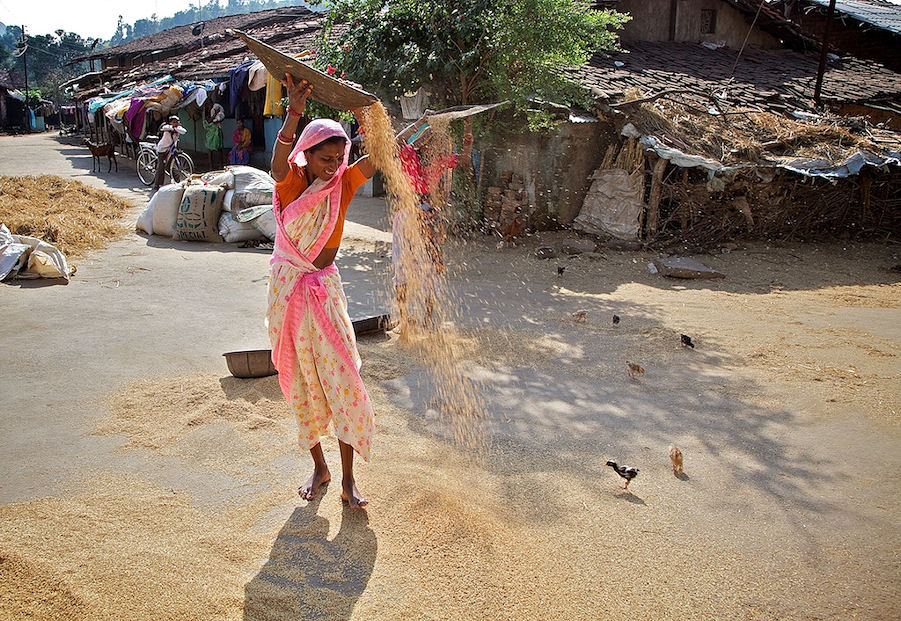
Abb.: कदङ्गरः । Worfeln, um den Reis (bleibt im Korb) vom Spreu (am Boden) zu
trennen, Nasik - नाशिक,
Maharashtra
[Bildquelle: Michael Foley. --
http://www.flickr.com/photos/michaelfoleyphotography/5267548312/. -- Zugriff
am 2011-07-04. --
Creative Commons Lizenz (Namensnennung, keine kommerzielle Nutzung, keine
Bearbeitung)]
"Beim Worfeln werden die gedroschenen Ähren mit flachen Korbschalen in die Luft geworfen. Das Verhältnis von Luftwiderstand zu Schwerkraft ist für die Getreidekörner erheblich kleiner als für die Spelzen und die Spreu. Seitlich wehender Wind trägt daher Spreu und Spelzen davon und nur das Korn fällt zurück auf den Korb." [Quelle: http://de.wikipedia.org/wiki/Worfeln. -- Zugriff am 2011-07-04]
बुस - busa n.: Abfall, Spreu, Dunst, Nebel
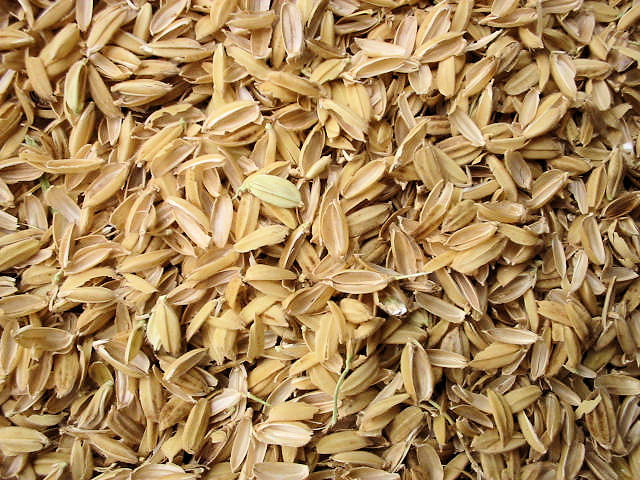
Abb.: बुसम् । Reis-Spreu
[Bildquelle: Green / Wikipedia. -- GNU FDLicense]
| 22c./d. kaḍaṅgaro busaṃ klībe dhānya-tvaci pumāṃs tuṣaḥ कडाङ्गरो बुसं क्लीबे धान्य-त्वचि पुमांस् तुषः ।२२ ख। Die Haut von Getreidekörnern heißt तुष - tuṣa m.: Hülse des Getreides, Spelze |
Colebrooke (1807): "Husk of rice or corn."
"Die Spêlze, plur. die -en, ein Wort, welches eigentlich eine Spitze, und besonders ein durch das Spalten entstandenes spitziges Ding bedeutet, aber nur in einem eingeschränkten Verstande üblich ist, da die durch das Dreschen gespaltenen spitzigen Hülsen der Getreidefrüchte, welche einen Teil der Spreu ausmachen, Spelzen oder Spalzen genannt werden, worunter man zuweilen auch wohl die im Dreschen zerschlagenen Grannen oder Acheln der Ähren verstehet. In der Botanik hingegen sind die Spelzen die zwei kleinen spitzigen Blätter, welche die innere Blumendecke, Corolla, der Blumen ausmachen, und woran be1 den Grasarten gemeiniglich die Grannen befestiget sind."
[Quelle: Adelung, Johann Christoph <1732 - 1806>: Grammatisch-kritisches Wörterbuch der Hochdeutschen Mundart. -- Leipzig, 1793 - 1801. -- s. v.]
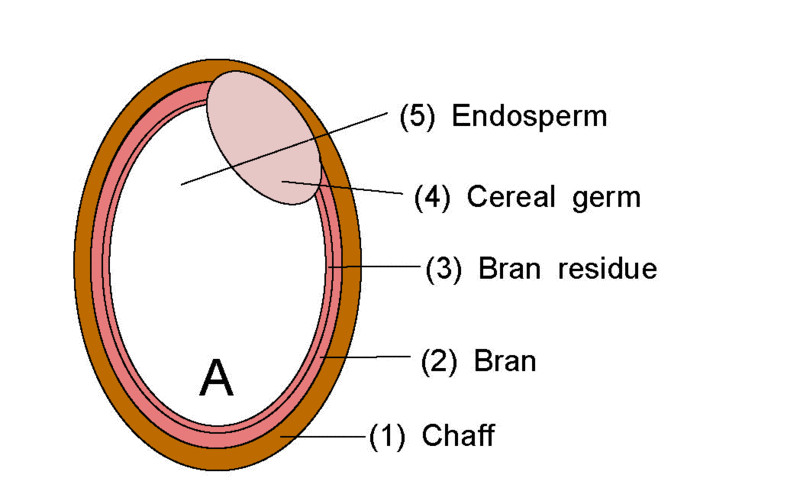
Abb.: Aufbau eines Reiskorns
(तुष = Chaff)
[Quelle des animated gif: Namazu-tron / Wikipedia. -- Public domain]
तुष - tuṣa m.: Hülse des Getreides, Spelze
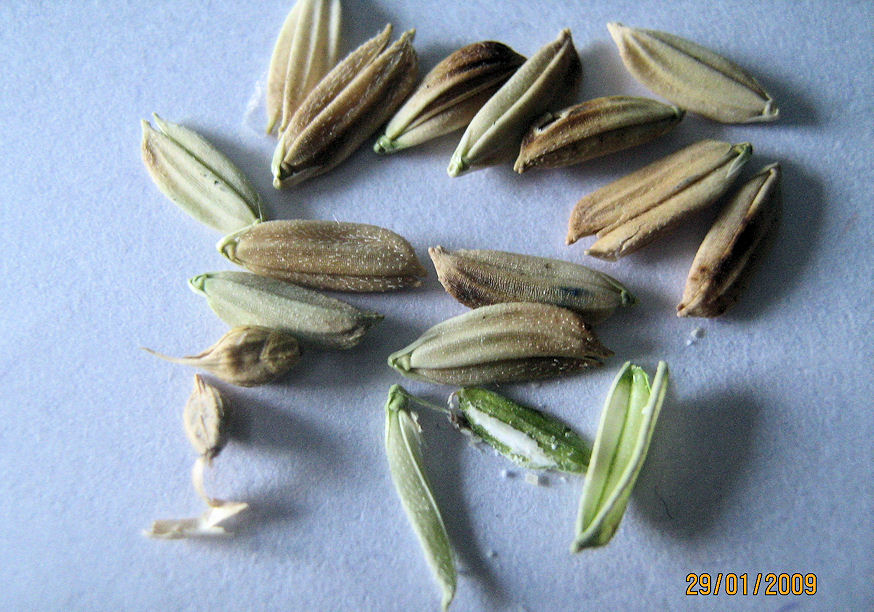
Abb.: तुषः । Reis-Spelzen, Tamil Nadu
[Bildquelle: த*உழவன் / Wikimedia. -- GNU FDLicense]
| 23a./b. śūko 'strī ślakṣṇa-tīkṣṇāgre
śamī śimbā triṣūttare शूको ऽस्त्री श्लक्ष्ण-तीक्ष्णाग्रे शमी शिम्बा त्रिसूत्तरे ।२३ क। Die weiche (biegsame), scharfe Spitze heißt शूक - śūka m., n.: Granne |
Colebrooke (1807): "An awn."
Siehe oben zu Vers 21a.
"Die Granne, plur. die -n, im gemeinen Leben Ober- und Niederdeutschlandes, eine Benennung einer jeden zarten biegsamen Spitze, dergleichen die langen scharfen Spitzen an den Fruchtähren, besonders an den Gerstenähren, welche in andern Gegenden Acheln und Gracheln heißen, (S. Agen,) die steifen Haare auf dem Rücken der Schweine, die Borsten, ingleichen die steifen Haare welche die Katzen und andere Thiere an dem Maule haben, die Tangeln oder Nadeln des Tangelholzes u.s.f. sind." [Quelle: Adelung, Johann Christoph <1732 - 1806>: Grammatisch-kritisches Wörterbuch der Hochdeutschen Mundart. -- Leipzig, 1793 - 1801. -- s. v.]
| 23a./b. śūko 'strī ślakṣṇa-tīkṣṇāgre śamī śimbā
triṣūttare शूको ऽस्त्री श्लक्ष्ण-तीक्ष्णाग्रे शमी शिम्बा त्रिसूत्तरे ।२३ क। [Bezeichnungen für Hülse ("Schote"):]
|
Colebrooke (1807): "A legume or pod."
"Die Hülse sieht oberflächlich der Schote ähnlich. Umgangssprachlich - und im botanischen Sinne falsch - werden deshalb oft die Hülsen von Bohnen, Erbsen und weiteren Hülsenfrüchtlern „Schoten“ genannt." [Quelle: http://de.wikipedia.org/wiki/H%C3%BClsenfrucht. -- Zugriff am 2011-07-05]
"Die Hülse [...] Diejenigen Samenbehältnisse mancher Pflanzen, welche aus zwei länglichen vermittelst zweier Nähte an einander gesetzten Stücken bestehen, in welchen der Same befestiget ist, werden Hülsen oder Schoten, diejenigen Gewächse, welche solche tragen, Hülsengewächse, und der Same Hülsenfrucht genannt. In engerer Bedeutung führen, besonders in der Naturgeschichte, nur diejenigen Samenbehältnisse dieser Art den Nahmen der Hülsen, wo der Same nur allein an der Obernaht befestiget ist, Legumen; zum Unterschiede von den Schoten, in welchen der Same wechselsweise von einer Naht zur andern sitzet, Siliqua. So haben der Hauhechel, die Feigbohne, die Türkische Bohne, die Erbsen, die Linsen, die Wicken, die Kichern, der Klee u.s.f. in engerer Bedeutung Hülsen, die Kresse aber, der Hederich, die Levkoje, der Kohl, der Senf, der Rettig, der Waid u.s.f. Schoten. " [Quelle: Adelung, Johann Christoph <1732 - 1806>: Grammatisch-kritisches Wörterbuch der Hochdeutschen Mundart. -- Leipzig, 1793 - 1801. -- s. v.]
शमी - śamī f.: Prosopis cineraria (L.) Druce 1914 - Schraubenbohne - Mesquite
Fabaceae
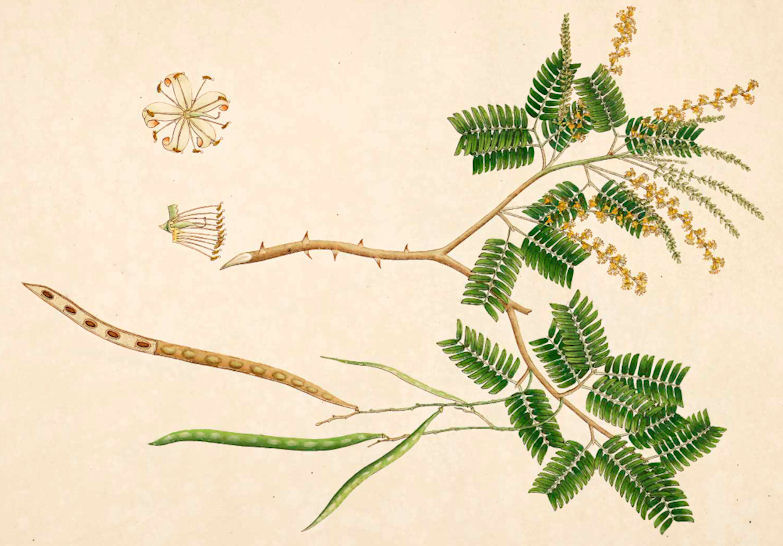
Abb.: शमी । Prosopis cineraria (L.) Druce 1914 - Schraubenbohne -
Mesquite (Roxburg: Prosopis spicigera)
[Bildquelle: Roxburgh. -- Vol I. -- 1795. -- Image courtesy Missouri Botanical
Garden. http://www.botanicus.org. --
Creative Commons Lizenz
(Namensnennung, keine kommerzielle Nutzung)]
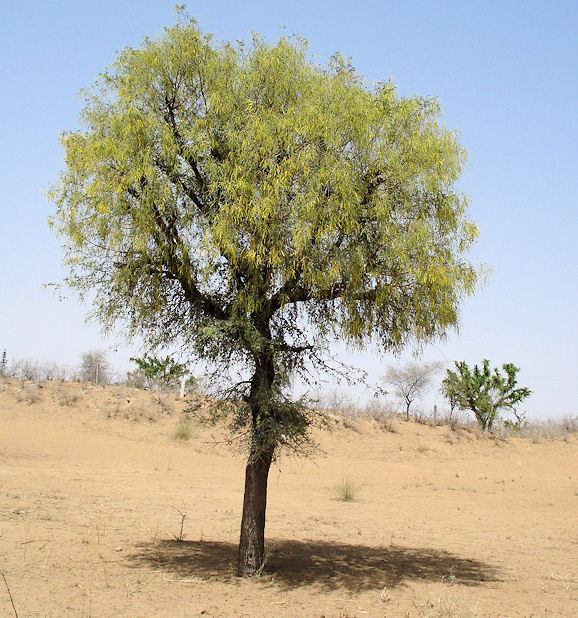
Abb.: शमी ।
Prosopis cineraria (L.) Druce 1914 -
Schraubenbohne, Indien
[Bildquelle: LRBurdak / Wikipedia. -- GNU FDLicense]
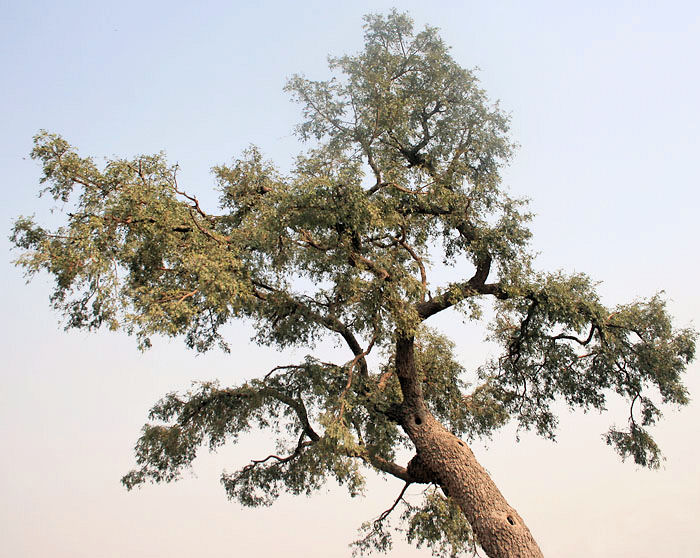
Abb.: शमी ।
Prosopis cineraria (L.) Druce 1914 -
Schraubenbohne - Mesquite, Hodal - होडाल, Haryana
[Bildquelle: J. M. Garg / Wikipedia. -- GNU FDLicense]
"Prosopis spicigera (Linn.) N. O. Leguminosaei. [...]
Description.—Somewhat arboreous, armed with scattered prickles, occasionally wanting ; [...9 flowers small, yellow.
Fl. Dec.—Feb.
W. & A. Prod. i. 271.— Roxb. Cor. i. t. 63.
Adenanthera aculeata.—Roxb.
Coromandel. Guzerat. Delhi.
Economic Uses.—In Mysore this tree attains a large size. The timber is strong, hard, straight-grained, and easily worked. The pods contain a great quantity of mealy sweetish substance, which the natives eat.—(Roxb. Jury Rep. Mad. Exhib.) It is common throughout the Madras Presidency. The timber is dark red, close-grained, hard, and durable, superior to teak in strength, and is much used for building and other purposes. It is of very slow growth.— Bedd. Flor. Sylv. t. 56."
[Quelle: Drury, Heber <1819 - 1872>: The useful plants of India : with notices of their chief value in commerce, medicine, and the arts. -- 2d ed. with additions and corrections. London : Allen, 1873. -- xvi, 512 p. ; 22 cm. -- s.v.]
शमी - śamī f.: Hülsenfrucht
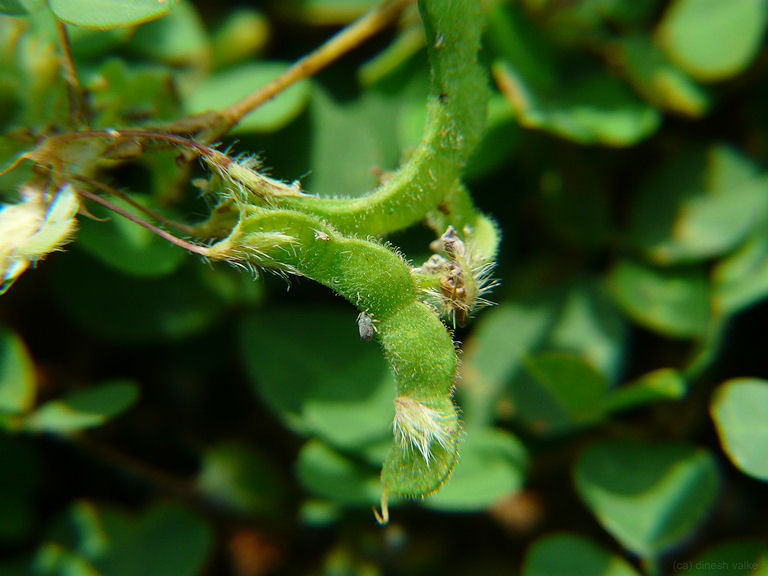
Abb.: शम्यः । Hülsenfrüchte von Desmodium triflorum (L.) DC. 1825,
Karnala Bird Sanctuary, Maharashtra
[Bildquelle: dinesh_valke. --
http://www.flickr.com/photos/dinesh_valke/2978131855/. -- Zugriff am
2011-07-05. --
Creative
Commons Lizenz (Namensnennung, keine kommerzielle Nutzung, share alike)]
शिम्बा - śimbā f.: Hülse ("Schote")
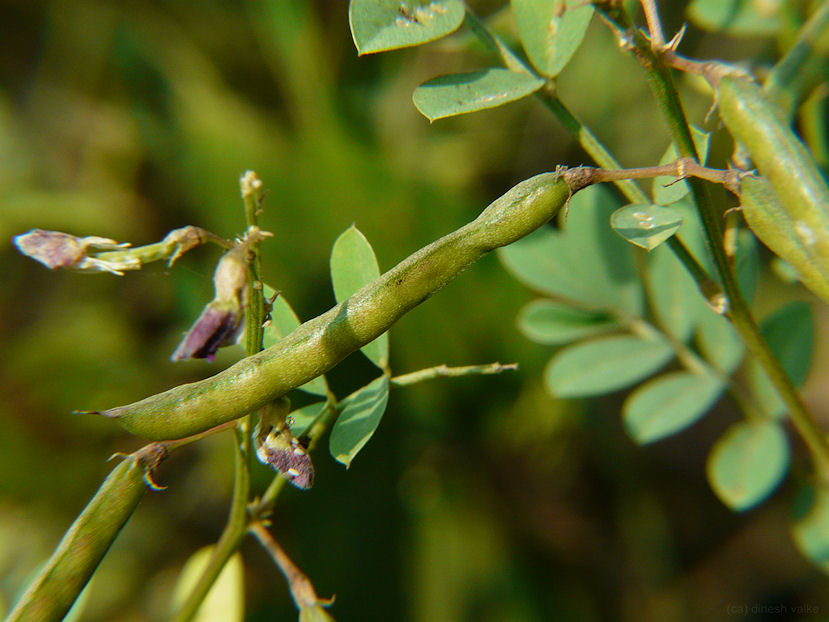
Abb.: शिम्बाः । Tephrosia purpurea (L.) Pers. 1806 (Fabaceae) -
Surinam-Giftbaum - Wild Indigo, Vagbhil
[Bildquelle: dinesh_valke. --
http://www.flickr.com/photos/dinesh_valke/2958580796/. -- Zugriff am
2011-07-05. --
Creative
Commons Lizenz (Namensnennung, keine kommerzielle Nutzung, share alike)]
| 23a./b. śūko 'strī ślakṣṇa-tīkṣṇāgre śamī śimbā triṣūttare शूको ऽस्त्री श्लक्ष्ण-तीक्ष्णाग्रे शमी शिम्बा त्रिसूत्तरे ।२३ क। Die folgenden Wörter haben die drei grammatischen Geschlechter (sind Adjektive). |
Colebrooke (1807): "The following admit the three genders."
| 23c./d. ṛddham āvasitaṃ dhānyaṃ
pūtaṃ tu bahulīkṛtam ऋद्धम् आवसितं धान्यं पूतं तु बहुलीकृतम् ।२३ ख। [Bezeichnungen für] "Getreide" [, das gespeichert ist]:
|
Colebrooke (1807): "Stored as grain. After cleaning it, some say before."
ऋद्ध - ṛddha 3: gediehen, eingebracht, aufgehäuft
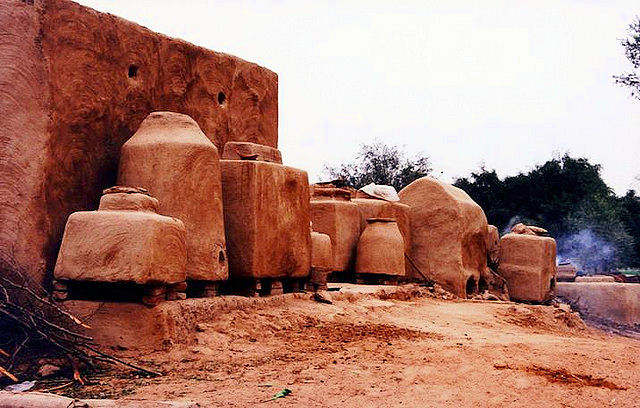
Abb.: ऋद्धं धान्यम् । Getreidespeicher, Cholistan-Wüste (صحرائے
چولستان), Pakistan
[Bildquelle: arsalank2. --
http://www.flickr.com/photos/arsalank2/2706671534/. -- Zugriff am
2011-07-05. --
Creative Commons Lizenz (Namensnennung, keine kommerzielle Nutzung, keine
Bearbeitung)]
आवसित - āvasita 3: wohnhaft, gelagert, gespeichert, aufgehäuft
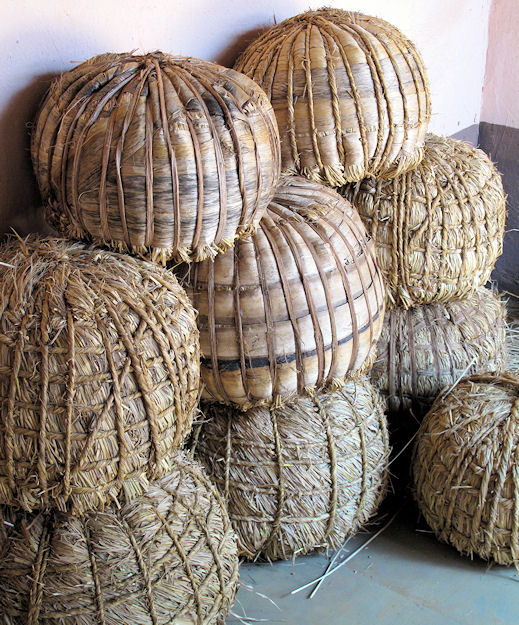
Abb.: आवसितं धान्यम् । Körbe zur Speicherung von Reis, Belthangady - ಬೆಳ್ತಂಗಡಿ,
Karnataka
[Bildquelle: Abdulla Al Muhairi. --
http://www.flickr.com/photos/serdal/4581356042/. -- Zugriff am 2011-07-05.
-- Creative Commons Lizenz
(Namensnennung)]
| 23c./d. ṛddham āvasitaṃ dhānyaṃ pūtaṃ tu bahulīkṛtam ऋद्धम् आवसितं धान्यं पूतं तु बहुलीकृतम् ।२३ ख। [Bezeichnungen für von der Spreu gereinigt, gedroschen und geworfelt:]
|
Colebrooke (1807): "Threshed out and winnowed."
"Drếschen, verb. irreg. act. ich drésche, du dríschest, er dríschet, oder dríscht; Imperf. ich drósch, an einigen Orten, ich drāsch; Mittelw. gedróschen; Imperat. drísch; die Körner der Feldfrüchte vermittelst des Flegels aus den Ähren schlagen." [Quelle: Adelung, Johann Christoph <1732 - 1806>: Grammatisch-kritisches Wörterbuch der Hochdeutschen Mundart. -- Leipzig, 1793 - 1801. -- s. v.]
"Worfeln, verb. regul. act. in der Landwirthschaft, das Getreide durch Werfen gegen den Wind von der Spreu reinigen." [Quelle: Adelung, Johann Christoph <1732 - 1806>: Grammatisch-kritisches Wörterbuch der Hochdeutschen Mundart. -- Leipzig, 1793 - 1801. -- s. v.]
पूत - pūta 3: gereinigt, von der Spreu gereinigt, geworfelt
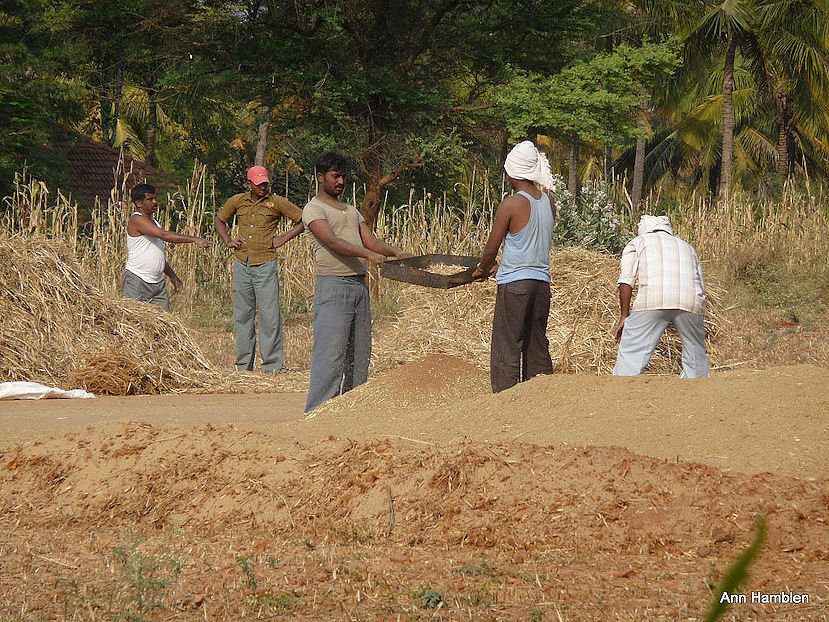
Abb.: पूतनम् । Worfeln oder Sieben von Ragi - रागी (Eleusine coracana (L.)
Gaertn. 1788 - Fingerhirse - Caracan Millet), Silvepura, Karnataka
[Bildquelle: Wendy North. --
http://www.flickr.com/photos/primarygeography/3356387467/. -- Zugriff am
2011-07-05. --
Creative Commons Lizenz (Namensnennung, keine kommerzielle Nutzung, keine
Bearbeitung)]
बहुलीकृत - bahulīkṛta 3: zu vielen (Körnern) gemacht, gedroschen
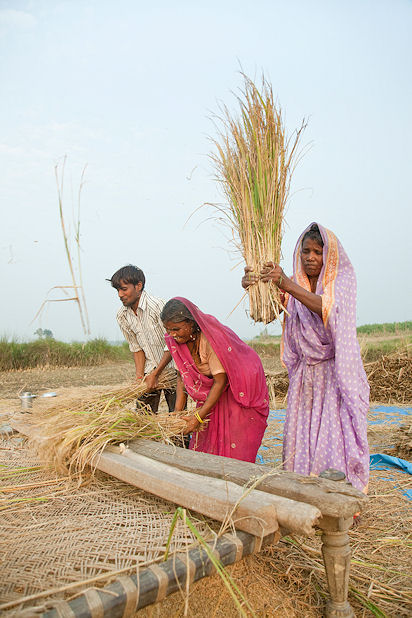
Abb.: बहुलीक्रिया । Dreschen von Reis, Mahrajganj District -
महाराजगंज जिला, Uttar Pradesh
[Bildquelle: Gates Foundation. --
http://www.flickr.com/photos/gatesfoundation/5558983950/. -- Zugriff am
2011-07-05. --
Creative Commons Lizenz (Namensnennung, keine kommerzielle Nutzung,
keine Bearbeitung)]
Vorwiegend Fabaceae - Hülsenfrüchtler
| 24a./b. māṣādayaḥ śamīdhānye śūkadhānye yavādayaḥ माषादयः शमीधान्ये शूकधान्ये यवादयः ।२४ क। शमीधान्य - śamīdhānya n.: Hülsenfrucht, heißen माष - māṣa m.: Vigna mungo (L.) Hepper 1956: Urdbohne u. ä. |
Colebrooke (1807): "Grain in pods. As peas and other pulse."
माष - māṣa m.: Vigna mungo (L.) Hepper 1956: Urdbohne
Fabaceae - Hülsenfrüchtler
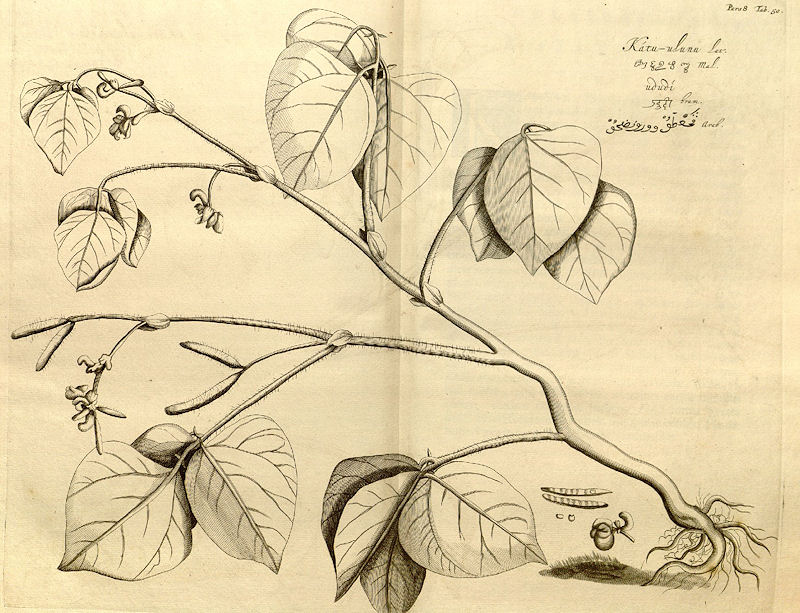
Abb.: माषः । Vigna mungo (L.) Hepper 1956: Urdbohne
[Bildquelle: Hortus malabaricus VIII. Fig. 50,
1688]
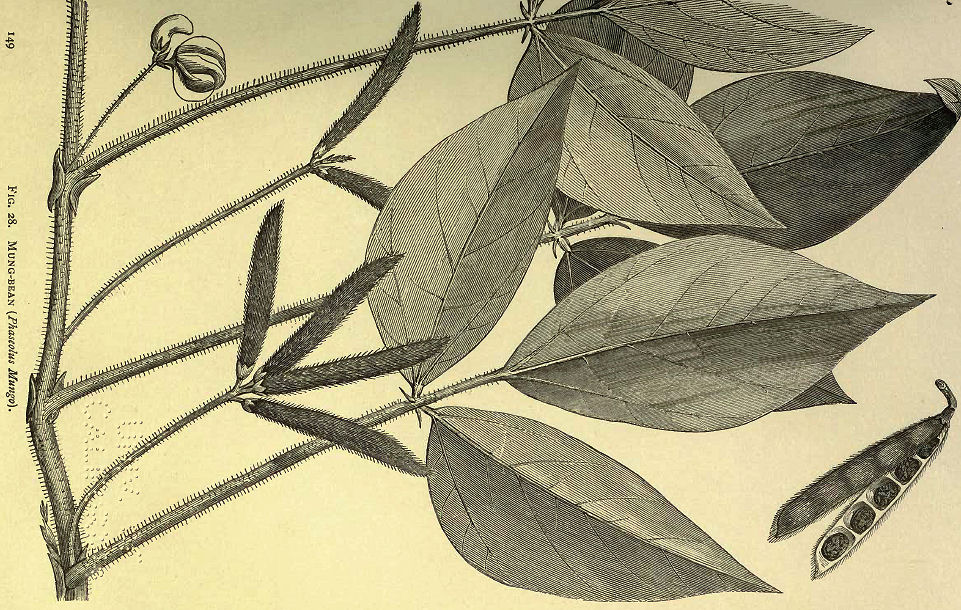
Abb.: माषः । Vigna mungo (L.) Hepper 1956: Urdbohne
[Bildquelle: Church, A. H. (Arthur Herbert) <1834-1915>:
Food-grains of India. -- London, 1886.]
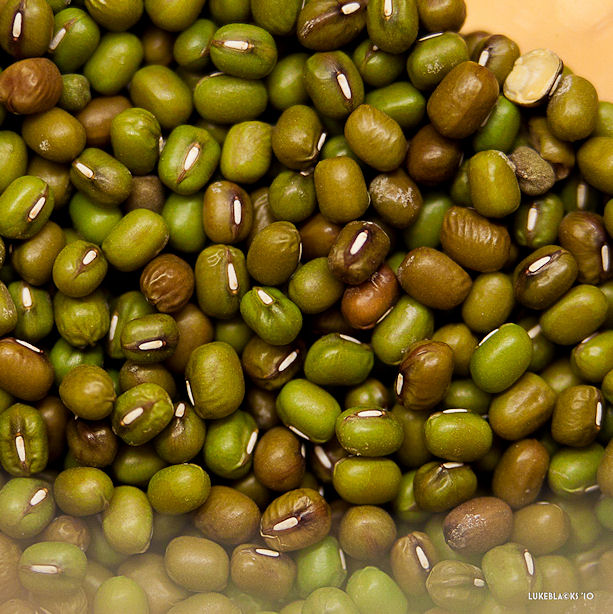
Abb.: माषाः । Vigna mungo (L.) Hepper 1956: Urdbohne
[Bildquelle: LukeBlacks. --
http://www.flickr.com/photos/lukeblacks/5211646722/. -- Zugriff am
2011-07-05. --
Creative Commons Lizenz (Namensnennung, keine kommerzielle Nutzung, keine
Bearbeitung)]
"Phaseolus Mungo (Linn.) N. O. Leguminosae. Green Gram,
[...9
Description.—Annual, [...]
Fl. Dec.—Jan.
W. & A. Prod. i. 245.—Roxb. Fl. Ind. iii 292.
P. Max.—Roxb. Fl. Ind. iii. 295.—Rheede, viii. t. 50.
Cultivated.
Economic Uses.—This is extensively cultivated by the natives, to whom the pulse is of great importance, especially in times of famine. There are several varieties, one of which has dark-coloured seeds, and is called Black gram. Large quantities are annually exported from Madras, and shipped chiefly for Pegu, Bengal, Bombay, Mauritius, and other places.—(Comm. Prod. Mad. Pres. Roxb.) It is sometimes sown in alternate drills with the great millet (Sorghum) or spiked millet, and in rice cultivation a crop is generally taken off the same land when it has become dry. It is sown in the cold weather, and reaped in the hot season, after a period varying from seventy-five to ninety days. So large a proportion of the pulse crops does it form that these are collectively called Payaroo, hence the word is synonymous with our pulse. The black variety, P. Max, (Roxb.), is less esteemed, and is sown earlier, requiring more moisture. The flour of the green variety is an excellent variety for soap, leaving the skin soft and smooth, and is an invariable concomitant of the Hindoo bath.—(W. Elliott.) The tuberous roots of the P. rostratus (Wall.) are eaten by the natives.—J. Graham."
[Quelle: Drury, Heber <1819 - 1872>: The useful plants of India : with notices of their chief value in commerce, medicine, and the arts. -- 2d ed. with additions and corrections. London : Allen, 1873. -- xvi, 512 p. ; 22 cm. -- s.v.]
शमीधान्य - śamīdhānya n.: Hülsenfrucht
Der Bhāvaprakāśa nennt folgende शिम्बिधान्य - śimbidhānya n.: Hülsenfrüchte:
Fabaceae - Hülsenfrüchtler
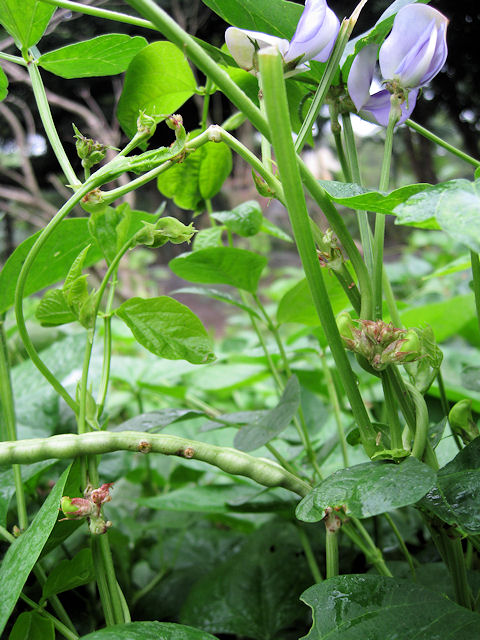
Abb.:
राजमाषः ।
Vigna unguiculata subsp.
cylindrica (L.) Verdc. 1970 - Katjangbohne - Catjang Bean
[BIldquelle: Nguyễn Thanh Quang / Wikimedia. -- GNU FDLicense]
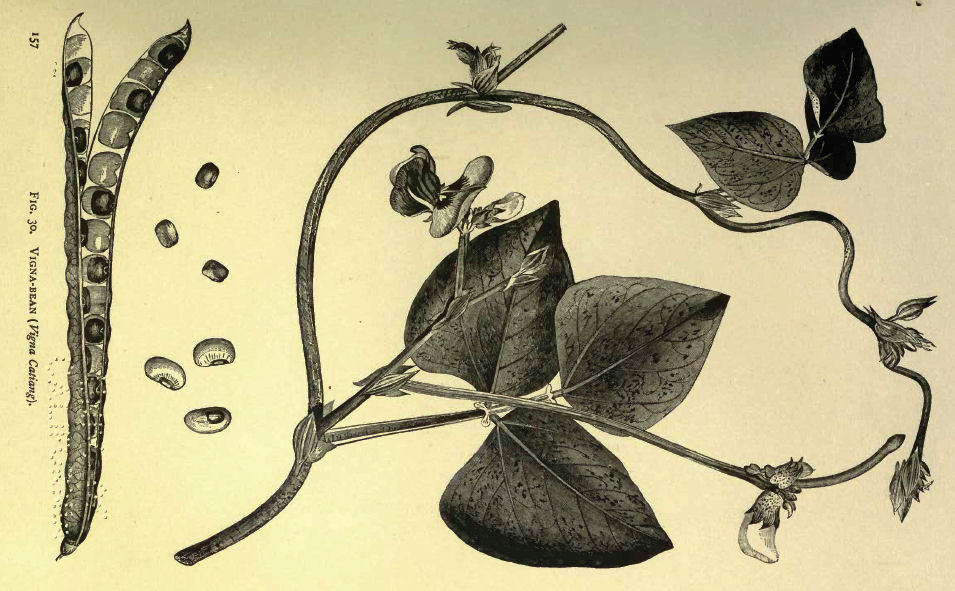
Abb.:
राजमाषः ।
Vigna unguiculata subsp.
cylindrica (L.) Verdc. 1970 - Katjangbohne - Catjang Bean
[Bildquelle: Church, A. H. (Arthur Herbert) <1834-1915>: Food-grains of
India. -- London, 1886.]
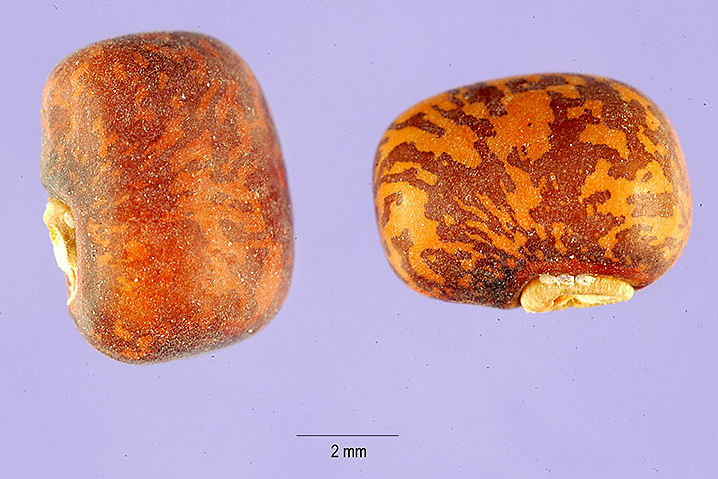
Abb.:
राजमाषौ । Samen von
Vigna unguiculata subsp.
cylindrica (L.) Verdc. 1970 - Katjangbohne - Catjang Bean
[Bildquelle: Tracey Slotta @ USDA-NRCS PLANTS Database. -- Public domain]
"Vigna Catiang (Endl.).
Synonyms Dolichos catiang (L.) ; D. sinensis (L.) ; D. melanophthalmus (D.C.).
[...]
Vigna is a genus of Euphaseoleae, a sub-tribe of Phaseoleae. V. Catiang includes many cultivated varieties, differing much in habit of growth as well as in the shape, size, and colour of the seed. The plant is sometimes low and sub-erect (typical V. Catiang), sometimes (var. sinensis) tall and voluble. The pods in the cultivated forms are under ½ inch broad, but may attain 1 foot up to 2 feet in length ; the pods contain from 10 to 20 seeds. It is a native plant, and is universally cultivated in the tropical zone. It flourishes in comparatively poor soils and sustains fairly well a considerable degree of drought. Vigna Catiang is sown in July and August, and reaped in October and November. The white-seeded sort is generally considered the best. It is often grown with other crops. An ounce weight corresponds to about 1 50 seeds.
[...]
They are thought to be rather heating and less digestible than urd or mung (Phaseolus Mungo). The green pods are sometimes cooked."
[Quelle: Church, A. H. (Arthur Herbert) <1834-1915>: Food-grains of India. -- London, 1886. -- S. 156.]
Fabaceae - Hülsenfrüchtler
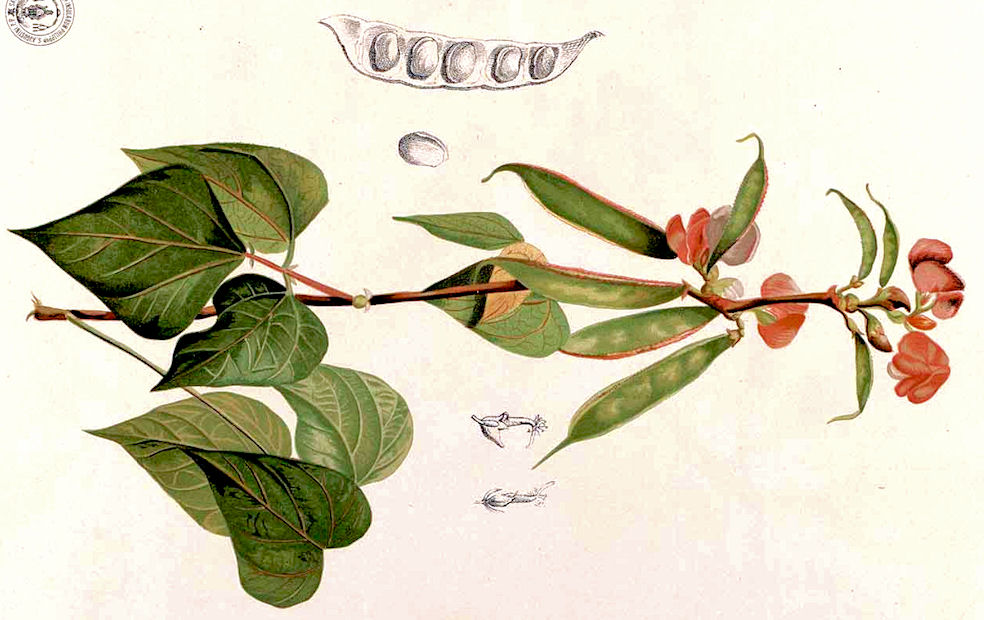
Abb.: निष्पावः । Lablab purpureus (L.) Sweet 1826 - Faselbohne -
Lablab Bean
[Bildquelle: Flora de Filipinas, 1880 / Wikimedia. -- Public domain]
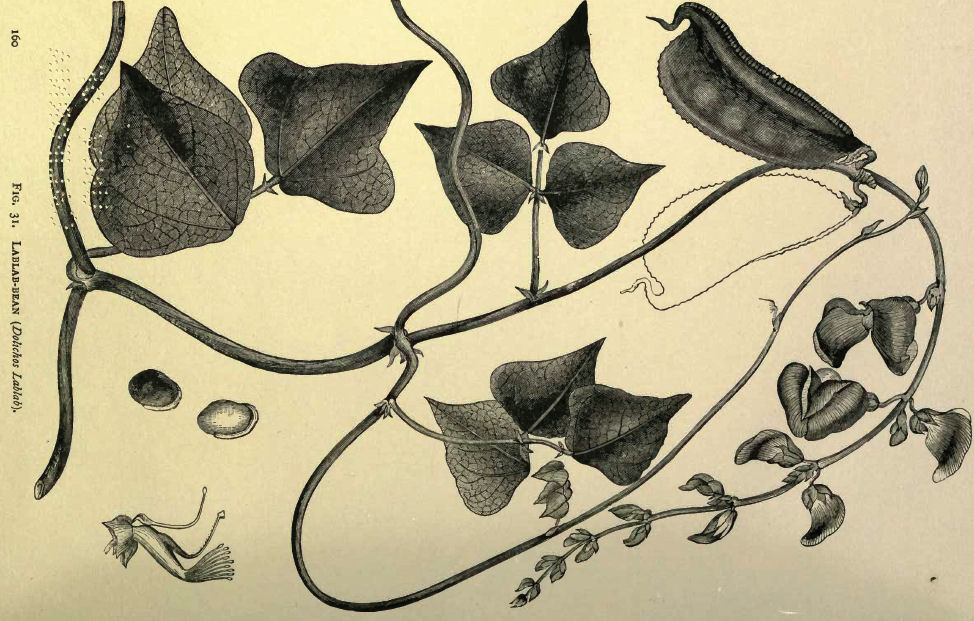
Abb.: निष्पावः । Lablab purpureus (L.) Sweet 1826 - Faselbohne -
Lablab Bean
[Bildquelle: Church, A. H. (Arthur Herbert) <1834-1915>: Food-grains of
India. -- London, 1886.]
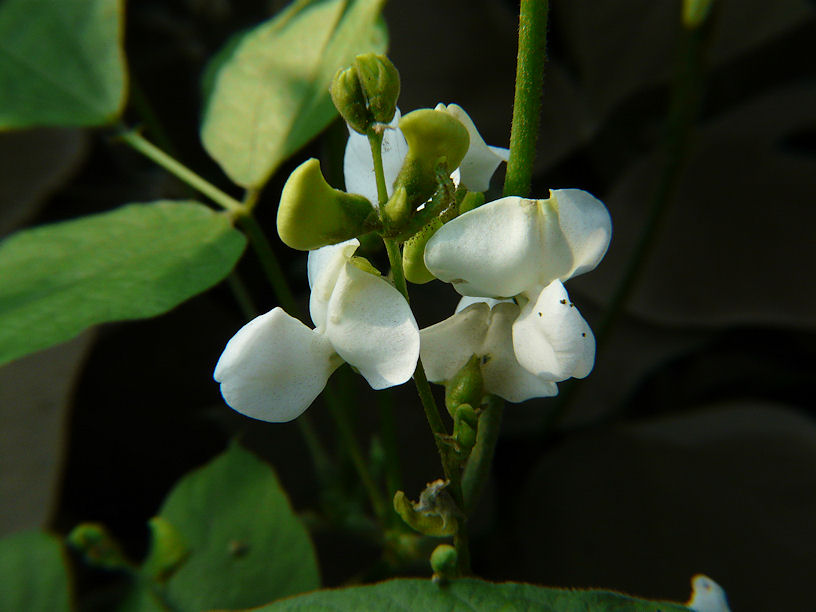
Abb.: निष्पावः । Lablab purpureus (L.) Sweet 1826 - Faselbohne -
Lablab Bean, Thane - ठाणे, Maharashtra
[Bildquelle: dinesh_valke. --
http://www.flickr.com/photos/dinesh_valke/3052519006/. -- Zugriff am
2011-07-05. --
Creative
Commons Lizenz (Namensnennung, keine kommerzielle Nutzung, share alike)]
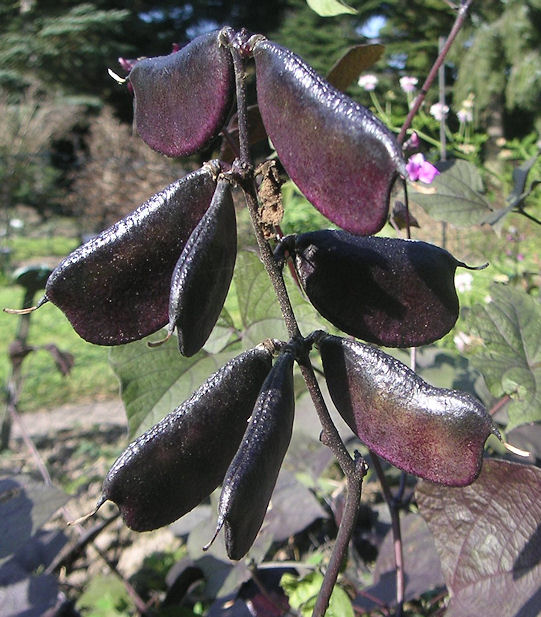
Abb.: निष्पावः । Lablab purpureus (L.) Sweet 1826 - Faselbohne -
Lablab Bean, Deutschland
[Bildquelle: Carstor / Wikimedia. -- GNU FDLicense]
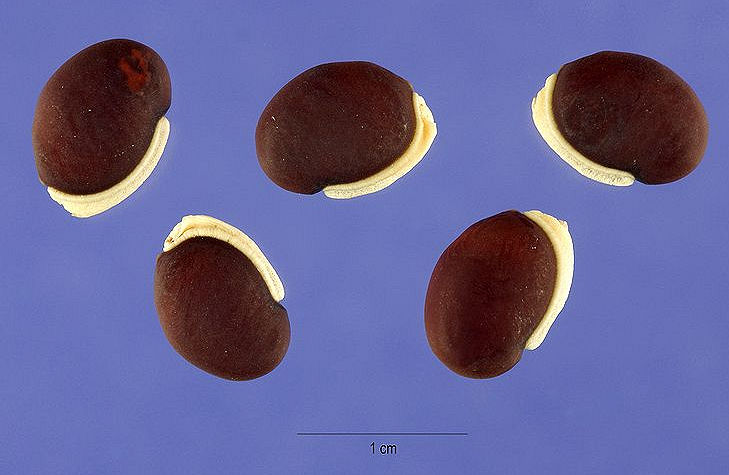
Abb.: निष्पावाः । Samen von Lablab purpureus (L.) Sweet 1826 - Faselbohne -
Lablab Bean
[Bildquelle: Steve Hurst @ USDA-NRCS PLANTS Database. -- Public domain]
"Lablab vulgaris (Savi.) N. O. Leguminosae. [...]
Description.—Twining; [...] flowers red, purple, or white.
Fl. Nov.—Feb.
W. & A. Prod. i. 250. Wight Icon. t. 57-203.—Roxb. Fl Ind. iii. 305.
Dolichos lablab, Linn.
Peninsula. Bengal Cultivated.
Economic Uses.—There are several varieties differing in the colour of their seeds and forms of their legumes, some of which are cultivated, and others are not. Of one variety which is cultivated on the Coromandel coast, Roxburgh states that it will yield in a good soil about forty-fold. The seeds bear a low price comparatively, and are much eaten by the poorer classes, particularly when rice is dear. They are not palatable, but are reckoned wholesome substantial food. Cattle are fed with the seeds, and greedily eat the straw. Another variety, which has white flowers, is cultivated in gardens and supported on poles, often forming arbours about the doors of native houses. The pods are eaten, but not the seeds. The pulse of the best kind is imported from Madras to Ceylon.—(Roxb.) The different kinds are distinguished by the colours of their flowers, which vary from white to red and purple, and by the size and shape of the pods, which exhibit every degree of curvature, one kind being designated as the Bagh-nak (tiger's claw), from its rounded form. The same diversity occurring in the seeds has given rise to the many specific varieties, or even species, which after all may well be reduced to the present form of Lablab.—W. Elliott."
[Quelle: Drury, Heber <1819 - 1872>: The useful plants of India : with notices of their chief value in commerce, medicine, and the arts. -- 2d ed. with additions and corrections. London : Allen, 1873. -- xvi, 512 p. ; 22 cm. -- s.v.]
Fabaceae - Hülsenfrüchtler
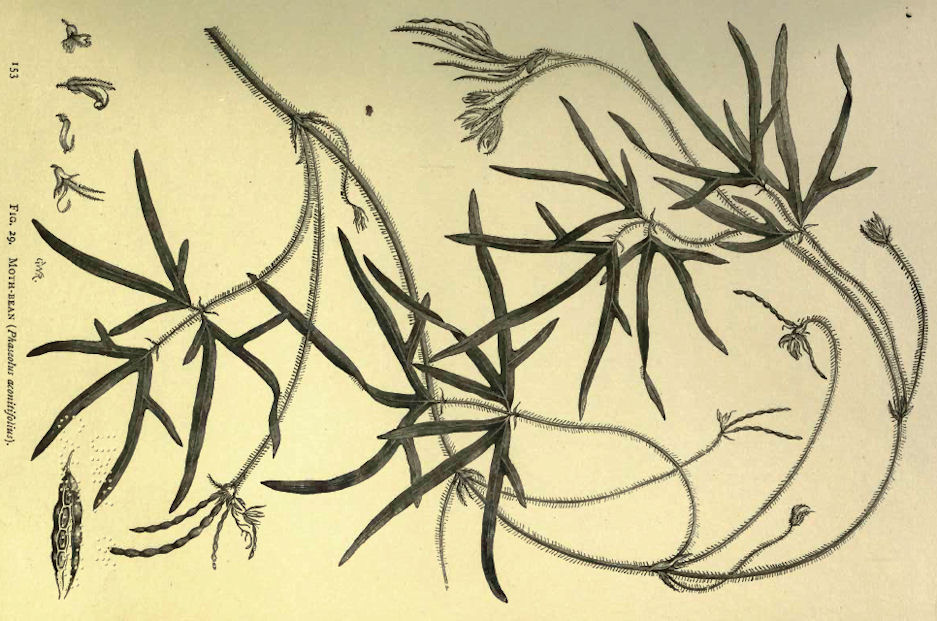
Abb.: मकुष्ठः । Vigna aconitifolia (Jacq.) Maréchal 1969 -
Mattenbohne - Moth Bean
[Bildquelle: Church, A. H. (Arthur Herbert) <1834-1915>: Food-grains of
India. -- London, 1886.]
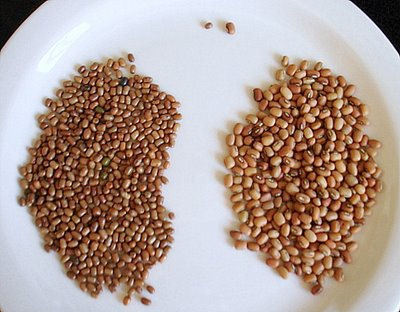
Abb.: मकुष्ठाः। Samen von Vigna aconitifolia (Jacq.) Maréchal 1969 -
Mattenbohne - Moth Bean
[Bildquelle: Lalitstar / Wikipedia. -- GNU FDLicense]
"THE MOTH- BEAN. Phaseolus aconitifolius, Jacq. Synonyms Ph. trilobus (Wall.), Dolichos dissectus (Lam.).
[...]
This bean is the produce of a trailing slender-stemmed herb belonging to the tribe Phaseoleae. It is found from the Himalaya to Ceylon, in the tropical region, and extends up to 4,000 feet in the North-West. It is cultivated in Oudh, Allahabad, Farruckabad, Patna District, Purniah District, Assam, Gorakhpur. The pods are stouter and the seeds larger than in the allied species, Ph. trilobus (Ait). It is often grown on the worst land which can be made to yield a crop at all. It is frequently sown with bajra, the bulrush millet, on light sandy soils. An average produce is 8 maunds from an acre. It is not esteemed as a food for man, for although it is rich in nutrients, it is generally thought to possess heating properties. It is a kharif crop, being sown in June, July, August, or September, and reaped in November, December, and January."
[Quelle: Church, A. H. (Arthur Herbert) <1834-1915>: Food-grains of India. -- London, 1886. -- S. 152.]
Fabaceae - Hülsenfrüchtler
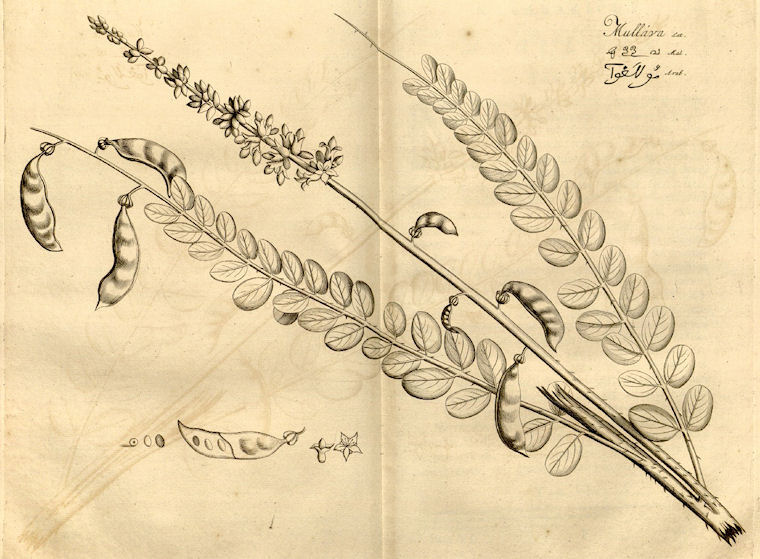
Abb.: आढकी । Cajanus cajan (L.) Millsp. 1900 - Katjangstrauch /
Taubenerbsenbaum - Catjang Pea
[Bildquelle: Hortus malabaricus VI. Fig. 13, 1686]
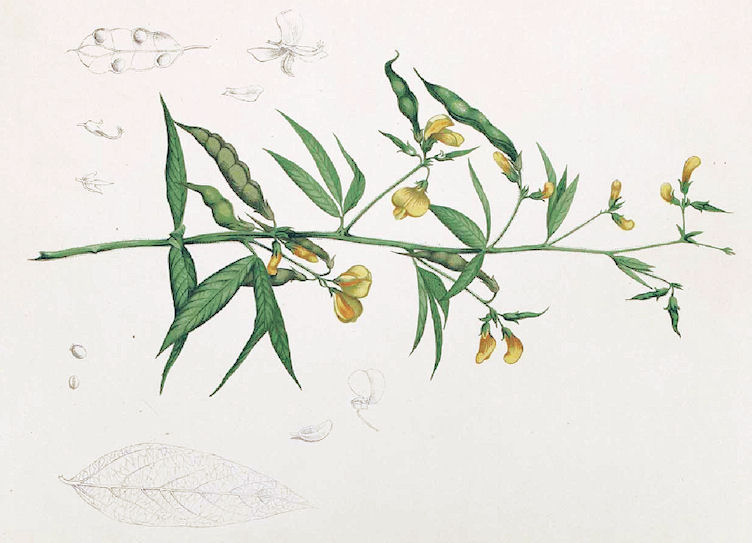
Abb.: Cajanus cajan (L.) Millsp. 1900 - Katjangstrauch / Taubenerbsenbaum
- Catjang Pea
[Bildquelle: Flora de Filipinas, 1880 / Wikipedia. -- Public domain]
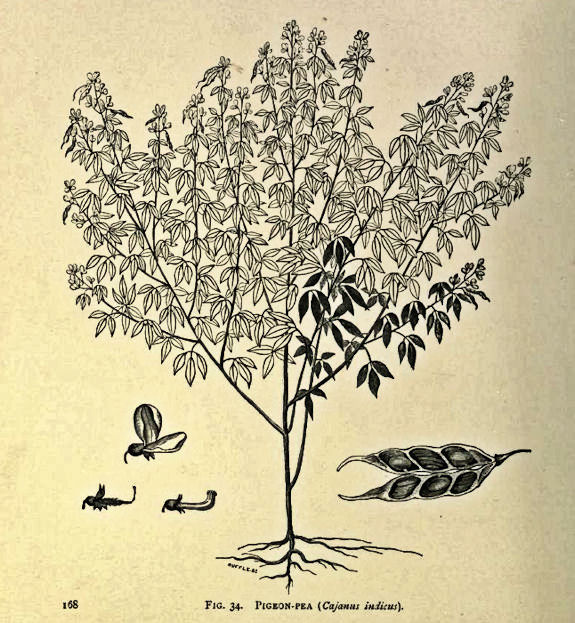
Abb.:
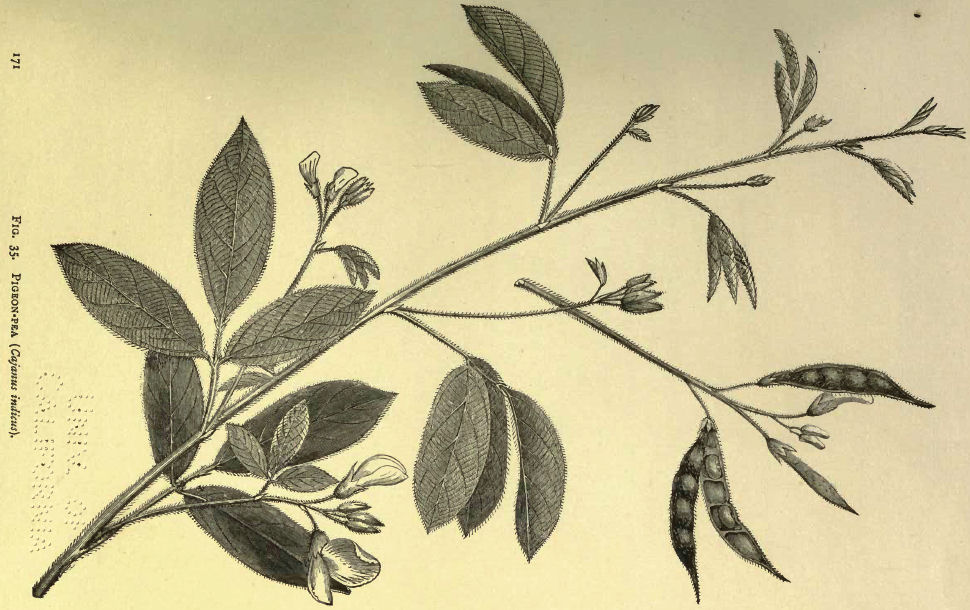
Abb.:
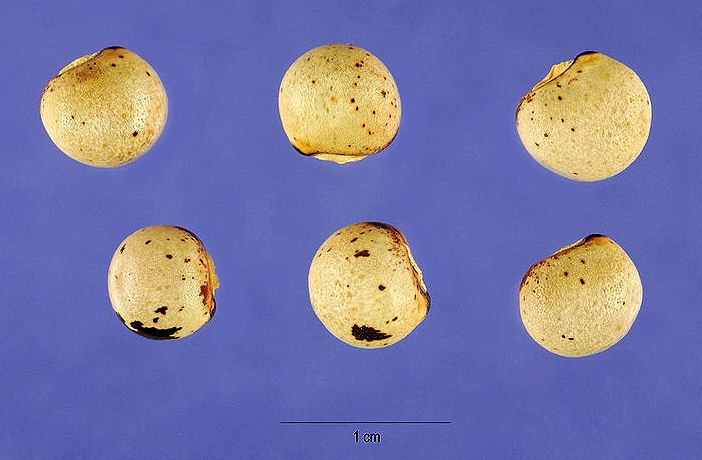
Abb.: आढक्यः । Samen von Cajanus cajan (L.) Millsp. 1900 - Katjangstrauch
/ Taubenerbsenbaum - Catjang Pea
[Bildquelle: Steve Hurst @ USDA-NRCS PLANTS Database. -- Public domain]
"Cajanus Indicus (Spreng.) N. O. Leguminosae Pigeon-pea
Description.—Shrub, 3-6 feet, softly pubescent; [...] flowers yellow.
Fl. Oct—Nov.
W. & A. Prod. i. 256.
Peninsula. Bengal Assam.
Of this shrub there are two varieties which differ by the colour of the vexillum alone.
- [...] Vexillum of a uniform yellow colour on both sides.—C. flavus, Dec.—Cytisus cajan, Linn.— Roaxb. Fl. Ind. iii. 325.
[...] Vexillum purplish, and veined on the outside, yellow on the inside.—C. bicolor, Dec.—Cytisus pseudo cajan, Jacq.—Rheede, Mal. vi. t. 13.
Economic Uses.—The seeds are much esteemed by the natives, who hold them third in rank among their leguminous seeds, though they are apt to produce costiveness. Cattle are very fond of the tender parts of the plant, both green and dry. The dried stem makes excellent fuel, and is well adapted for producing fire by friction.— (Roxb.) That which is known as the small "Toor" ripens half as soon again as the larger one. Some varieties are remarkable for the gaudy colours of their orange and red-spotted flowers. The pulse is chiefly eaten mixed with rice, a mess known as kedjari. The best Toor is sown in alternate drills with Sorghum vulgare, which ripens first, and is cut while the Cajanus is yet small. It then remains two or three months longer, and is reaped at the end of the harvest. The stalks are strong and woody, and well adapted for making charcoal required in gunpowder manufacture.—W. Elliott."
[Quelle: Drury, Heber <1819 - 1872>: The useful plants of India : with notices of their chief value in commerce, medicine, and the arts. -- 2d ed. with additions and corrections. London : Allen, 1873. -- xvi, 512 p. ; 22 cm. -- s.v.]
Fabaceae - Hülsenfrüchtler
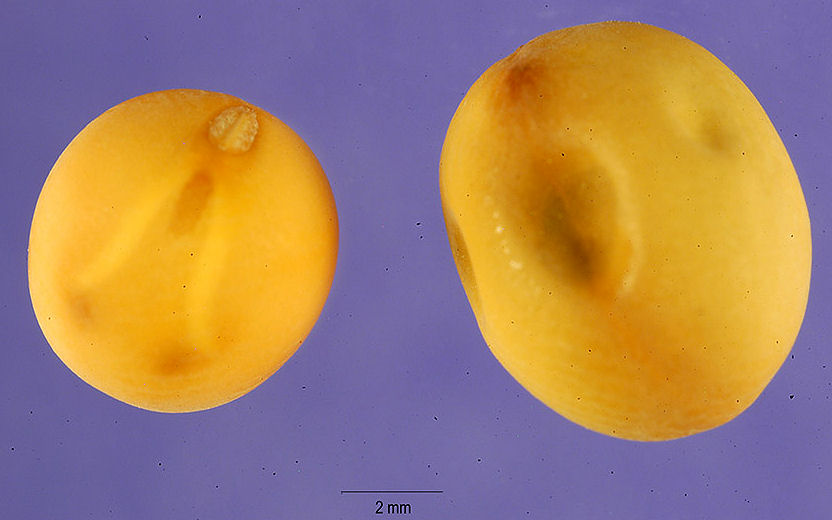
Abb.: त्रिपुटौ । Samen von Pisum sativum subsp. sativum Arvense Grp.:
Futter-Erbsen - Field Pea
[Bildquelle: Tracey Slotta @ USDA-NRCS PLANTS Database. -- Public domain]
"THE PEA. Pisum sativum, L.
[...]
The garden pea, a familiar annual herb, the leaves having three pairs of entire glaucous leaflets, and large leafy stipules. Pisum belongs to the tribe Vicieae. As a wild plant P. sativum is regarded as a native of the South Caucasus to Persia. It has been long cultivated in India.
The pea prefers heavy ground, and generally receives little cultivation, manure or irrigation. The produce of ripe seeds varies from 7 to 8 maunds per acre, without irrigation ; on irrigated land the yield is increased to 10 up to 16 maunds. The green pods are largely eaten before the general crop is cut in February, March, or April ; the sowing takes place in October and November.
[...]
In some districts this pea is not much esteemed in comparison with other pulse. Undoubtedly it has a tendency to produce flatulence, and is unwholesome when imperfectly cooked or imperfectly freed from the tough coat of the seed. In the south of the Purniah District it is largely eaten uncooked, and causes or aggravates dysentery and diarrhoea.
The field pea, sometimes called Pisum arvense, is a variety or sub-species of this species. It is sown and reaped at the same time as the garden pea. It is rightly regarded as more indigestible than the latter, but there is no constant difference of chemical composition between the two sorts. The garden pea has round seeds and 4 to 6 leaflets, the field pea marbled compressed seeds and 2 to 4 leaflets.
For methods of preparing these peas for food see page 120."
[Quelle: Church, A. H. (Arthur Herbert) <1834-1915>: Food-grains of India. -- London, 1886. -- S. 135f.]
Fabaceae - Hülsenfrüchtler
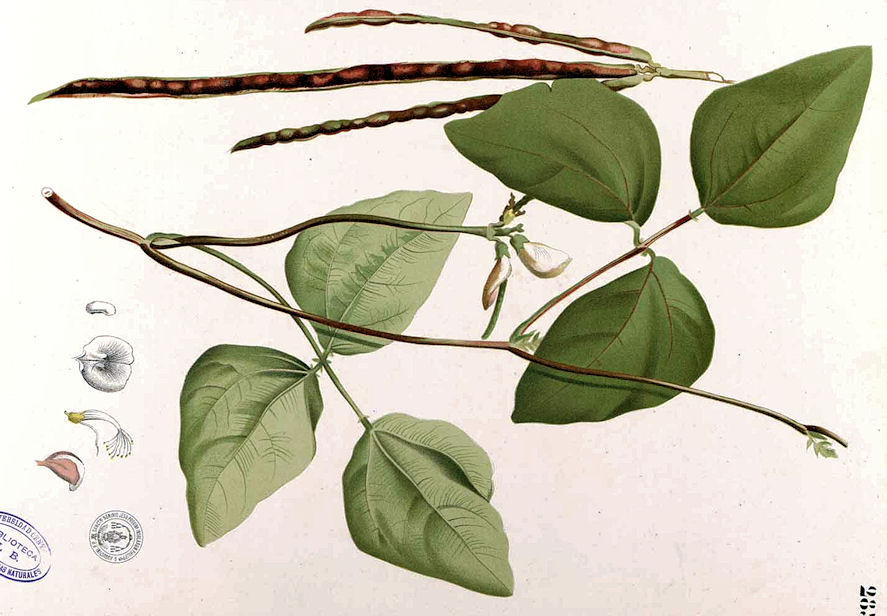
Abb.: कुलत्थः । Vigna unguiculata subsp. unguiculata :
Augenbohne - Black-eyed Pea
[Bildquelle: Flora de Filipinas, 1880 / Wikimedia. -- Public domain]
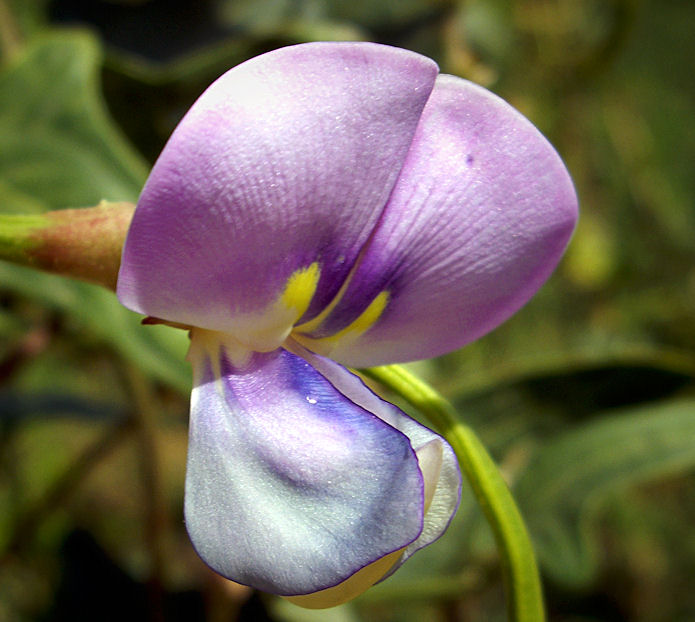
Abb.: कुलत्थः । Vigna unguiculata (L.) Walp. - Augenbohne - Cow Pea
[Bildquelle: Salomé. --
http://www.flickr.com/photos/bambolia/4986270658/. -- Zugriff am 2011-07-05.
-- Creative
Commons Lizenz (Namensnennung, keine kommerzielle Nutzung, share alike)]
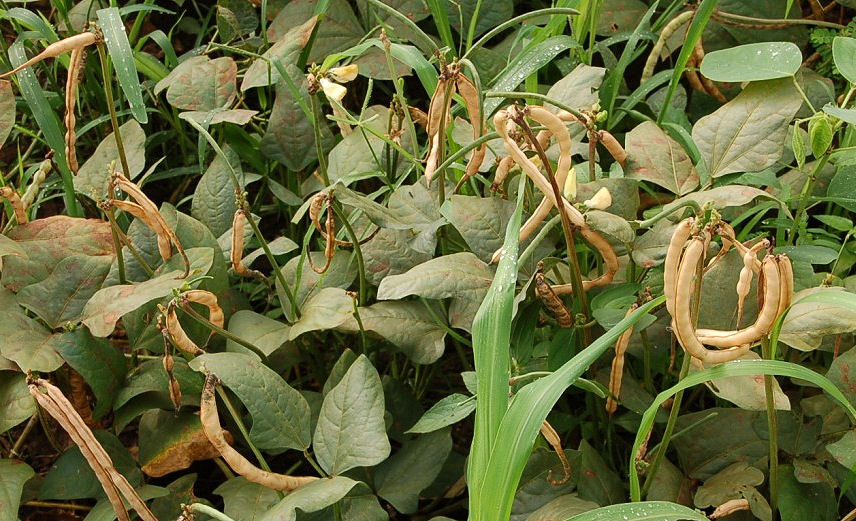
Abb.: कुलत्थाः । Vigna unguiculata (L.) Walp. - Augenbohne - Cow Pea
[Bildquelle: International Institute of Tropical Agriculture. --
http://www.flickr.com/photos/iita-media-library/4545436120/. -- Zugriff am
2011-07-05. --
Creative Commons Lizenz (Namensnennung, keine kommerzielle Nutzung)]
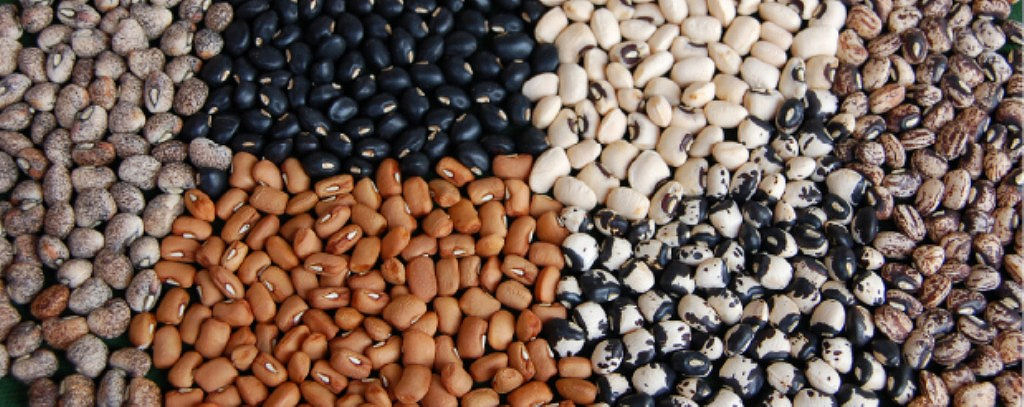
Abb.: कुलत्थाः । Varietäten von Vigna unguiculata (L.) Walp. - Augenbohne
- Cow Pea
[Bildquelle: International Institute of Tropical Agriculture. --
http://www.flickr.com/photos/iita-media-library/5029550931/. -- Zugriff am
2011-07-05. --
Creative Commons Lizenz (Namensnennung, keine kommerzielle Nutzung)]
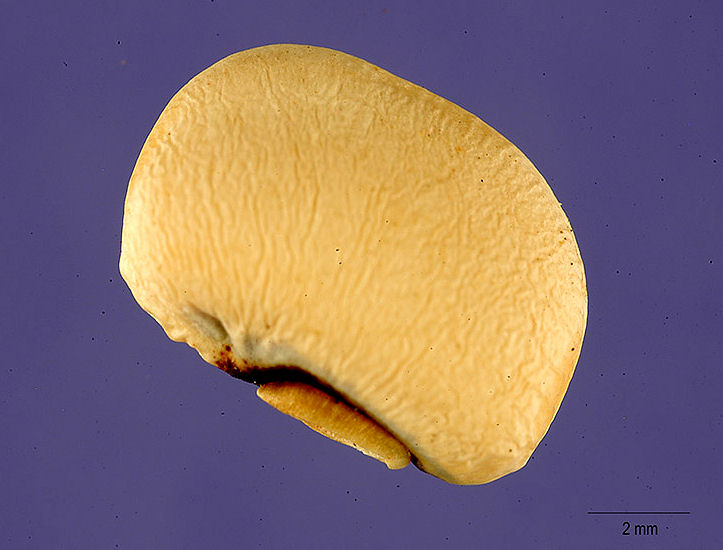
Abb.: कुलत्थः । Samen von Vigna unguiculata subsp. unguiculata :
Augenbohne - Southern Pea, Black-eyed Pea
[Bildquelle: Tracey Slotta @ USDA-NRCS PLANTS Database. -- Public domain]
"Die Augenbohne (Vigna unguiculata), auch Kuhbohne oder Schlangenbohne genannt, ist eine Nutzpflanze aus der Familie der Hülsenfrüchtler (Fabaceae). Neben der hier beschriebenen Nominatform subsp. unguiculata gehören zur Art noch die ebenfalls als Nutzpflanzen verwendeten Unterarten Spargelbohne und Catjangbohne. Merkmale
Die Augenbohne ist eine einjährige Pflanze. Ihr Habitus ist recht variabel und reicht von aufrecht über halb-aufrecht über niederliegend bis kletternd. Der Wuchstyp reicht von undeterminiert bis determiniert, wobei vor allem die nicht-rankenden Formen determiniertes Wachstum zeigen. Sie haben eine ausgeprägte Pfahlwurzel, die 8 Wochen nach der Aussaat 2,4 m tief reichen kann.
Die Blätter sind dreiteilig. Sie sind glatt, stumpf bis glänzend und selten behaart. Das endständige Blättchen ist häufig länger und größer als die beiden seitlichen. Blattgröße und -form sind sehr variabel.
Die Blüten stehen in mehrfachen Rispen an 20 bis 50 cm langen Blütenstandsstielen, die in den Blattachseln entspringen. Pro Blütenstand werden zwei bis drei Hülsen gebildet, auch vier oder mehr kommen vor. Die Blüten stehen deutlich über den Blättern und enthalten auch Nektarien, um Insekten anzulocken. Dennoch herrscht Selbstbestäubung vor.
Die Hülsen sind glatt und 15 bis 25 cm lang. Sie sind zylindrisch und etwas gekrümmt. Zur Nutzungsreife als Gemüse sind die Hülsen grün, gelb oder purpurn, zur Trockenreife werden die zunächst grünen und gelben Formen braun. Die Samen sind nierenförmig. Die Samenoberfläche ist glatt oder runzelig, die Farbe kann weiß, cremefarben, grün, rot, braun oder schwarz sein. Häufig haben sie ein "Auge", das heißt der weiße Nabel (Hilum) ist von einer anderen Farbe umrandet.
Inhaltsstoffe100 g reife Samen enthalten im Durchschnitt 24,8 g Protein, 1,9 g Fett, 6,3 g Fasern und 63,6 g Kohlenhydrate. An Vitaminen sind 0,74 mg Thiamin, 0,42 mg Riboflavin und 2,8 mg Niacin enthalten. Das Protein ist relativ reich an den Aminosäuren Lysin und Tryptophan, aber relativ arm an Methionin und Cystin.
AnbauDie Augenbohne ist in Afrika beheimatet. Sie wird heute in Afrika, Lateinamerika, Südostasien sowie im Süden der USA angebaut. Der Anbau in Westafrika reicht mindestens 4000 Jahre zurück.
Sie wird vor allem in den feuchten Tropen, aber auch in temperaten Gebieten angebaut. Hitze und Trockenheit werden gut vertragen, Frost wird nicht toleriert, kühle Temperaturen verlangsamen das Wachstum deutlich. Der Ertrag steigt deutlich mit der Wasserversorgung, etwa Bewässerung. Auch unter trockenen Bedingungen liefert die Augenbohne noch gute Erträge, worauf ihre große Bedeutung in vielen Gebieten zurückgeht.
An den Boden stellt die Augenbohne keine besonderen Anforderungen, am besten gedeiht sie auf gut drainierten sandigen bis sandig-lehmigen Böden bei pH-Werten zwischen 5,5 und 6,5.
NutzungDie Augenbohne wird in allen Wachstumsstadien als Gemüsepflanze genutzt. Junge grüne Blätter werden in Afrika wie Spinat als Blattgemüse zubereitet. Unreife Hülsen werden ebenfalls als Gemüse zubereitet. Grüne Samen werden gekocht als Frischgemüse genutzt oder in Konserven verpackt oder tiefgefroren. Reife, trockene Samen werden gekocht oder konserviert.
Das Laub wird an Nutztiere verfüttert und ist vielfach das einzige verfügbare hochwertige Tierfutter. In der Qualität kommt es der Luzerne gleich. Es wird frisch oder trocken verfüttert.
SystematikInnerhalb der Art Vigna unguiculata werden drei Taxa unterschieden, die entweder als Unterarten oder als Sortengruppen eingestuft werden:[1]
- Augenbohne: Vigna unguiculata subsp. unguiculata oder Vigna unguiculata Sortengruppe 'Unguiculata'
- Catjangbohne: Vigna unguiculata subsp. catjang oder subsp. cylindrica oder Vigna unguiculata Sortengruppe 'Biflora'
- Spargelbohne: Vigna unguiculata subsp. sesquipedalis oder Vigna unguiculata Sortengruppe 'Sesquipedalis'"
[Quelle: http://de.wikipedia.org/wiki/Augenbohne. -- Zugriff am 2011-07-96]
Brassicaceae - Kreuzblütengewächse
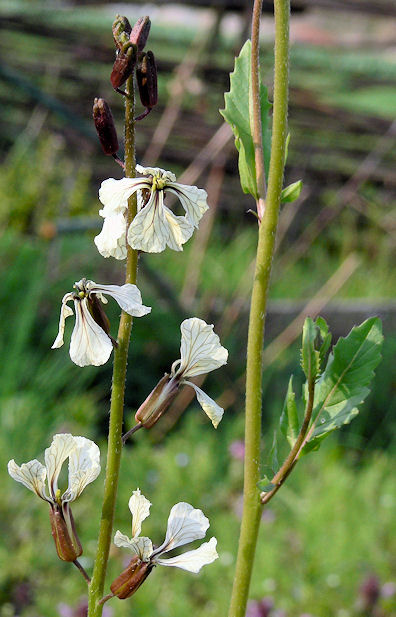
Abb.: तुवरी । Eruca sativa Mill. 1768 - Öl-Rauke, Rukola - Rocketsalad,
Deutschland
[Bildquelle: Leo Michels / Wikipedia. -- Public domain]
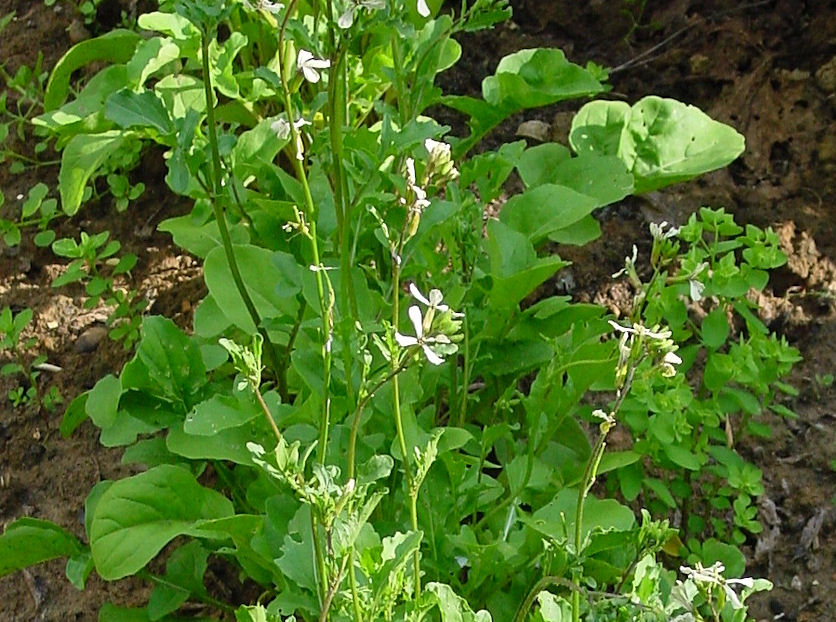
Abb.: तुवरी । Eruca sativa Mill. 1768 - Öl-Rauke, Rukola - Rocketsalad,
Deutschland
[Bildquelle: Leo Michels / Wikipedia. -- Public domain]
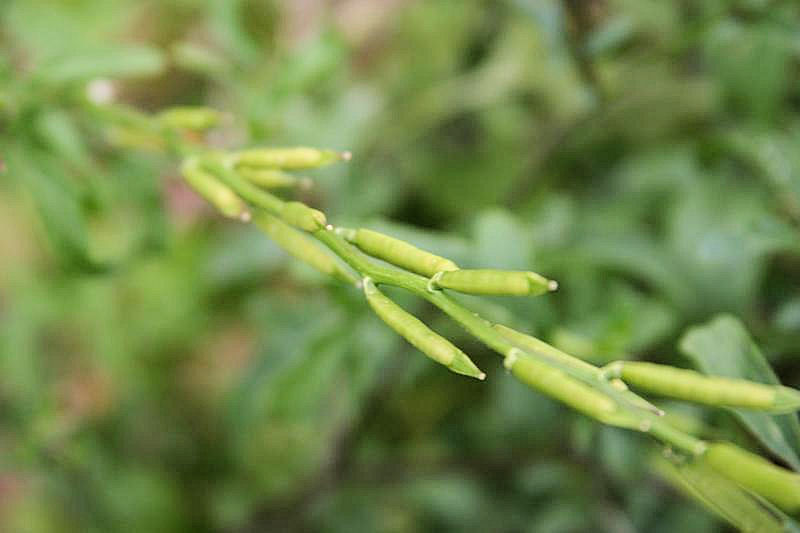
Abb.: Abb.: तुवरी । Eruca sativa Mill. 1768 - Öl-Rauke, Rukola - Rocketsalad
[Bildquelle: Dave's Garden / Wikimedia. -- GNU FDLicense]
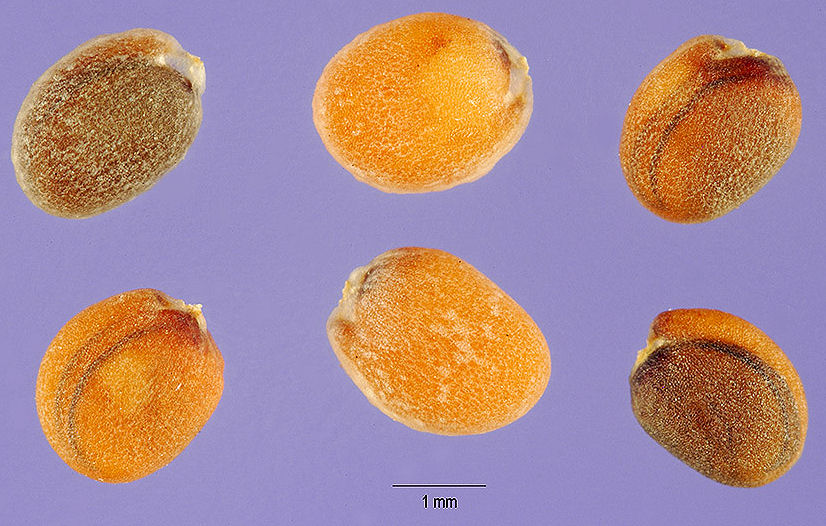
Abb.: Samen von Eruca sativa Mill. 1768;
Öl-Rauke, Rukola - Rocketsalad
[Bildquelle: Steve Hurst @ USDA-NRCS PLANTS Database. -- Public domain]
"Eruca sativa (syn. E. vesicaria subsp. sativa (Miller) Thell., Brassica eruca L.), is an edible annual plant, commonly known as rocket (roquette) or arugula, not to be confused with Wild rocket. It is a species of Eruca native to the Mediterranean region, from Morocco and Portugal east to Lebanon and Turkey.] It is closely related to Eruca vesicaria and included by some botanists in that either as a subspecies E. vesicaria subsp. sativa or not distinguished at all; it can be distinguished from E. vesicaria by its early deciduous sepals. It is an annual plant growing 20–100 centimetres (8–39 in) in height. [...]
Vernacular names include garden rocket or simply rocket (British, Australian & New Zealand English), eruca, rocket salad, and arugula (American and Canadian English). All names ultimately derive from the Latin word eruca, a name for an unspecified plant in the family Brassicaceae, probably a type of cabbage.
[...]
In West Asia and Northern India, arugula seeds are pressed to make taramira oil, used in pickling and (after aging to remove acridity) as a salad or cooking oil. The seed cake is also used as animal feed."
[Quelle: http://en.wikipedia.org/wiki/Eruca_sativa. -- Zugriff am 2011-07-06]
"Taramira oil or jamba oil, is a seed oil, pressed from the seeds of the arugula (Eruca sativa). Because the plant is highly drought resistant, the oil is popular in regions of poor rainfall, particularly in West Asia and Northern India. The oil is highly pungent and, upon extraction, acrid. The pungency differs from that of mustard oil, although taramira oil can be used to make a sort of mustard. In India, the oil is used for pickling, after aging to reduce the acridity, as a salad or cooking oil. The oil is also used as a massage oil and to soothe the skin. The seed cake, a byproduct of oil production, is also of use as animal feed." [Quelle: http://en.wikipedia.org/wiki/Taramira_oil. -- Zugriff am 2011-07-06]
Poaceae - Süßgräser
| 24a./b. māṣādayaḥ śamīdhānye śūkadhānye yavādayaḥ माषादयः शमीधान्ये शूकधान्ये यवादयः ।२४ क। Gerste u. ä. heißen शूकधान्य - śūkadhānya n.: Grannen-Getreide |
Colebrooke (1807): "Bearded corn. As barley, wheat, &c."
"Die Granne, plur. die -n, im gemeinen Leben Ober- und Niederdeutschlandes, eine Benennung einer jeden zarten biegsamen Spitze, dergleichen die langen scharfen Spitzen an den Fruchtähren, besonders an den Gerstenähren, welche in andern Gegenden Acheln und Gracheln heißen, (S. Agen,) die steifen Haare auf dem Rücken der Schweine, die Borsten, ingleichen die steifen Haare welche die Katzen und andere Thiere an dem Maule haben, die Tangeln oder Nadeln des Tangelholzes u.s.f. sind." [Quelle: Adelung, Johann Christoph <1732 - 1806>: Grammatisch-kritisches Wörterbuch der Hochdeutschen Mundart. -- Leipzig, 1793 - 1801. -- s. v.]
Der Bhāvaprakāśa nennt folgende शूकधान्य - śūkadhānya n.: Getreide mit Grannen
| 24c./d. śālayaḥ kalamādyāś ca ṣaṣṭikādyāś ca puṃsy amī शालयः कलमाद्याश् च षष्टिकाद्याश् च पुंस्य् अमी ।२४ ख। Winterreis (शालि - śāli m.) sind:
|
Colebrooke (1807): "Rice. Of two classes: white rice, &c. growing in deep water; or red rice, &c. requiring only a moist soil. The above-mentioned names of species of corn and pulse are masculine."
1 Kalama-Reis usw.
Der Bhāvaprakāśa nennt als Beispiele folgende Sorten:
2 60-Tage-Reis (Reis mit einer Reifezeit von nur 60 Tagen) usw.
Der Bhāvaprakāśa nennt als Beispiele folgende Sorten:
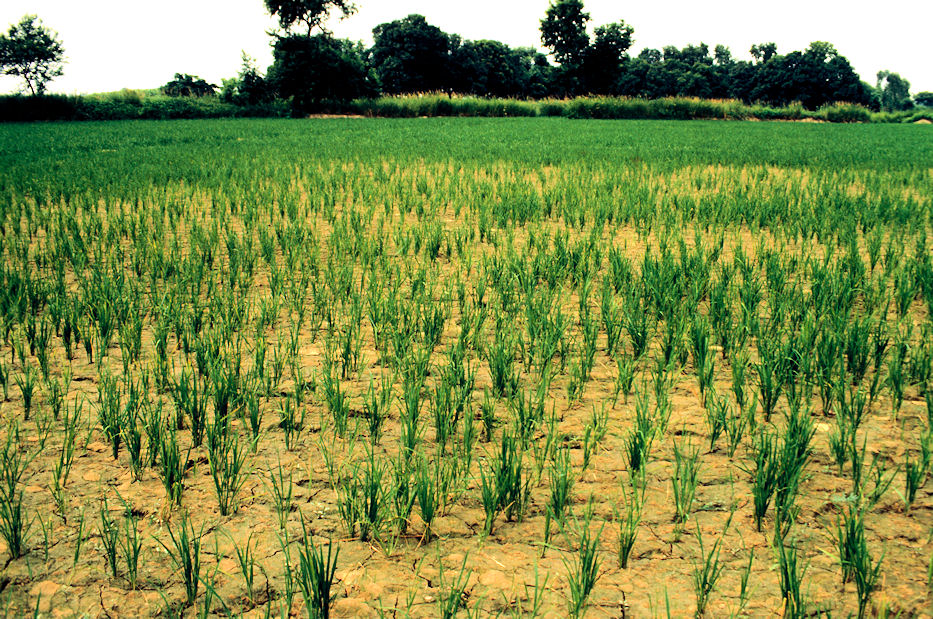
Abb.: Trockenfeld-Reis, Indien
[Bildquelle: IRRI. --
http://www.flickr.com/photos/ricephotos/3486545547/. -- Zugriff am
2011-07-06. -- Creative
Commons Lizenz (Namensnennung)]
Vorwiegend Poaceae - Süßgräser
| 25a./b. tṛṇadhānyāni nīvārāḥ strī gavedhur gavedhukā तृणधान्यानि नीवाराः स्त्री गवेधुर् गेवेधुका ।२५ क। नीवार - nīvāra m.: Hygroryza aristata Nees 1833 - Asian Watergrass, gehört zu den तृणधान्य - tṛṇadhānya n.: Grasgetreiden, Getreide-Kleingkeiten |
Colebrooke (1807): "Wild grains. Growing with little or no culture : viz. नीवारः, wild rice. Besides other kinds ; as श्यामाकः Panicum frumentaceum, Roxb."
नीवार - nīvāra m.: Hygroryza aristata Nees 1833 - Asian Watergrass
Poaceae - Süßgräser
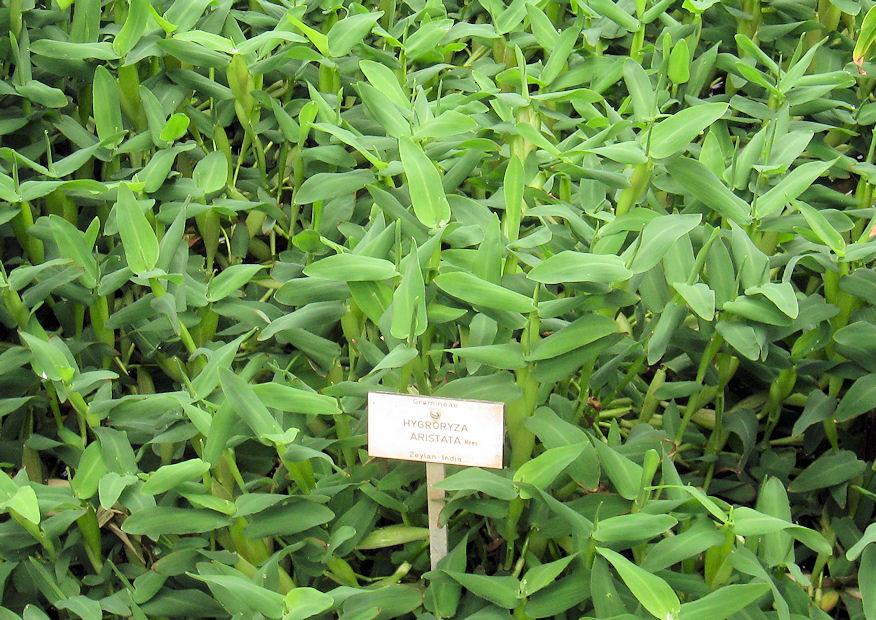
Abb.: नीवारः । Hygroryza aristata Nees 1833
- Asian Watergrass, Belgien
[Bildquelle: Daderot / Wikipedia. -- Public domain]
"Schwimmreis, Hygroryza aristata, chinesisch shui he [水禾], ist eine ausdauernde Wasserpflanze und einzige Art der Gattung Hygroryza in der Familie der Süßgräser (Poaceae). Botanisch gesehen ist er kein Reis (gehört aber zur gleichen Familie), sondern eine frei an der Wasseroberfläche schwimmende tropische Grasart, die dichte Flutrasen ausbilden kann.Vorkommen, Verbreitung [Bearbeiten] Das natürliche Vorkommen des Grases beschränkt sich auf Südostasien (Fujian, Guangdong, Hainan, Taiwan, Yunnan, Bangladesh, Kambodscha, Indien, Laos, Malaysia, Myanmar, Nepal, Pakistan, Sri Lanka, Thailand, Vietnam).
VerwendungWegen der zierlichen, nur wenige Zentimeter langen, Blattspreiten und der aufgeblasenen Blattscheiden wird der Schwimmreis in offenen Aquarien verwendet. In der Aquaristik wird es als Schwimmreis oder Schwimmgras bezeichnet. Die zahlreichen, feinen Adventivwurzeln, die sich an den Knoten bilden, stellen gute Verstecke für Jungfische dar. Wegen des raschen Wachstums der Stolonen ist die Art aber nur für größere Wasserflächen geeignet. Die Ansprüche an Licht und Wassertemperatur sind hoch (22- 28 Grad C), trotzdem kann der Schwimmreis in wärmeren Lagen in Mitteleuropa während des Sommers in Gartenteichen kultiviert werden. Die Vermehrung erfolgt durch Teilung der bewurzelten Sprosse."
[Quelle: http://de.wikipedia.org/wiki/Schwimmreis. -- Zugriff am 2011-07-06]
Im Bhāvaprakāśa genannt als क्षुद्रधान्य - kṣudradhānya n.: Kleineres / unwerteres "Getreide":
Poaceae - Süßgräser
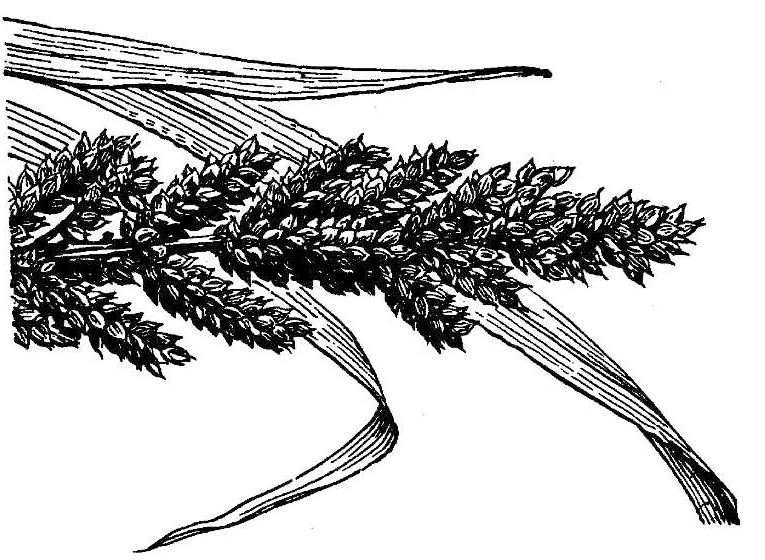
Abb.: श्यामाकः । Echinochloa frumentacea
Link 1827 - Sawa-Hirse
- Billion-dollar Grass
[Bildquelle: USDA-NRCS PLANTS Database / Hitchcock, A.S. (rev. A. Chase). 1950.
Manual of the grasses of the United States. USDA Miscellaneous
Publication No. 200. Washington, DC. -- Public domain]
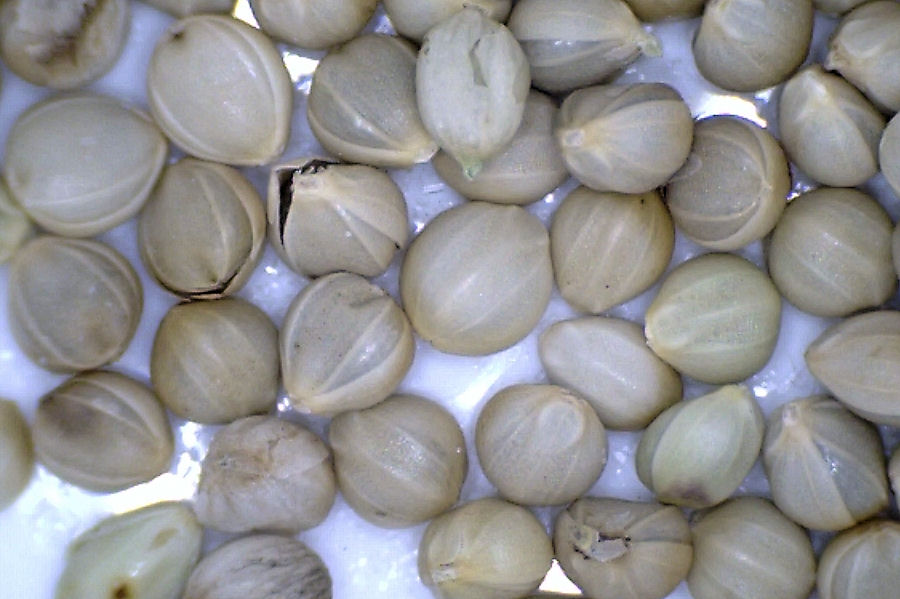
Abb.: श्यामाकः । Echinochloa frumentacea
Link 1827 - Sawa-Hirse
- Billion-dollar Grass
[Bildquelle: Kochfutter2 / Wikipedia. -- Public domain]
Die Japanhirse ist in allen tropischen Regionen der Erde verbreitet (pantropisch) mit dem Ursprung in der Alten Welt[1].
MerkmaleDie einjährige, krautige Pflanze hat robuste, aufrecht wachsende und zwischen 1 und 1,5 Meter hohe Halme. Die Blattscheiden und Blattspreiten sind weich und unbehaart. Die Laubblätter erreichen zwischen 15 und 40 Zentimeter Länge und zwischen 1 und 2,4 Millimeter Breite. Deren wellige Ränder sind knorpelig verdickt. Blatthäutchen (Ligulae) sind nicht ausgebildet.
Der Blütenstand ist eine dichte, kräftige, längliche Rispe, welche bis zu 20 Zentimeter messen kann. Die Hauptachse ist rau und behaart. Die 1 bis 3 Zentimeter langen, eng stehenden und sich zuweilen überlappenden Rispenäste sind wellig. Die grünlichen bis purpurfarbenen, grannenlosen und gedrängt stehenden Ährchen sind breit-oval und zwischen 2,5 und 3,5 Millimeter lang. Die Hüllspelze sind kürzer als die Ährchen. Die Karyopsen sind lang. Die Blüte- und Fruchtzeit liegt zwischen August und Oktober. [2] [3]
SynonymeSynonyme dieser Art sind:
Nutzung
- Oplismenus frumentaceus Kunth , Révis. gramin. 1 (1829) 45
- Panicum crus-galli var. frumentaceum Trim. , Cat. Ceyl. Pl. (1885) 104
- Echinochloa crus-galli var. frumentacea W.F.Wight , Cent. Dict. Sup. (1909) 810
- Echinochloa crus-galli subsp. colona var. edulis Honda in Bot. Mag., Tokyo 37 (1923) 123
- Echinochloa colonum var. frumentaceum Ridl. , Fl. Mal. Penins. 5 (1925) 223
- Panicum crus-galli var. edule (Hitchc.) Thell. in Hegi, Ill. Fl. Mitt.-Eur., 2. ed., 1 (1935) 264
- Panicum frumentaceum Roxb. , Fl. Ind. 1 (1820) 307, non Salisb. (1796)
- Echinochloa crus-galli edulis Hitchc. in U.S.D.A. Bull. 772 (1920) 238
In Asien, Afrika, dem Westen der USA und Kanada wird die Japanhirse gelegentlich als schmackhaftes Weide- und Futtergras (Heu) sowie als Vogelfutter kultiviert. Vielfach wird sie zum Schutz vor Erosionen auf frisch umgebrochenen, sandigen Böden angepflanzt. In Ägypten wird es bei der Rückgewinnung von salzhaltigen Böden eingesetzt. Das Getreide wächst sehr schnell. Es benötigt lediglich sechs Wochen von der Aussaat bis zur Ernte. In Ägypten, Indien, Kashmir und Sikkim wird das geschälte Getreide wie Reis gekocht. Manchmal wird die Japanhirse auch zur Bierherstellung verwendet."
[Quelle: http://de.wikipedia.org/wiki/Japanhirse. -- Zugriff am 2011-07-06]
Poaceae - Süßgräser
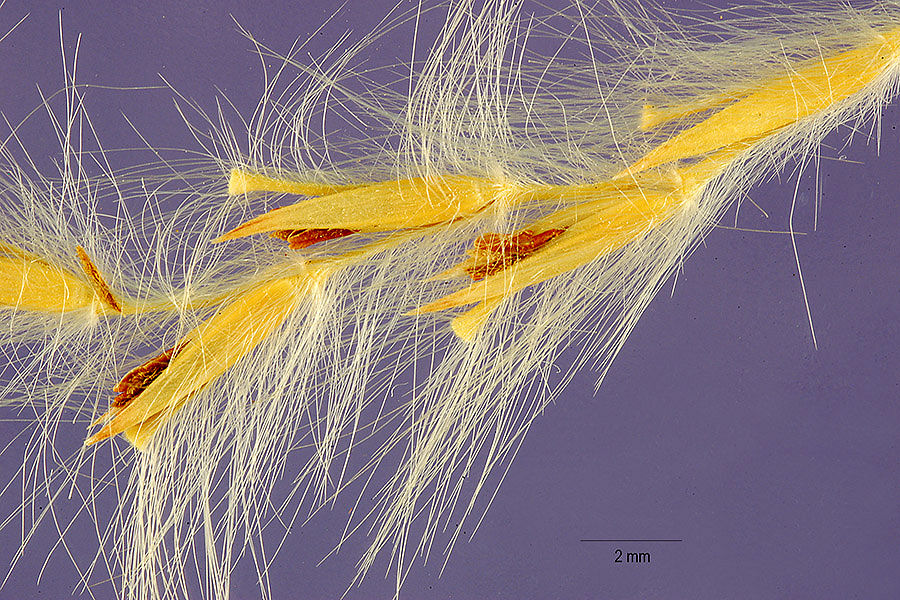
Abb.: चारुकः । Saccharum bengalense Retz. 1788: Tall
Cane, Munj Sweetcane
[Bildquelle: Tracey Slotta @ USDA-NRCS PLANTS Database. -- Public domain]
"Saccharum bengalense, alternatively Saccharum bengalensis, is a plant in the sugarcane genus found in India, it is also known as the Baruwa sugarcane or Baruwa grass. One of its main ranges is in northern India, specifically in the grasslands of the Terai-Duar, it is a diet source for many animals like the Indian Rhinoceros and the Pygmy Hog. This small species of sugarcane bamboo is colored pinkish-green, and is usually around two or three feet tall." [Quelle: http://en.wikipedia.org/wiki/Saccharum_bengalense. -- Zugriff am 2011-07-06]
Poaceae - Süßgräser
वंशयव - vaṃśayava m.: "Gerste" von Bambusa bambos (L.) = Samen davon
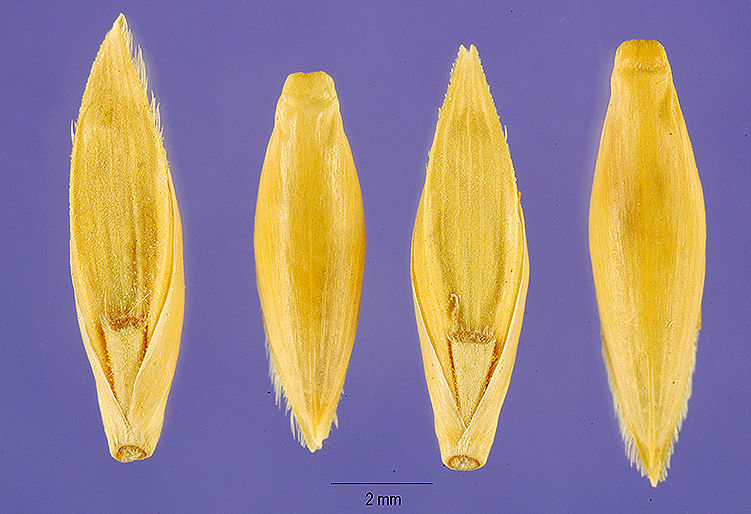
Abb.: वम्यवाः । Samen von Bambusa bambos (L.) Voss 1895 -
Dorn-Bambus - Spiny Bamboo
[Bildquelle: Jose Hernandez @ USDA-NRCS PLANTS Database. -- Public domain]
Vielleicht sind nicht die Samen gemeint, sondern Tabaxir / Tabasheer.
"Tabaxir / Tabasheer [(Hindi-Urdu: तबाशीर or طباشیر)] (auch Bambuskampfer oder Bambuszucker, in den Ursprungsländern Banslochan, [बंसलोचन, بنسلوچن], arabisch Tabasheer, persisch Tabaschir oder Tabashir) ist eine Konkretion aus den Hohlräumen zwischen den Knoten des Bambusrohrs. Tabaxir entsteht wahrscheinlich bei periodisch verlangsamtem Wachstum und bildet unregelmäßige, erbsengroße weiße, gelbliche und bräunliche, opalartig durchscheinende Körnchen, die wesentlich aus amorpher Kieselsäure mit 5 bis 13 % Wasser bestehen.
Tabaxir war als Arzneimittel im Mittelalter hoch geschätzt, wird jetzt aber nur noch in China und Arabien angewendet. Nach Zusammensetzung und physikalischer Beschaffenheit hat Tabaxir die größte Ähnlichkeit mit Opal, er wird im Wasser durchsichtig und durch Trocknen wieder undurchsichtig und besitzt die kleinste Brechzahl unter allen bekannten festen Stoffen.
Es handelt sich wohl hauptsächlich um das Produkt der Art Bambusa bambos (L.) Voss (Syn. Bambusa arundinacea (Retz.) Willd., Rohrbambus)"
[Quelle: http://de.wikipedia.org/wiki/Tabaxir. -- Zugriff am 2011-07-06]
"BAMBUSA ARUNDINACEA, Retz. [= Bambusa bambos]
Fig.--Roxb. Cor. Pl. i. t. 79; Rheede, Hort. Mal. i. t. 16
Bamboo
Hab.—Throughout India.
[...]
History, Uses,&c.—The Bamboo,in Sanskrit Vansa and Venu, is considered by the Hindus to have the hardest of woods. The word also signifies 'spine' and' lineage,' thus Vansa-visuddha means "made of a good bamboo," i.e., of a pure or good family, and Vansa-dhara "carrying a bamboo," i.e., maintaining a family, Vansa-pratishthana-kara "establishing a family on a sure foundation." The Abbé Dubois, in his Description of India, states that the young Indian bride and bridegroom are made to stand in two bamboo baskets placed side by side, and the Kul or Arbor generationis of the caste, at Hindu marriages, is placed in a winnowing fan made of bamboo. The wild tribes of the Garrow hills, who have no temples or altars, set up opposite their huts a bamboo post which they deck with flowers and tufts of cotton, and before it they make offerings to their god. Indian anchorites carry a bamboo stick having seven knots. A bamboo flowering is an event of rare occurrence, and which is supposed to bring in its train all sorts of evil, accompanied by dire distress and famine. The seeds of the bamboo, in Sanskrit Vansa-tandula, Vansa-ja, Venu-yava, Venu-vija, have often proved of great value in famine seasons, saving thousands of lives ; this was the case in Orissa in 1812 and in Canara in 1864. The young shoots which appear towards the end of the rainy season are used as a vegetable; they are minced very finely and soaked in water to remove the bitter taste, and then cooked with dāl, and seasoned according to taste : they are also made into pickle.
A decoction of the joints of the bamboo is supposed to have an action on the uterus, and is used by females after delivery to cause a free flow of the lochial discharge. The same part of the plant pounded with water is applied to inflamed joints. The juice of the leaves with aromatics is given in haematemesis. The leaves are very commonly given to horses by syces as a remedy for coughs and colds.
Bamboo manna is the Vansa-lochana of the Indian physicians ; in the Nirghantas it bears many synonyms, such as Vansa-rochana, Tvak-kshira "bark-milk," Vansa-karpura "bamboo camphor," Vansa-sarkara " bamboo sugar," Vansāhva "bamboo sacrifice," Subhra, and Sita "white," &c. It is considered to be strengthening, tonic, cold, and sweet; to alleviate thirst, and to avert phthisis, fever, asthma, cough, biliousness, skin diseases, and Vāyu (morbid affections of the windy humor). As an example of the way in which it is prescribed, the following formula for making the Sitopalādi-churna will be found in Sarangadhara :—Bamboo manna 8 parts, long pepper 4, cardamoms 2, cinnamon 1, sugar 16. Powder and mix. Dose about 60 grains, to be given with honey and ghi in phthisis and cachexia.
The belief in the strengthening properties of bamboo manna appears to have originated among the aboriginal tribes of India, as on the West Coast it is the first solid food which the Thana Kolis give their children. The same belief seems to have prevailed in Borneo, as Marco Polo relates that pieces of this substance were let in under the skin by the natives to make the body wound-proof.
We hold with Salmasins that bamboo manna was the substance known to the Greeks as σακχαρ σακχαρον, and described by them as a white, concreted or crystalline substance like common salt, because there was no kind of sugar prepared from the sugar-cane, answering to this description, known in India in the time of Dioscorides. The name Sarkara, which signifies "grit, pebbles, sand," was applied by Hindu writers at that time to several substances, viz., Guda or molasses in a dry granular state, the only kind of cane-sugar then in use in India; Yavāsa-sarkara, the concrete manna of Alhagi; and Vansa sarkara, the concretion found in the bamboo. The Sanskrit name Khanda was also applied to Guda, which is the substance known in the vernaculars as Gūr or Gūl, and is still the kind of sugar most used by the Hindus. Pale crystalline sugar, the Chini of the bazars, does not appear to have been known until some 400 years after the date of Dioscorides.
Under the name of Tabāshir, a corruption of the Sanskrit Tvak-kshira, bamboo manna was known to the early Arab travellers in the East; the port of Thana, on the West Coast of India, was famous for its Tabāshir in the time of Idrisi (1135) and supplied it to all marts. Ibn Sina describes Tabāshir as astringent and stomachic, useful in erysipelas and to ally thirst in bilious dyspepsia, cardiacal, and strengthening. As a local application it is used to relieve the heat and irritation caused by aphthous eruptions along with pounded rose leaves. Later Mahomedan writers upon the Materia Medica of the East have added nothing of importance to Ibn Sina's account of the drug. Flückiger (Zur Geschichte des Tabaschir, Zeit. des allg. österr. Apoth. Ver. Nr. 14 u.15,1887) mentions a list of Indian goods on which transit duty was levied at Aden in 1270 ; in it Tabāshir is mentioned together with tamarinds and camphor. He also draws attention to a remarkable connection between Tabāshir and ivory ashes, generally known by the name of Spodium. Idrisi, in the middle of the 12th century, points out that the latter was used to adulterate the former, while others of a different opinion assign a greater value to Spodium. Garcia d'Orta (Colloquios 51 )mentions both Tabāshir and Spodium, which he considers to be Pompholyx or Turtia (white of zinc ? calamine ?), and states that in Persia and Arabia Tabāshir was generally paid for by its weight in silver ("o preço ordinario na Persia e Arabia é a peso de prata"); he also describes black or grey Tabāshir, which was of less value and was obtained by burning the bamboo cane. Flückiger remarks that it is most likely that the name "Spodium da canna " was given to this black Tabāshir or perhaps to the ashes of the cane, and that it might be owing to this circumstance that in later times the name Spodium came to be applied to animal charcoal (bone-black). The idea of black seems not to have been connected with the original Greek name σποδος (ashes). Flückiger also draws attention to the Latin translation of a Persian Karabādin or Pharmacopoeia by the Carmelite Friar P. Angelus, published in Paris in 1681, in which Tabāshir is spoken of as pseudo-spodium, anti-spodiu, and spodium-arabicum. Rhedde as well as Rumphius notice Tabāshir, but it does not appear to have attracted much attention in Europe until Dr. Patrick Russell drew the attention of the Royal Society to it, and induced James Louis Macie to make an analysis, which showed that it consisted principally of silica.
Further information on Tabāshir may be obtained from Prof. Flückiger's papers above mentioned, and a paper by Dr. Brandis in the Indian Forester, March, Vol. XIII.
Description.—Tabāshir consists of irregularly-shaped fragments of an opaque white or bluish opalescent colour, the larger pieces are about an inch in diameter, concavo-convex, and have evidently derived their form from the joint of the bamboo in which the deposit has collected. The raw article is blackened and dirty, having apparently been obtained by burning the bamboos, or on account of the presence of insects ; to make it fit for use it is calcined, when it becomes perfectly clean."
[Quelle: Pharmacographia indica : a history of the principal drugs of vegetable origin met with in British India / by William Dymock [1834-1892], C. J. H. Warden and David Hooper [1858-1947]. -- Bd. 3. -- London, 1893. -- S. 586ff.]
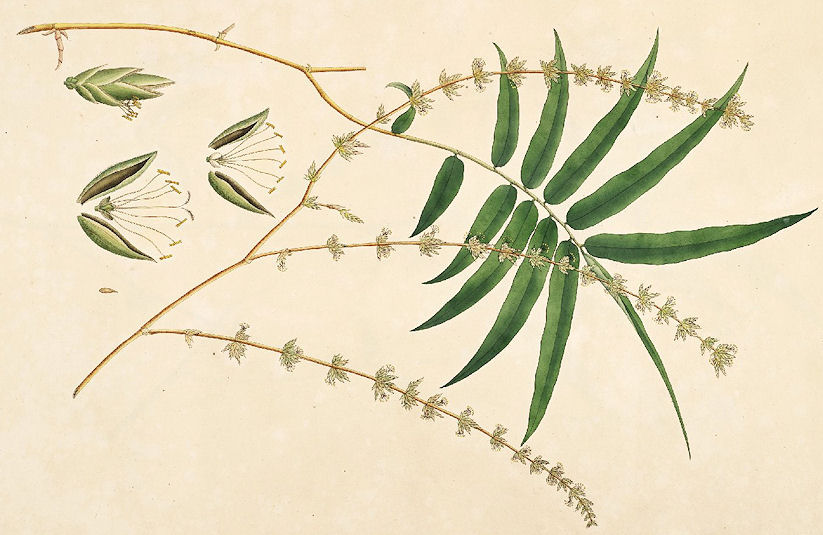
Abb.: यवफलः । Bambusa bambos (L.) Voss 1895 - Dornbambus - Spiny Bamboo
[Bildquelle: Roxburgh. -- Vol I. -- 1795. -- Tab. 79. -- Image courtesy Missouri
Botanical Garden. http://www.botanicus.org.
-- Creative Commons
Lizenz (Namensnennung, keine kommerzielle Nutzung)]
Asteraceae - Korbblütler
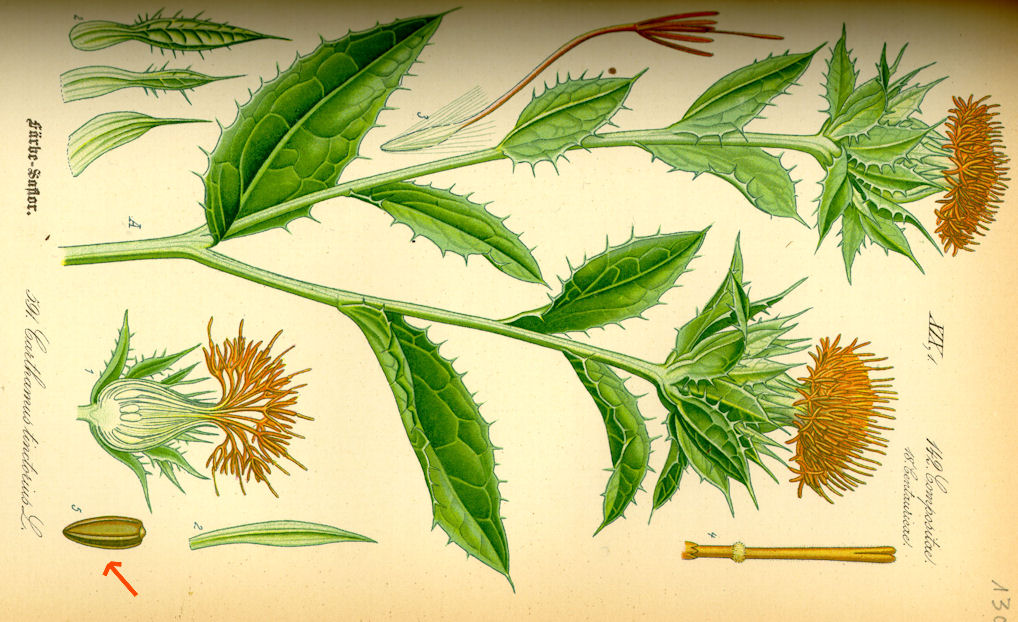
Abb.: कुसुम्भबीजम् । Samen von Carthamus tinctorius L.
1753 - Färber-Distel - Safflower
[Bildquelle: Otto Wilhelm Thomé, 1885 / Wikipedia. -- Public domain]
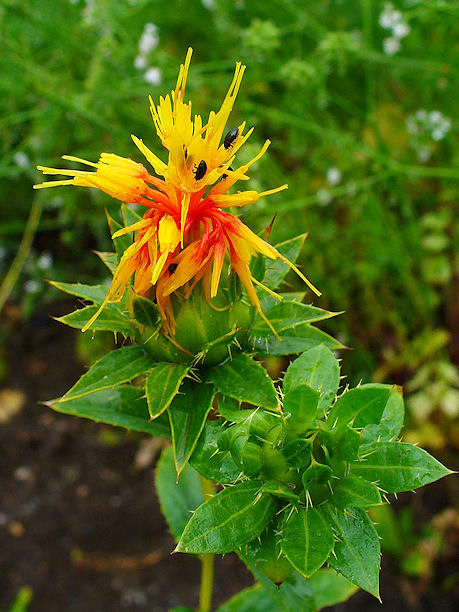
Abb.: कुसुम्भम् ।
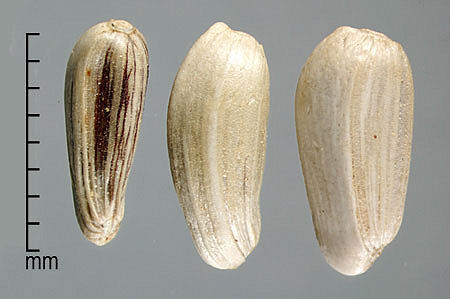
Abb.: कुसुम्भबीजम् । Frucht (Achäne) von Carthamus tinctorius L.
1753 - Färber-Distel - Safflower
[Bildquelle: Scher, J. L. and D. S. Walters. 2010. Federal noxious weed
disseminules of the U.S. California Department of Food and Agriculture, and
Center for Plant Health Science and Technology, USDA, APHIS, PPQ. -- Public
domain]
"CARTHAMUS TINCTORIUS, Linn. Fig.—Reich. Ic. Fl. Germ. t. 746; Bot. Reg. t. 170; Rumph. Amb. V. 79.
Safflower, Parrot seed
Hab.—Cultivated throughout India. (C. oxycantha, Bieb., is perhaps the wild form of this plant.) The flowers and seeds.
[...]
History, Uses, &c.—This plant is the Kusumbha of Sanskrit writers, who describe the seeds as purgative, and mention a medicated oil which is prepared from the plant for external application in rheumatism and paralysis. It is the
κνικος of the Greeks, who used the leaves like rennet to curdle milk in making cheese. Pliny (21, 53,) calls it Cnecos. Mahometan writers enumerate a great many diseases in which the seeds may be used as a laxative ; they consider them to have the power of removing phlegmatic and adust humours from the system.The author of the Makhzan states that Kurtum, Hab-el-asfar, and Bazr-el-ahris are the Arabic names for the seeds, and Khasakdanah and Tukm-i-kafshah the Persian. He also says that in Ghilan they are called Tukm-i-lajrah or Tukm-i-kazirah, in Syria Kashni, and in Turkey Kantawaras, and that the Greeks call them Atraktus (
ατρακτυλις), and Dioscorides Knikus (κνικος). Ainslie has the following notice of the plant :— "A fixed oil is prepared from it which the Vytians use as an external application in rheumatic pains and paralytic affections also for bad ulcers ; the small seeds are reckoned amongst their laxative medicines, for which purpose I see they are also used in Jamaica (the kernels beat into an emulsion with honeyed water). Barham tells us that a drachm of the dried flowers taken cures the jaundice." {Mat. Ind. ii., 364.)The seeds are known in England as Parrot seed. Under the name of safflower the flowers form an important export article to Europe; they contain two colouring matters, yellow and red, the latter is the most valuable. In silk dyeing it affords various shades of pink, rose, crimson and scarlet. Rouge is also made from it. According to Calvert (Dyeing and Calico Printing, Bd. 1878,) though the safflower has lost much of its value as a dye since the discovery of the aniline colours, it is still used extensively in Lancashire for the production of peculiar shades of pink of the Eastern markets. It is also used for dyeing red tape, and there is no more striking instance of "red-tapeism," than the love which is shown for this particular colour by the users of that article. Much cheaper pinks can be produced from aniline, but notwithstanding the attempts which have many times been made to introduce them, they have failed in every instance, because the exact shade has not been obtained."
[Quelle: Pharmacographia indica : a history of the principal drugs of vegetable origin met with in British India / by William Dymock [1834-1892], C. J. H. Warden and David Hooper [1858-1947]. -- Bd. 2. -- London, 1891. -- S. 308f..]
Poaceae - Süßgräser
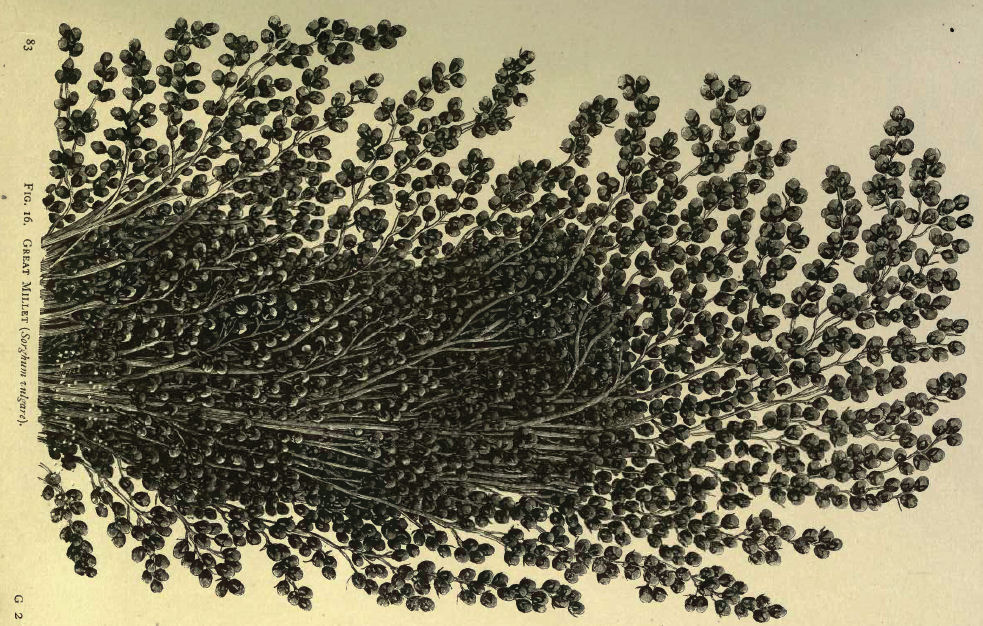
Abb.: यावनालः ।
Sorghum bicolor (L.) Moench 1794 -
Gewöhnliche Mohrenhirse - Great Millet
[Bildquelle: Church, A. H. (Arthur Herbert) <1834-1915>: Food-grains of
India. -- London, 1886.]
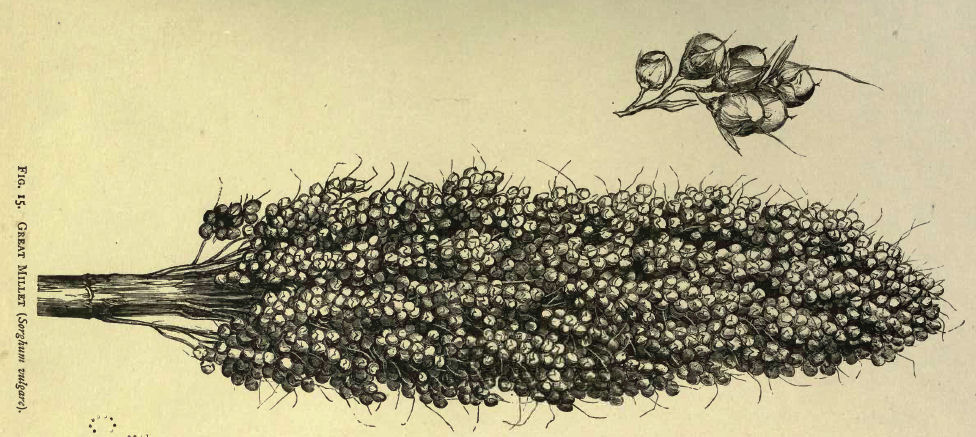
Abb.: यावनालः ।
Sorghum bicolor (L.) Moench 1794 - Gewöhnliche
Mohrenhirse - Great Millet
[Bildquelle: Church, A. H. (Arthur Herbert) <1834-1915>: Food-grains of
India. -- London, 1886.]
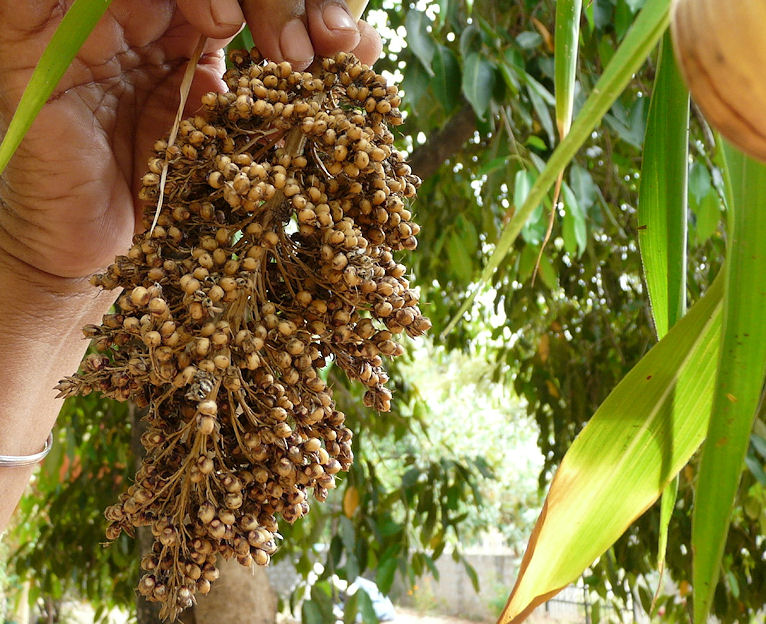
Abb.: यावनालः ।
Sorghum bicolor (L.) Moench 1794 - Gewöhnliche
Mohrenhirse - Great Millet, Indien
[Bildquelle: jankie. --
http://www.flickr.com/photos/39049548@N05/4299919764. -- Zugriff am
2011-07-02. --
Creative
Commons Lizenz (Namensnennung, keine kommerzielle Nutzung, share alike)]
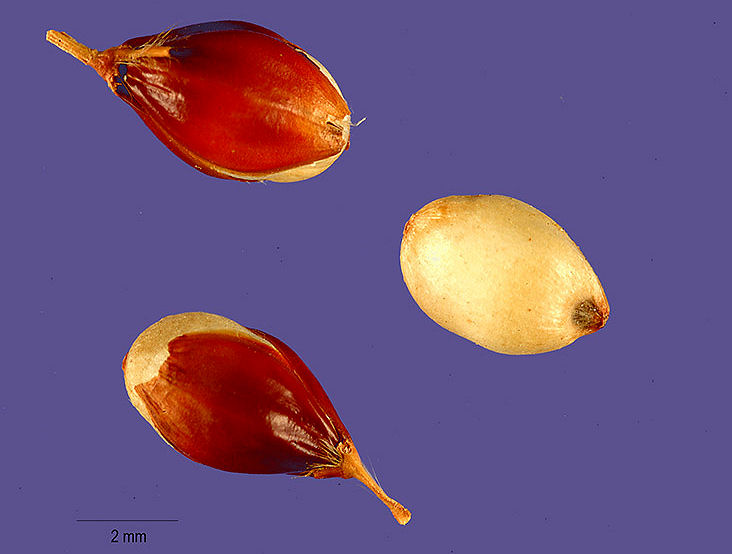
Abb.: यावनालः
।
Sorghum bicolor (L.) Moench 1794 var. bicolor -
Gewöhnliche Mohrenhirse - Great Millet
[Bildquelle: Steve Hurst @ USDA-NRCS PLANTS Database. -- Public domain]
"Sorghum vulgare (Pers.) Great Millet, Eng.
Description. — Culms erect; [...]
Roxb. Fl. Ind. i. 269.—Holcus sorghum, Linn.—Andropogon sorghum, Roxb.
Cultivated.
Economic Uses.—This species is cultivated for its grain, which is much used as food. The produce in good soil is often upwards of a hundred-fold. Cattle are very fond of the straw; the latter is also a substitute for forage for horses when gram is not obtainable. The S. bicolor (Willd.) is also used for the same purposes.—(J. Grah. Roxb.) There are several varieties, one called the Black, the other the White Cholam. The word Coromandel given to the eastern coast of the Peninsula is merely a corruption of the word Ciola-mandala, i.e., the Land of Millet—as Malyala or Malabar is the - Land of Mountains.—(Bart., Voy.) Cholum is the staple dry grain of India, and indeed of all tropical countries of Asia and Africa. It is largely cultivated in Europe as well as the United States, and its range is probably not less extensive than that of wheat. It forms the principal article of food among the agricultural classes on tablelands, as rice does of those of the lower, country.—W. Elliott."
[Quelle: Drury, Heber <1819 - 1872>: The useful plants of India : with notices of their chief value in commerce, medicine, and the arts. -- 2d ed. with additions and corrections. London : Allen, 1873. -- xvi, 512 p. ; 22 cm. -- s.v.]
Poaceae - Süßgräser
Poaceae - Süßgräser
Gujarati: બાજરી
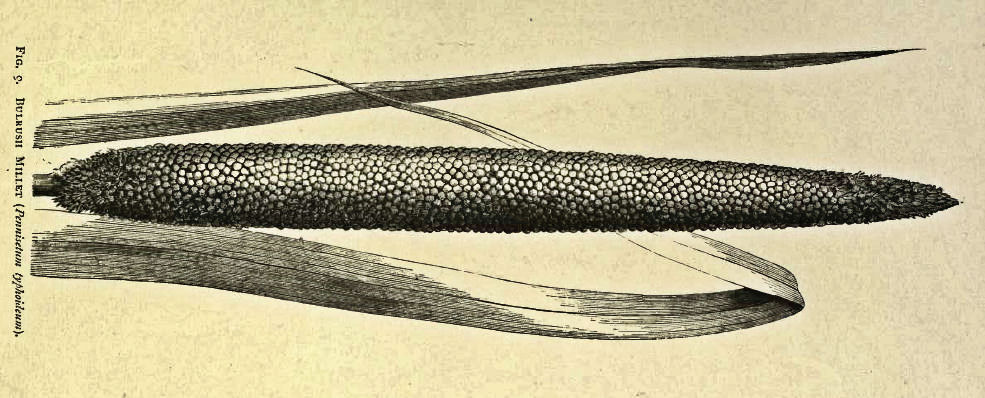
Abb.: Pennisetum glaucum (L.) R. Br. 1810 - Perlhirse
- Pearl Millet
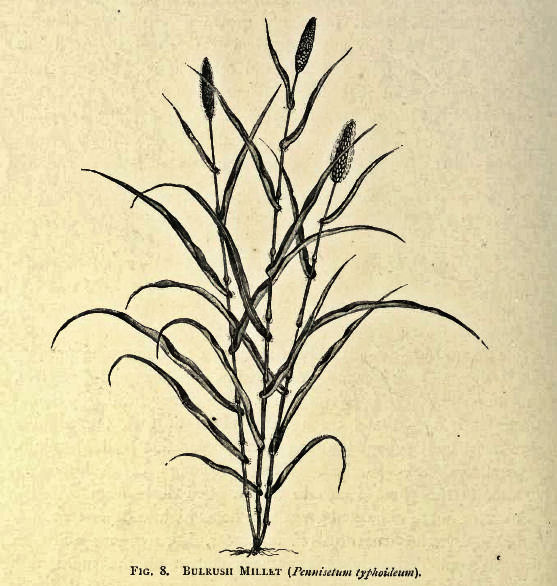
Abb.: Pennisetum glaucum (L.) R. Br. 1810 - Perlhirse
- Pearl Millet
[Bildquelle: Church, A. H. (Arthur Herbert) <1834-1915>: Food-grains of
India. -- London, 1886.]
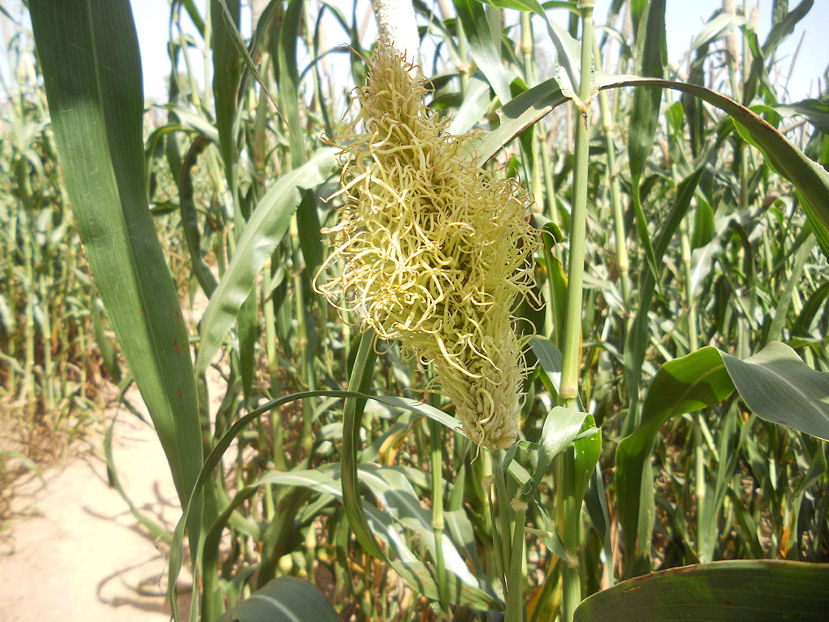
Abb.: Pennisetum glaucum (L.) R. Br. 1810 - Perlhirse
- Pearl Millet, Versuchsfeld, Jodhpur - जोधाणा, Rajasthan
[Bildquelle: Biodiversity International. --
http://www.flickr.com/photos/bioversity/5077844353/. -- Zugriff am
2011-07-02. -- Creative Commons Lizenz (Namensnennung, keine kommerzielle Nutzung, keine
Bearbeitung)]
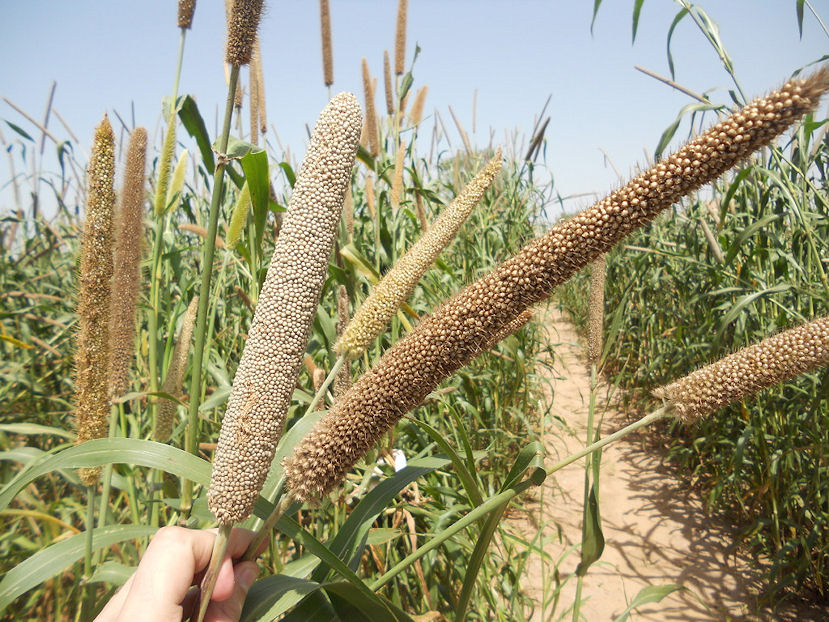
Abb.: Pennisetum glaucum (L.) R. Br. 1810 - Perlhirse
- Pearl Millet, Versuchsfeld, Jodhpur - जोधाणा, Rajasthan
[Bildquelle: Biodiversity International. --
http://www.flickr.com/photos/bioversity/5077844769/. -- Zugriff am
2011-07-02. -- Creative Commons Lizenz (Namensnennung, keine kommerzielle Nutzung, keine
Bearbeitung)]
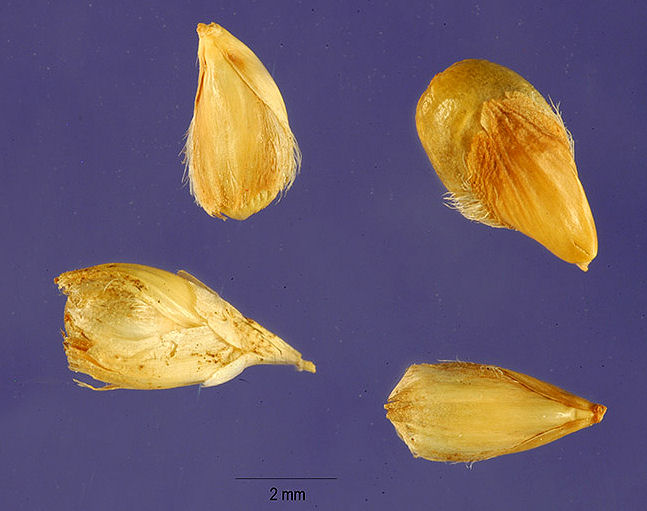
Abb.: Samen von
Pennisetum glaucum (L.) R. Br. 1810 - Perlhirse
- Pearl Millet
[Bildquelle: Jose Hernandez @ USDA-NRCS PLANTS Database. -- Public domain]
"BULRUSH MILLET. Pennisetum typhoideum, Rich.
Synonyms Penicillaria spicata (Willd.); Holcus spicatus (L.) ; Panicum spicatum (Roxb.).
[...]
An erect grass with thick round stems, generally 3 to 6 feet in height. The leaves are broad and long ; the spikes are terminal, cylinclric in form, and 6 to 9 inches long.
The seed is sown from June to August ; the crop is cut from August to December, but chiefly between September and November. In the North-West Provinces and Oudh, where it is extensively grown (over 2 million acres), the plant often attains a height of 6 to 8 feet ; the yield of grain is 5½ to 7 maunds.
[...]
In Patna (where this millet is commonly eaten), it is considered somewhat heating; in Mirzapur it is used in the cold season by the poorer classes. It is ground into flour and made into cakes; or it is parched, coarsely ground, and then mixed with water, being eaten with gur, curds, etc. The chopped stalks are good fodder.
Another Pennisetum, P. cenchroides (Rich.), is common in many parts of the Punjab where its seeds are swept up from the ground to be used as human food. Mr. Duthie names P. sanguinale (L.) as also furnishing an edible grain."
[Quelle: Church, A. H. (Arthur Herbert) <1834-1915>: Food-grains of India. -- London, 1886. -- S. 56 - 59.]
Poaceae - Süßgräser
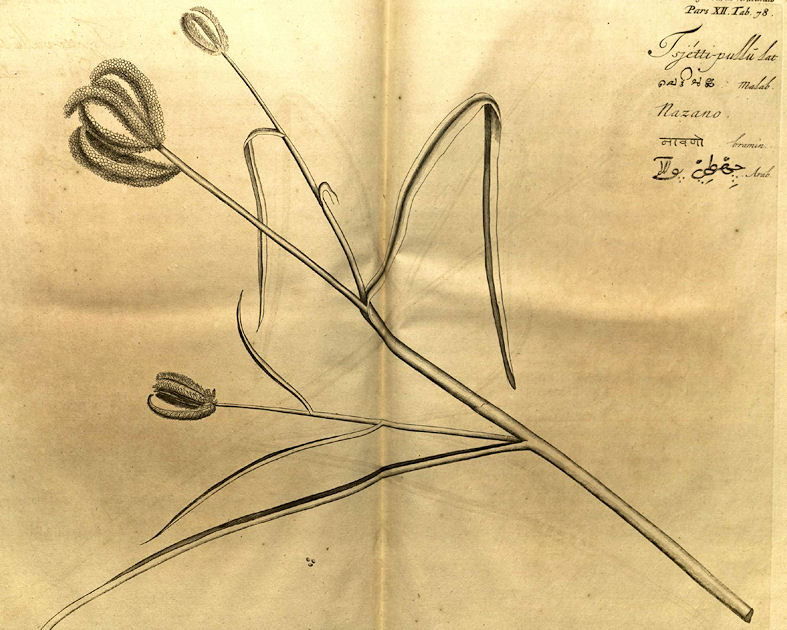
Abb.:
Eleusine coracana (L.)
Gaertn. 1788 - Fingerhirse - Caracan Millet
[Bildquelle: Hortus malabaricus XII. Fig. 78,
1703]
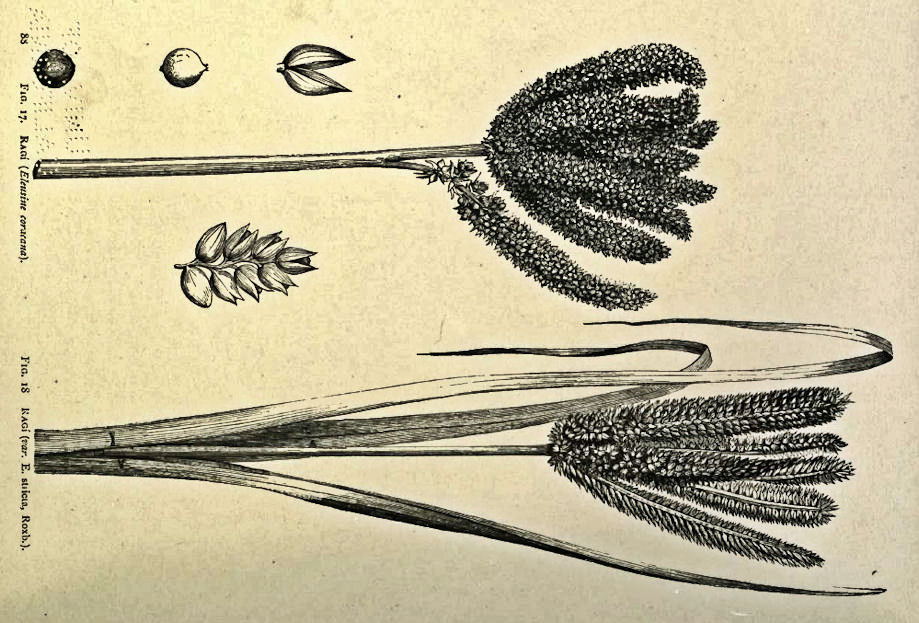
Abb.:
Eleusine coracana (L.)
Gaertn. 1788 - Fingerhirse - Caracan Millet
[Bildquelle: Church, A. H. (Arthur Herbert) <1834-1915>: Food-grains of
India. -- London, 1886.]
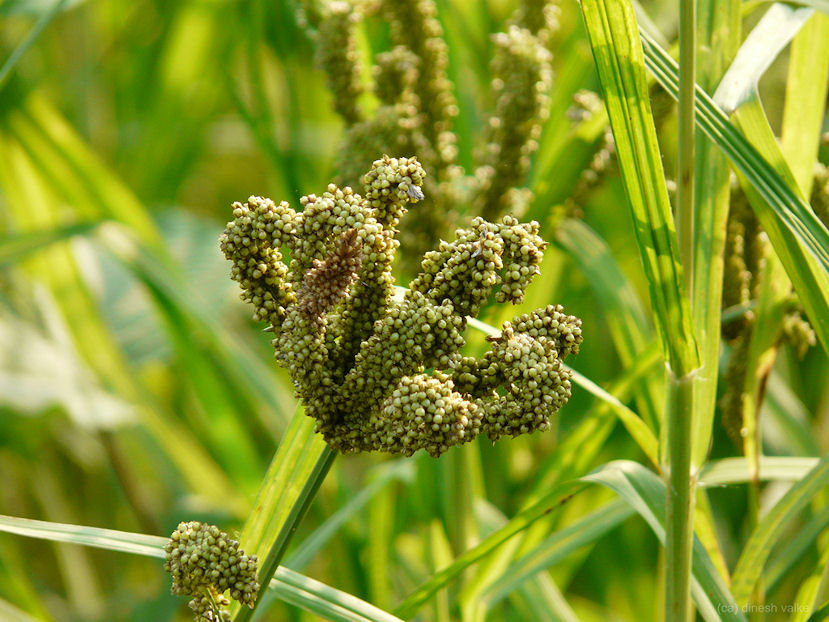
Abb.:
Eleusine coracana (L.)
Gaertn. 1788 - Fingerhirse - Caracan Millet, Yeoor hills, Maharashtra
[Bildquelle: dinesh_valke. --
http://www.flickr.com/photos/dinesh_valke/3393911783/. -- Zugriff am
2011-007-02. --
Creative
Commons Lizenz (Namensnennung, keine kommerzielle Nutzung, share alike)]
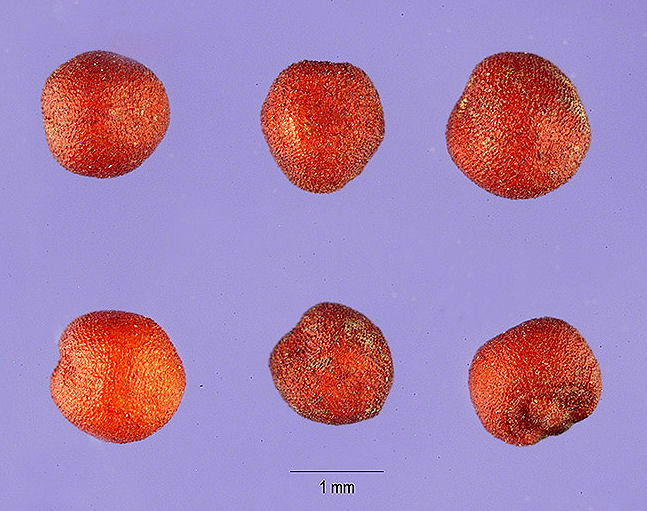
Abb.: Samen von
Eleusine coracana (L.)
Gaertn. 1788 - Fingerhirse - Caracan Millet
[Bildquelle: Jose Hernandez @ USDA-NRCS PLANTS Database. -- Public domain]
"Eleusine coracana (Gaertn.) N. O. Graminaceae. [...]
Description.—Culms erect, 2-4 feet [...9
Fl. July—Sept.
Roxb. Fl. Ind. i. 342.—Cynosurus coracanus, Linn.—Rheede, xii t. 78.
Cultivated.
Economic Uses.—This is the most prolific of cultivated grasses, forming the chief diet of the poorer classes in some parts of India, as Mysore, N. Circars, and slopes of the Ghauts. Roxburgh says he never saw it in a wild state. On the Coromandel coast it is known as the Natchnee grain, and is the Raggee of the Mohammedans. In Teloogoo the name of the grain is Ponassa. A fermented liquor is prepared from the seeds called Bojah in the Mahratta country.— (Roxb.) Ragi is perhaps the most productive of Indian cereals. Roxburgh adverts to the extraordinary fertility derived from two seeds which came up by accident in his garden. They yielded 81,000 corns. It is the staple grain of the Mysore country, where it is stored in pits, keeping sound for years.—(W. Elliot.) Another species, the E. stricta, is cultivated to a great extent. It differs from the preceding in having the spikes straight, being of a larger size, and more productive. The seeds are also heavier, which cause the spike to bend bown horizontally. All the millets prefer a light good soil, from which the water readily flows after the heavy rains. In a favourable season the farmers reckon on an increase of about a hundred and twenty fold. The variety known in Teloogoo as the Maddi ruba-soloo requires a richer soil than the others; and in good years, when the land fit for its cultivation can be procured, increases five hundred fold.—Roxb."
[Quelle: Drury, Heber <1819 - 1872>: The useful plants of India : with notices of their chief value in commerce, medicine, and the arts. -- 2d ed. with additions and corrections. London : Allen, 1873. -- xvi, 512 p. ; 22 cm. -- s.v.]
Poaceae - Süßgräser
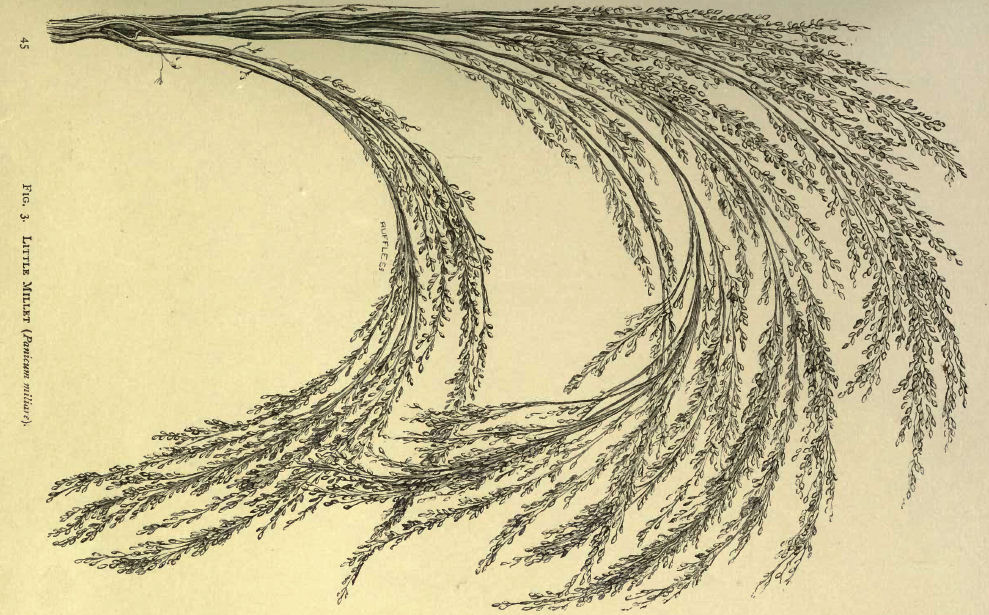
Abb.: Panicum sumatrense Roth ex Roem. et Schult. 1817
- Kutki-Hirse - Little Millet
[Bildquelle: Church, A. H. (Arthur Herbert) <1834-1915>: Food-grains of
India. -- London, 1886.]
"LITTLE MILLET. Panicum miliare. Lam.
Synonyms P. attenuatum (Nees.) ; Milium effusum (Lour.).
[...9
An annual grass, 2 to 3 feet high, producing many erect branching culms from a single seed. The panicle becomes beautifully bowed with the increasing weight of the grain. This species is cultivated to some extent in many districts ; it is grown in the Punjab up to the Kheri Pass ; also in Nepal and Central India.
[...]
Cattle are fond of the straw of this grass."
[Quelle: Church, A. H. (Arthur Herbert) <1834-1915>: Food-grains of India. -- London, 1886. -- S. 44.]
Poaceae - Süßgräser
| 25a./b. tṛṇadhānyāni nīvārāḥ strī gavedhur gavedhukā तृणधान्यानि नीवाराः स्त्री गवेधुर् गेवेधुका ।२५ क। [Bezeichnungen für Coix lacryma-jobi L. 1753 - Hiobsträne - Job's Tears:]
|
Colebrooke (1807): "Coix. Coix barbata, Roxb."
गवेधु - gavedhu f.: "Rinder-Entflammerin",
Coix lacryma-jobi L. 1753 - Hiobsträne - Job's Tears1 Wird laut PW vom Vieh nicht gefressen.
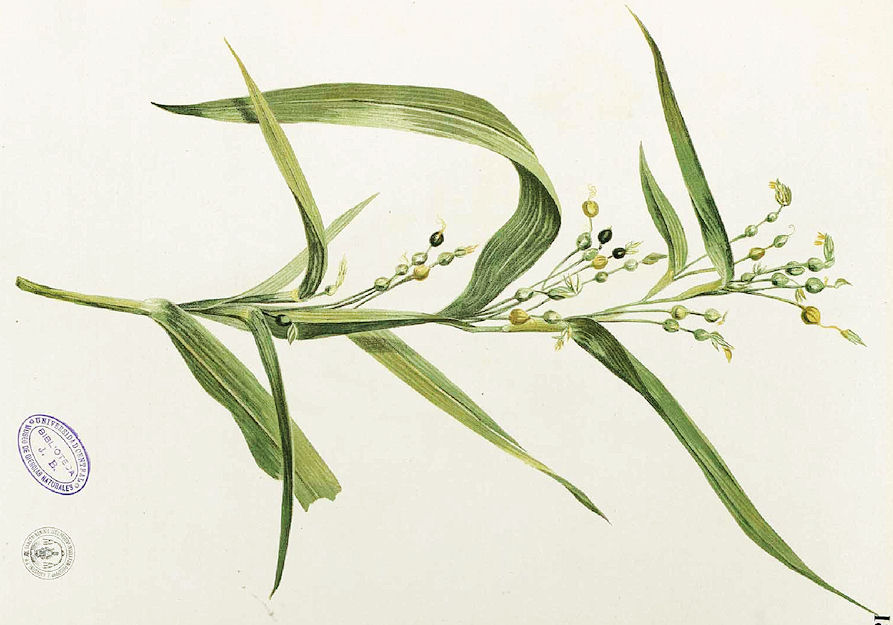
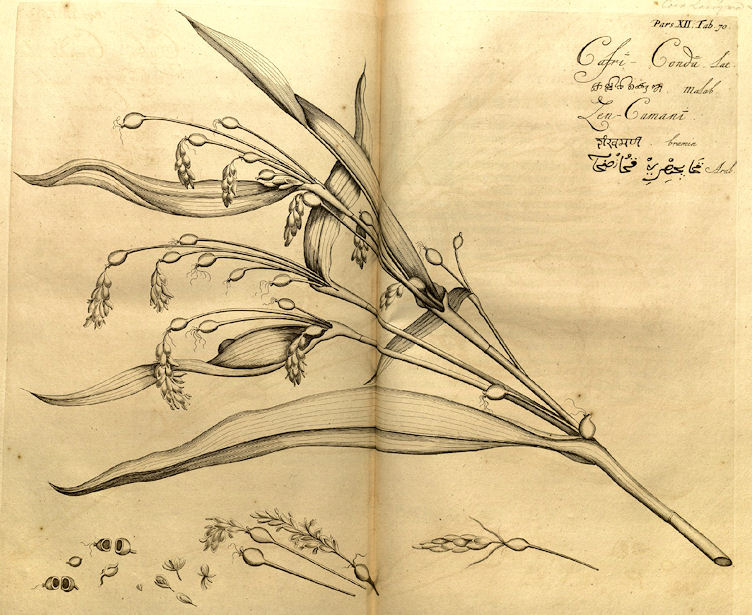
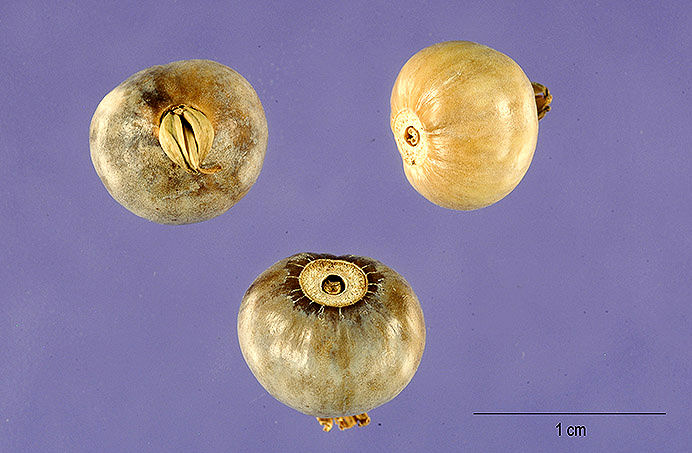
गेवेधुका - gavedhukā f.: "Rinder-Entflammerin",
Coix lacryma-jobi L. 1753 - Hiobsträne - Job's Tears
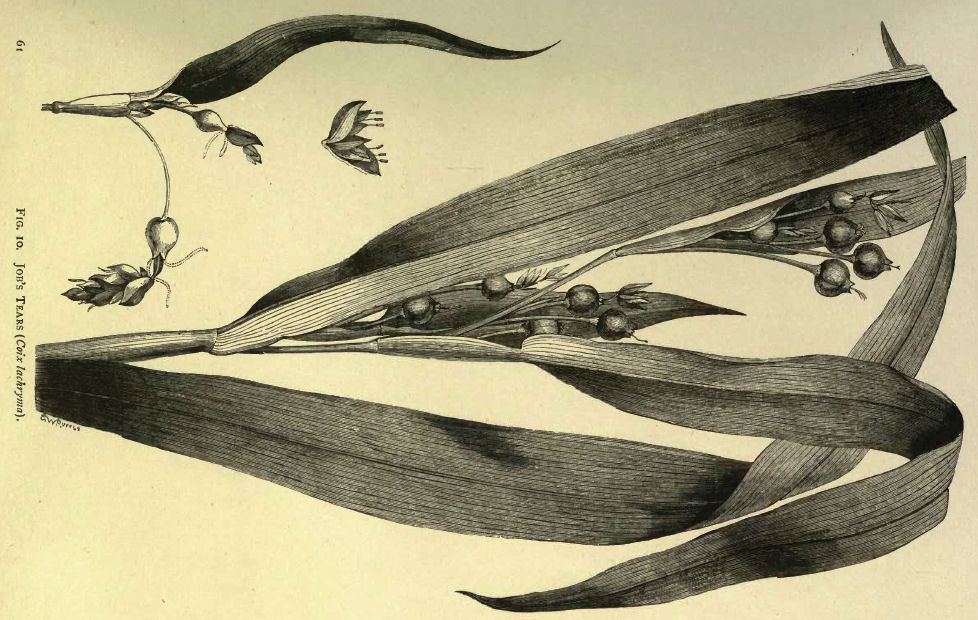
Abb.: गवेधुका ।
Coix lacryma-jobi L. 1753 - Hiobsträne
- Job's Tears
[Bildquelle: Church, A. H. (Arthur Herbert) <1834-1915>: Food-grains of
India. -- London, 1886.]
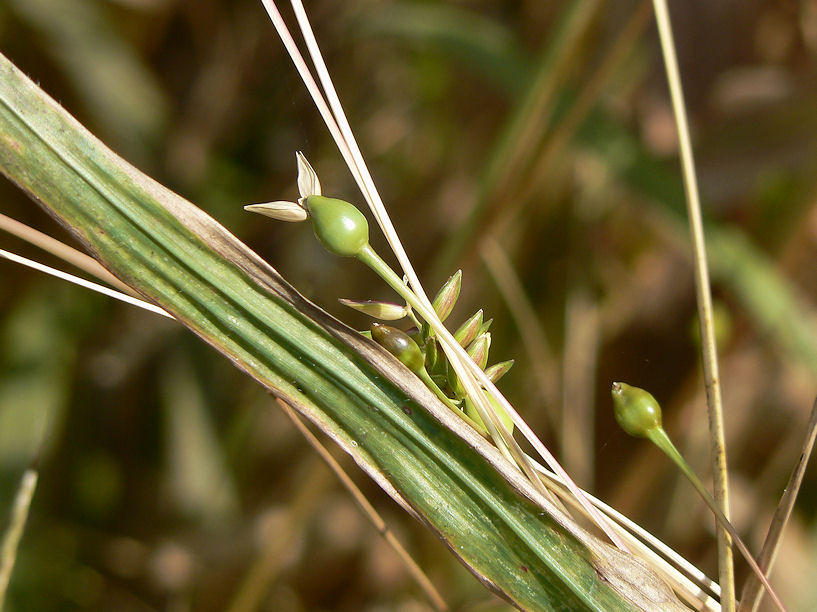
Abb.: गवेधुका ।
Coix lacryma-jobi L. 1753 - Hiobsträne
- Job's Tears, Khargar Hills -
खारघर,
Maharashtra
[Bildquelle: dinesh_valke. --
http://www.flickr.com/photos/dinesh_valke/1841598943/. -- Zugriff am
2011-07-02. --
Creative
Commons Lizenz (Namensnennung, keine kommerzielle Nutzung, keine
Bearbeitung)]
"COIX LACRYMA, Linn. Fig.— Bot. Mag., t. 79; Rheede, Hort. Mai. xii., t. 70.
Job's tears (Eng.)
Hab.—Plains of India and warm hill-slopes from the Punjab to Burma. Cultivated on the hills. The seeds.
[...]
History, Uses, &c.—The different species of Coix bear the Sanskrit names of Gavīdhuka, Gavedhu, and Gavedhuka. They are mentioned in Vedic literature, and appear to have been one of the cereals which were cultivated by the Arians on the hill-slopes of the Himalayas. They are still cultivated by the hill-tribes in the Khasia and Naga Hills and in Assam and Burma, where they are known by the vernacular names of Kasi, Kulese, Kalinsi, Kyeit, &c., and are used as a food-stuff. The wild form, common in the plains, is only used for medicinal purposes, and is considered to be strengthening and diuretic. The Arab travellers in the East became acquainted with the seeds and named them Damu Daud "David's tears," and afterwards Damu Ayūib "Job's tears." Es-Saghani, who died about the year 1260, mentions them in the Obab as a well-known strengthening and diuretic medicine. The Arabs introduced the plant into the West, and it has become naturalized in Spain and Portugal, where it is still known as Lagrima de Job. European botanists have rather inappropriately given the name of Coix ( Greek
κοιξ) to this genus, Coix being the name of a kind of palm growing in Africa and mentioned by Theophrastus and Pliny.The following notice of C. lacryma occurs in the Descriptive Catalogue of the Vienna Exhibition, 1873 :—"The seeds known as Job's tears are used as food in China and Malacca, under the name of Eejin or Ee-yin. 'It is, we are told, ' the most remarkable among food-grains for its chemical composition.' Dr. Smith writes that 'it is larger and coarser than pearl-barley, but it is equally good for making gruel. As it is sold for five pence per Chinese pound, it makes an excellent diet-drink for hospital patients in China.' Dr. Hooker observes that 'a great deal of Coix is cultivated in the Khasia Hills; the shell of the cultivated sort is soft and the kernel is sweet, whereas the wild Coix is so hard that it cannot be broken by the teeth ; each plant branches two or three times from the base, and from seven to nine plants grow in each square yard of soil; the produce is small, not above 30 or 40 fold.' In Mason's 'Burmah' it is stated that a species of Coix, with large esculent seeds, which are parched like Indian corn, are often for sale in the bazars, and are cultivated very extensively by the Red Karens."
C. lacryma has also been introduced into Brazil, where it is cultivated to some extent. For much interesting information concerning the different species or varieties of the plant, and the economic uses to which the seeds are put, we must refer the reader to the Dict. Econ. Prod. of India, ii., p. 492."
[Quelle: Pharmacographia indica : a history of the principal drugs of vegetable origin met with in British India / by William Dymock [1834-1892], C. J. H. Warden and David Hooper [1858-1947]. -- Bd. 3. -- London, 1893. -- S. 573f.]
| 25c./d. ayograṃ musalo 'strī syād
udūkhalam ulūkhalam अयोग्रं मुसलो ऽस्त्री स्याद् उदूखलम् उलूखलम् ।२५ ख। [Bezeichnungen für Stößel:]
|
Colebrooke (1807): "A pestle for cleaning rice."
"Der Stȫßel, des -s, plur. ut nom. sing. ein Werkzeug zum Stoßen, wo es in vielen Fällen für Stößer üblich ist." [Quelle: Adelung, Johann Christoph <1732 - 1806>: Grammatisch-kritisches Wörterbuch der Hochdeutschen Mundart. -- Leipzig, 1793 - 1801. -- s. v.]
मुसल - musala m., n.: Stößel, Keule
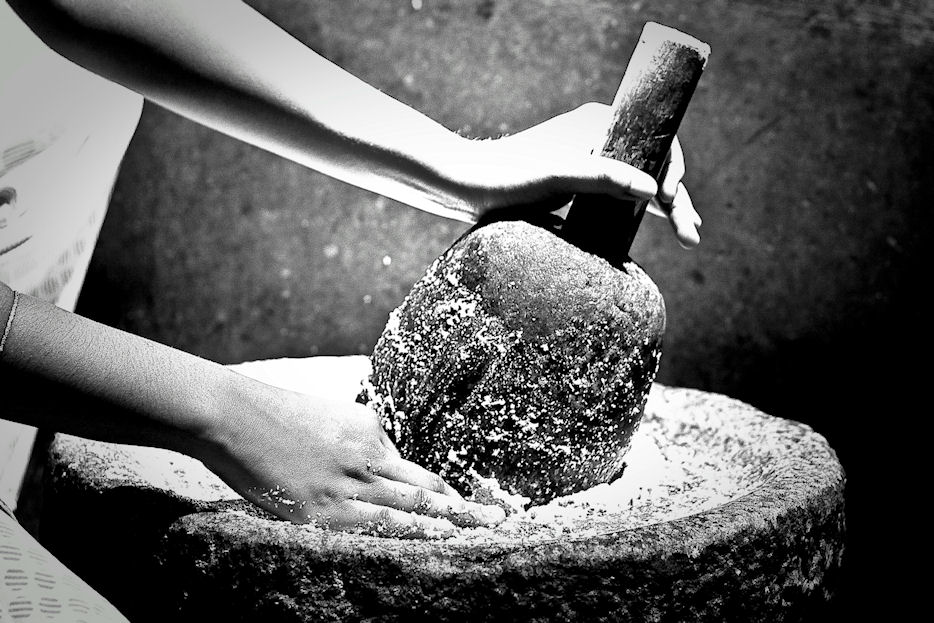
Abb.: मुसलः । Karnataka
[Bildquelle: Nishanth Jois. --
http://www.flickr.com/photos/nishanthjois/4458788355/. -- Zugriff am
2011-07-01. -- Creative Commons Lizenz (Namensnennung)]
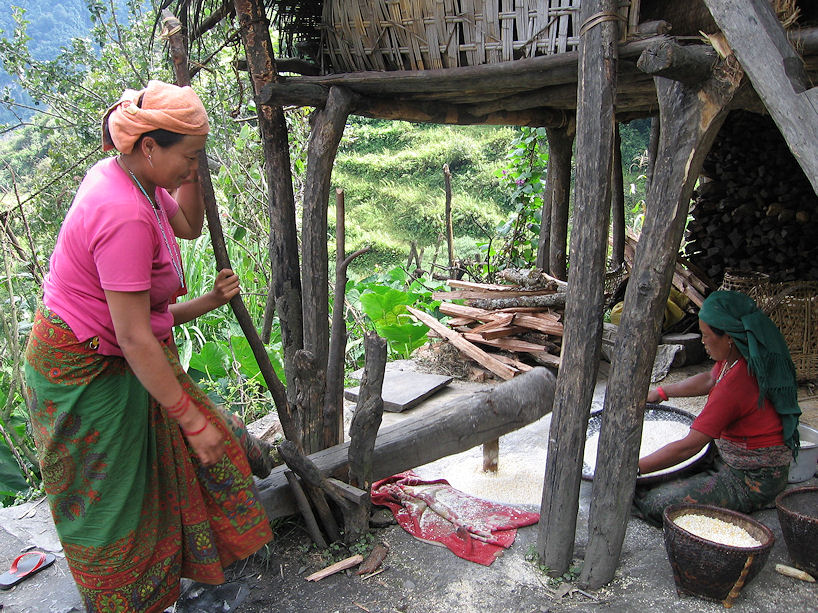
Abb.: मुसलम् । Getreidestampfe, Dhaulagiri Zone - धवलागिरी अञ्चल, Nepal
[Bildquelle: Andrew Purdam. --
http://www.flickr.com/photos/apurdam/274401519/. -- Zugriff am 2011-07-06.
-- Creative Commons
Lizenz (Namensnennung, keine kommerzielle Nutzung, keine Bearbeitung)]
| 25c./d. ayograṃ musalo 'strī syād udūkhalam ulūkhalam अयोग्रं मुसलो ऽस्त्री स्याद् उदूखलम् उलूखलम् ।२५ ख। [Bezeichnungen für Mörser:]
|
Colebrooke (1807): "A mortar."
"Der Mörser, des -s, plur. ut nom. sing. 1) Ein Gefäß von einer festen Materie, harte Körper vermittelst einer Keule oder Mörserkeule darin zu zerreiben oder zu zerstoßen." [Quelle: Adelung, Johann Christoph <1732 - 1806>: Grammatisch-kritisches Wörterbuch der Hochdeutschen Mundart. -- Leipzig, 1793 - 1801. -- s. v.]
उदूखल - udūkhala n.: Mörser
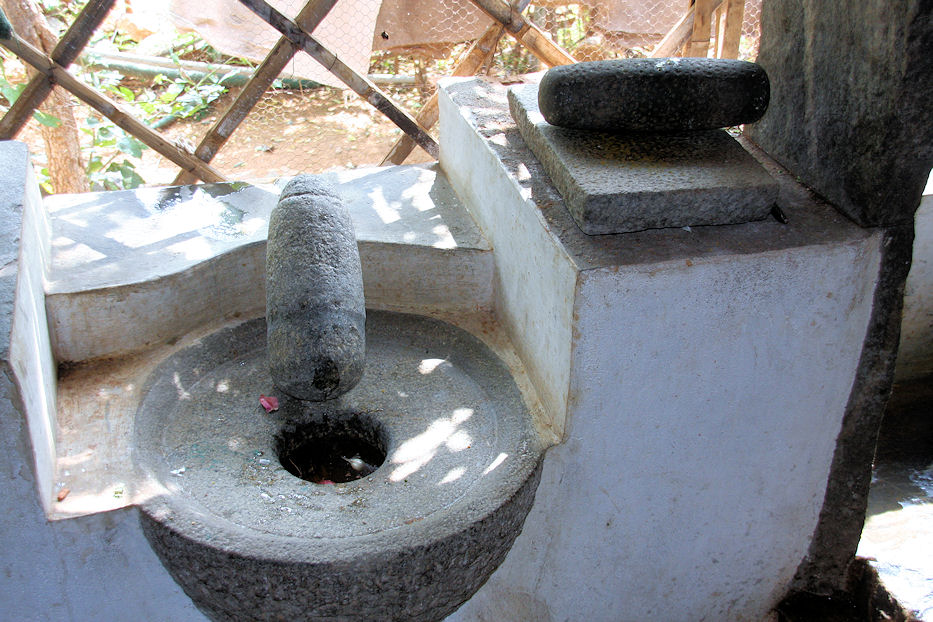
Abb.: उदूखलम् । Küche mit Mörser und Reibstein, Gutturu,
Andhra Pradesh
[Bildquelle: oliver hiltbrunner. --
http://www.flickr.com/photos/oliverhiltbrunner/4226690158/. -- Zugriff am
2011-07-06. --
Creative Commons Lizenz (Namensnennung, share alike)]
उलूखल - ulūkhala n.: Mörser
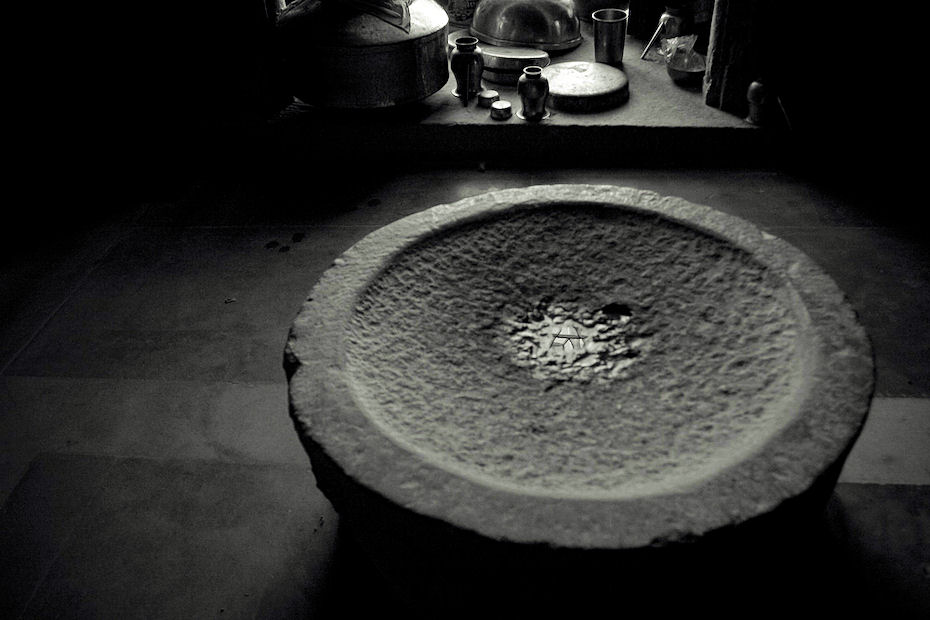
Abb.: उलूखलम् । Jaisalmer - जैसलमेर,
Rajasthan
[Bildquelle: Owen. --
http://www.flickr.com/photos/owen-pics/2491703276/. -- Zugriff am
2011-07-06. --
Creative Commons Lizenz (Namensnennung, keine kommerzielle Nutzung, keine
Bearbeitung)]
| 26a./b. prasphoṭanaṃ śūrpam astrī
cālanī tita-uḥ pumān प्रस्फोटनं शूर्पम् अस्त्री चालनी तितउः पुमान् ।२६ क। [Bezeichnungen für Getreideschwinge:]
|
Colebrooke (1807): "A winnowing basket."
"Worfeln, verb. regul. act. in der Landwirtschaft, das Getreide durch Werfen gegen den Wind von der Spreu reinigen." [Quelle: Adelung, Johann Christoph <1732 - 1806>: Grammatisch-kritisches Wörterbuch der Hochdeutschen Mundart. -- Leipzig, 1793 - 1801. -- s. v.]
प्रस्फोटन - prasphoṭana n.: "Auseinander-Fallen-Lasser", Reinigen des Getreides, Worfeln, Worfelkorb

Abb.:
प्रस्फोटनम् । Melsanakuppam, Tamil Nadu
[Bildquelle: UN Photo / P Sudhakaran. --
http://www.flickr.com/photos/un_photo/5167117068/. -- Zugriff am
2011-07-01. -- Creative Commons Lizenz (Namensnennung, keine kommerzielle Nutzung,
keine Bearbeitung)]
शूर्प - śūrpa m., n.: Getreideschwinge, Worfelkorb
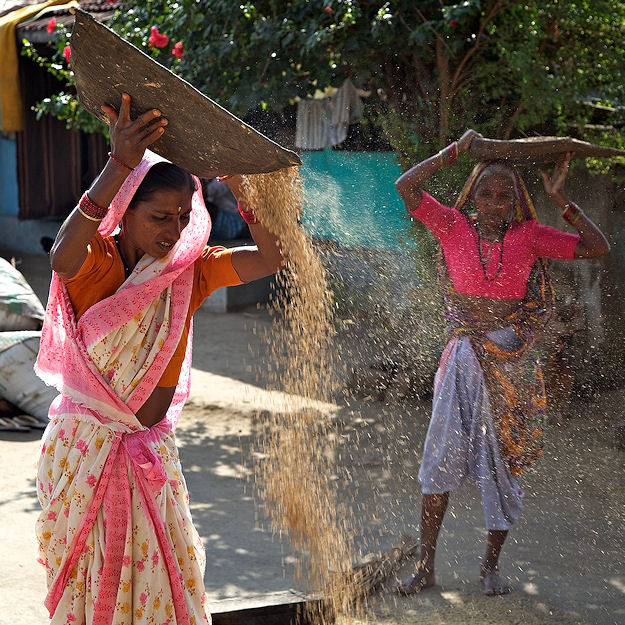
Abb.:
शूर्पौ । Reis Worfeln, Nasik -
नाशिक,
Maharashtra
[Bildquelle: Michael Foley. --
http://www.flickr.com/photos/michaelfoleyphotography/5267548696/. --
Zugriff am 2011-07-01. --
Creative Commons
Lizenz (Namensnennung, keine kommerzielle Nutzung, keine Bearbeitung)]
| 26a./b. prasphoṭanaṃ śūrpam astrī cālanī tita-uḥ pumān प्रस्फोटनं शूर्पम् अस्त्री चालनी तितउः पुमान् ।२६ क। [Bezeichnungen für Sieb:]
|
Colebrooke (1807): "A sieve or cribble."
चालनी - cālanī f.: "Wacklerin", Seihe, Sieb
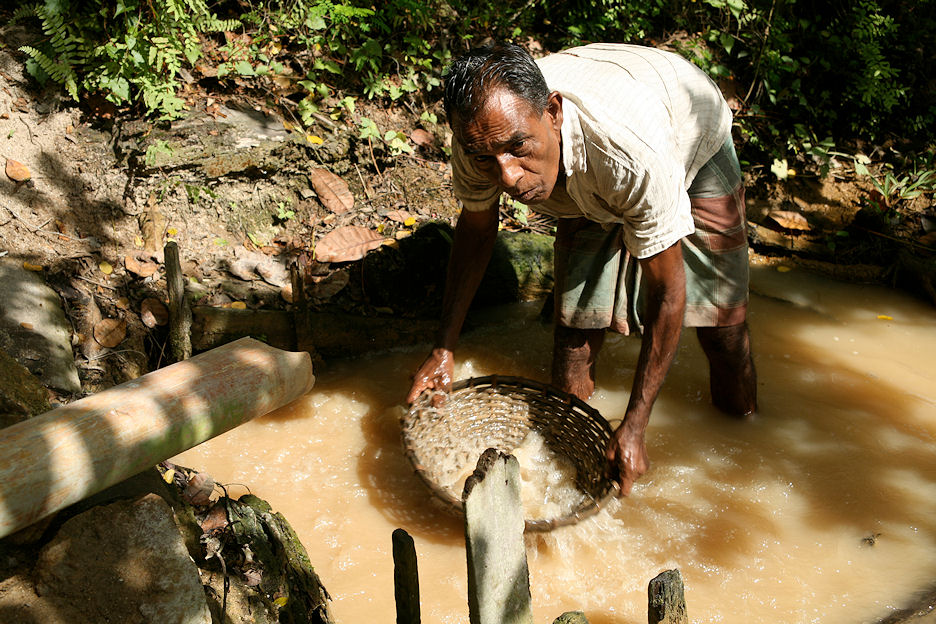
Abb.: चालनी । Edelsteinsucher, Sri Lanka
[Bildquelel: Steve Weaver. --
http://www.flickr.com/photos/steveweaver/3388393922/. -- Zugriff am
2011-07-06. --
Creative Commons Lizenz (Namensnennung, keine kommerzielle Nutzung, keine
Bearbeitung)]
| 26c./d. syūta-prasevau kaṇḍola-piṭau kaṭha-kiliñjakau स्यूत-प्रसेवौ कण्डोल-पिटौ कठ किलिञ्जकौ ।२६ ख। [Bezeichnungen für Sack:]
|
Colebrooke (1807): "A sack."
स्यूत - syūta m.: genäht, Sack
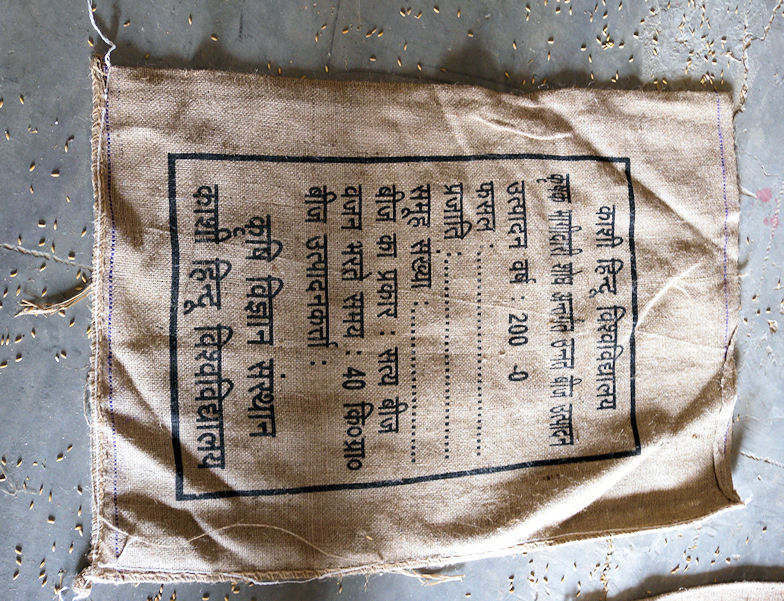
Abb.: स्यूतः । Reissack
[Bildquelle: Andy Nelson. --
http://www.flickr.com/photos/andynelson/4348907708/. -- Zugriff am
2011-07-06. --
Creative Commons Lizenz (Namensnennung, keine kommerzielle Nutzung)]
प्रसेव - praseva m.: Zugenähter, Schlauch, Sack

Abb.: प्रसेवौ । Sammler von leeren Plastikflaschen, Goa
[Bildquelle: Makwa. --
http://www.flickr.com/photos/makwa/184075542/. -- Zugriff am 2011-07-06. --
Creative Commons
Lizenz (Namensnennung, keine kommerzielle Nutzung, keine Bearbeitung)]
| 26c./d. syūta-prasevau kaṇḍola-piṭau
kaṭa-kiliñjakau स्यूत-प्रसेवौ कण्डोल-पिटौ कट-किलिञ्जकौ ।२६ ख। [Bezeichnungen für Korb:]
|
Colebrooke (1807): "A granary. Constructed of bamboos : some say, a basket to hold grain."
कण्डोल - kaṇḍola m.: Rohrkorb
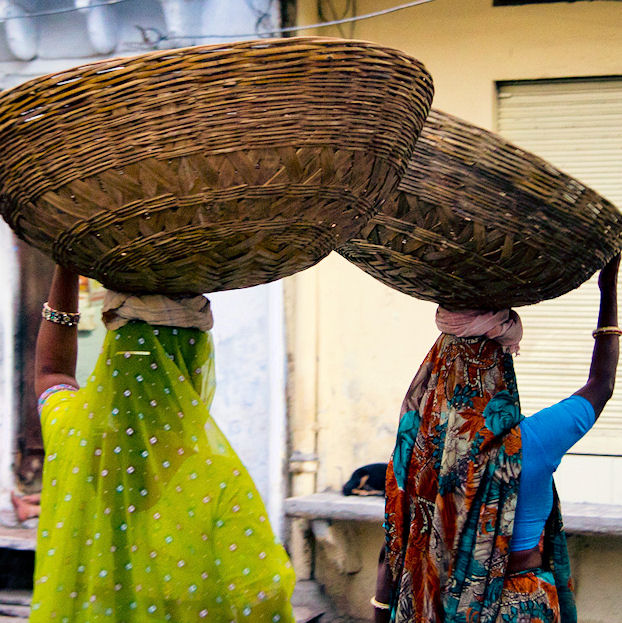
Abb.: कण्डोलौ । Udaipur - उदयपुर, Rajasthan
[Bildquelle: rachel dale. --
http://www.flickr.com/photos/rdale/5656321106/. -- Zugriff am 2011-07-06. --
Creative Commons
Lizenz (Namensnennung, share alike)]
पिट - piṭa m.: Korb
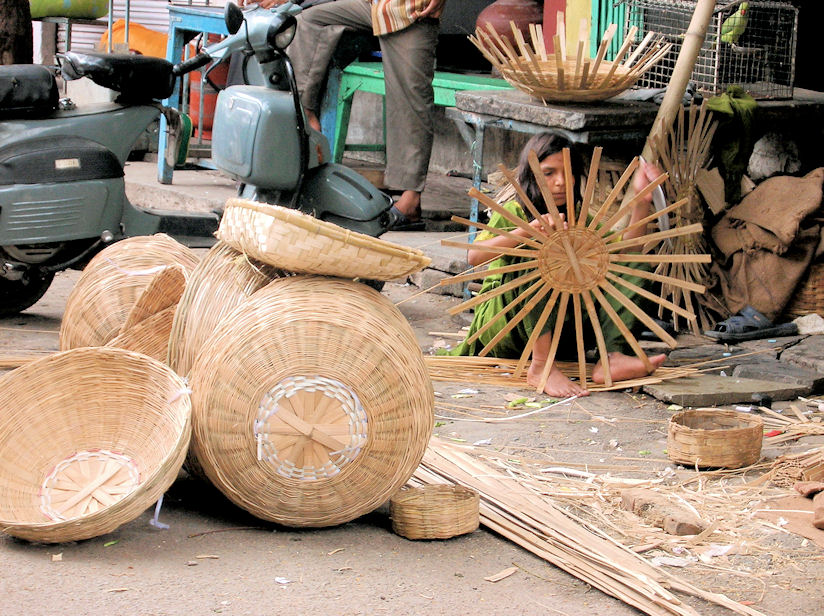
Abb.: पिटाः । Korbmacherin, Udaipur - उदयपुर, Rajasthan
[Bildquelle: Sarah Gould. --
http://www.flickr.com/photos/sarako/31965815/. -- Zugriff am 2011-07-06. --
Creative
Commons Lizenz (Namensnennung, keine kommerzielle Nutzung, share alike)]
| 26c./d. syūta-prasevau kaṇḍola-piṭau kaṭa-kiliñjakau 27a./b. samānau rasavatyāṃ tu pākasthāna-mahānase
स्यूत-प्रसेवौ कण्डोल-पिटौ
कट-किलिञ्जकौ ।२६
ख। [Bezeichnungen für Matte:]
|
Colebrooke (1807): "A mat. Or else a screen made of grass ; or a twist of straw."
कट - kaṭa m.: Matte
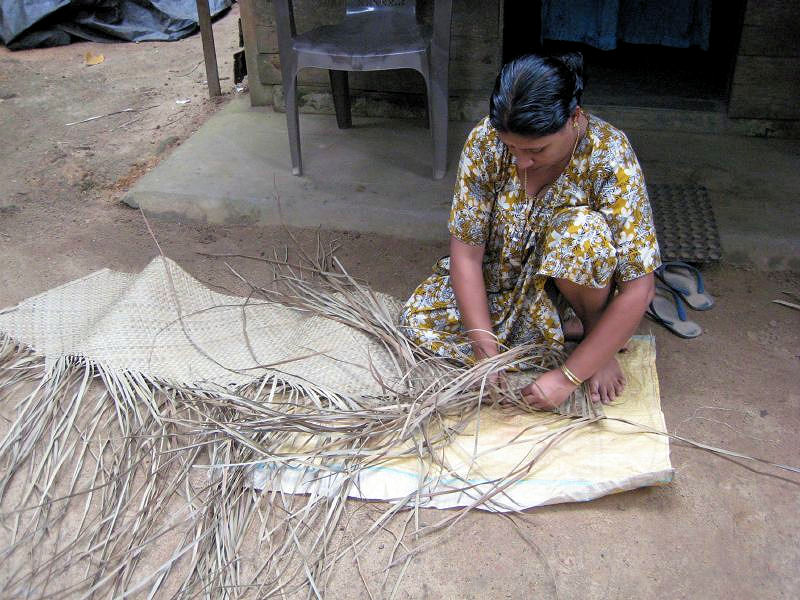
Abb.: कटः । Kerala
[Bildquelle: Kirsten. --
http://www.flickr.com/photos/94801434@N00/2712688816/. -- Zugriff am
2011-07-06. --
Creative
Commons Lizenz (Namensnennung, keine kommerzielle Nutzung, share alike)]
किलिञ्जक - kiliñjaka m.: Matte, Brett
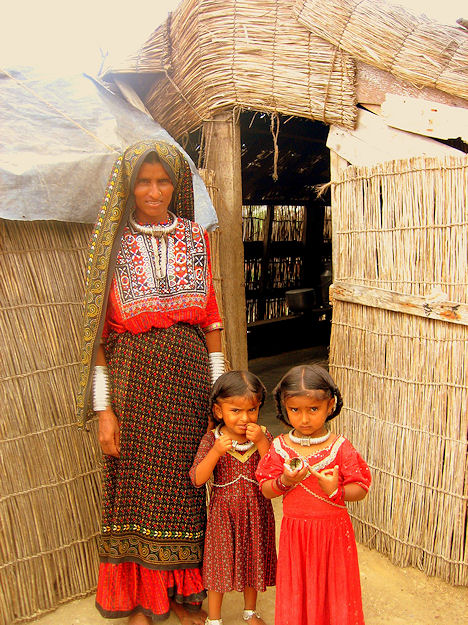
Abb.: किलिञ्जकाः । Matten als Hauswände, Asiravan, Gujarat
[Bildquelle: Sagarika Bose. --
http://www.flickr.com/photos/sgrk/2796821844/. -- Zugriff am 2011-07-06. --
Creative Commons
Lizenz (Namensnennung, keine kommerzielle Nutzung, keine Bearbeitung)]
Zu vaiśyavargaḥ - Vers 27b - 34b (Kochen I: Küche, Köche, Küchengeräte)